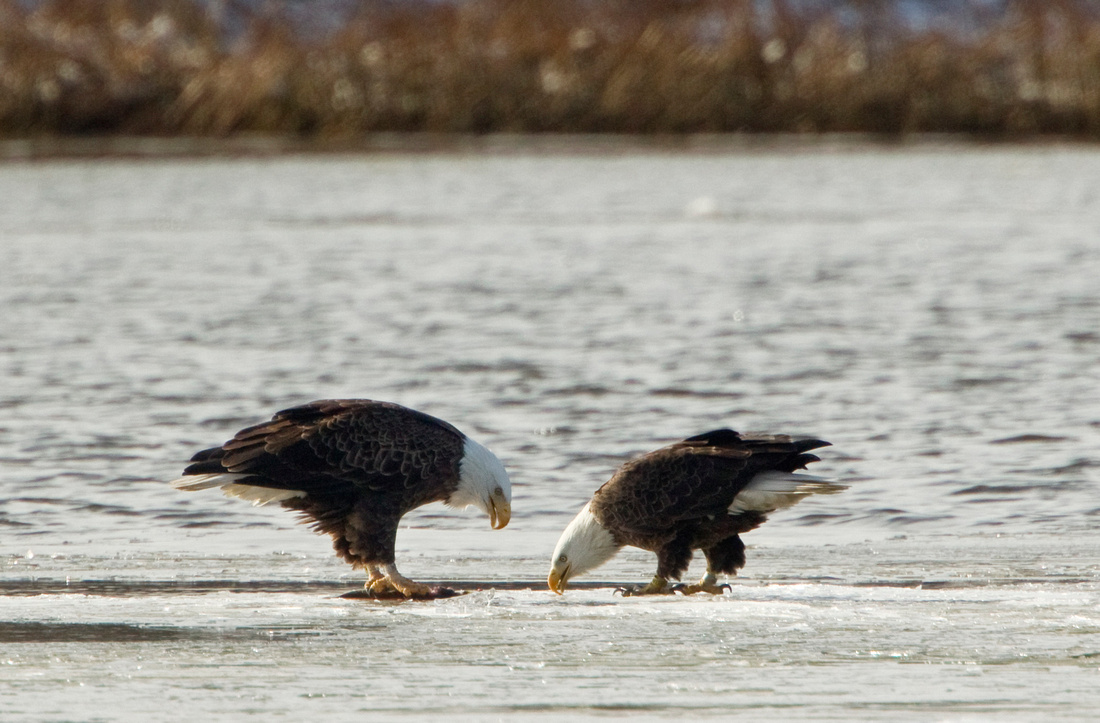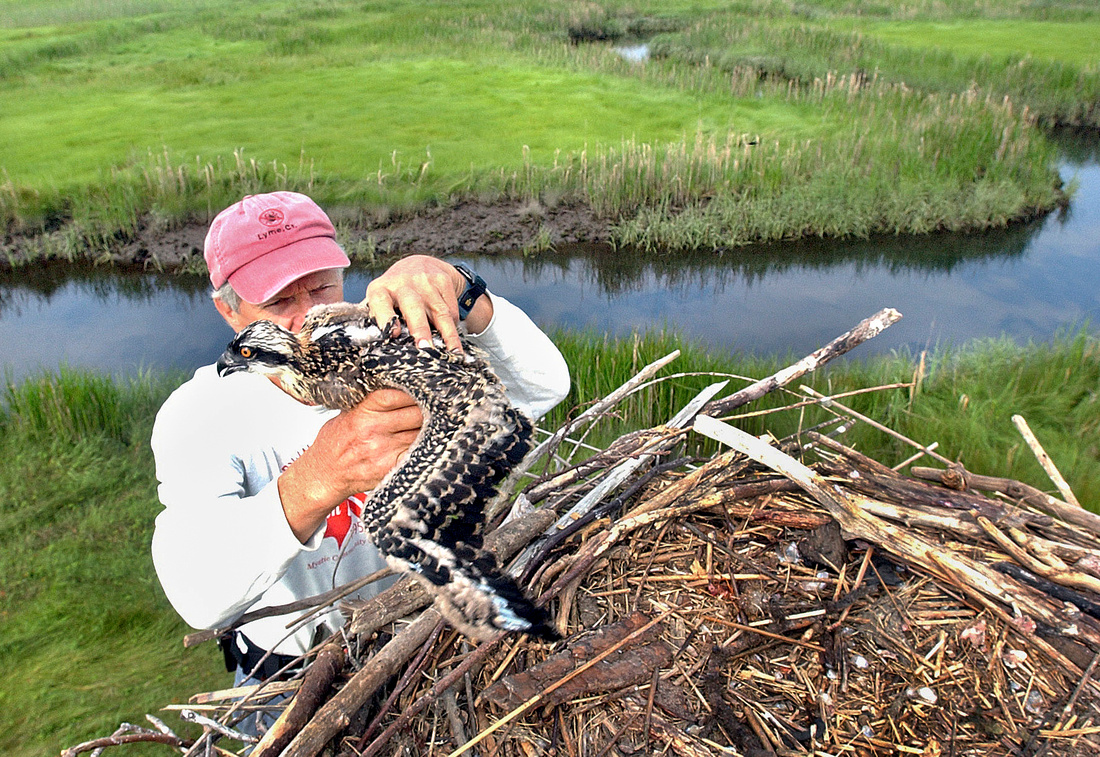
I photographed him a couple more times in his efforts to protect Osprey, for different newspapers, and quickly realized that he had an incredible wealth of knowledge about birds in southeastern Connecticut. Better still, he was happy to share his vast experience with someone who shared his passion, if only a tiny fraction of his acumen. Birds, however, barely scratched the surface of Hank's institutional knowledge of nature. Over the years, I grew to learn just how much he knew about. Birds, bees, butterflies, fish, frogs, flowers, trees, archeology, history, the list of things I learned about from him seemed endless. He was 25 years my senior, but had boundless energy and vitality, hiking, cycling, boating, kayaking, fishing, even running. If you wanted to find a trail in Lyme or Old Lyme, Hank had hiked there. He took me on a walk along the Connecticut River on a trail I never knew about, pointing out remnants of a centuries old granite quarry. Then we came upon a vernal pond and he showed me the tiny Fairy Shrimp living in it. Eagle nests, Native American campsites, an overlook of the Lieutenant River, he was a walking, talking encyclopedia, trail map and GPS. It wasn't limited to Connecticut, either. We talked about Newfoundland, the Connecticut Lakes, even the Caribbean. He kept journals of his many travels and experiences, and was also an accomplished nature photographer. He took great pictures of birds with a small point-and-shoot Nikon through a beat up old scope, often from his kayak.
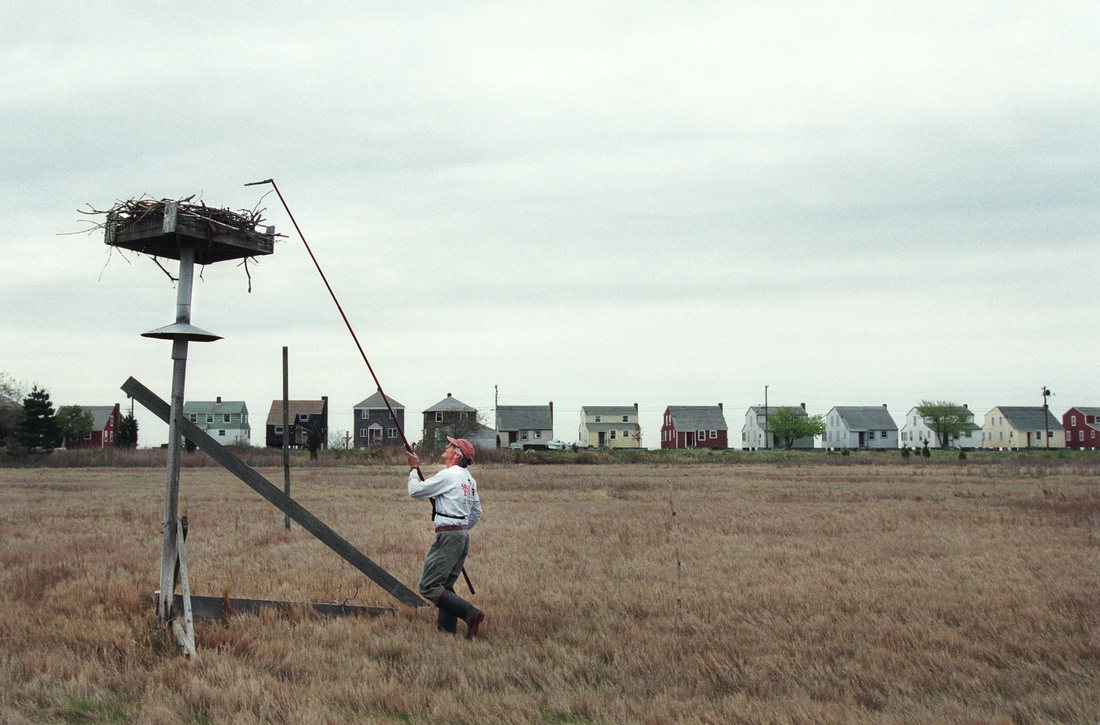
Years ago I was photographing a Yellow-bellied Sapsucker feeding at a tree in Nehantic State Forest in March. As the temperature warmed into the 70's, sap flowed from the line of holes the woodpecker had made, and I started to see flashes of orange at the base of the tree. I thought my eyes were playing tricks, but on closer inspection I saw there were small butterflies feeding on the sap running down the tree trunk. With their wings closed they blended seamlessly into the bark, but when open showed the orange flashes. I quickly shifted my focus from the sapsucker to the butterflies, even though I had no idea what kind they were. When I finished shooting, I called Hank to ask what kind they might be. I went back the next day and Hank arrived with his friend, Noble Proctor, to see what I described. It spoke volumes of Hank to know who some of his peers were, including Noble, and even Roger Tory Peterson. Eastern Comma, Question Mark and Compton's Tortoiseshell all returned to the tree.

He was happy to share the many other butterflies I could find nearby, and opened up a whole new world to me. When I wanted to find a specific species of butterfly, Hank usually knew when, where, and on which specific flower or plant to find them. He invited me to watch the tree swallows, took me on his boat to see and photograph elusive Least Bitterns, and shared countless other interesting bird and wildlife sightings and interesting locations. I truly felt like he'd taken me under his wing. When I read the sad news that Hank had passed, and the number of tributes to him, it's clear that many people felt the same way about him. He was a friendly, kind and generous person. I have a fond memory of Hank "holding court" one cold winter evening at Great Island, with a crowd of townspeople from Old Lyme who came to see Snowy Owls that he found there. I usually ran into him pretty regularly while out looking for birds in southeastern Connecticut, but it had been many months since I'd seen the red pickup with the green "Save What's Left" sticker on the back window. Many others had asked me about him, as well. I saw Hank briefly one evening this summer at Great Island, and was heartened. He looked good and seemed happy to know that many people were thinking of him. We've lost a true champion of the natural word in Connecticut, and I've lost a true mentor and friend. I'll miss him.
]]>
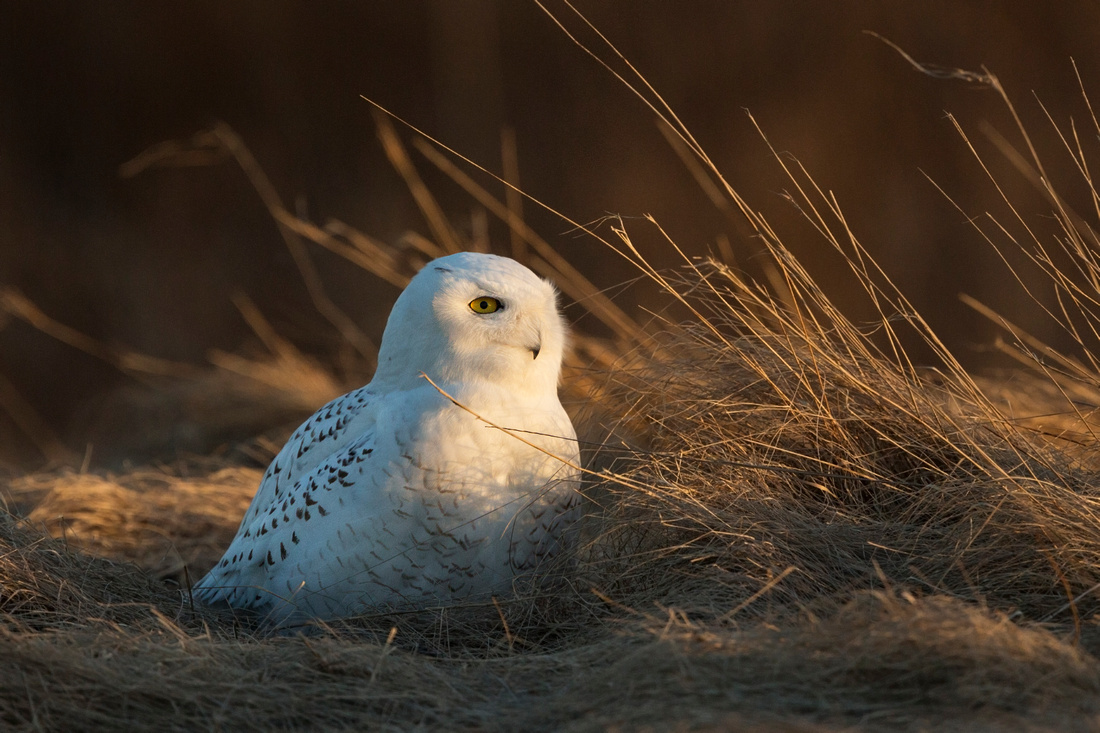
For many people, seeing and photographing such an exiting subject is quite a thrill, but owls and photographers usually don't mix and there always seems to be drama when lots of people are chasing them for a photo. I have to admit that it took several weeks of seeing pictures posted almost daily before I decided it was worth going for it. I've photographed plenty of Snowy Owls, including at Sachuest, and wasn't all that keen rehash the same ground and to be part of the horde that surely would be seen as threatening or harassing the wary visitor. But after seeing multiple pictures of the owl catching mice or voles, or flying directly toward the camera I was convinced I should go check it out. One particular photo sealed the deal for me, a shot of the owl flying just a few feet over the heads of several photographers. This clearly wasn't a typical Snowy!
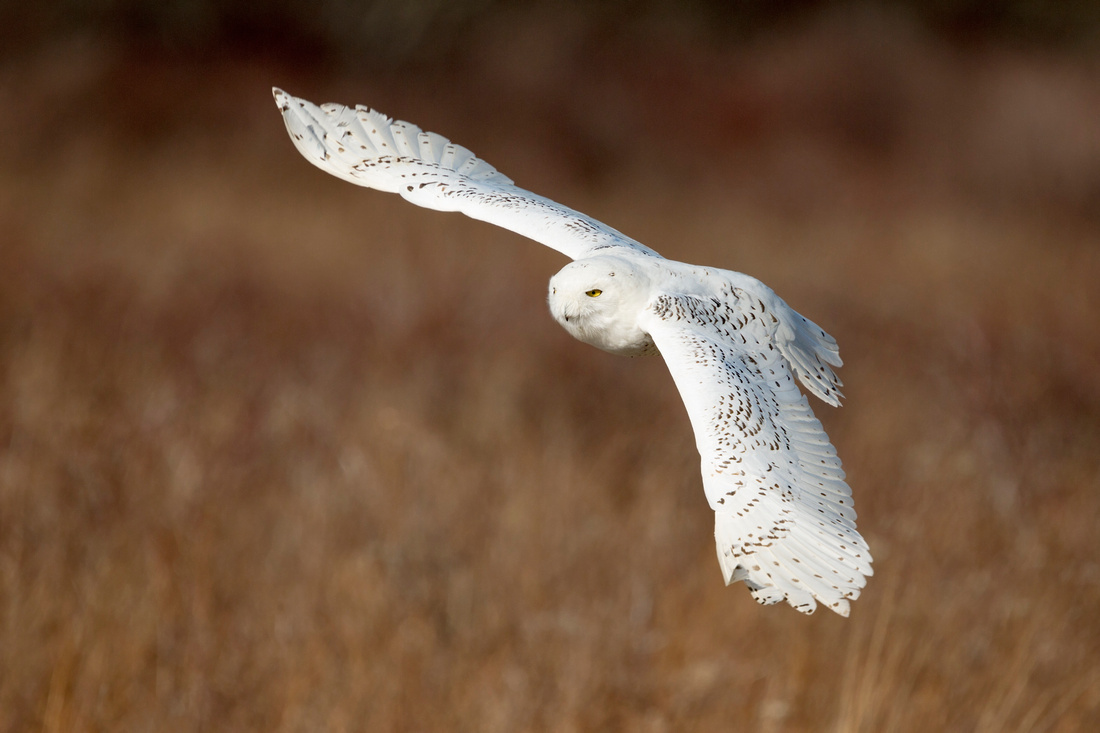
By the time I made my first visit, in mid-February, the owl was already quite a celebrity. I decided to go on a weekday afternoon, hoping to avoid a big crowd. When I arrived it was sitting in a field about 20 yards from the parking lot, with no less than a dozen cameras trained on it from the edge of the lot. The field was cordoned of with sawhorses and rope, but there was really no need to get any closer. I actually had to stand well back into the parking lot so that I would not be too tight if it took off in flight. Eventually the owl did take off, flying right towards us and up to the roof of the visitors center. It spent a while up there eyeing the surrounding areas, with people walking into the center right beneath it, before settling back down in the same field. I quickly realized that this was almost a perfect situation, and one I've rarely, if ever, encountered in wildlife photography. This owl was going about its normal business, behaving as it would naturally, allowing us to document it all without really impacting it. It was like being the proverbial "fly on the wall".

Having spent more than 20 years as a news photographer, my goal was usually to tell people's stories in pictures. Of course, it wasn't always easy to get exactly what you wanted. Having willing or cooperative subjects and gaining access for key moments were often an issue. There were times when it all came together, but even dealing with people, the ability to photograph something without impacting or influencing it was pretty rare. With wild creatures, especially wary ones like birds of prey, this seemed close to impossible. So why is this owl so trusting? I learned that this young male owl was injured by a car in Canada last September and taken in by a wildlife rehabilitator. There is a metal band on one of its legs (photo above) and six blue ink markings (photo below) on one wingtip. While there's no way to be sure, it appears to have recovered fully in rehab, and lost its wariness of humans in the process. The concern, of course, is that not all humans care about wildlife equally. Hopefully, the many photographers that were lucky enough to capture this owl don't expect that others will be this approachable.

In two visits to Sachuest I was able to capture a lot of the typical behavior of a Snowy Owl in the wild, without ever leaving the parking lot of the refuge. Much of the time it sat perched atop the visitor center, as it would seek out a high point or rock outcropping on the tundra. From this vantage point it would survey the fields below looking for prey.
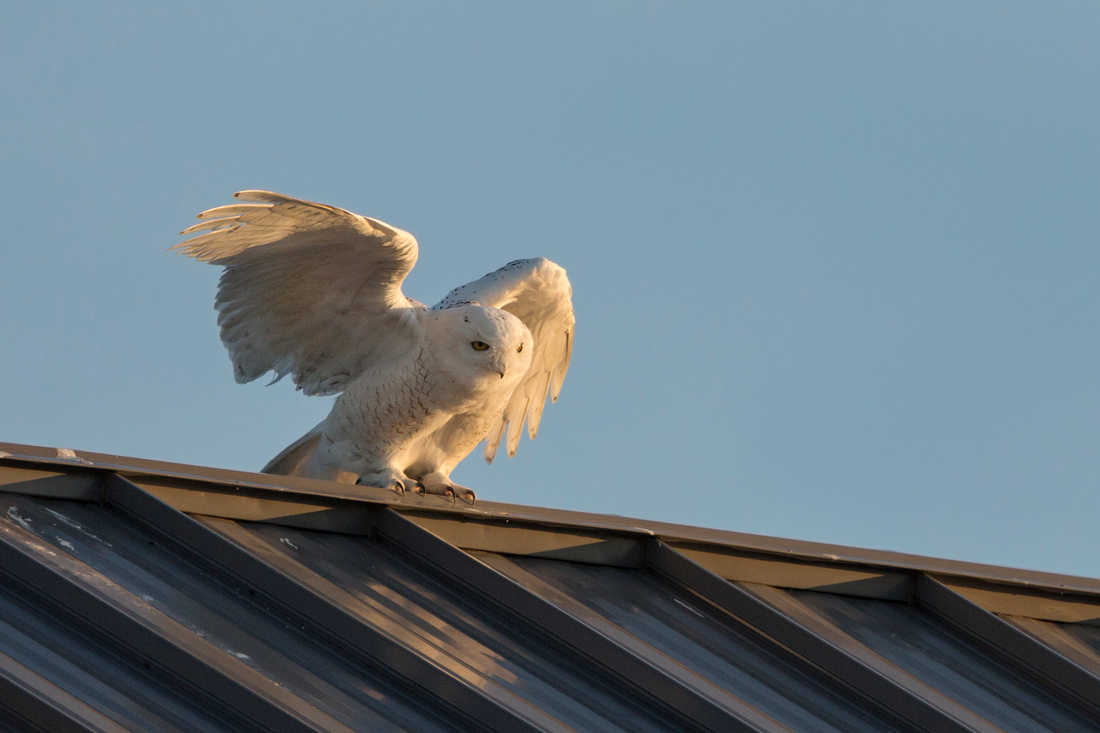
I was able to photograph it hunt successfully several times one afternoon. It would keenly eye specific areas in the fields adjacent to the visitor's center, and locate its prey, usually a large vole, hidden in the grass. It seems like it hunted more by sight than sound, especially since people were often talking in normal voices between it and its quarry. When a target was located, it would launch from its perch and fly in a low, straight line, often directly over our heads and out into the field.

When it struck, often 50 to 100 yards away from the perch, it grabbed its prey along with a tuft or clump of grass in its impressive talons and applied the death grip, often flapping its wings to maximize the force.
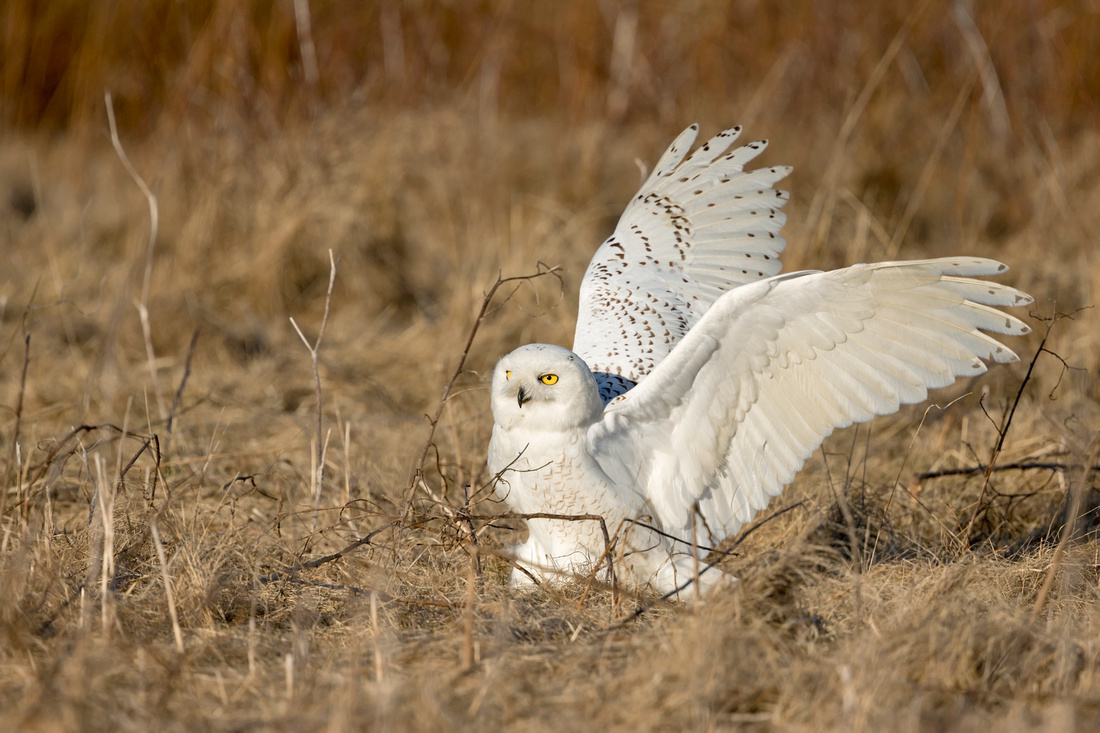
After a few seconds, it would bend down and use its beak for the final blow, snapping the neck of its prey. Then it would gradually gulp it down whole, head first.
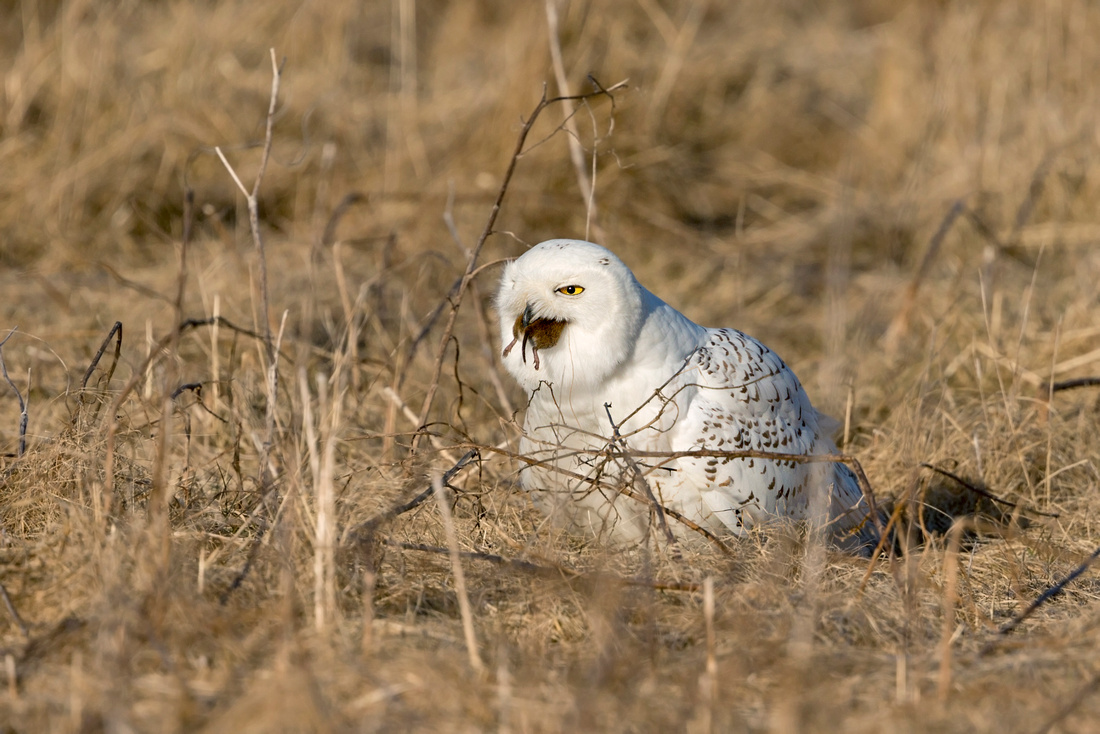
The owl continued to hunt after its first catch, quickly dispatching another vole in a similar manner a short time later.
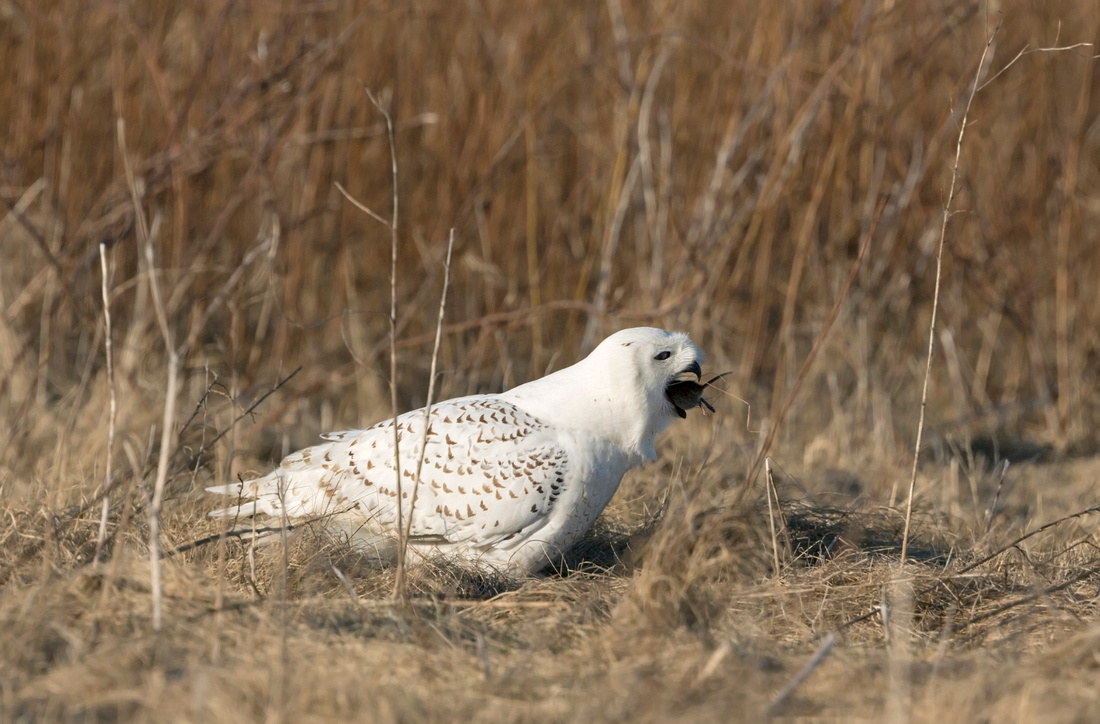
At one point, after resting in the grass for some time the owl stood up and took a couple steps directly toward me. It leaned forward awkwardly and I was expecting something to come out of its backside, but instead it regurgitated a huge pellet.
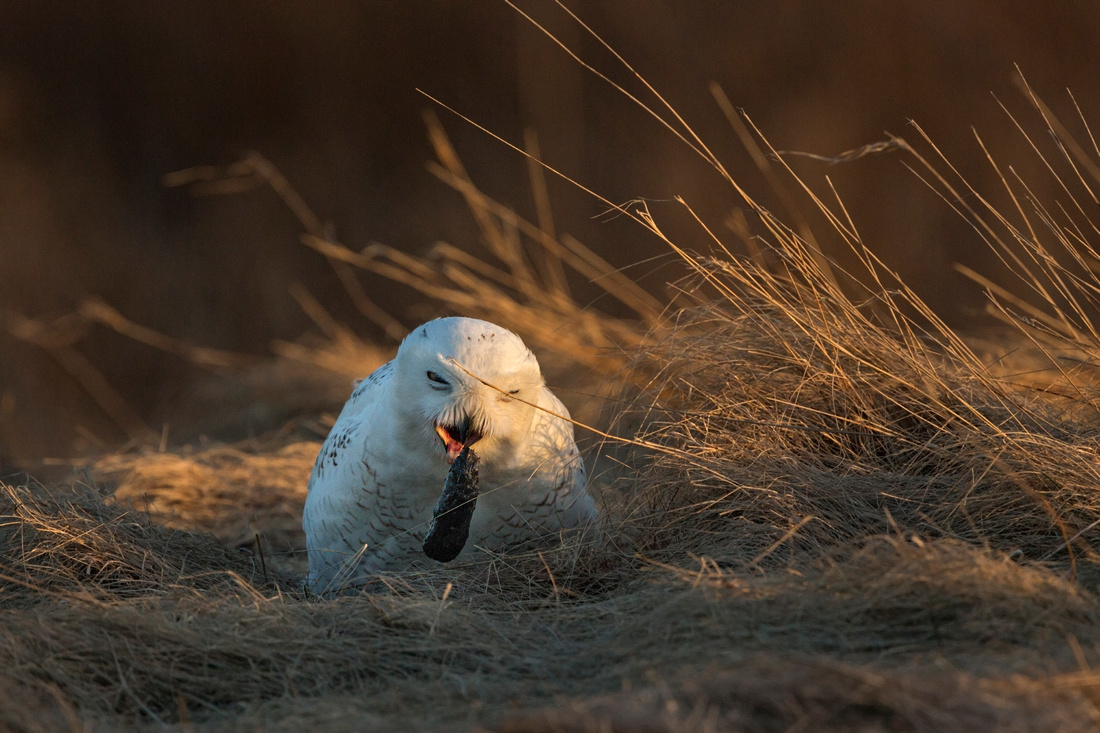
The pellet is the made up of the undigested remains of the prey it swallowed whole, including fur and bones. I found another pellet on the lawn in front of the visitors center and photographed it with a ruler. At nearly five inches long, it's the largest owl pellet I have ever seen, and surely indicates that this Snowy Owl is pretty well fed.

I went for a third visit in March, but the owl was not visible for the entire afternoon. It had been seen less frequently near the visitor's center, and I was starting to think this remarkable opportunity was coming to an end. After searching other locations, I wound up back at the refuge parking lot. With the afternoon light fading, I was preparing to leave when a car pulled up and announced that the owl was back atop the visitors center. As the sun began to set, the owl flew off the roof in a low straight line, gliding right past another photographer on its way to an adjacent field. What a showoff!.

]]>

Owls are rock stars of the bird world, and are one of the most sought after subjects of bird and wildlife photographers. When I first started photographing birds, it was my first sightings of a Short-eared Owl and Great Horned Owl that really lit a fire in me and cemented my lasting passion for photographing birds. For today's novice birder or nature photographer, the sight of a Barred Owl sitting on a bird feeder in their yard or a street sign or telephone pole on the side of the road during the daytime may ignite a similar and lasting love for birds. It's important to remember that it's often some sort of duress, usually a lack of food, that causes large numbers of Snowy Owls or Great Gray Owls to fly great distances from their normal winter range. Owl irruptions often occur after successful breeding seasons, when prey is plentiful and a large number of owl chicks survive the nesting season. When the owl population swells, the competition for food exceeds the local supply, especially in the tough winter months, leading to the nomadic wanderings in search of happier hunting grounds. Similarly, local bird experts believe that Barred Owls had a very prolific nesting season this spring, leading to a greatly increased population, especially of young owls. Since Barred Owls are not prone to flying great distances to find new hunting grounds, the pressure on the local food supply becomes greater. The struggle to find enough food is causing Barred Owls to hunt by night and day. That's what is responsible for the many sightings during the daytime, in more open areas when normally they're found in wooded areas and would be roosting in trees during the day, out of plain sight. This year I have seen Barred Owls hunting in open fields, along river edges and especially along the side of the road, all during the daytime.
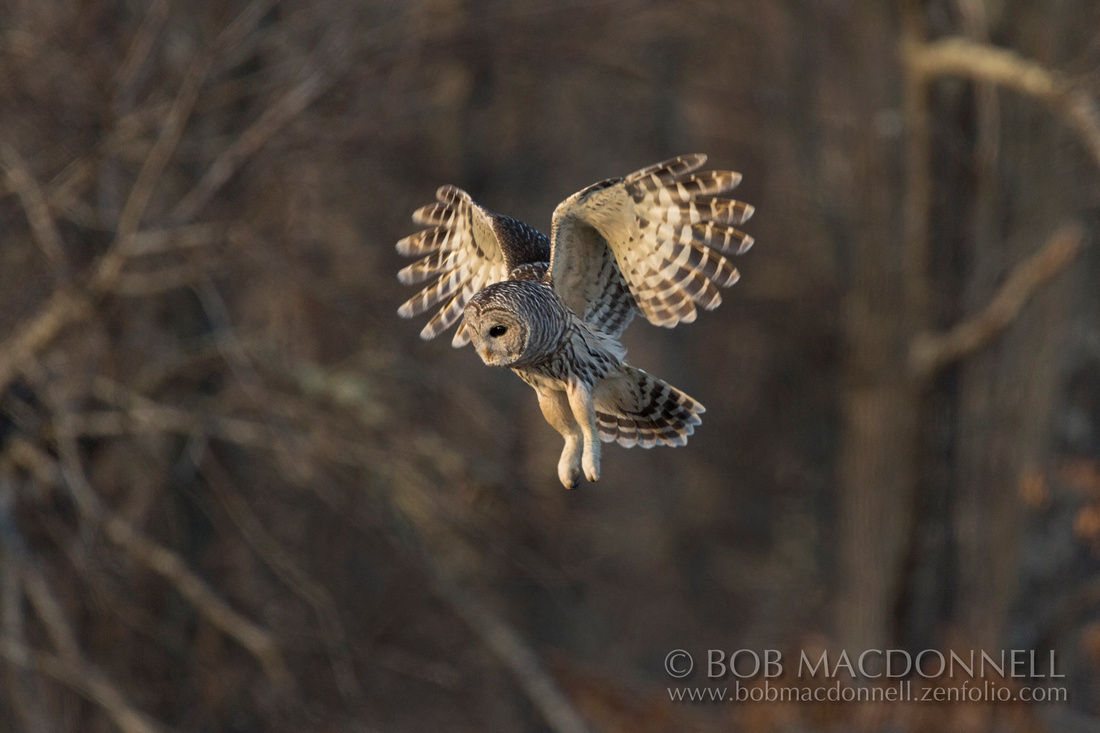
While the irruption may lead to many more sightings and unusual photographs of Barred Owls, it's a terrible hardship on the birds. One of the saddest aspects of this irruption year has been the number of dead owls I've seen along the side of the road. I'm not sure why they hunt near the roadways, but I've seen nearly three dozen dead Barred Owls along the along the highways this winter, about ten times more than I can remember seeing any other year. Nature can be cruel and it has a way of keeping wild populations in check. In any normal year a high percentage of young birds of prey don't survive their first year, whether it's from not being successful enough hunters to survive, attacks from other predators or other random fatal mistakes. Competition for the best hunting areas often drives the younger and weaker birds into the least productive and least desirable areas. Sadly, even beyond nature's own checks and balances, hunting along the side of the road is just another peril for them in this winter of the Barred Owl.

Toward the end of my time as a newspaper photographer, for certain assignments there was a push to have us shoot and produce short videos for web viewing, in addition to shooting still pictures for the paper. I always saw this as a "splitting the baby" approach because it didn't allow you to do either job as well as it could be done. In fact, I thought the videos were usually pretty poor quality. It also involved the cumbersome process of carrying two sets of gear and switching back and forth between cameras and digital video equipment. There were times, though, when a video just captured the story better than any still photos could. Sound and motion often reveal far more than a still image and written words can. Now that many DSLR cameras also capture HD video of amazing quality, many creative still photographers have adopted the new technology to produce amazing videos and even full length films. DSLR cameras are better suited to producing cinematic quality video than the lower end digital video equipment we were using.
This winter, inspired by the Nature 365 project, I spontaneously decided to shoot video of a fast moving snow squall crossing the Connecticut River. I made a 90-second video using iMovie that I think captures the feel of the dramatic weather visually, but the sound quality is so poor that it's unusable. My camera's built-in microphone is very limited and proper audio recording suffers without the use of an external video microphone. Since I don't shoot video that often, it seemed superfluous to carry one around with me.
Since making the squall video I have occasionally shot video clips of other situations I was photographing, without really having any idea what to do with them either. Again, they usually suffer from bad audio. Another sound issue that I have encountered is that it's really difficult to record nature in Connecticut for any length of time without some type of man-made noise in the background. Passing traffic, distant power equipment, speed boats on the water or planes flying overhead, some distracting sound can be heard in many of my video clips, even in the deepest woods. This shows how few truly wild places there are in the state, and I think I will appreciate the quiet of true wilderness much more now, if I ever get there again.
This spring I was fortunate to find a Barred Owl nest near my home that I was able to photograph several times over a couple of weeks. It involved a lot of patience, standing still and waiting for something to happen. After getting some still photos, I decided to start shooting video clips of the chicks in action and the adults when they were present. With the camera mounted on a tripod and trained on the nest, alternating between video and still photography was pretty convenient, just a matter of flipping the switch, but the situation didn't allow me to move around much and get different angles to vary the perspective. Using iMovie, I made a basic four-minute video to document the nesting owls. I did not put much into the production of the video, but there are some scenes that just don't translate as well in the still photos I shot. So, here are my moving pictures. Hopefully some day they might end up in something that approaches the beauty of Nature 365. At least it's a start.
P.S. - I reduced the image quality of the original HD files since they take so much time to upload. iMovie is a pretty basic tool compared to the Final Cut software which I used for video editing at the newspaper. If anyone has any suggestions on how to improve the editing and especially the audio in iMovie, please let me know, and definitely check out Nature 365.
]]>
This self-assignment approach started when I rekindled my wildlife photography after a six-year hiatus. I was looking through my old slides and saw that I didn't have any good screech owl photos. I was disappointed to have nothing on such a common owl, so I made it my mission to find them. I started looking in suitable habitat, listening for them at night and checking just about every tree hole I walked or drove past. At first I was frustrated and had a fatalistic attitude that I wouldn't ever find something that I was looking so hard for. The breakthrough came after a few months. I was on my way home from work and drove past a tree with a couple holes in it that I'd passed a hundred times before. It was almost dark, but this time I noticed that one of the holes wasn't empty. I backed up and took a few shots out my car window in the marginal light. A few days later, I returned in slightly better light and got a few more shots from my car, since it was a on a busy road with no place to park nearby (I realize that I may not have been the safest driver during this period). The owl did not stay in that spot very long, but a short while later I found another "screech" in a tree on the side of the park road. This one was much better for photography. Over the next several months, I found two more. The flood gates had opened and I soon had hundreds of screech owl photos.
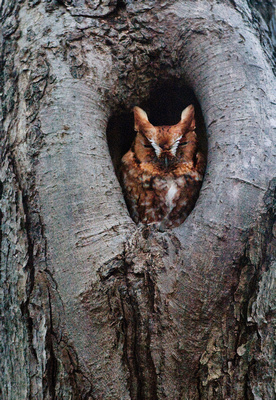 E SCREECH OWL 08-02-1521232OLD LYME, CT Eastern Screech Owl (Otus asio) red phase.
E SCREECH OWL 08-02-1521232OLD LYME, CT Eastern Screech Owl (Otus asio) red phase.
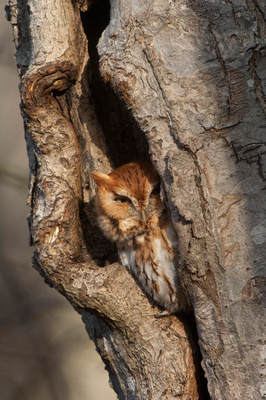 E SCREECH OWL 08-02-1621312NIANTIC, CT Eastern Screech Owl (Otus asio) red phase.
E SCREECH OWL 08-02-1621312NIANTIC, CT Eastern Screech Owl (Otus asio) red phase.
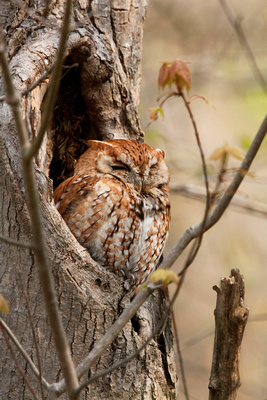 E SCREECH OWL 10-05-0122525LYME , CT Eastern Screech Owl (Otus asio).
E SCREECH OWL 10-05-0122525LYME , CT Eastern Screech Owl (Otus asio).
Full of confidence that my new approach was foolproof, my next project was to photograph a Great Horned Owl nest. Presto, like magic, two appeared before me. I was on a roll, so logically my next assignment, in keeping with the owl theme, was to find a Barred Owl nest. That's where the wheels ground to a screeching halt, and just fell off altogether. For the past four springs I have been looking for a Barred Owl nest without success. There were a couple close calls, where I'd heard and seen a pair repeatedly in the same location, and was sure they were nesting there. I just couldn't find where. At first it was just frustrating, then as the hours were consumed fruitlessly, it became a slight obsession. As years passed without finding one it became my nemesis, my curse, it became my Holy Grail.
This spring the curse was finally broken, and like the 2004 Boston Red Sox, it happened in the unlikeliest way. I had very little luck finding any nests this spring, and it was getting late in the season. On a drizzly morning I went hiking in a spot I had not been for a couple years carrying only my binoculars, hoping to scout out possible photo opportunities. The trail took me up to a hilltop, and through a hole in the leaves I saw a narrow cavity in a large oak tree. I immediately thought, "Wow, that looks like a perfect nest hole." I trained my binoculars on it, but didn't see anything inside. The hole was about 30 feet up in the tree, which was growing at the bottom of the hill, so from the hilltop it was right at eye level. As if I was willing it to be an owl nest, I stared into the hole with my binoculars for a minute or two, but nothing appeared. I continued down the hill and a hundred yards down the trail when a squirrel suddenly chattered in alarm, clinging to a tree trunk with its tail twitching. The woods erupted with sharp thrush calls, vireo rattles and titmouse whines. Was it me that was causing all the commotion? I stopped walking and scanned the woods for whatever it was that was alarming all the woodland creatures. I stood there for several minutes but didn't see anything. The rain started to pick up and the chatter died down, so I started to walking back the way I came. Something big and brown flew over my head, and down the trail where it just disappeared. I stopped back at the top of the hill and stared back into the tree cavity for a bit and a face appeared.
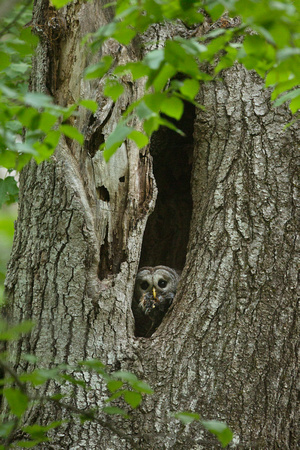 BARRED OWL 15-05-2883090Barred Owl (Strix varia) at tree cavity nest in Connecticut forest.
A Barred Owl stared out at me, then squeezed out of the hole and flew off. The Holy Grail was finally within reach, but I didn't have my camera with me and had no pictures yet. I returned later that evening and waited under a camouflage blind to see if I could get some pictures, but no owls appeared. A few days later I tried again in the morning, but saw nothing. Was this going to turn out badly? I had the same nervous feeling when the Red Sox came back from 0-3 down to beat the Yankees in the 2004 ALCS. What if they lost to the Cardinals in the World Series? I would be the cruelest failure of all time.
BARRED OWL 15-05-2883090Barred Owl (Strix varia) at tree cavity nest in Connecticut forest.
A Barred Owl stared out at me, then squeezed out of the hole and flew off. The Holy Grail was finally within reach, but I didn't have my camera with me and had no pictures yet. I returned later that evening and waited under a camouflage blind to see if I could get some pictures, but no owls appeared. A few days later I tried again in the morning, but saw nothing. Was this going to turn out badly? I had the same nervous feeling when the Red Sox came back from 0-3 down to beat the Yankees in the 2004 ALCS. What if they lost to the Cardinals in the World Series? I would be the cruelest failure of all time.
Until I had a picture, I couldn't relax. So I waited, standing under a bag blind for hours. Four hours passed and I started getting hungry. Six hours, still nothing, my back and legs were starting to ache. Eight hours, nothing, I think I was starting to hallucinate. Finally, late in the afternoon, I heard a faint two-syllable call. Then, again, a little closer. At the bottom of the tree cavity, the top of a fuzzy white head appeared. A minute later an adult owl landed on a branch just above the nest. With my lens trained on the hole, I didn't dare move. The owl dropped down into the nest and reappeared with the remains of a bird of some type. With the camera on silent drive, I managed about five or six shots before the owl flew off. Again, the light was pretty low, and the shutter settings were marginal. I checked the pictures in the LCD and there was hope. I drove home and immediately downloaded them and checked them on the computer. At last, the Holy Grail was in my grasp.
Over the next two weeks, I visited several times and got to watch the owl chicks grow and make their way out of the tree cavity. I got to see the adults roosting in the nearby woods, and bring food to the nest, usually once during the day. Occasionally other hikers walked by on the trail while I was there. I was dressed in a mesh bug suit and hiding under a camouflage cloth just off the trail and realized this could be seen by some (or most) as a bit strange and even threatening. Most didn't even notice me, and to the few that did, I explained that I was photographing birds, without revealing the specifics. The owls knew when I was there, but I kept my distance and they seemed to tolerate my presence.
One of the highlights of my nest watch was seeing a chick climb out of the tree cavity for the first time. At first they could barely be seen in the bottom of the nest, but as they grew, they appeared more frequently and began flapping their wings inside the hole. One day, I was bored and waiting for something to happen. Suddenly, a downy white chick lurched into the bright light and, using its beak, pulled its way out onto the edge of the cavity. It was quite unsteady and I was petrified it would fall out of the nest, but it propped itself up and stared out into the woods for a while. Another highlight was seeing a chick studying a small flock of songbirds that were flitting around it in alarm as it perched in the opening. It was also a treat to see the adults bringing food to the nest and watching the nest almost invisibly from nearby.
As they grew, I wondered how the chicks would leave the nest since it was up about 30 feet, and there were no branches below the cavity. I arrived one day and found one chick out on the trunk of the tree where it forked, about four feet above the nest cavity. The other was perched in the opening of the nest hole and was trying to walk its way up the tree, but could not make it all the way. The chick above the nest was climbing up and down the trunk and hopping from one fork to the other. The adult owls were close by and seemed more nervous this time. I took some pictures and video and decided to leave after a while, wondering if it was the last time I'd see them.
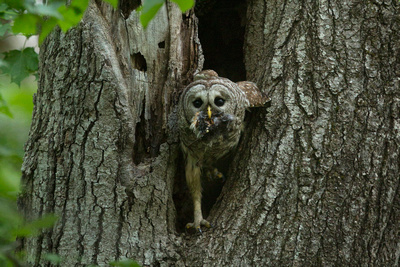 Barred Owl (Strix varia) nest in Connecticut forest.
Barred Owl (Strix varia) nest in Connecticut forest.
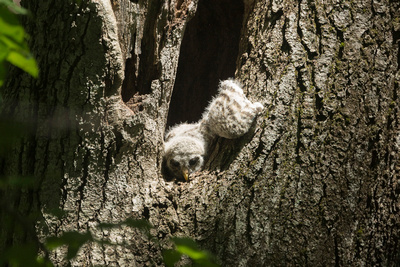 Barred Owl (Strix varia) nest in Connecticut forest.
Barred Owl (Strix varia) nest in Connecticut forest.
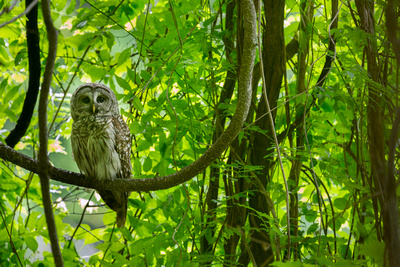 BARRED OWL 15-06-0983838Barred Owl (Strix varia) roosting near nest in Connecticut forest.
BARRED OWL 15-06-0983838Barred Owl (Strix varia) roosting near nest in Connecticut forest.
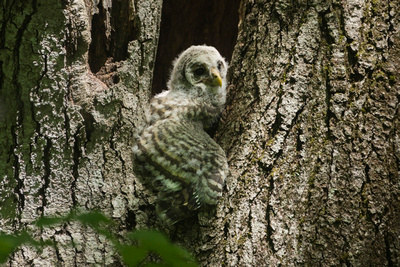 Barred Owl (Strix varia) nest in Connecticut forest.
Barred Owl (Strix varia) nest in Connecticut forest.
 BARRED OWL 15-06-0983804Barred Owl (Strix varia) adult near nest in Connecticut forest.
BARRED OWL 15-06-0983804Barred Owl (Strix varia) adult near nest in Connecticut forest.
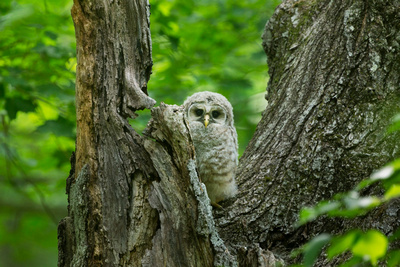 BARRED OWL 15-06-1184036Barred Owl (Strix varia) chick branching from tree cavity nest in Connecticut forest.
BARRED OWL 15-06-1184036Barred Owl (Strix varia) chick branching from tree cavity nest in Connecticut forest.
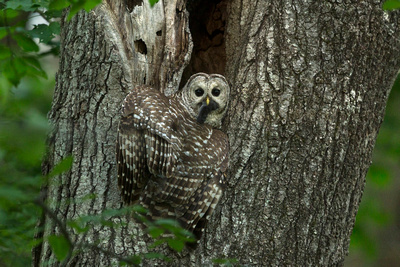 Barred Owl (Strix varia) nest in Connecticut forest.
Barred Owl (Strix varia) nest in Connecticut forest.
 BARRED OWL 15-06-1184099Barred Owl (Strix varia) chick branching from tree cavity nest in Connecticut forest.
BARRED OWL 15-06-1184099Barred Owl (Strix varia) chick branching from tree cavity nest in Connecticut forest.
When I returned late the next day, I looked from a distance with my binoculars, but there was no sign of the chicks in the tree. As I started to walk down the trail toward the spot where I had been photographing from, one of the adults flew out and landed in a tree just in front of me, staring down at me. The chicks had likely branched out of the nest, still unable to fly, and were most vulnerable at this time. I decided to leave well enough alone, whispered a quiet thank you under my breath, and retreated back to my car. The Holy Grail was finally attained, I was grateful for the time I had with them. With my faith in the self-assignment approach restored, there are plenty of new Holy Grails on my list to find now.
]]>
 OSPREY 15-04-1282263NIANTIC, CT Osprey (Pandion haliaetus) with Alewife catch.
OSPREY 15-04-1282263NIANTIC, CT Osprey (Pandion haliaetus) with Alewife catch.
There just didn't seem to be that many fish this year. I figured the cold spring had delayed the Alewife runs as it did the returning Osprey, or even worse, that the number of returning fish had declined sharply. Either way, it was a disappointment for me, and a problem for the Osprey, that were forced to look farther away for different types of fish. One Osprey I photographed in a courtship display near Rocky Neck actually had a trout in its talons.
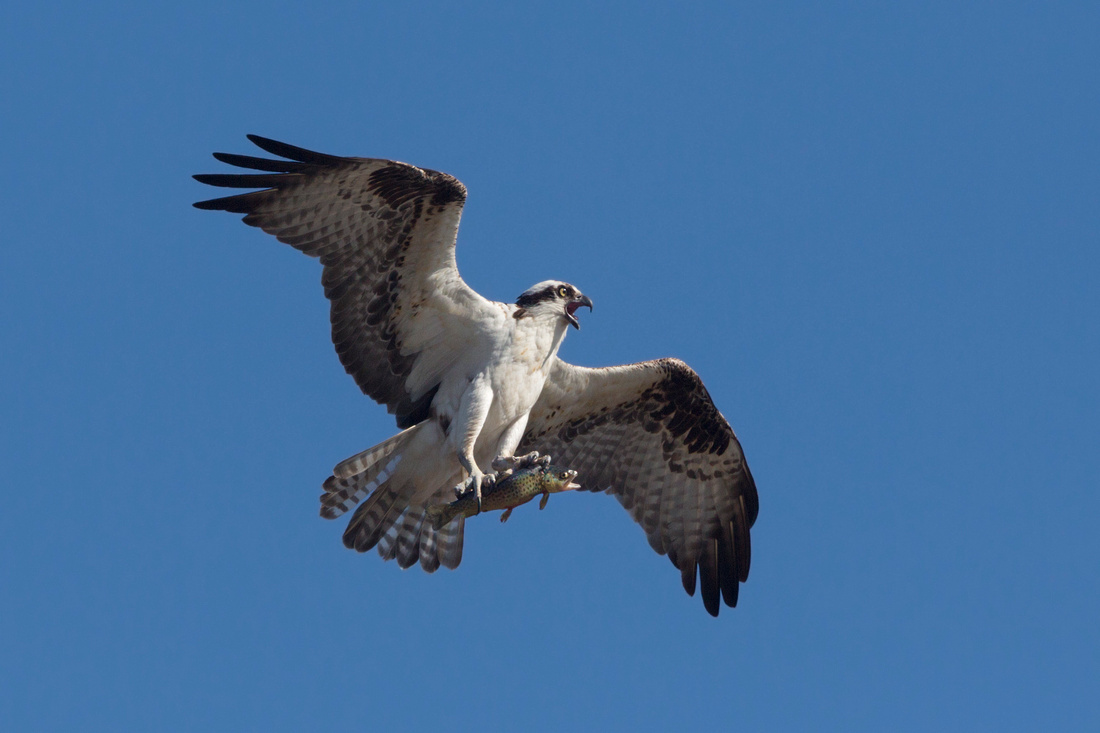 OSPREY 15-04-0181812BOLD LYME, CT Osprey (Pandion haliaetus) in courtship display with trout.
OSPREY 15-04-0181812BOLD LYME, CT Osprey (Pandion haliaetus) in courtship display with trout.
In mid-May I took an evening drive through Rocky Neck even though I've usually moved on to greener pastures (actually the woods) by then, and noticed a lot of gull activity near the bridges near the mouth of the Bride Brook. The park has usually quieted down a lot by then, so I was surprised to see so much commotion. I stopped to investigate, and saw the gulls circling and diving into the water, which was percolating with schools of fish. It was a month or so after the Alewife runs were expected, but could they have arrived this late?
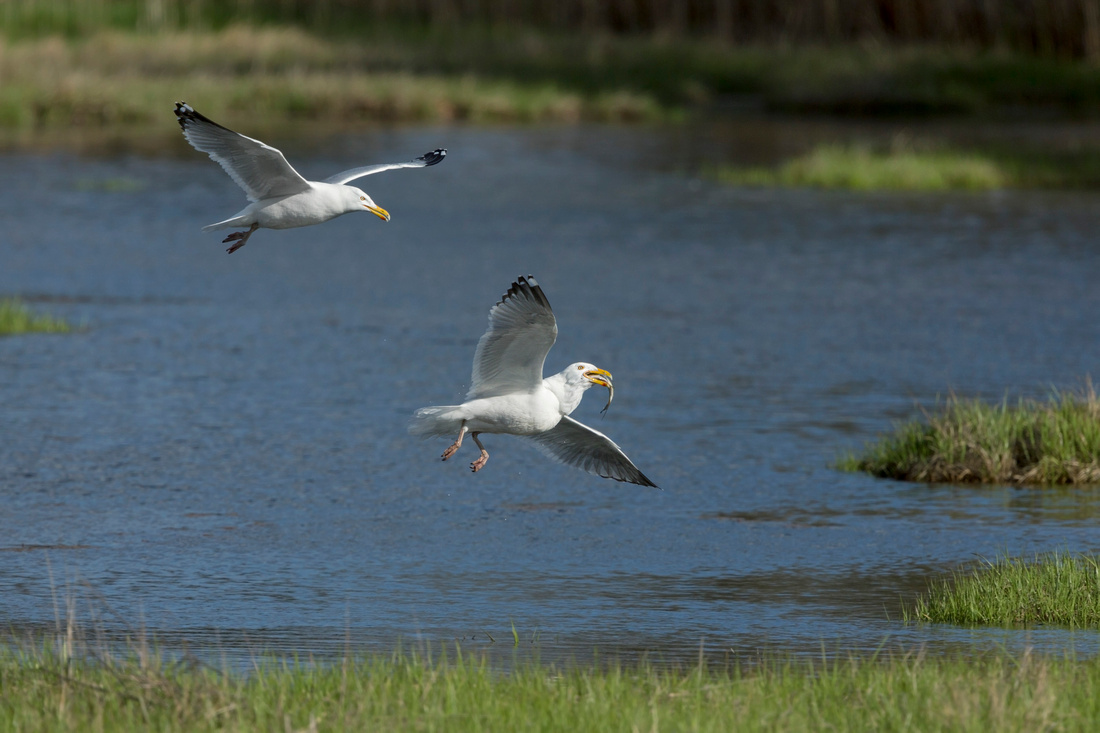 HERRING GULL 15-05-1382730NIANTIC, CT Herring Gull (Larus argentatus).
HERRING GULL 15-05-1382730NIANTIC, CT Herring Gull (Larus argentatus).
The next morning I went back and found the same situation. I could see the large schools of Alewife swimming between the two bridges, sometimes right below me. I had never seen the fish like that before, and was surprised to see them swimming back and forth up and downstream during the day. Several years ago, while working on a newspaper story about the DEEP's efforts to restore the dwindling Alewife runs, I learned that the fish swim upstream at night, so this seemed odd.
 ALEWIFE 15-05-1482809BNIANTIC, CT Alewife (Alosa pseudoharengus) is an anadromous species of herring that returns from the ocean each spring to spawn in fresh water. Shortly after spawning they return to the ocean. These fish were photographed in a shallow salt marsh tidal creek on there return run to the ocean.
Even though the water was "boiling" with fish, only one or two Osprey were in the area to fish them, most had established their nest sites and fishing grounds by then. Even the gulls were not as active as the night before, perhaps they had their fill already? One creature, however, was having a field day with the abundant supply of Alewife. A mink repeatedly slunk to the edge of the brook, and slid into the water.
ALEWIFE 15-05-1482809BNIANTIC, CT Alewife (Alosa pseudoharengus) is an anadromous species of herring that returns from the ocean each spring to spawn in fresh water. Shortly after spawning they return to the ocean. These fish were photographed in a shallow salt marsh tidal creek on there return run to the ocean.
Even though the water was "boiling" with fish, only one or two Osprey were in the area to fish them, most had established their nest sites and fishing grounds by then. Even the gulls were not as active as the night before, perhaps they had their fill already? One creature, however, was having a field day with the abundant supply of Alewife. A mink repeatedly slunk to the edge of the brook, and slid into the water.
 AMERICAN MINK 15-05-1582618NIANTIC, CT American Mink (Neovison vison).
A short while later it would climb out and bound along the same route through the salt marsh with its impressive catch, to a spot at the edge of the adjacent woods. The fish looked to be close to half the size of the mink itself. I witnessed this five or six times within the span of a couple hours, so it seems unlikely that it could be eating the fish on its own, and must have had a family to feed in a hidden den. One two occasions the mink had an eel, equally impressive in relative size, instead of an Alewife.
AMERICAN MINK 15-05-1582618NIANTIC, CT American Mink (Neovison vison).
A short while later it would climb out and bound along the same route through the salt marsh with its impressive catch, to a spot at the edge of the adjacent woods. The fish looked to be close to half the size of the mink itself. I witnessed this five or six times within the span of a couple hours, so it seems unlikely that it could be eating the fish on its own, and must have had a family to feed in a hidden den. One two occasions the mink had an eel, equally impressive in relative size, instead of an Alewife.
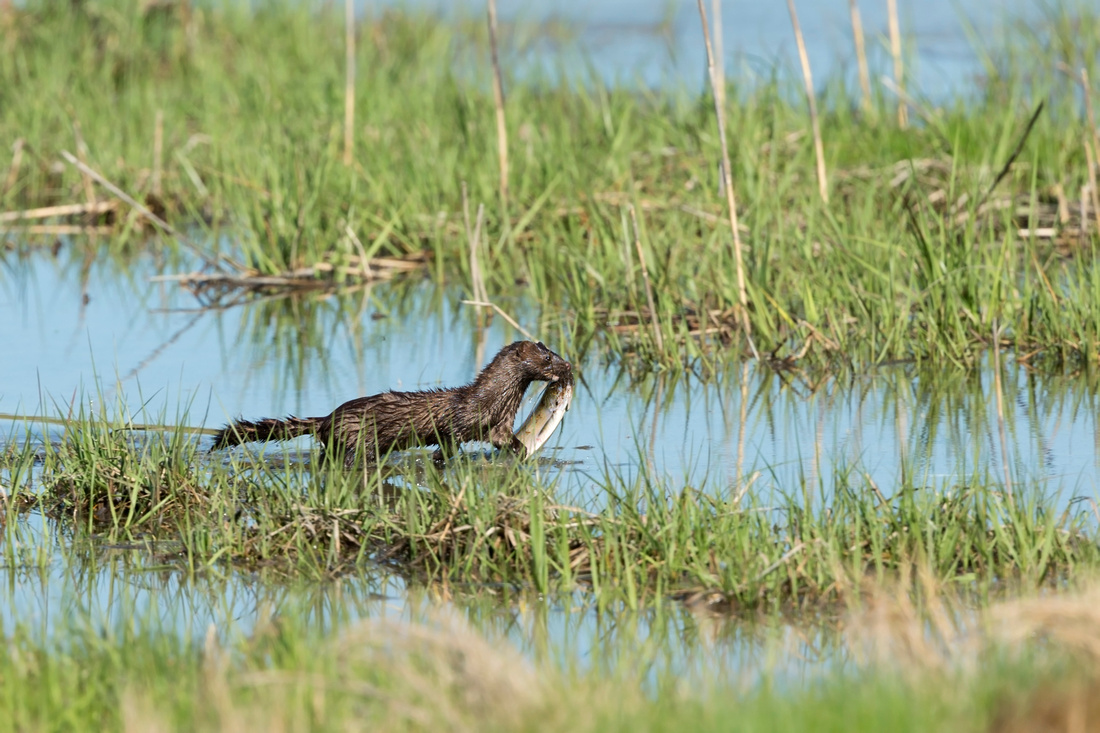 AMERICAN MINK 15-05-1582625NIANTIC, CT American Mink (Neovison vison).
As the light got too harsh for photography, I walked back to my car and a man in a pick-up truck rolled his window down and asked what I was photographing. "Birds", I said, not wanting to get too specific. He replied that I should go the the beach at the mouth of the brook because the gulls were having a field day with river herring. We struck up a conversation and I found out he worked for the DEEP's anadromous fish program and was monitoring the Alewife in the Bride Brook. It turned out that the fish were not entering the brook to spawn, but actually on their way back out to the ocean. They had become trapped by the sandbar that built up in front of the restored channel the DEEP created at the mouth of the brook and could only exit the brook at the highest tide. This was the reason they were swimming back and forth during the day. I also learned that the herring did return at about the same time they usually do and the numbers were actually pretty good this year.
AMERICAN MINK 15-05-1582625NIANTIC, CT American Mink (Neovison vison).
As the light got too harsh for photography, I walked back to my car and a man in a pick-up truck rolled his window down and asked what I was photographing. "Birds", I said, not wanting to get too specific. He replied that I should go the the beach at the mouth of the brook because the gulls were having a field day with river herring. We struck up a conversation and I found out he worked for the DEEP's anadromous fish program and was monitoring the Alewife in the Bride Brook. It turned out that the fish were not entering the brook to spawn, but actually on their way back out to the ocean. They had become trapped by the sandbar that built up in front of the restored channel the DEEP created at the mouth of the brook and could only exit the brook at the highest tide. This was the reason they were swimming back and forth during the day. I also learned that the herring did return at about the same time they usually do and the numbers were actually pretty good this year.
 ROCKY NECK 15-05-1583417NIANTIC, CT Alewife restoration efforts at the mouth of the Bride Brook at Rocky Neck State Park.
ROCKY NECK 15-05-1583417NIANTIC, CT Alewife restoration efforts at the mouth of the Bride Brook at Rocky Neck State Park.
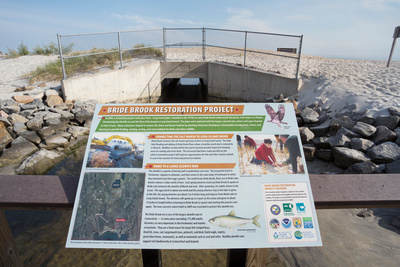 ROCKY NECK 15-05-1583433NIANTIC, CT Alewife restoration efforts at the mouth of the Bride Brook at Rocky Neck State Park.
ROCKY NECK 15-05-1583433NIANTIC, CT Alewife restoration efforts at the mouth of the Bride Brook at Rocky Neck State Park.
One of the things I like most about photographing wildlife is that it provides a first hand opportunity to observe and learn about the things I take pictures of. What I learn can then be helpful in finding new photo opportunities in the future. Instead of getting the herring on the way in, this year I got them on the way out. I haven't ever seen the Alewife returning to the sea in such a dramatic way, and may never again, but now I'll be looking out for it if it happens.
]]>
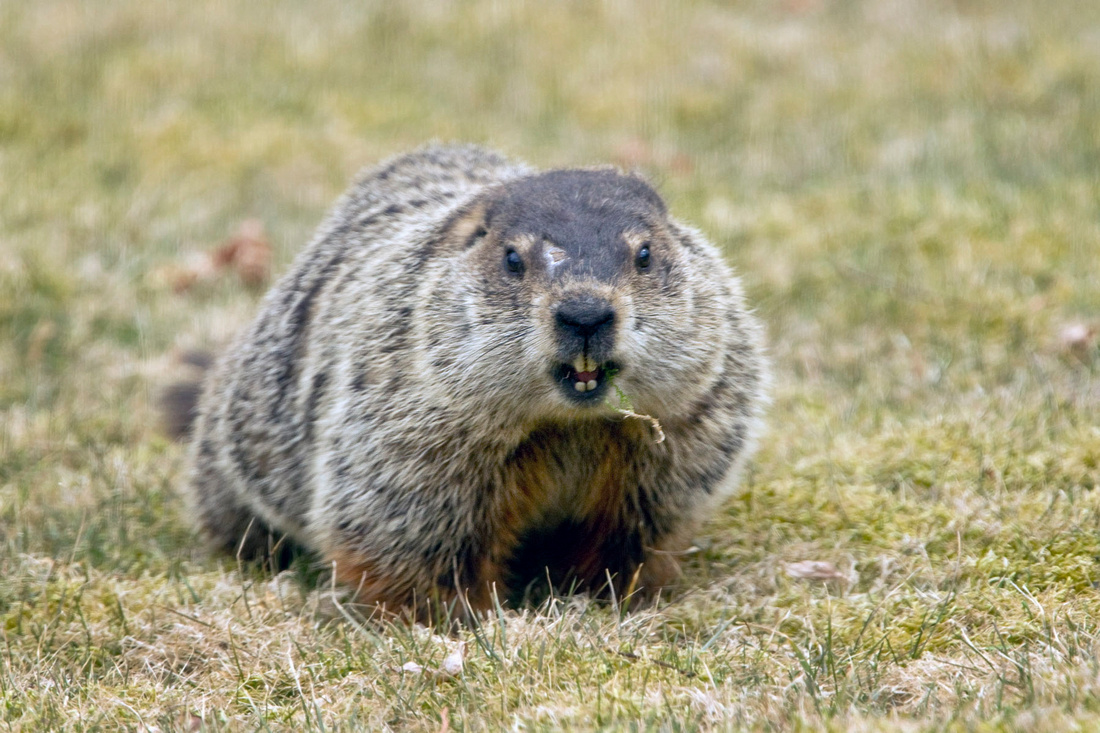 The Audubon article begins with a Florida photographer who was prosecuted for violating the Endangered Species Act by getting too close to a Snail Kite nest on several occasions, ignoring a sign posted to keep viewers a certain distance away. The photographer in question was leading a commercial tour for other photographers, taking them by boat to what I assume is a pretty remote location. While I don't know him personally, I am familiar with his work and he is very good at what he does, and has built his tour business on those talents. Of course that doesn't give him the right to violate the law, and it appears that his case is pretty black and white. The more common problems are the gray areas where nobody sees eye to eye.
The Audubon article begins with a Florida photographer who was prosecuted for violating the Endangered Species Act by getting too close to a Snail Kite nest on several occasions, ignoring a sign posted to keep viewers a certain distance away. The photographer in question was leading a commercial tour for other photographers, taking them by boat to what I assume is a pretty remote location. While I don't know him personally, I am familiar with his work and he is very good at what he does, and has built his tour business on those talents. Of course that doesn't give him the right to violate the law, and it appears that his case is pretty black and white. The more common problems are the gray areas where nobody sees eye to eye.
Experienced wildlife photographers know that having a good knowledge of their subjects is one of the most important tools they can possess to get good pictures. Many started out as biologists or naturalists, and some may know as much about the creatures they photograph as anyone, including birders or researchers. While hard-earned experience and knowledge is helpful, it can sometimes lead to hubris, and allow a photographer to feel it's okay to push a subject to get the desired picture. With some newer photographers, a lack of experience may cause them to cross the line without even knowing it, and with some there is just a lack of concern for their subjects. The question is what are the limits and who determines them.
Working as a newspaper photographer, I was occasionally able to gain access to protected wildlife through my job and was able to get pictures that might not be accessible to everybody. I have tried to work with scientists and researchers both for access and for guidance on how to safely photograph certain subjects, but is it okay for a newspaper photographer or one shooting for National Geographic or Audubon to take certain pictures and not okay for another photographer?
As a photojournalist, most of my work was to illustrate news stories with informative and interesting pictures. My approach to wildlife photography is similar, and I try to portray creatures in a way that tells something about their lives, what they eat, where they live ....etc. It's for that reason that I like photographing nesting birds, because it is such an important part of their lives. I know it's a sensitive subject, and there are many wildlife photographers will never photograph birds on the nest and bristle when others do. I wrote a blog post about photographing nesting birds a long time ago, which remains an unpublished draft because other than me, who cares what I think?. I'm not trying to encourage anyone else to photograph nesting birds, just explain how and why I do.
One of my earliest nest encounters was in the 1990's with a Yellow Warbler which I found just off a path in a popular park. I watched the nest from a distance for a couple weeks (I knew not to photograph until the chicks hatched because there would be a greater chance that they could abandon the site). I told a few other local birders who were very helpful and friendly to me about the nest and when the chicks hatched, I waited through the weekend when the park was busy and went early Monday morning to get my first pictures. When I arrived at the nest, there was a photo blind set up in front of it, so I walked around the rest of the park for a while and returned again but the blind was still there. I set my gear down about 50 yards away and waited until the photographer eventually got out and started to yell at me. He gave me some B.S. story about how he had been photographing the nest for weeks and had sold several pictures from it already, but I found out he was on a bird walk that weekend led by one of the birders I'd told about the nest. I came back later and found that he'd cut some branches below the nest exposing the bright nest fibers and making the nest much more conspicuous. The birds were okay, but I learned an important lesson that has stuck with me since. Never tell anyone else about a found nest.
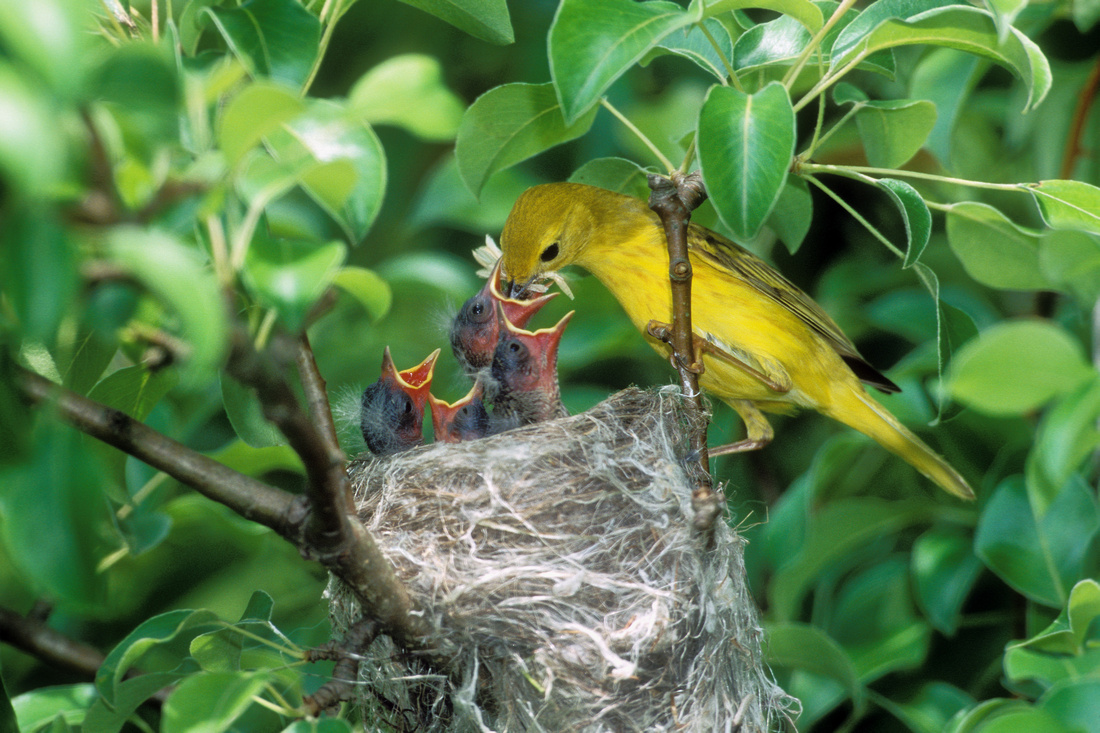
The Audubon article talks about the danger of photographers leading groups of people to nesting areas. A year after my Yellow Warbler episode, I went on a group tour to Churchill led by professional wildlife photographers. There were six clients and two guides and we photographed nesting birds, mostly shorebirds, on the open tundra. It was a productive trip, but there were a few things I was uncomfortable with. I felt uneasy being in a group of large men shooting small birds from a few yards away, even though the bird seemed to tolerate our presence.
 On top of that, there were some in the group who wanted to get closer than others were comfortable with, causing the birds obvious stress. I was excited to photograph these beautiful birds in breeding plumage, sitting on their nest, but felt bad when they went through their distraction displays when we first approached or when someone moved too close.
On top of that, there were some in the group who wanted to get closer than others were comfortable with, causing the birds obvious stress. I was excited to photograph these beautiful birds in breeding plumage, sitting on their nest, but felt bad when they went through their distraction displays when we first approached or when someone moved too close.
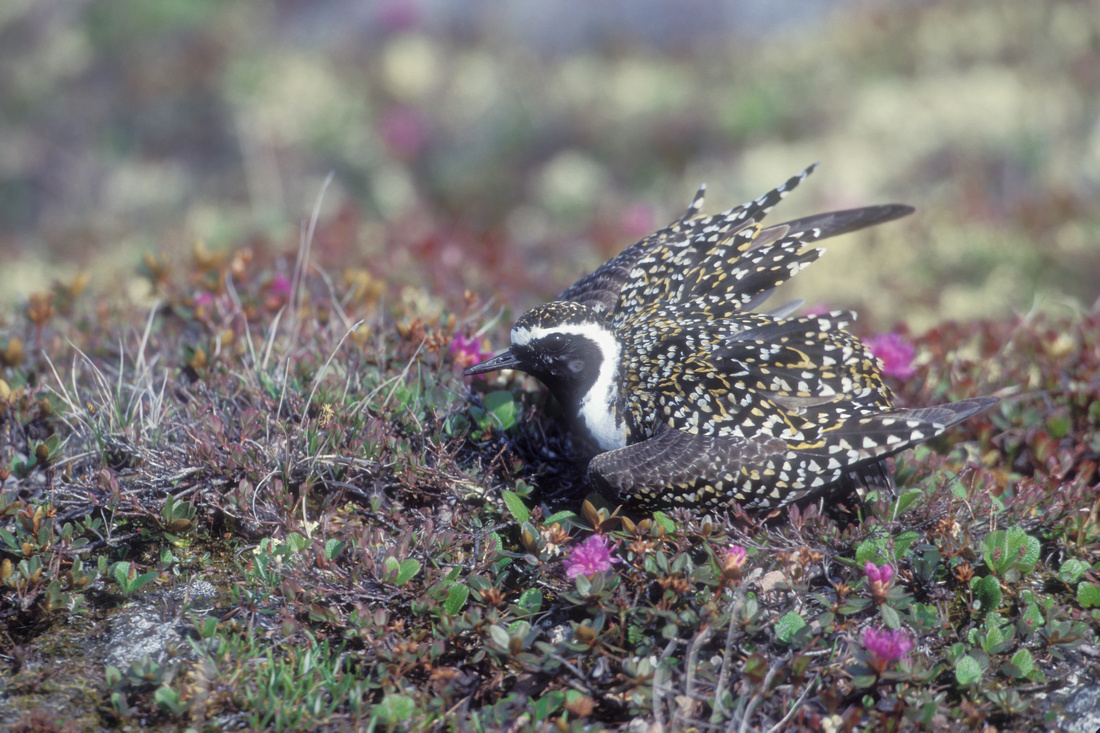 One day we found a beautiful Pacific Loon, one of my main target species for the trip, on its nest and were getting incredible full frame pictures in great light.
One day we found a beautiful Pacific Loon, one of my main target species for the trip, on its nest and were getting incredible full frame pictures in great light.
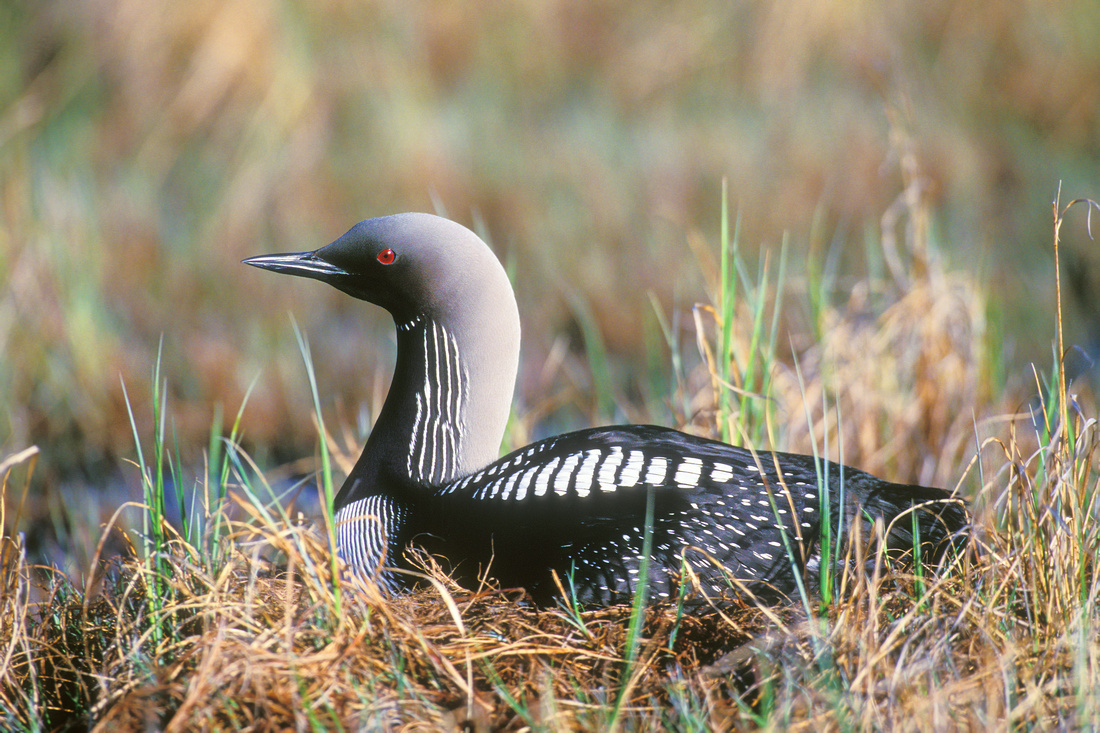 Some in our group kept creeping closer, until the bird finally sprang from the nest with a loud sound I can't begin to describe and started flailing and splashing in the pond nearby. All our cameras were clicking away for the short while this occurred, and the pictures are pretty wild, but I had a sinking feeling after it happened. I learned later that this was an alarm display and have seen published pictures of other loons just like it. The captions usually describe a rival loon approaching or a predator flying overhead, but now that I know what it is I hope I don't see it again.
Some in our group kept creeping closer, until the bird finally sprang from the nest with a loud sound I can't begin to describe and started flailing and splashing in the pond nearby. All our cameras were clicking away for the short while this occurred, and the pictures are pretty wild, but I had a sinking feeling after it happened. I learned later that this was an alarm display and have seen published pictures of other loons just like it. The captions usually describe a rival loon approaching or a predator flying overhead, but now that I know what it is I hope I don't see it again.
 The biggest problem I had with the group dynamic turned out to be that I got basically the same shots as the rest of the group and that felt less satisfying to me. My goal at the time was to sell pictures for publication, but I don't think I ever sold any from the trip. The guides that led the tour and one or two of the clients had pictures from the trip published in books and articles about the location, but the market for those type of pictures was pretty much covered. Photographing with a group and getting the same or similar pictures as a bunch of other photographers was not only less satisfying, but it was also bad business. That was the first, last and only group photo tour I've been on.
The biggest problem I had with the group dynamic turned out to be that I got basically the same shots as the rest of the group and that felt less satisfying to me. My goal at the time was to sell pictures for publication, but I don't think I ever sold any from the trip. The guides that led the tour and one or two of the clients had pictures from the trip published in books and articles about the location, but the market for those type of pictures was pretty much covered. Photographing with a group and getting the same or similar pictures as a bunch of other photographers was not only less satisfying, but it was also bad business. That was the first, last and only group photo tour I've been on.
Earlier that year, my wife and I drove to Florida to visit her family and I talked her into stopping at the Venice Rookery so I could take some pictures. We arrived in the early morning darkness, and when the sun finally rose, I was underwhelmed by the tiny stand of mangroves in the small pond at the Venice municipal complex. Among the dozens of photographers there, I met two whose work I'd seen published and complimented them on it. The asked me where I was from and I told them I was visiting from Connecticut and was hoping to visit a few of the Florida birding hotspots and asked if they had any suggestions. What happened next shocked me, but they both got angry and said they were tired of outsiders coming in and photographing in their home territory and cutting into their stock business. Florida .... Vacationland ....? Turf is turf, and it was being defended.
 The situation today is almost the exact opposite. With the advent of digital photography it seems like everyone has a camera and the flood of new photographers has completely changed the landscape of all types of professional photography, wildlife photography included. Photographers who once made a living selling stock pictures to magazines and calendars found the overwhelming volume of new work and the diminishing number of outlets for it caused publication fees to plummet, crashing their business. Magazines like Audubon were always tough to break into, but even the smallest magazines now act like you are bothering them by trying to submit pictures you want to be paid for, and they pay accordingly . Photographers who once guarded their prime shooting spots figured out that they could make up for lost publishing income by leading tours for the hordes of newcomers to those same locations. Common sense dictates that probably doesn't benefit the creatures there.
The situation today is almost the exact opposite. With the advent of digital photography it seems like everyone has a camera and the flood of new photographers has completely changed the landscape of all types of professional photography, wildlife photography included. Photographers who once made a living selling stock pictures to magazines and calendars found the overwhelming volume of new work and the diminishing number of outlets for it caused publication fees to plummet, crashing their business. Magazines like Audubon were always tough to break into, but even the smallest magazines now act like you are bothering them by trying to submit pictures you want to be paid for, and they pay accordingly . Photographers who once guarded their prime shooting spots figured out that they could make up for lost publishing income by leading tours for the hordes of newcomers to those same locations. Common sense dictates that probably doesn't benefit the creatures there.
With so many more people photographing wildlife today, it's also harder to stand out or get noticed unless you have some really unique pictures and may be willing to push the limits with your subjects. In a way, magazines, including Audubon, may be indirectly contributing to the problems when their editors select the most unique and unusual pictures to publish. If that's what it takes to get noticed or published, there are always people who will do it, and others will follow their lead. Shooting wildlife up close or with a wide angle lens, or using remote cameras or camera traps are all growing trends in wildlife photography. On the same web page for the Audubon story documenting these ethical issues with wildlife photographers is a link to the 2015 Audubon Photo Contest winners. In the gallery of top 100 photos are examples of the same things they are decrying, including extreme close-ups, wide angle close-ups and pictures of birds at their nest. One of the contest judges is a photographer whose work I admire, but I've seen close-up wide angle pictures of nesting birds on the tundra that he's taken published in National Geographic.
I don't know exactly how any of those photographs were made, but surely some birders or naturalists would take issue with these photographers if they were there to witness it. I do know that if editors and judges use or select those kinds of pictures, more photographers will copy them. While working on a photo package about the Audubon Christmas Bird Count for the Hartford Courant, I showed some of my stock photos to my editor, and she selected a picture of a screech owl with its eyes wide open. I tied to talk her into picking a picture where the owl didn't look so alarmed and wasn't staring right at the camera, but she liked owl with its wide open, as most editors do. Is it any wonder then that photographers will whistle, squeak, squeal or do whatever they can to get an owl to open its eyes, regardless of how it affects the owl.
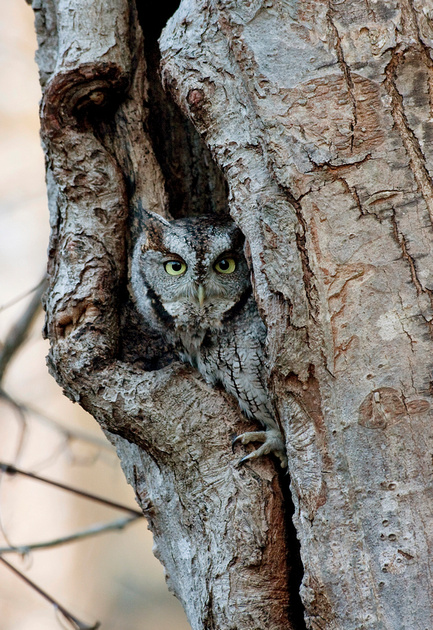

I've been trying more wide angle and remote camera techniques in recent years to get a different look than the long lens, shallow depth of field perspective so typical of most wildlife photography, including my own. Just as the wide angle shot from the Osprey nest I wrote about in my earlier blog post angered some, I'm sure there are many who would not approve of these recent efforts, not knowing how they were obtained. The Wood Thrush nest photo below was taken with a remote camera on a pole that reached nearly 10 feet over my head. I watched the bird from my car, from about about 40 yards away, for more than an hour before it left the nest, then jumped out with my contraption already set up and took about 20 pictures. The whole thing lasted around a minute and I returned to my car and the bird returned to the nest. I like the picture and I know it did not result in any harm to the birds, I saw the chicks fledged from the nest, but I'm sure this falls in the gray area for some and is completely out of bounds for others.
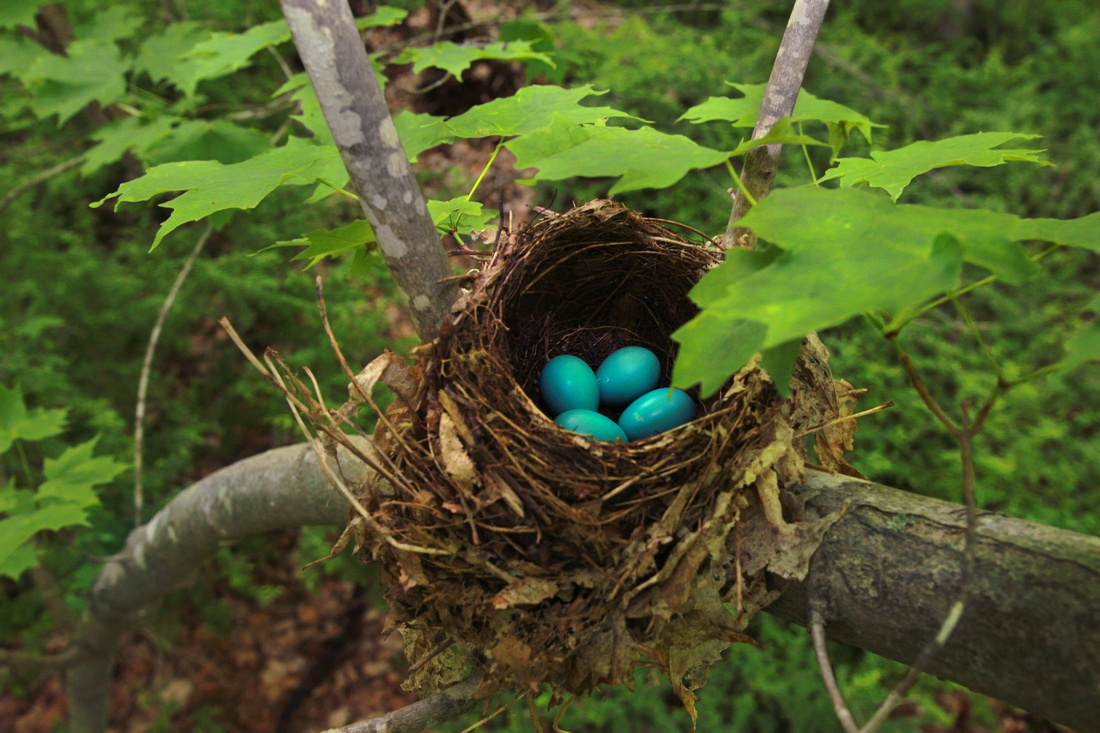
I took a philosophy course in college called Ethics. I was a biology major at the time and can't remember much of what the class was about, but I do remember that there didn't seem to be right or wrong answers, you had to subjectively reason your response. This wasn't easy to grasp for a science major. One of my favorite wildlife photography books is called "Vanishing Songbirds" by Eliot Porter. It contains dozens of beautifully lit, sharply detailed large format photos of many North American songbirds at their nest that were taken 40 or 50 years ago. The book was made in an effort to document the decline of the birds Porter was so passionate about and receives high praise, even today. I love the pictures and would like to emulate them, but by today's photography ethics, these pictures would be considered criminal evidence.
I spend lots of time in the woods each spring looking for nests and find a fair number. I never even try to photograph most of them because they are hard too even see. I have found Blue-winged Warbler and Common Yellowthroat nest sites, down to a square foot, but never seen an actual nest because I'd never part the dense clumps of vegetation they are buried in. Instead, I do the best I can to capture those kind of photos within my ethical standards. My chances are greatly limited, and the pictures are usually flawed by some distracting element I wont remove. The one picture I've taken that comes closest to those Elliot Porter pictures is one of a Worm-eating Warbler nest. I was parked in a pull-off area on a dirt road in the forest listening for songbirds with the windows down and saw the birds bringing nest material to the leaf covered hillside adjacent to my car. I was able to watch the progress of the nest for the next few weeks from my car, and eventually photograph it from an open window covered with mosquito netting. It's one of my favorite photographs because I was able to see right into the nest and into their world like I was a fly on the wall, the birds seemingly unaware of my presence, which made it so satisfying.
 In the nearly 30 years I've worked as a photographer, it has changed more dramatically than I could have imagined. New technology has made wildlife photography more accessible to many more people and the internet has made it much easier to learn how and where to find subjects. Photographers' work will evolve over time and some will shape and others follow the new styles and trends. Like most things these days, the trend is more extreme. The one thing that has not changed in that time is that wildlife photographers have come under fire for "endangering" their subjects. Game farms, baiting, getting too close, flash photography, group tours, owl roosts, Snowy Owls, Bald Eagle nests .... the list goes on and on. It's easy for someone with no interest in wildlife photography to say here's the line and you're wrong if you cross it. It's not that simple. Wildlife would be better off if there weren't six billion people on earth, too, but I don't see those people volunteering to check out. Right or wrong, black or white, or the dreaded gray areas, pushing the limits has always been a part of progress. I think photographers need to figure out when we have reached the line, beyond which we are harming our subjects, and hopefully we don't cross it.
In the nearly 30 years I've worked as a photographer, it has changed more dramatically than I could have imagined. New technology has made wildlife photography more accessible to many more people and the internet has made it much easier to learn how and where to find subjects. Photographers' work will evolve over time and some will shape and others follow the new styles and trends. Like most things these days, the trend is more extreme. The one thing that has not changed in that time is that wildlife photographers have come under fire for "endangering" their subjects. Game farms, baiting, getting too close, flash photography, group tours, owl roosts, Snowy Owls, Bald Eagle nests .... the list goes on and on. It's easy for someone with no interest in wildlife photography to say here's the line and you're wrong if you cross it. It's not that simple. Wildlife would be better off if there weren't six billion people on earth, too, but I don't see those people volunteering to check out. Right or wrong, black or white, or the dreaded gray areas, pushing the limits has always been a part of progress. I think photographers need to figure out when we have reached the line, beyond which we are harming our subjects, and hopefully we don't cross it.
One day in May I found what looked like a freshly excavated Pileated Woodpecker hole and a tent caterpillar web near the parking lot of a land trust property in Lyme. I sat in my car and watched to see if any birds might visit either site. While waiting I saw a male Eastern Bluebird flying past several times carrying food. I followed it as it flew to one branch for a few seconds, then to anther, then eventually dropped down to a tree stump where it deposited its catch into a woodpecker hole in the decaying tree trunk. Bluebirds that nest in boxes around open fields are pretty easy to find and photograph, but it was the first time I'd seen one in a natural tree cavity nest in the woods.


Around the same time, I found fairly large nest on a bent sapling less than a mile a way. It looked like an American Robin or Wood Thrush nest, but I watched it at a distance for quite a while and didn't see any birds. I decided see if there were eggs in it and set up my camera with a remote trigger on an extendable pole and took a few shots from above the nest. It was empty. The following week I returned to find a Wood Thrush sitting on the nest. I usually don't take pictures of nesting birds while they are incubating but I wanted to see if the nest might have been parasitized by cowbirds since it was so exposed. Again, I watched from a distance until the bird left the nest, then using the same remote set-up I quickly photographed the nest from above. This time four sky blue eggs and no brown speckled eggs revealed that the nest had not been parasitized.

I found two other Wood Thrush nests, probably the most conspicuous song bird nests, the same week. I used the same method to photograph them and found them undisturbed as well. Another theme was developing this nesting season, I was on a blue streak.
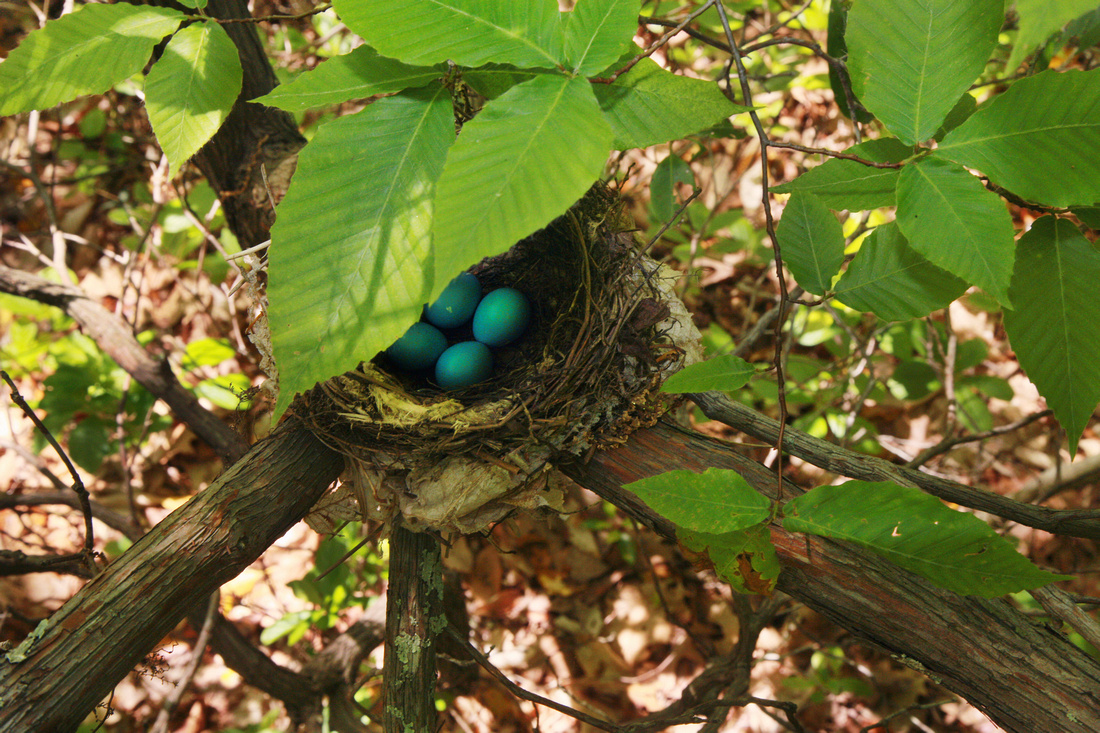
A few days later, my streak was confirmed. An open gate in Nehantic State Forest, one that is normally closed, got me to stop and investigate. Just beyond the gate a bird was singing like the proverbial fat lady (Viking helmet and all) from the edge of a clearing. The song didn't register at first, but I should not have been surprised to find that it was an Indigo Bunting.
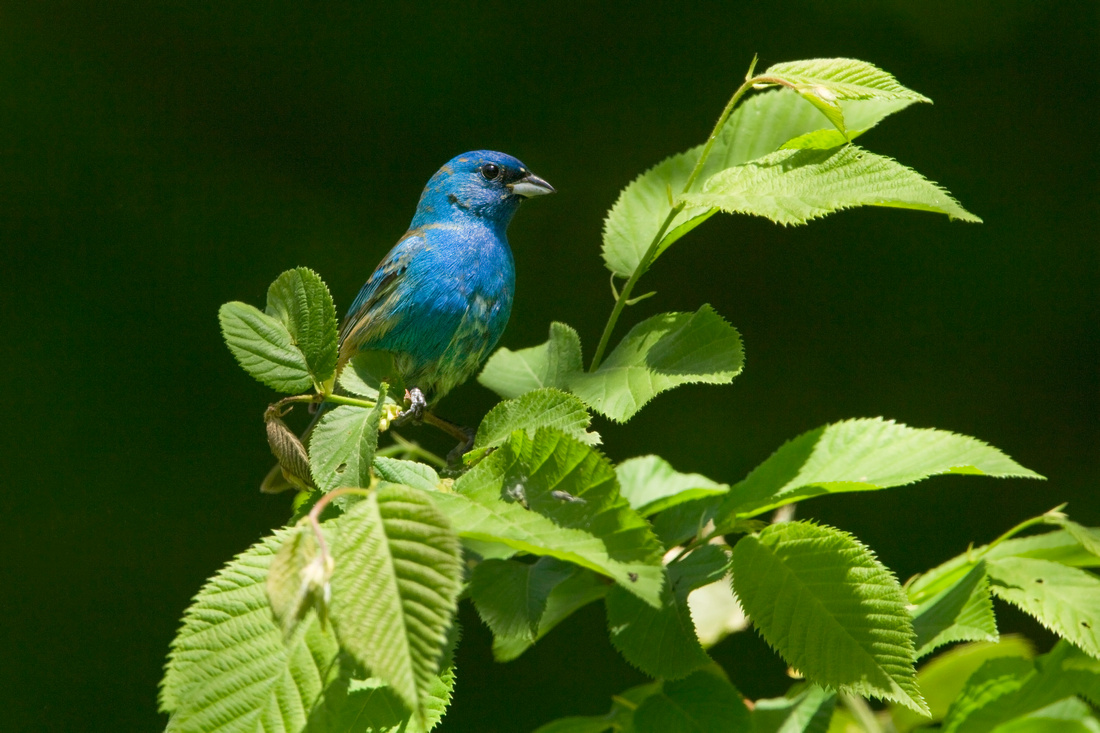
The blue streak was not powerful enough to overcome my uncanny propensity to find only Indigo Buntings that are in some state of molt, and not the perfect all blue specimens that my colleagues seem to find at exactly the same time.

As the nesting season quickly progressed, the bluebirds fledged their young while I was busy with work. I found a few other nests but only two could be photographed, and they too, turned out to be a disappointment (I'll detail in the next post). The Wood Thrush nests all hatched out and I was able to photograph one of them with the adults feeding their chicks. Then work, weather and family events kept me away for five days and I returned to find the nests all but empty. Two were abandoned and in the third, one almost full sized chick remained, missing only its tail feathers. I set up to photograph it, keeping a safe distance, and saw the adults feeding the other fledged chicks in the surrounding woods. One returned to feed the remaining chick a couple times but seemed to be trying to entice it to leave the nest to get its food. The leaves surrounding the nest had grown to obstruct the once open view, so I gave up and went back to my car. I watched for another half hour and saw the chick hop from the nest and out onto a branch, then flutter away out of sight. Just like that, the nesting season seemed to be over for another year, gone in a blue streak.
]]>Trying to make the most of the natural activity and diversity of springtime in Connecticut, I try to get out frequently near my home in search of subjects to photograph. Sometimes I feel pressure to be as productive as possible during this short time of plenty. So after a busy week without much time for the outdoors, I was anxious to head out and find something to shoot. I set out on one of my favored routes in the afternoon, through the woods of Lyme and East Lyme, despite the dreary weather. After a few fruitless stops at some of the many land trust preserves and state forest areas on my route, I decided to pack it in, thinking it was a lost cause.
On my way home, I caught a glimpse of the familiar football shape of a hawk through the trees and hit the brakes. Fortunately, these roads are lightly traveled, and I backed up to see what kind of hawk it was. A Broad-winged Hawk was hunting from a perch in a wooded swamp about 50 yards away, so I pulled off the road to see if I could get a picture. The hawk cast a few curious glances my way as I inched my car back and forth, trying to find a clear view of it through the trees, but continued its hunt. While searching for a vantage point to photograph the too-distant hawk through the jumble of gray trees, shooting up into the dull gray sky I was thinking "I'm really getting desperate here".
After finally settling on a spot, training my long lens with teleconverter out the car window balanced on a jacket (I've never been able to justify spending so much on a specialized been bag for such purposes) the seconds had turned to minutes. Finding an exposure that I could shoot hand held and captured enough detail in the dark hawk while not completely blowing out the sky added more time. That the hawk was still there seemed a miracle, as I waited even longer for moments when would turn its head to the side or back toward me. Finally, a pick-up truck drove by, and the driver give me that "what the heck are you doing" look. By then I had taken more than 100 pictures and my thoughts echoed his look, "why am I wasting so much time on this picture, it's obviously a lost cause".
A week later, as I was catching up on editing and came across these raw pictures, I had similar sentiments and deleted most of them because they weren't sharp enough. I opened one of the keepers to see if I could do anything in the processing to transform the dull gray image and a glimmer of hope appeared. Photography is extremely subjective, and opinions will always vary about what makes a good photograph. I'm not sure whether it's because I had no hope for these pictures, or that the hints of color from the emerging leaves break up the gray linear composition, or that it shows the hawk in its habitat, doing what it does, but this turned into one of my favorite pictures from this spring. The popular trend in wildlife photography has been toward the sharp, clean close-ups with soft, out of focus background and no distracting elements. I like those kind of pictures but find they get boring pretty quickly. There is something rewarding about being able to organize the chaos that nature sometimes presents, and capture something a little less obvious that makes you look a little a little longer and closer at an image. It gives hope to all the lost causes out there.

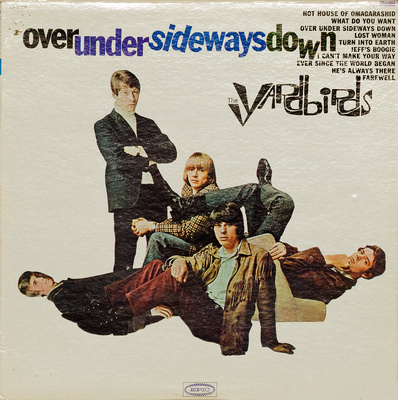
No, not the English rock supergroup of the 1960's that launched the careers of guitar legends Eric Clapton, Jeff Beck and Jimmy Page. At the risk of dating myself, they were one of my favorite bands as a teenager (I still have my original Mono album) even though they were over by the time I was five years old. I wonder why they named themselves The Yardbirds, since it seems to imply the common or ordinary. Fast forward four decades or so and I'm still into the yardbirds.
I've been photographing birds in my yard for 20 years and have not done too bad considering my modest plot. Each new season brings a new batch of subjects, although it's usually the same new batch year after year, and they have become ordinary to me over time. Reports in the spring of people seeing migrant warblers like Cape Mays and Blackburnians in their Connecticut yards always turns me a bit green with envy ...... "the grass is always greener". But each new year holds new hope, so I keep at it.
After a cold spring, the season kicked off for me on Mother's Day weekend, when I walked out the front door to get a package and scattered a House Finch from the shrubs next to the landing. The reason for its close proximity stared me right in the face, a nest with two chicks in the back of a dwarf Alberta Spruce. I went inside and watched from the window for a while as the adults came and went, feeding the chicks. I decided to to set up a camera under the eaves and trigger it remotely from inside. After a couple failed attempts at framing and focusing (I couldn't look through the back of the camera since it was up against the house) I finally got it right.
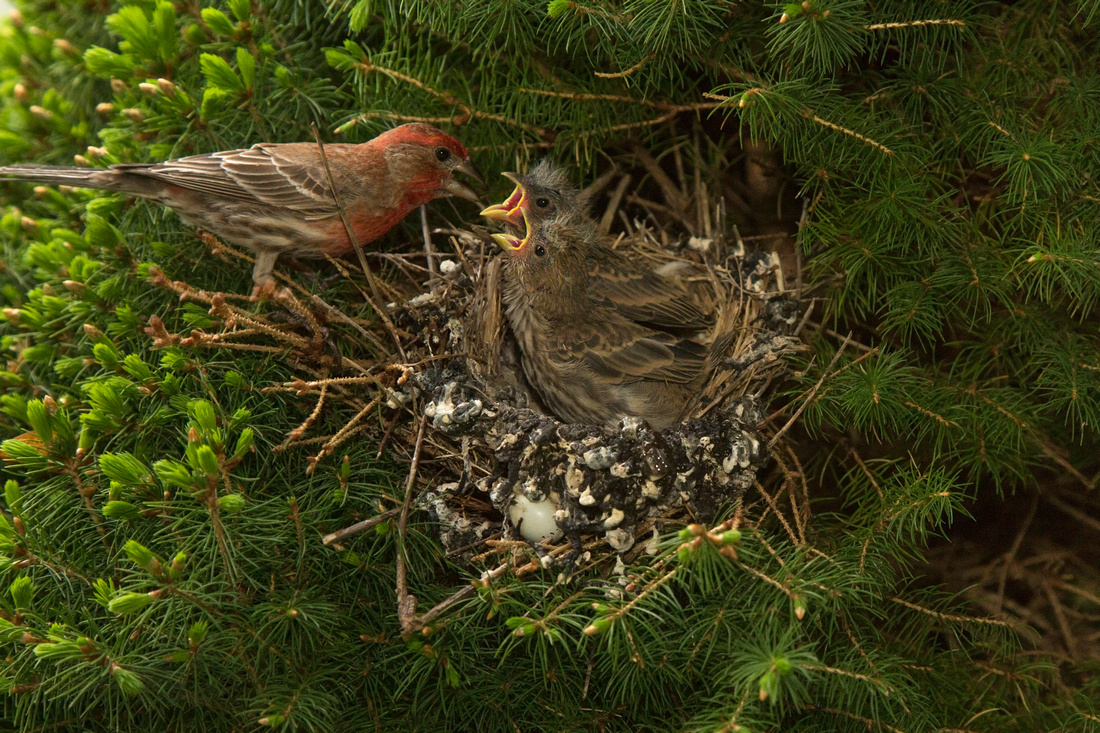
The nest was pretty ugly since the adults stop removing the chick's fecal sacs, and and it was ringed with excrement. An unhatched egg was buried under a pile of it, as well. The adults also never brought insects, like other birds do, to feed the chicks. Instead, it was some ground up stuff they regurgitated. I've since learned that House Finches feed their chicks mostly plant matter, and dandelion seeds are a favorite food. Sadly, my lawn has plenty of them. While I watched from the window, waiting for the adults to return, I noticed another pair had a nest lower down in the same bush, buried way inside and a third pair nested in a similar tree about 10 yards away. Later in the day I took a walk around the block with my wife and we scared several blackbirds from a neighbors lawn. One turned out to be a male Bobolink and when we got back around to our house it was in our yard. A new yard bird added to the list!
The next few days the migration seemed to peek in Connecticut, and we had a bunch of new arrivals in our yard. Among them, a pair of Great Crested Flycatchers that were dust bathing in our garden and a House Wren that plucked fibers from the frayed net of my son's lacrosse goal. One day as I was loading my gear into the car to go to a job, I heard a high pitched song in the back yard. I walked around back and saw the pear tree, in full blossom, dripping with a half dozen or more Blackpoll Warblers. I grabbed a few quick shots and headed to work, hoping they would still be around when I got back.
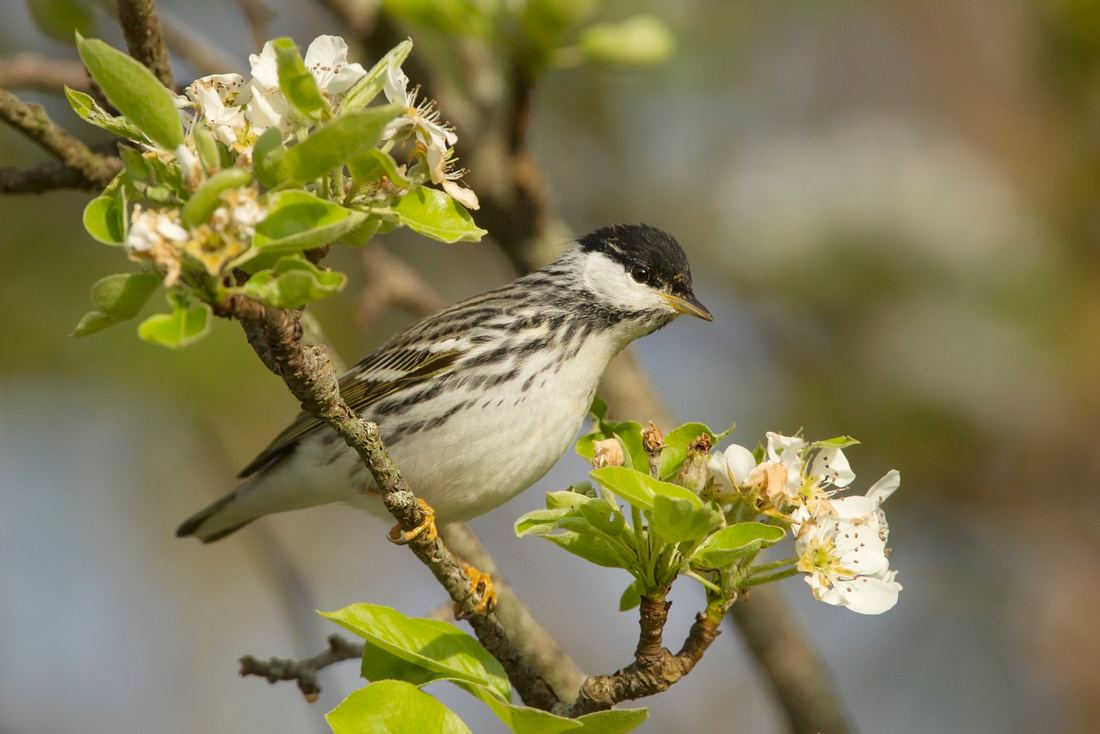
The good thing about my yard is that there are several fruit trees, a pear, two apples and a cherry that were planted 60 years ago by my grandparents. Behind them are two tall oaks and closer to the house are a few crabapple trees that I planted to provide shade for our two dogs, who have since departed. The bad thing about it is that we're in eastern Connecticut near the coast (I know .... you're thinking why is that bad?) The reason it's bad is that we get far fewer spring migrants than central or western Connecticut. It's most likely just geography, but another reason might be that because of the cool ocean air the trees leaf out here at least a week later than other parts of the state, so most of the migrant songbirds I see in our yard are towards the tail end of the season. The fruit trees, however, usually blossom in early May before we get many migrants. Some years we have orioles feeding in the blossoms but if it's a warm spring, the blossoms are often gone even before the orioles return.
So back to my pear tree and the Blackpolls. They were still there when I got home, and I spent the last hour of sunlight photographing them while "hiding" behind the aforementioned lacrosse goal. The cold spring this year held the tree blossoms back until mid-May and the birds were here to capitalize. Timing is everything. The next morning I went out early and even more had warblers joined the feeding frenzy, Blackpolls were everywhere. We often get a few late in migration way up in the oak trees but these were at eye level!

Joining the Blackpolls were a couple Magnolia Warblers, several Northern Parulas, a few resident Yellow Warblers, Baltimore Orioles, and an immature Orchard Oriole. The next couple days it was tough to get much processing work done, because every time I got up from the computer I'd see more birds and get sidetracked photographing them. There was also a Worm-eating Warbler, a first time yardbird, and Common Yellowthroats that I never got clear shots of. I also heard a Blue-winged Warbler singing, but never saw it.

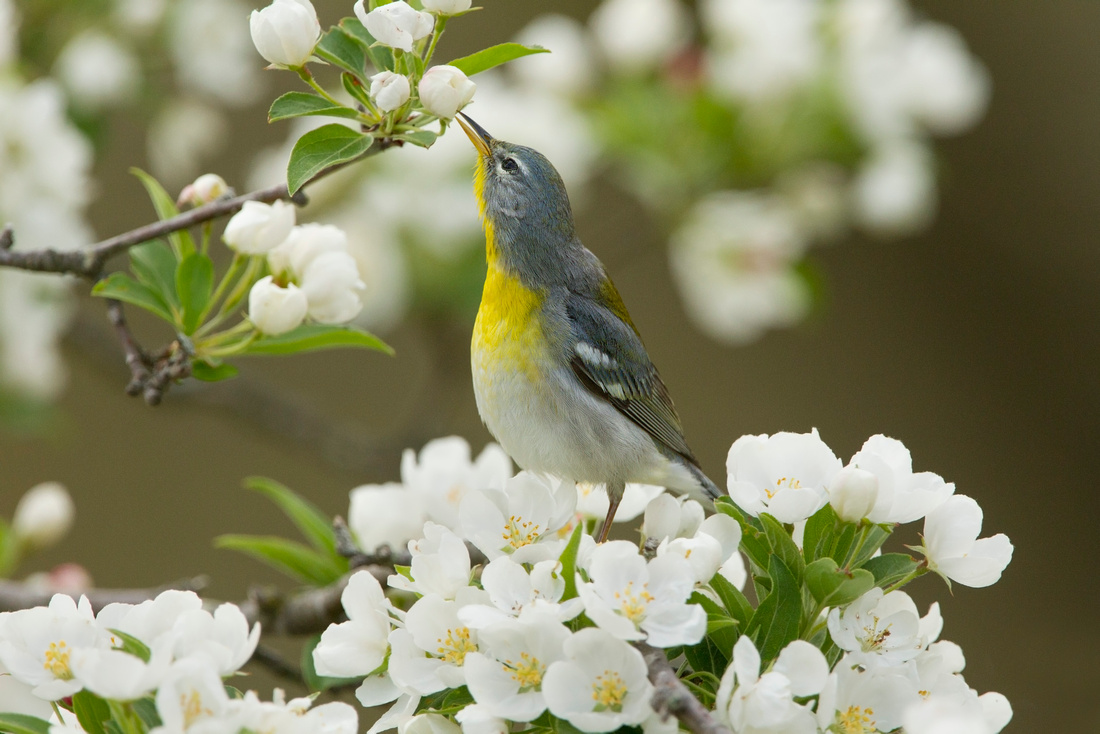
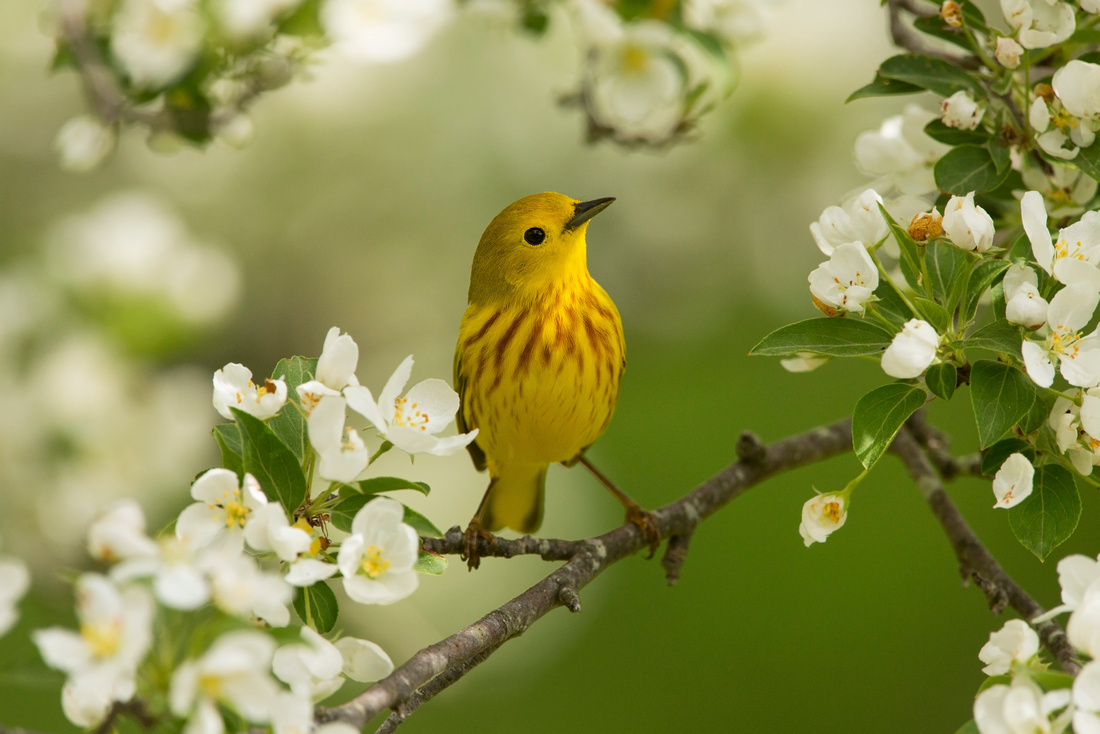
What the birds are actually eating in the tree blossoms appear to be small worms, although some birds tear off the whole flower to get at them. I was able to capture several shots of birds with small worms in their beaks.


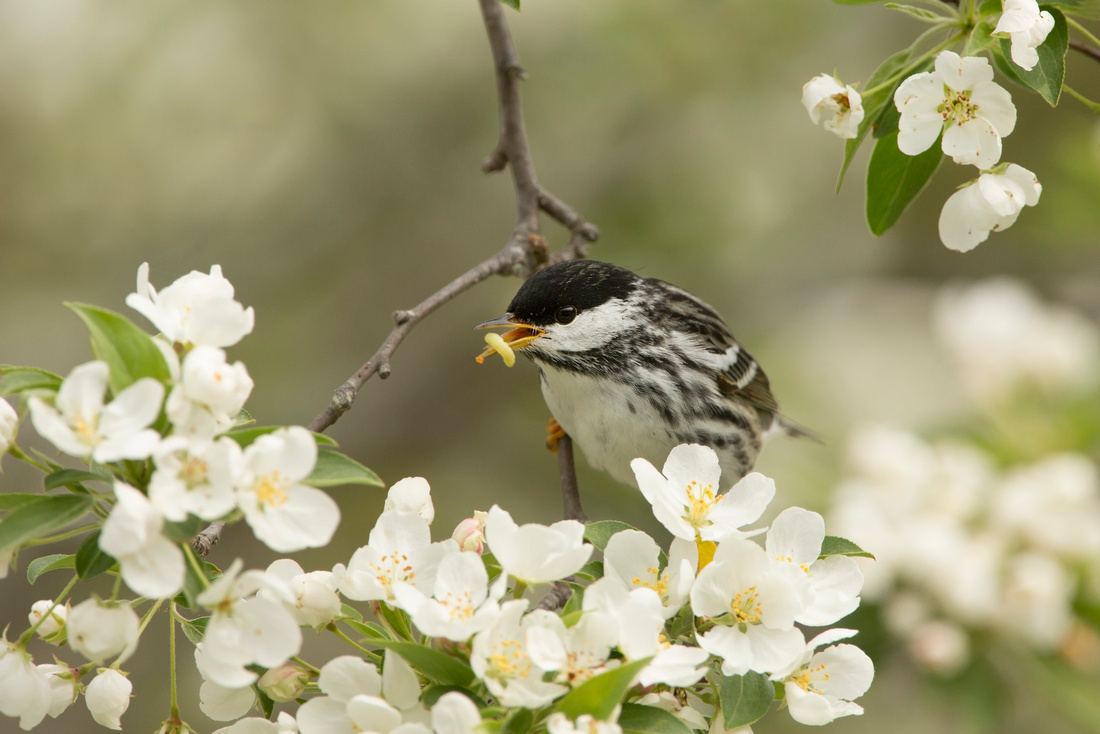 The cherry on top of the whole episode was that two of the flowering crabapple trees are right next to the house, and I was able to shoot from inside, through open windows. Using the camera on quiet mode, the shutter made almost no sound and the birds took no notice of me as they foraged undisturbed. As a photographer, you know things are going well you have to make the tough decisions about what to shoot. Do I focus on the female Baltimore Oriole hanging upside down in the white blossoms, with the clean background?
The cherry on top of the whole episode was that two of the flowering crabapple trees are right next to the house, and I was able to shoot from inside, through open windows. Using the camera on quiet mode, the shutter made almost no sound and the birds took no notice of me as they foraged undisturbed. As a photographer, you know things are going well you have to make the tough decisions about what to shoot. Do I focus on the female Baltimore Oriole hanging upside down in the white blossoms, with the clean background?
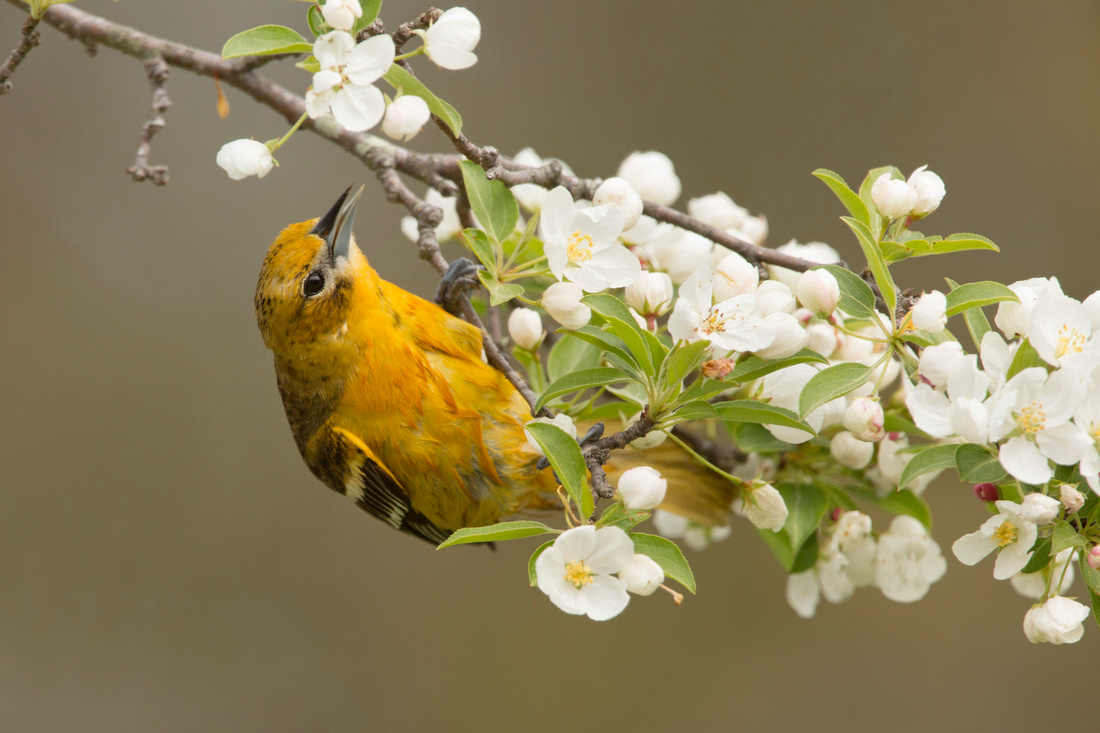
...... or the striking male that's just below it?

..... or better yet, the Blackpoll Warbler that's even closer ....
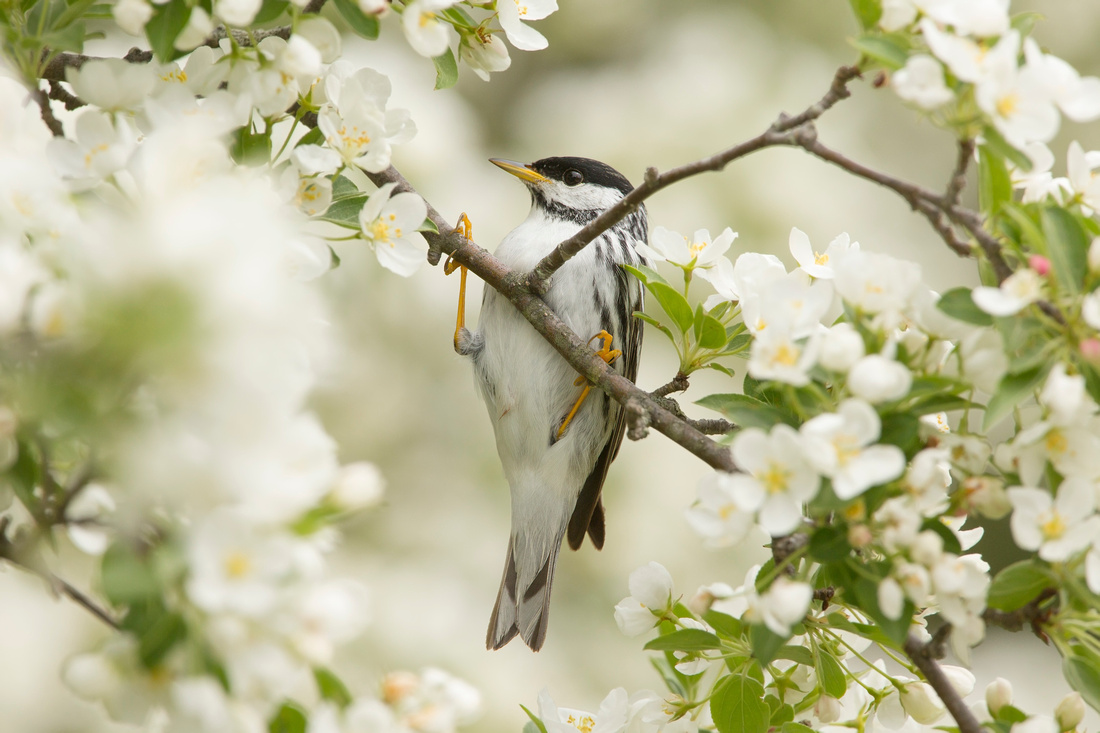
or do I go the front window and shoot the Magnolia Warbler in the pink tree?

I can't remember many times where I had to make so many "tough calls". Not to worry though, it only lasted a couple days. One thing that's certain is that this season with the yardbirds was definitely not ordinary.
]]>A few days later, a birder kayaking around Great Island for the Christmas Bird Count reported seeing dead striped bass at the south end of Great Island. Soon after, the source of the floating fish, and the huge flock of gulls I saw, became apparent when hundreds, if not thousands, of dead Striped Bass were found lining the banks of the Black Hall River. The DEEP responded and determined that the die-off was likely caused by the record cold weather.

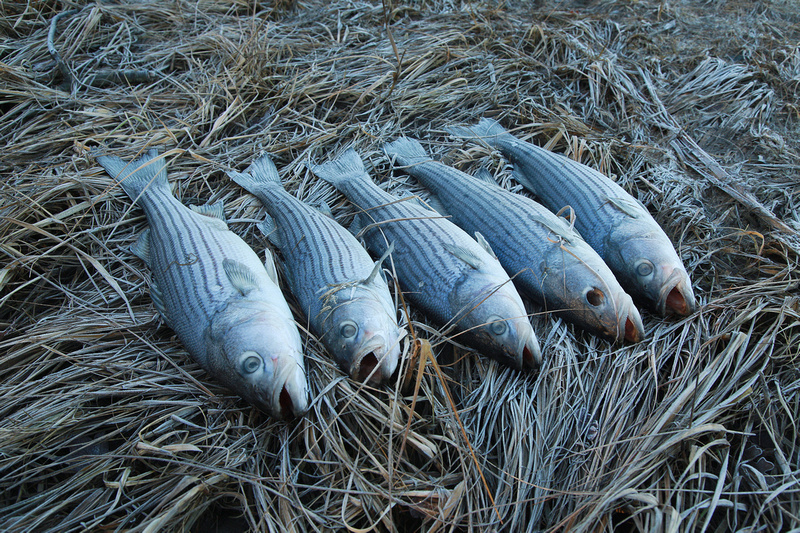
It's believed that the fish became trapped in the shallow water of the Black Hall, either by ice or low tides due to a coinciding new moon. The sudden onset of extremely cold weather combined with the fish being trapped in the shallow water resulted in a condition called cold shock, that caused a massive fish kill. A smaller die-off in the river was reported a few years earlier after a similar cold spell. As the news got out, I stopped by the river at the Route 156 bridge to see the carnage for myself. It was awful to see so many beautiful fish strewn along the river bank, many with their eyes pecked out. Farther up the river I saw more than a hundred dead fish in one spot at low tide, piled up on the bank near a bend in the river. I'm sure there were many more in areas I couldn't access, based on the huge flocks of birds gathered there.

As sad as the fish kill was, it was apparently a natural occurrence, and nature has a way of cleaning up its messes. In the weeks after the die-off, the decaying fish provided a seemingly endless bounty of food for the birds. Large flocks of gulls gathered to feed on the carcasses scattered along the river bank. There were hundreds of gulls and as several immature Bald Eagles concentrated in areas at the mouth of the river near Great Island and Griswold Point and upstream from the Route 156 bridge, attracted by the unexpected banquet.

As the dead fish along the river bank were exhausted, the gulls would gather noisily near sand bars and mud banks at low tide to feed on the fish exposed by the receding water. Great Black-backed Gulls and Herring Gulls dominated, and although there was plenty of food for all, they often fought noisily over each fish.


When those fish ran out the gulls resorted to dragging the seemingly endless fish carcasses from the shallow water onto ice floes or sand banks and just kept eating.

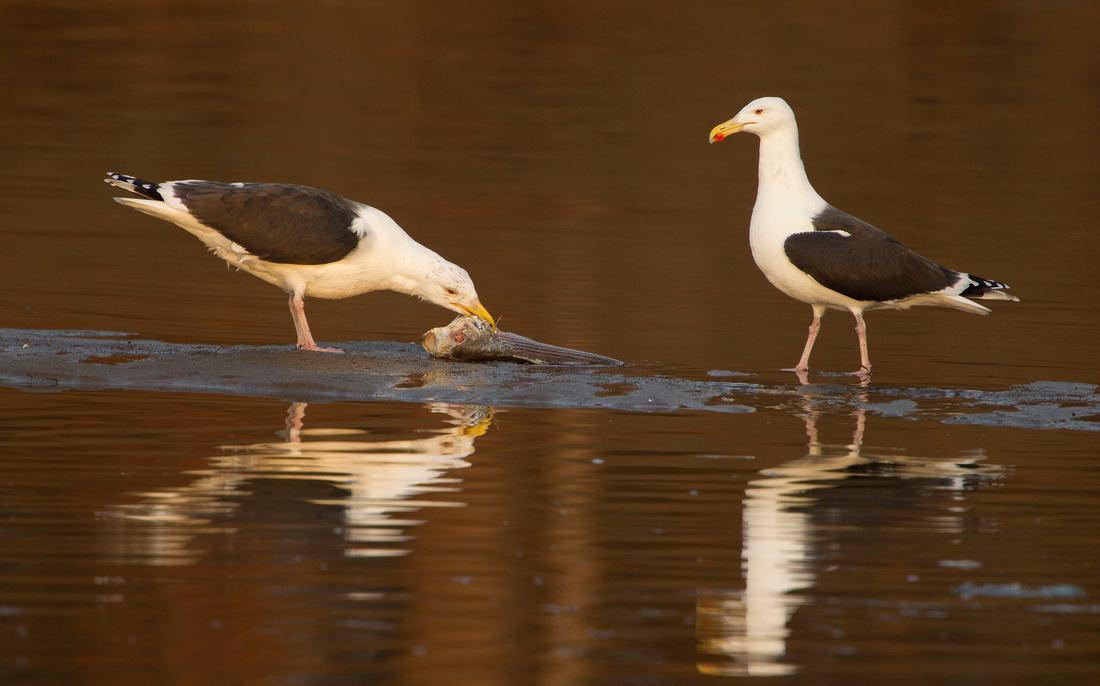
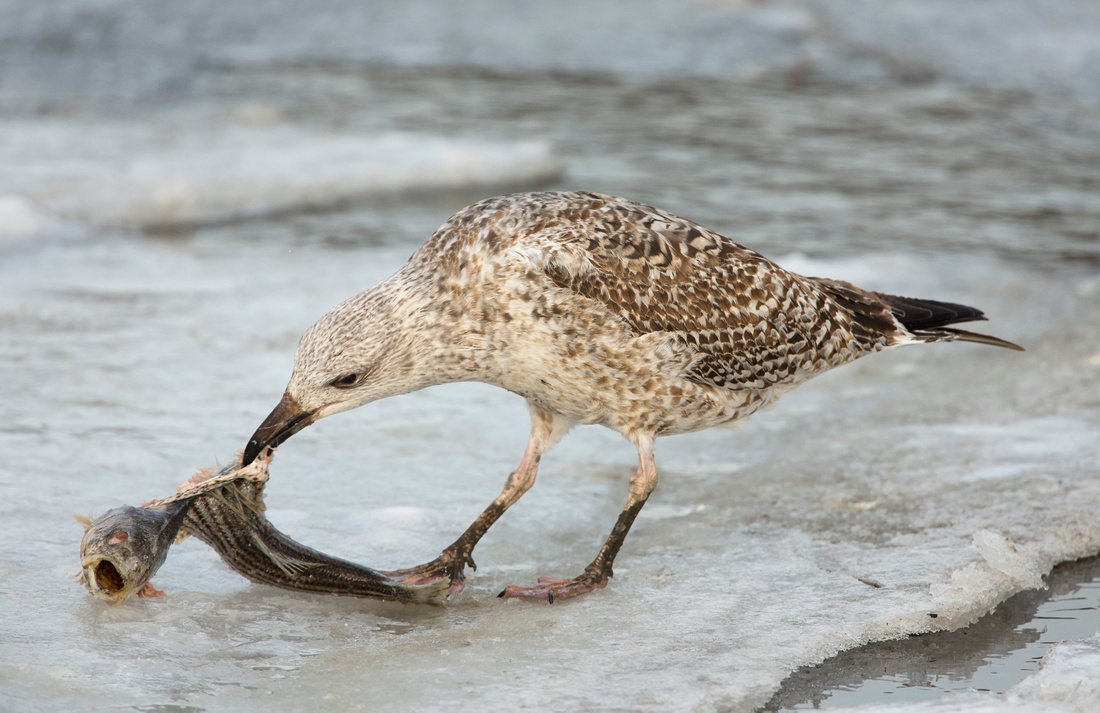
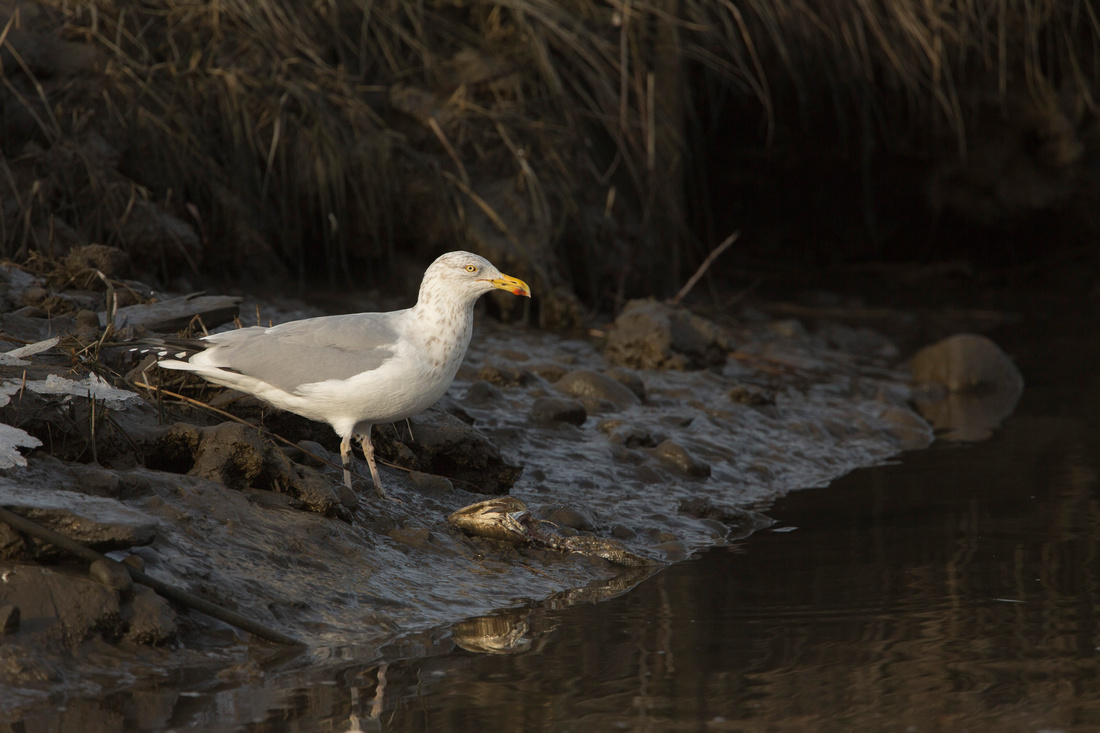

While the flock of gulls remained constant, the number of Bald Eagles on the Black Hall River began to build over the first few weeks of the bounty. At first I saw four young eagles feeding on an ice floe (presumably on the dead fish) near at the mouth of the Connecticut River. Early on, about half a dozen immature eagles congregated near the mouth of the river. As their numbers slowly built, the young eagles could be seen flying around upstream from the Route 156 Bridge, often chasing each other and perching in the tall pines on the bank of the Black Hall River.
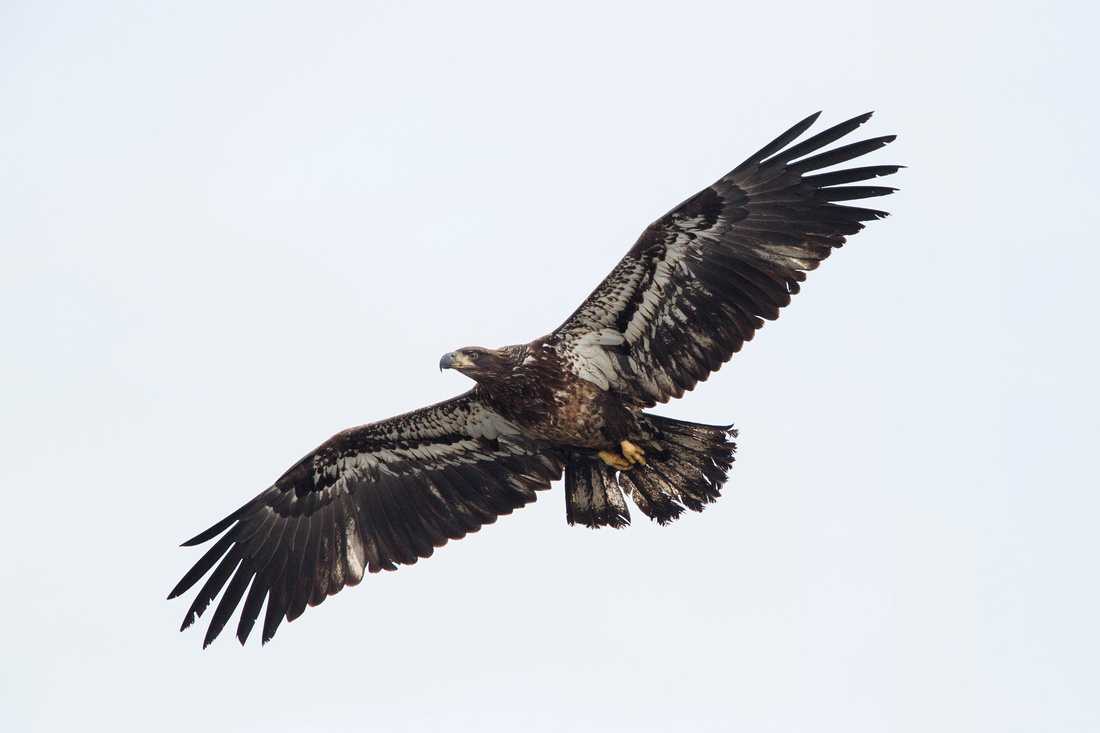

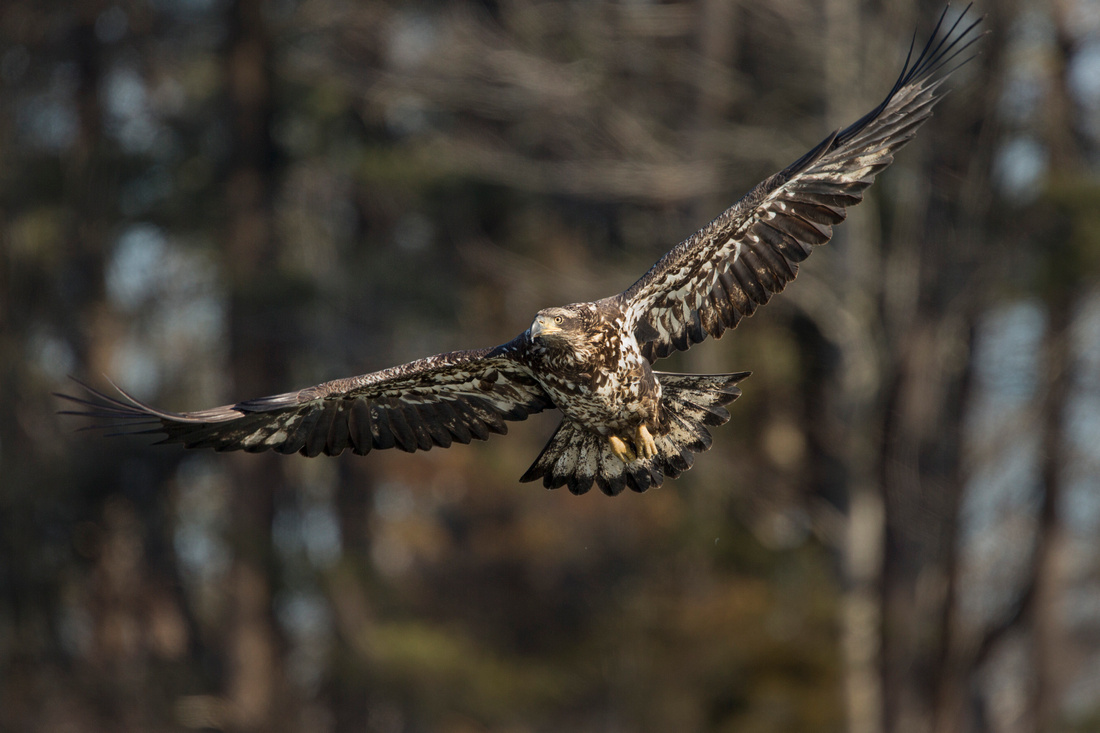
Once in a while all the gulls would suddenly take flight and a young eagle would swoop down to the water, grab a fish and fly off with it.
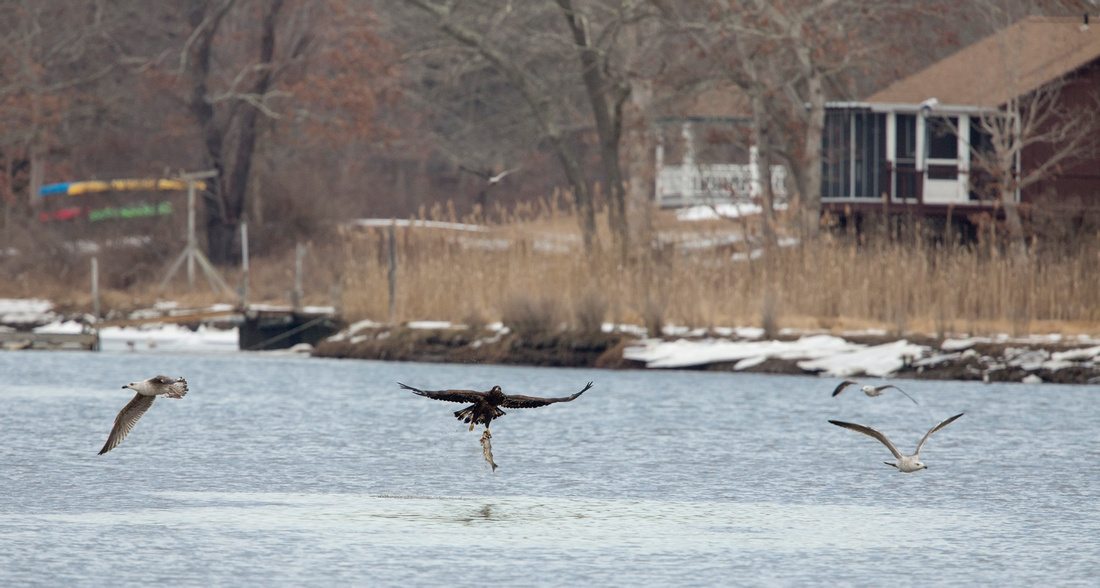
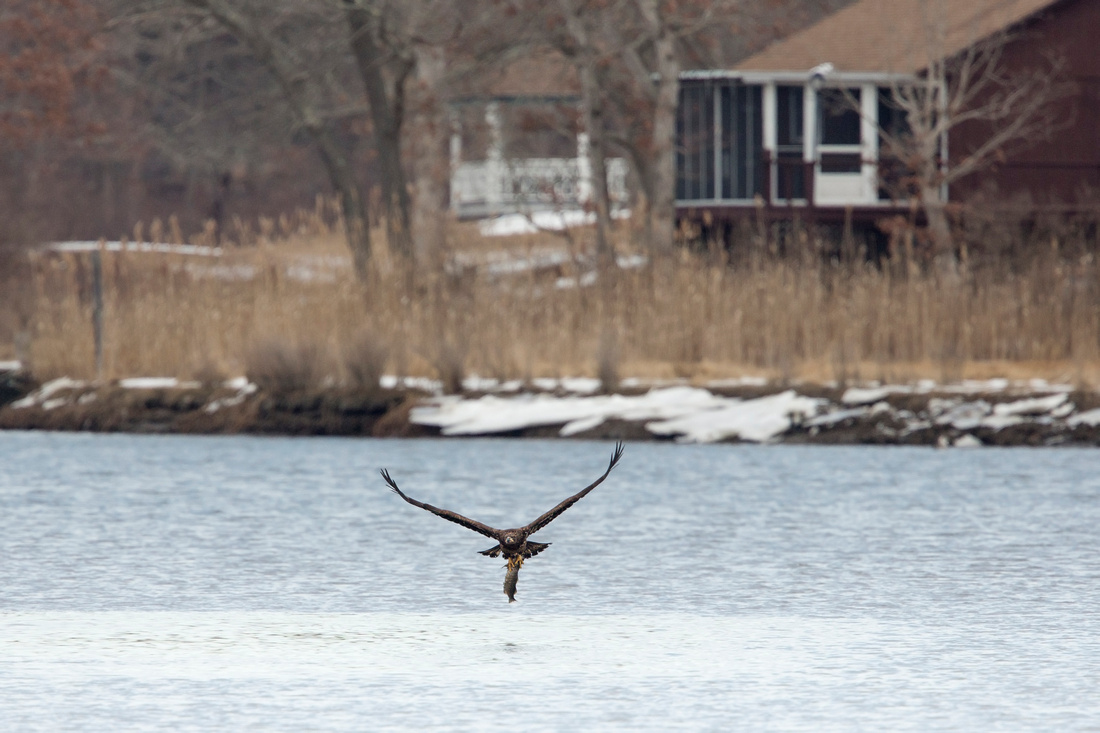
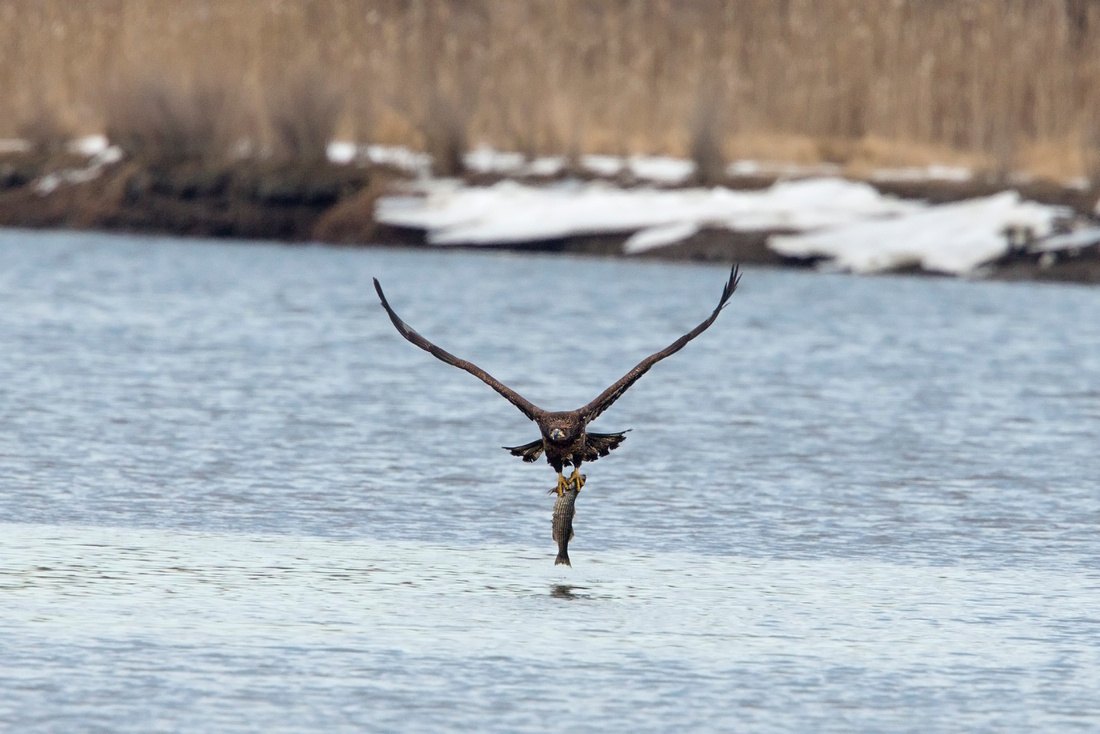

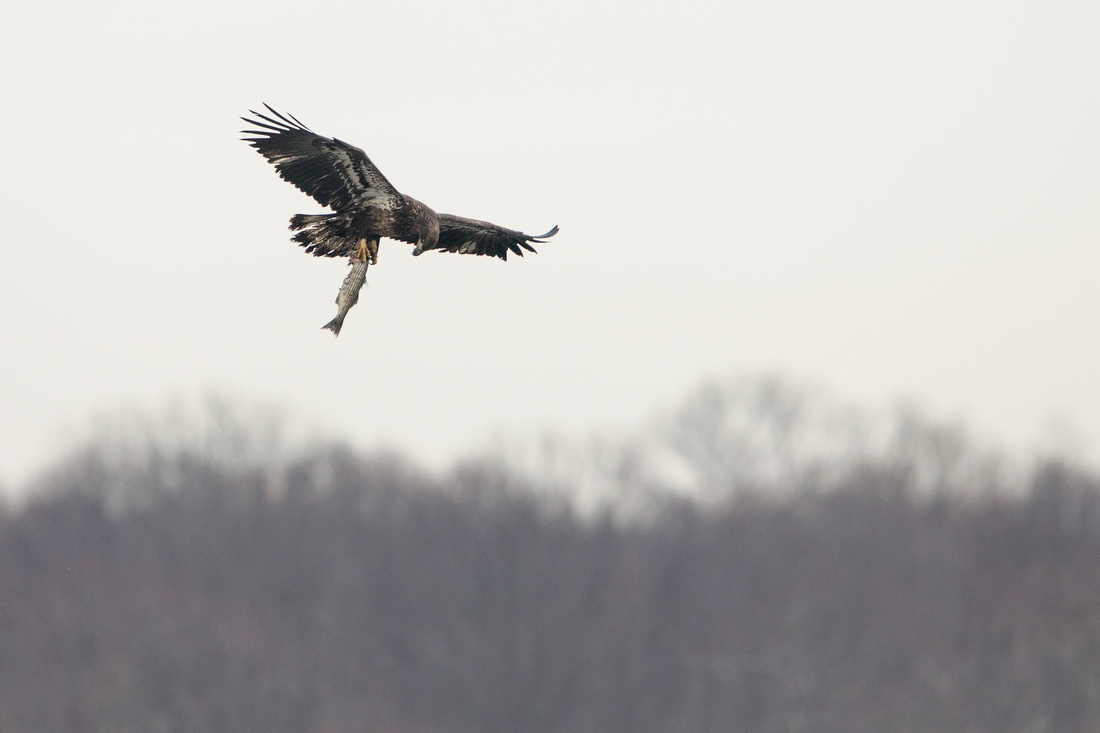
It's been more than a month now since the fish kill and there are still plenty of dead fish for the taking. The well fed gulls continue their noisy feast and the number of Bald Eagles has grown to more than two dozen. Last week, after one of the snow storms I drove by the river early in the morning and counted at least 15 immature eagles roosting in a single stretch of woods, their dark shapes standing out against the snow covered branches. It was the kind of scene you'd expect to see in Alaska, not in Connecticut. Unfortunately, they were too far off for a good picture. There are also two adult eagles frequenting the area.
Another interesting thing was that I kept seeing Red-shouldered Hawks perched out in the open in trees along the river bank, forsaking their normal woodland habitat. One morning I discovered that they, too, were taking full advantage of the all-you-can-eat seafood buffet. I watched a hawk spend nearly 45 minutes eating a fish on a gravel bar, completely stripping the carcass of flesh.
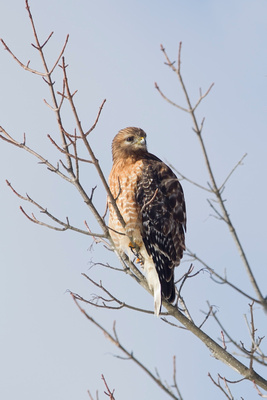
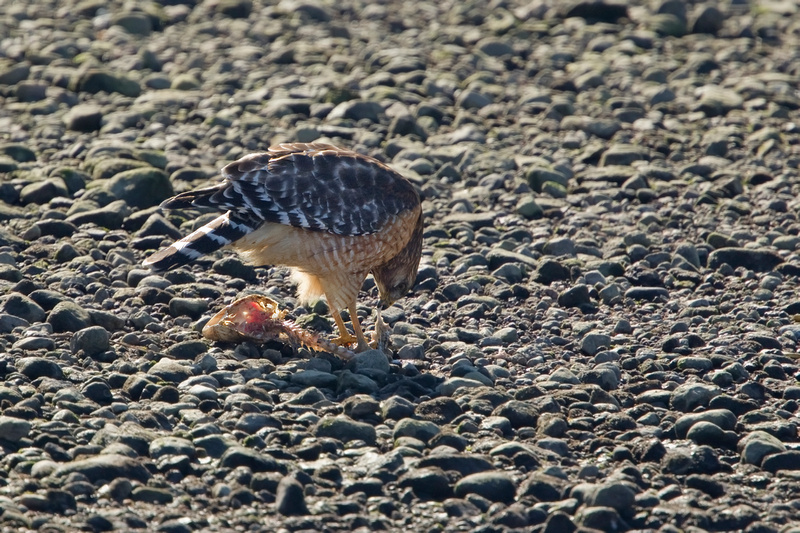
Nature can be pretty harsh, and the death of so many healthy young fish is sad to see. Hopefully the die-off won't seriously deplete the Striped Bass population in our waters. As cruel as it can be, though, nature also has a way of balancing things out, and the dead fish have turned a cold, harsh winter into a time of plenty for the many birds who have gathered at the Black Hall River.
]]>

Many photographers ask me about my camera equipment, and I get the sense that some think that having the newest and best equipment will automatically make them better photographers. I was already a working photographer with professional gear when I started photographing birds (my first official bird picture, at left, was a Short-eared Owl), but many of my early attempts were pretty bad. That my results have improved over time, I think, has more to do with an increased knowledge of birds rather than the level of equipment I use, which has stayed relatively consistent. Think of any other trade or skill, like a carpenter or musician. Buying the best tools or an expensive instrument wont instantly make you better at it, it takes time and practice and a good knowledge your subject. So having a chance to study and learn about a bird, especially one as uncommon and beautiful as a Snowy Owl, is a rare opportunity and is one not to be missed.
The closest area to me where Snowy Owls have been seen regularly is Great Island in Old Lyme, and since it's only ten minutes from home I check there often. The first owl was found there just before Thanksgiving by Old Lyme birder Hank Golet. For a few days birders saw it there, occasionally being harassed by a resident pair of Peregrines, before it disappeared. Hank later spotted one in Old Saybrook on the breakwater near the Saybrook Point Lighthouse. That spot is only a short flight from Great Island, and by Christmas he reported one back on the island.
 Late one afternoon as I drove down to the Great Island boat launch I was surprised to find the small parking lot full of cars and at nearly a dozen people on the viewing platform. Hank had his scope trained on the Snowy Owl on the far side of the island and the people took turns looking at, their excitement obvious. Soon anther was spotted on the near side of the island, across from Griswold Point, offering much closer views. The crowd was exuberant, especially when the sun began to set and the owls began to stir, flying between the Osprey nesting platforms. A family with young children arrived, hoping to watch the sunset, and wondered what the attraction was. They were obviously not birders, but seemed genuinely gleeful to see the owl show. The crowd was then treated to a spectacular view as the owls flew north on the island, the closer one passing right by the platform in the dusky pink sky.
Late one afternoon as I drove down to the Great Island boat launch I was surprised to find the small parking lot full of cars and at nearly a dozen people on the viewing platform. Hank had his scope trained on the Snowy Owl on the far side of the island and the people took turns looking at, their excitement obvious. Soon anther was spotted on the near side of the island, across from Griswold Point, offering much closer views. The crowd was exuberant, especially when the sun began to set and the owls began to stir, flying between the Osprey nesting platforms. A family with young children arrived, hoping to watch the sunset, and wondered what the attraction was. They were obviously not birders, but seemed genuinely gleeful to see the owl show. The crowd was then treated to a spectacular view as the owls flew north on the island, the closer one passing right by the platform in the dusky pink sky.
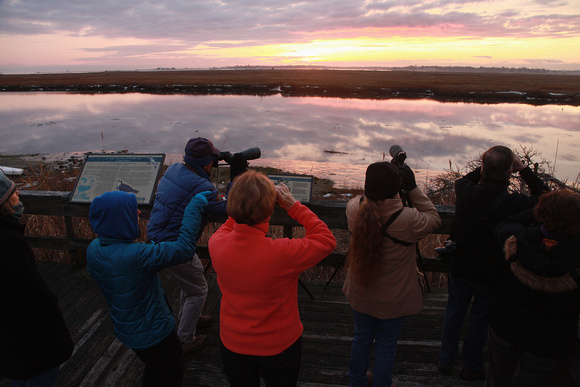
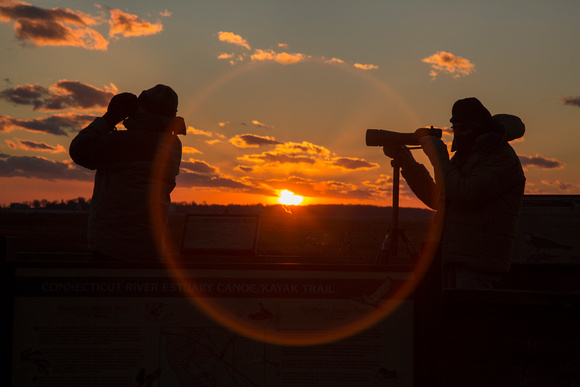
The afternoon owl show at Great Island became an almost nightly event, although one of the owls quickly moved on. Modest crowds would attend in nice weather and usually just a few diehards when the frigid cold arrived. Most nights the owl could be found near the beach on the opposite side of the island, and would begin flying up to the platforms around sunset like clockwork. Once or twice I saw it out on Griswold Point , but only when duck hunters and dog walkers were not present. Because the owl was so far away, it was not worth taking pictures. Occasionally, a Short-eared Owl made an appearance there, especially during the cold spells. It seemed to hunt the area closer to the boat launch, away from the area where the Snowy was, where I was able to get some pictures of it one day.
 Since getting good pictures of the Snowy Owl at Great Island was unlikely, I had to travel a bit to find locations where they were more accessible. The beaches of Long Island were the most promising. As I wrote in my previous post, I went there one day with a friend and we saw five owls in the dunes, but there were also lots of photographers there. I got plenty of pictures of the owls sitting on the dunes, and quite a few of them flying up and down the beach, the latter because some people were a little over zealous in their efforts to photograph the owls.
Since getting good pictures of the Snowy Owl at Great Island was unlikely, I had to travel a bit to find locations where they were more accessible. The beaches of Long Island were the most promising. As I wrote in my previous post, I went there one day with a friend and we saw five owls in the dunes, but there were also lots of photographers there. I got plenty of pictures of the owls sitting on the dunes, and quite a few of them flying up and down the beach, the latter because some people were a little over zealous in their efforts to photograph the owls.
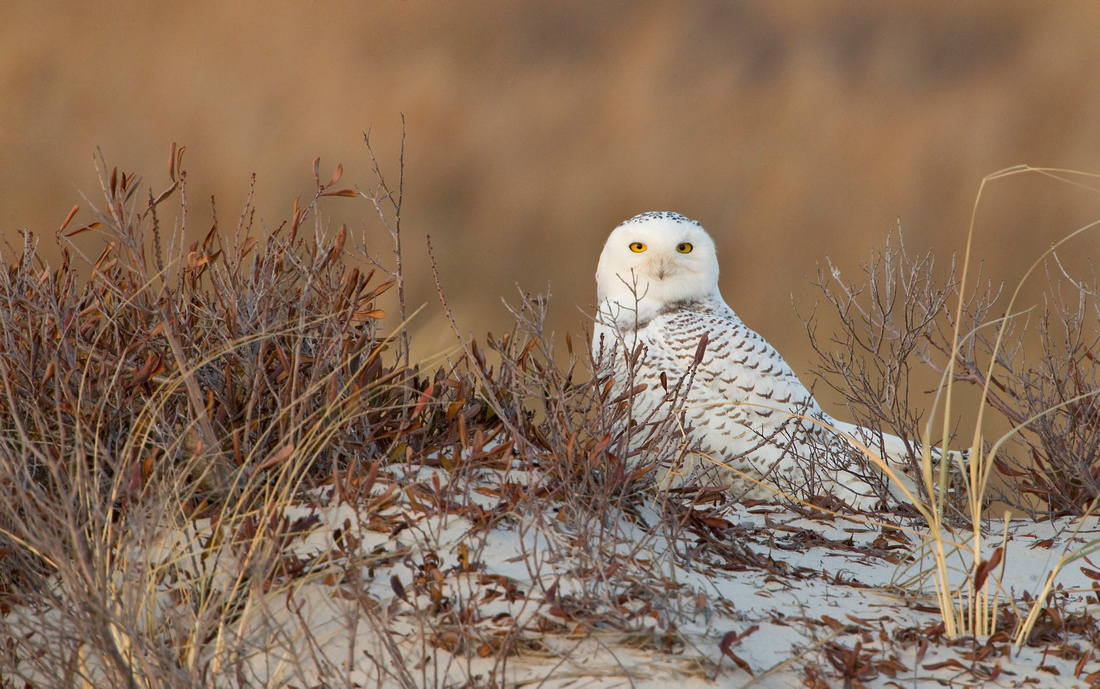

I considered going back there when things quieted down a bit, and still may, but it's a long trip for me and I'd rather work areas closer to home. Snowies have been seen at Hammonasset, but the sightings are sporadic and usually pretty distant, as well. One bitterly cold and windy day I watched an owl as it slept on the roof of a pavilion near West Beach. I decided not to bother photographing it because of the location, but was amused to watch as it fended off repeated dives by a Merlin with raised wings. A couple other times I watched an owl out on the beach from the end of the Cedar Island Trail, but it was too far for photographs. On those occasions, I had to leave just when the owl started to stir in the late afternoon because the park was closing (one of the big drawbacks to Connecticut parks).
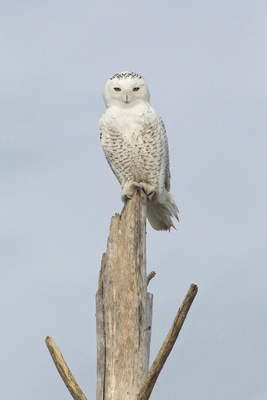

Many of the best spots to see Snowy Owls in Connecticut are in the western half of the state. At Long Beach in December I was able to get some pictures of an owl perching on different trees, along with some shots of the mud covered owl from the last post. After visiting a couple spots in western Connecticut and several in Rhode Island, I decided to concentrate my efforts in our neighboring state since the opportunities seemed more plentiful and the distance for me to travel was about the same.
My usual route took me through Westerly, Charlestown and West Kingston in the morning and then Jamestown and Middletown in the afternoon. In November I was able to get some pictures of Snowy Owls at the Charlestown Breechway and at Sachuest Point National Wildlife Refuge in Middletown. Later I saw them in Westerly, near Misquamicut Beach and at Beavertail State Park in Jamestown, but picture wise the best results were at Sachuest.
When they first arrived, the owls at Sachuest mostly stayed on the rocks near the southeastern shore of Aquidneck Island, where the refuge is located. There were as many as four Snowy Owls there. After several weeks some were reported near the parking area and visitor's center, hunting in the open fields in the early morning and late afternoon. Sachuest quickly became the best location for the owls.
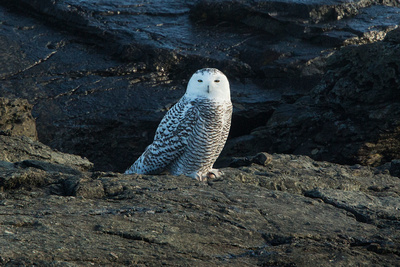
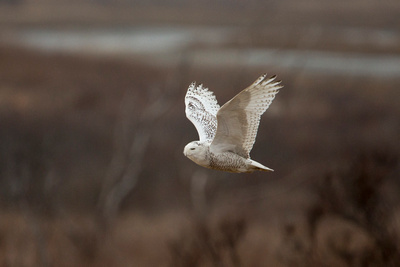
Some people were able to photograph owls near the parking lot with rabbits or other prey, although I was not so fortunate. One afternoon a Snowy hung out in the grass near the parking area, at times near a herd of deer, drawing big crowds of spectators. Just after the sun set, it flew out over the field adjacent to the parking lot and began hunting, hovering in place like a Rough-legged Hawk in the strong wind.
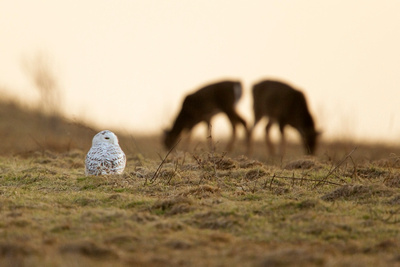

Another night, while leaving the refuge, I saw the silhouette of an owl on the dunes at Sachuest Beach. I was able to pull into the parking lot and watch and photograph as it prepared for its evening of hunting in the orange afterglow.

One day I pulled into the parking lot at Sachuest Point in the mid-afternoon and got out of my car. I immediately spotted a tawny bird flying in the adjacent field which I thought was a Northern Harrier, which are common there, or Short-eared Owl. I grabbed my camera and started shooting the bird, which to my great surprise turned out to be a Barn Owl.
I was able to get pictures as it worked its way through the upper fields near the parking area and down to the capped landfill, then back to the top. For nearly an hour it hunted, diving to the ground for prey, and after a few minutes flying up to continue its search.
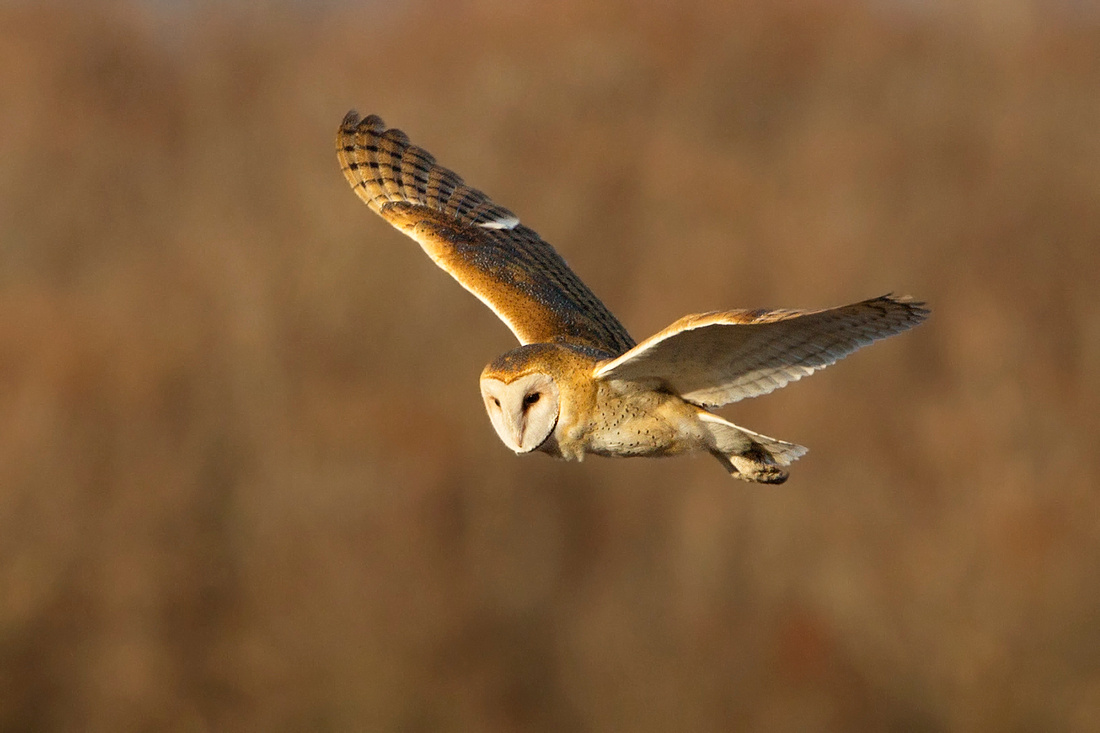

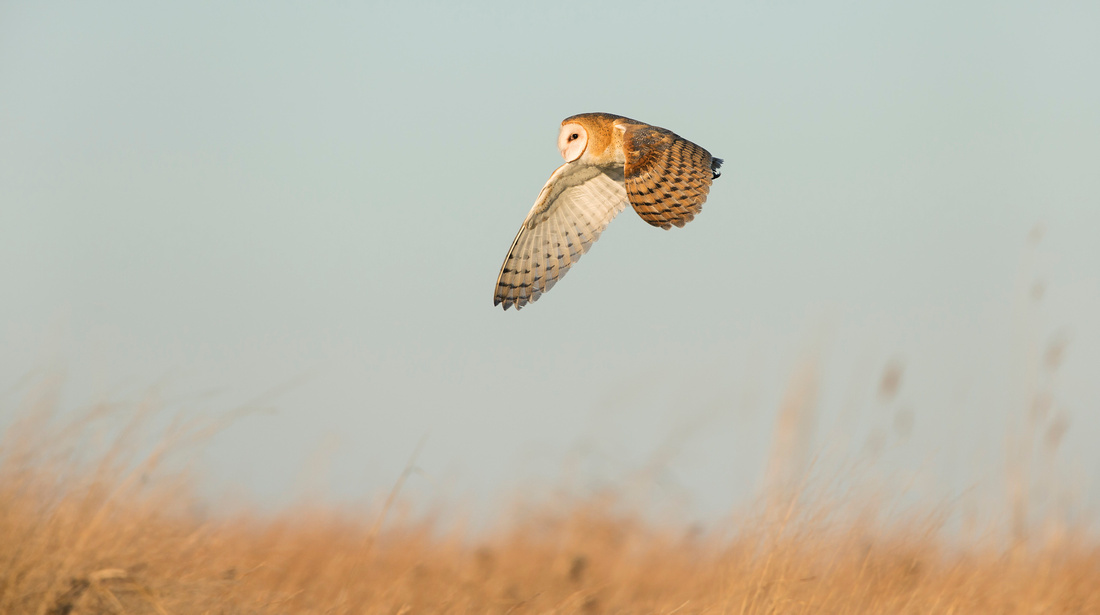
It turns out that the Barn Owl had been seen for a few days, although the word was slow to get out. It became a somewhat of a regular, coming out in the late afternoon most days, hunting near the parking lot. Soon the Barn Owl became as big an attraction as the Snowy Owls, drawing crowds of birders and photographers on a nightly basis, especially on weekends when the parking lot overflowed and dozens of birders and photographers lined the fences waiting for the owls to appear.

I tried to visit at least once a week to take advantage of the opportunity. Talking to some of the local birders, I learned that another Barn Owl had been found dead earlier in the winter, apparently killed and eaten by a Snowy Owl. Every time I watched it, the Barn Owl seemed to hunt with an amazing success rate and little disturbance from the Snowy Owls or any other raptors, save for the occasional arial duel with a passing harrier. The refuge seemed to be a haven for birds of prey, and in addition to the Barn and Snowy Owls, there were several Northern Harriers, a Merlin, a Peregrine Falcon, a Coopers Hawk and a Red-tailed Hawk all frequenting the area.
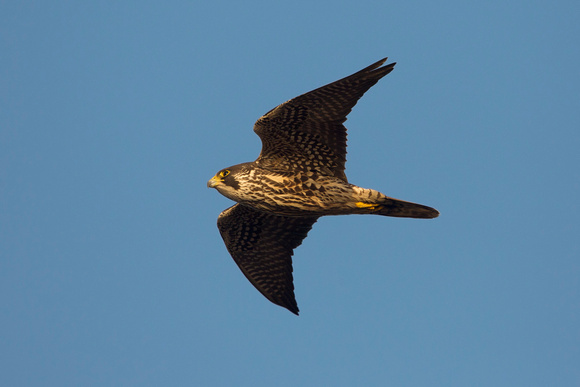
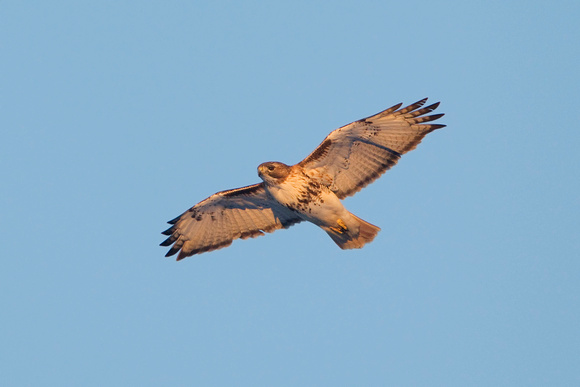
TROUBLE IN PARADISE - I recently had a free afternoon and decided to head to Sachuest Point, hoping for an encore performance. When I arrived there were a group of photographers in the parking lot, looking rather grim. I was told that two days earlier some one reported seeing the Barn Owl being attacked in mid-air by a Snowy Owl and knocked to the ground. When it tried to fly away it was chased and knocked to the ground again by a harrier, and had not been seen since. We waited for a while, and as the light faded without any sighting of the Barn Owl, so did our hopes of seeing it again. We walked around to other fields near the visitor's center, without luck, so I headed back to the parking lot. From there I saw a Snowy Owl in the lower fields take flight and make a bee line for the field that I just left. I tried to alert a few other photographers walking back from the field that the owl was headed their way. They turned to see it speeding across the field and saw the Barn Owl take flight from the grass heading towards a nearby stand of cedar trees where it apparently roosted by day, with the Snowy in hot pursuit. By the time I got around the visitor's center I could see a harrier diving into the cedars as the Barn Owl ducked into the lower branches for cover. The Snowy returned and perched atop one of the cedars while the harrier dove at it repeatedly. The Snowy Owl stayed perched on the cedar tree, as if lying in wait for the Barn Owl, flying out once to duel with another Snowy passing the area, then returning to its perch.
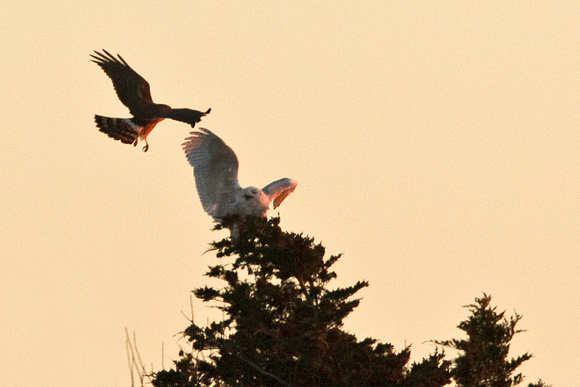

It's unclear what has caused the the sudden change in harmony and the resulting drama. Back in the parking lot another photographer who stayed in the field showed us a distant picture he got of the Barn Owl sitting in the grass eating a mouse before the Snowy chased it. Everyone was happy to see it alive and still able to hunt, but for how long will the show go on?
]]>
THE GOOD - In Connecticut alone there have likely been at least a dozen different owls this year, mostly along the shoreline, although it's difficult to pin down because they may be moving around. There have been sightings from Groton to Greenwich with as many as four seen at one location in Stratford. In Rhode Island, it's a similar story and I've seen owls (in some cases multiple owls) in Westerly, Charlestown, South Kingstown, Jamestown and Middletown. In New York, there were five different Snowies on a single stretch of Long Island beach. And in Massachusetts birders have reported seeing eight different owls at one time on the North Shore. The most amazing report I've heard is from NewFoundland, where a researcher counted 75 in one location and more than 200 in a single day. Snowy Owls have been reported all the way down the eastern seaboard, as far south as Florida and Bermuda and into the midwest. The invasion is so impressive that EBird has a special section just for Snowy Owl information. http://ebird.org/content/ebird/news/gotsnowies2013/
Having so many Snowy Owls around has made this an interesting and exciting winter for birders and photographers, myself included. With so many people getting out to see and photograph the Snowies there have been some other great finds, including some other cool owls. Here are my observations from this "snowy" winter.
The first Snowy Owls started showing up in southern New England a little before Thanksgiving. My first sighting of the season was a darkly barred immature female in Charlestown, RI on November 26th, and one was found in Connecticut the same day.
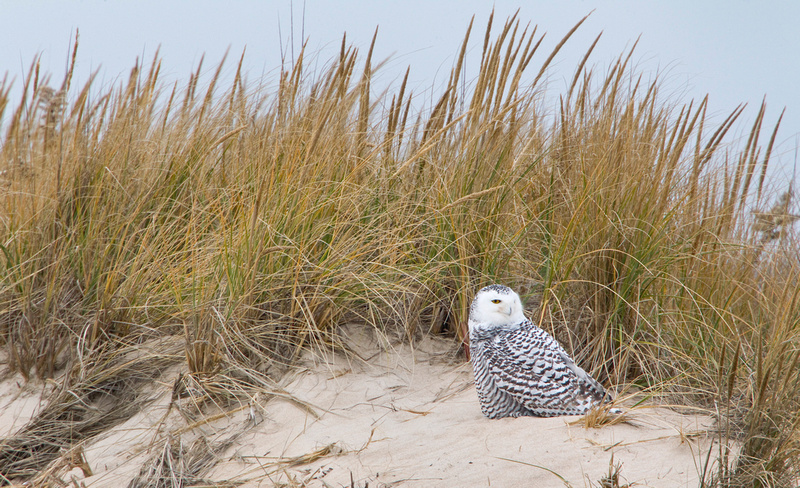
A few days later I went back to Charlestown and saw three Snowies at the end of East Beach, at times getting pushed around by fisherman and off-roaders who frequent the area. It seemed like more owls were showing up every day.




Later that afternoon I went to Sachuest Point NWR in Middletown, Rhode Island where at least two more Snowy Owls were seen. There were dozens of people constantly stopping to look at one of the owls perched on the rocky shoreline. The word was out and there were lot's of birders and photographers, but also many hikers who were just out for a walk who were excited to see a white owl. Most were happy to watch from a distance, but with so many people eager to see and photograph them, the pressure on the owls mounted. Around the Northeast the rift between birders and photographers ignited almost immediately.
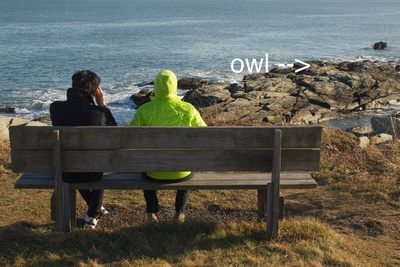

THE BAD -The birder vs. photographer battle has gone on for a long time, and owl sightings are almost always a fuse that ignites an explosion. Initial reaction by some birders that all the Snowy Owls here are starving, near death and unable to withstand any disturbance are often overblown, in my opinion. Surely, some of them are in desperate shape, and may not survive, but this is likely to be the case even without human disturbance. In nature, a large percentage of young birds, especially birds of prey, do not survive their first year. Human disturbance of any kind might compound this. Unfortunately, though, some of the criticism of photographers in particular (I use the term to include anyone with a camera) is justified.
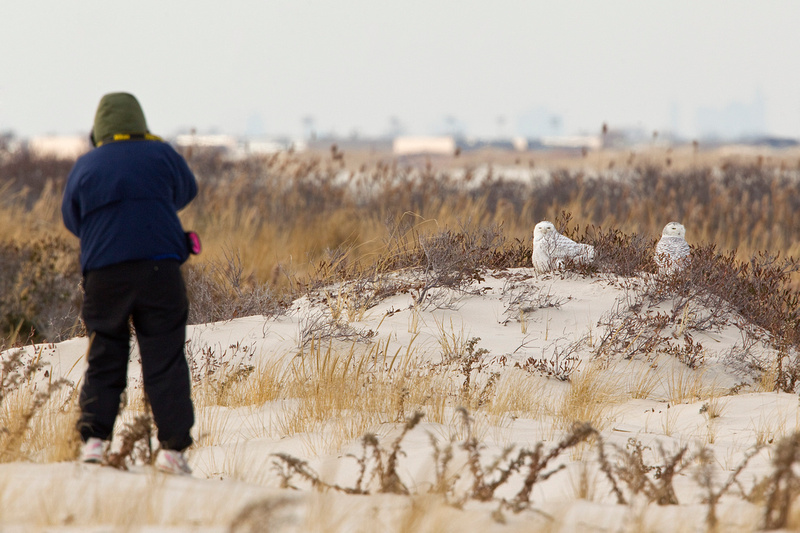
The picture above, from Long Island, is not intended to imply improper behavior. The photographer is farther a way from the owls than it appears as the distance is compressed by using a telephoto lens. As a photographer, I have felt the disapproval of some birders for getting too close to birds for a picture. With 20 years of experience and a telephoto lens, I think I can judge how close to approach birds and other wildlife for the best results, both mine and theirs, although I can't say that I've never flushed an owl. This year I've seen a lot of photographers' actions with the Snowy Owls, some deliberate and some due to inexperience, that hurt our cause. These are only my opinions.
With the explosion of digital photography, there are now many more people interested in photographing birds and wildlife, and therefore a lot more chances for disturbance. Some are new to birding and/or photography, and may lack the experience and judgement to act appropriately. Others are experienced birders or photographers who may feel their knowledge justifies "aggressive" photography. Whatever the circumstances, here are a few examples of "bad" behavior by photographers I've seen this winter.

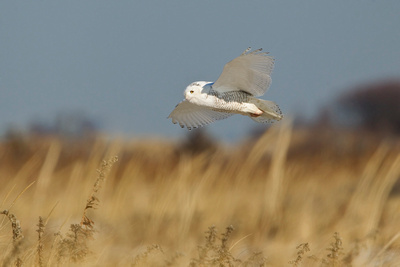
The most annoying example was on the trip I made with a friend to Long Island last month. There were five Snowy Owls (two pictured above) on one stretch of beach, and many photographers with big and small lenses were there to photograph them. The owls were a bit skittish, likely because there were a lot of people around. Competing for subjects can be frustrating for photographers, especially when some are inconsiderate of the others. One photographer with a shorter telephoto (300mm) repeatedly approached the owls too closely, causing them to fly off. I got a bunch of flight shots of owls that this photographer flushed from their perches and towards me. And when the owls landed near other photographers, he would immediately walk directly towards them, almost racing to get there first, cutting in front the others in the process. At first I thought he just didn't know what he was doing, but the more I watched, I believe he was doing it deliberately to get flight shots. Walking quickly toward the owls, raising his camera as he got close, ready to get them flying as he chased them away. Besides the obvious, that he had no concern for the birds, he also had no regard for the many other photographers there, either.
Another instance was in Stratford at Long Beach, where an unhealthy owl drew a crowd of spectators near the parking lot. This was the owl that I wrote about in my previous post that was all muddy. Although this owl did not fly off when several people approached it very closely, it was clearly disturbed when people began to walk all around it to photograph it from different angles. I'm not sure of the circumstances, but I believe someone in the group had contacted a rehabilitator (more than likely saving it's life) and were waiting for him to arrive. I'm sure their hearts were in the right place, and the picture is not intended to embarrass anyone, but surrounding an owl, or any wild bird or animal is likely to scare it.
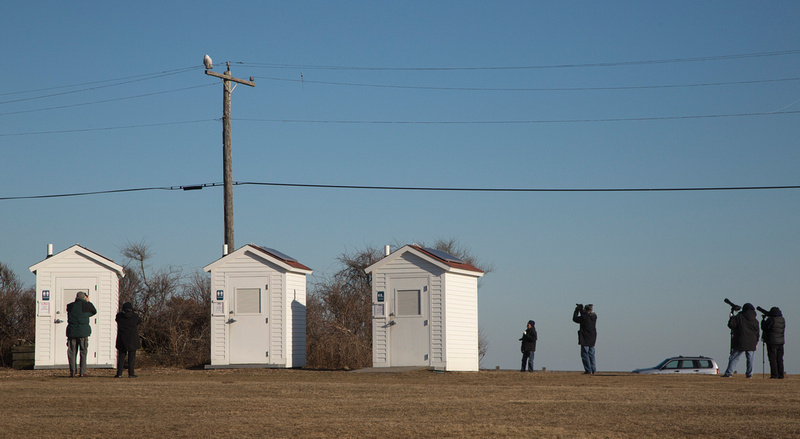
Another example of this was at Beavertail State Park in Rhode Island where a group surrounded an owl on a utility pole, photographing it from all different directions. It flew off to a lower perch closer to me, and some in the group hurried past me towards it, one exclaiming that boreal birds had no fear of people, sending it flying off again, of course. With so many people hoping to see and photograph the owls there are some common sense guidelines (that I try to follow) that will work better for the owls and photographers, and invite less criticism from those with the scopes and binoculars.
1. Move slowly and quietly, and if possible, stay low.
2. In a group, stay and move together, don't spread out or surround the bird
3. Don't get "too close"- Individual birds may react differently, but start shooting from a safe distance and gradually move closer as it allows. Don't be afraid to crop your photos and be realistic, you're not likely to get a tight portrait with your IPhone, although I've seen people try.
4. If an owls is perched or lands in front of another photographer, let them at least get a few pictures before you start to approach. Ask to move in if possible, and approach slowly and quietly from directly behind the other photographer. Don't cut in front without asking. Trust me, you won't miss a mortgage payment because you didn't get that killer owl shot.
5. Don't deliberately flush an owl to get flight shots. Don't try to alarm or startle it to get it to move or open it's eyes. Be patient and let sleeping owls lie, they'll wake up when the light gets nice.
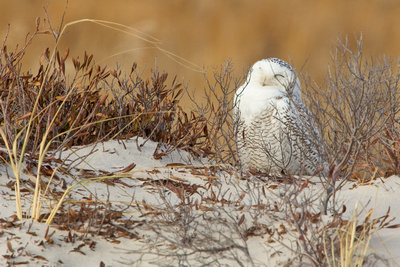

Okay, enough about the bad. It really shouldn't that long because it's been a really good time.
THE UGLY - With so many Snowies around, I've hoped to get that great close up picture of a perfect specimen in a spectacular natural setting and beautiful light, but so far it hasn't all come together. I see a lot of incredible pictures other photographers have taken, and keep hoping I'll get my chance. Ugly doesn't describe the owls I've photographed, except maybe the dirty owl at Long Beach in Stratford. It has more to do with the places some of them choose to perch. Most of the owls I've seen in ugly places I have not bothered to photograph. These include buildings, rooftops, light poles and messy beaches.

The only real pretty spot I've photographed a Snowy is on the dunes in Long Island. The Rhode Island beaches are nice, Connecticut less so and I have not even been to Massachusetts or beyond to see them. Many of the owls I've found, though, have unfortunately chosen some of the ugliest spots available to hang out. In Westerly, Rhode Island a Snowy spent a whole afternoon perched on a makeshift drive-in movie screen in a dirt lot across the street from Misquamicut Beach, only moving when the wind caused it to lose balance and almost fall off. The owls blood stained feathers only added to the ugly scene, although I guess that meant it had eaten recently.
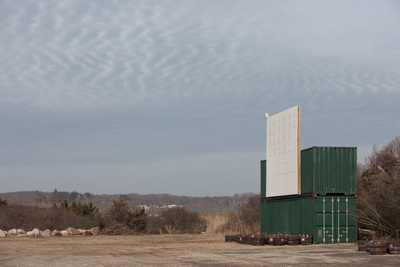

As the sun lowered in the sky and the bird woke up, I was hoping it would fly across the road to the beach or dunes, but instead it dropped down to the adjacent lot and perched on ....... yes, a beautiful water slide. Hard to get a nice shot in this setting.
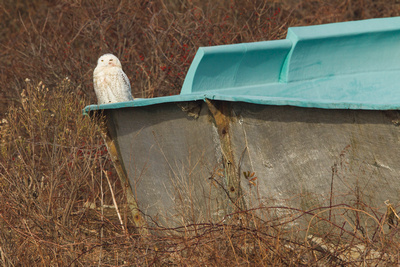
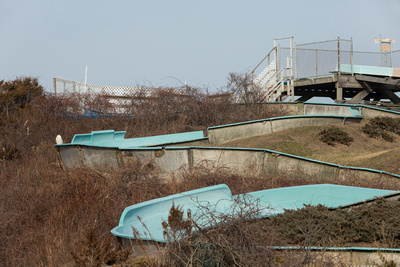
As I mentioned earlier, an owl was perched in the open at Beavertail State Park atop a utility pole near the bathrooms. It eventually flew to a perch right next to the lighthouse. Unfortunately, it chose a utility pole with a big, ugly transformer.


Although I have taken more pictures of the owls this year than in any other year, I'm still looking for that truly spectacular shot. Despite not having the photographic success I'd hoped for, it's been nice to have so many chances just to watch Snowy Owls in action. Since they are sticking around for the long haul, it's great that so many people have had a chance to watch the owl show, as well. Please check back soon for Part Two of this Snowy Winter.
]]>
The final two weeks of December are always a hectic time and getting outdoors often takes a back seat. I had a couple chances to get down to the western half of the state, where I don't often venture, and both trips were interesting. On December 16th, I decided to head to Stratford to try and photograph the many Snowy Owls being reported there with great frequency. It was a cloudy morning a couple days after a light snow and rain had fallen. As I was driving west through East Haven, I noticed the bare gray tree branches starting to glisten, encased in ice. As I passed through New Haven, the ice covered scenery turned spectacular as the sun broke through the clouds, and I decided to hop off the highway to try and get some pictures of it.
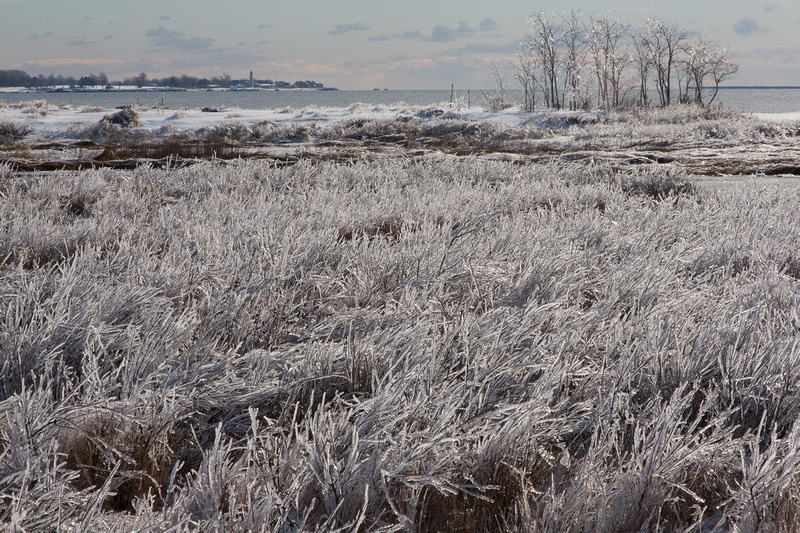
I headed to Sandy Point, in West Haven, where a Snowy Owl had been seen a few days earlier, hoping I might get to photograph one in the amazing ice show. I drove into the unplowed parking lot and my car barely cracked the crusty surface of the snow. I scanned the sparkling seascape with my binoculars, but didn't see any owls. I took a few scenic shots and decided to walk out to the point. The icy surface was a bit treacherous to walk on in places, as this picture of another walker demonstrated.
Walking along the beach, I saw plenty of gulls, Brant in New Haven Harbor and a few smaller birds darting around in the ice covered dune vegetation. A small flock of Horned Larks were feeding on the few uncovered seed heads.

A few sparrows including Song Sparrows and a pair of Ipswich Sparrows (one pictured below) also darted around the frozen weeds.
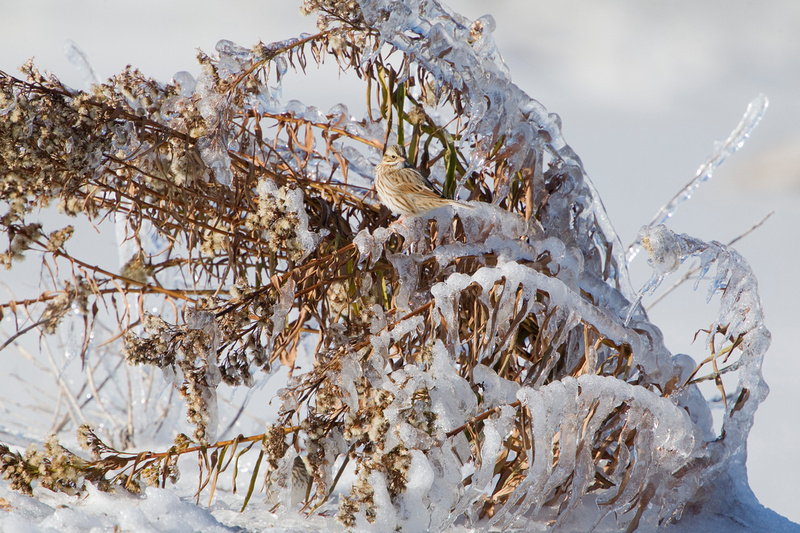
I walked well out on the point, but saw no owls. I ended up taking a lot of pictures of the glasslike, ice encrusted grasses.
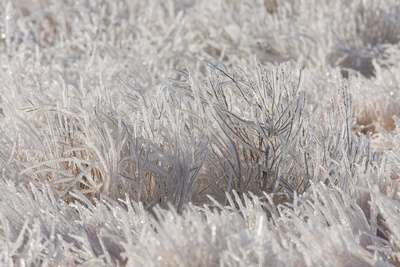


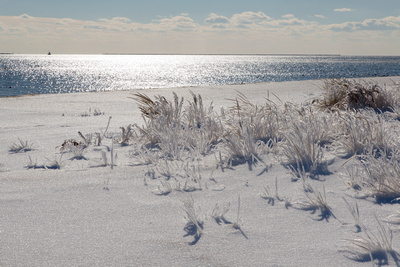
On the walk back to the parking lot another small bird popped briefly out of the grass. I couldn't identify it right away, so I followed it back down the beach a way, before it reappeared and revealed itself to be a late Palm Warbler.
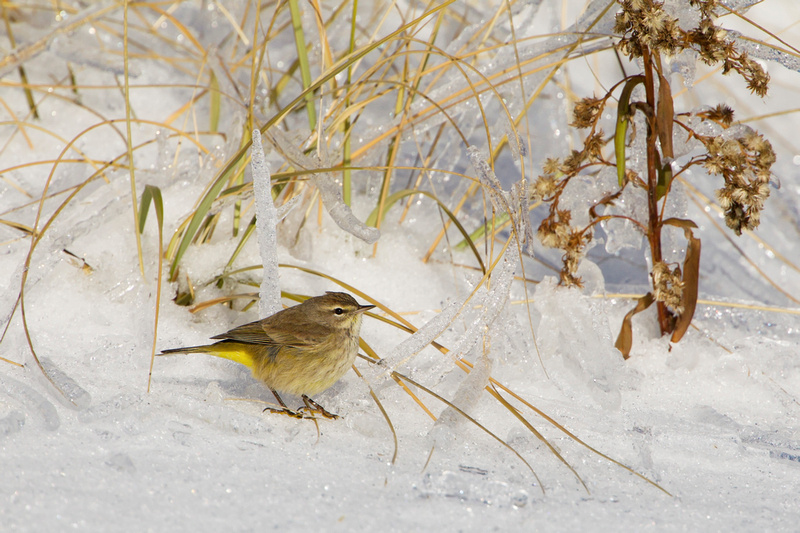
I ended up spending half the day there so Stratford would have to wait for another day. A day later a pair of Rough-legged Hawks were spotted at Hammonasset Beach State Park, and I was able to see them a couple days later. I was hoping to get pictures of the dark phase, since I don't have any, but I only saw it at quite a distance. The light phase hawk also spent most of the time hunting well out in the marsh, often across the Hammonasset River. When I arrived first thing in the morning, however, it made a few passes along the edge of Willards Island allowing me a few photographs as it hovered, almost stationary, in the brisk wind, using its tail as a rudder.

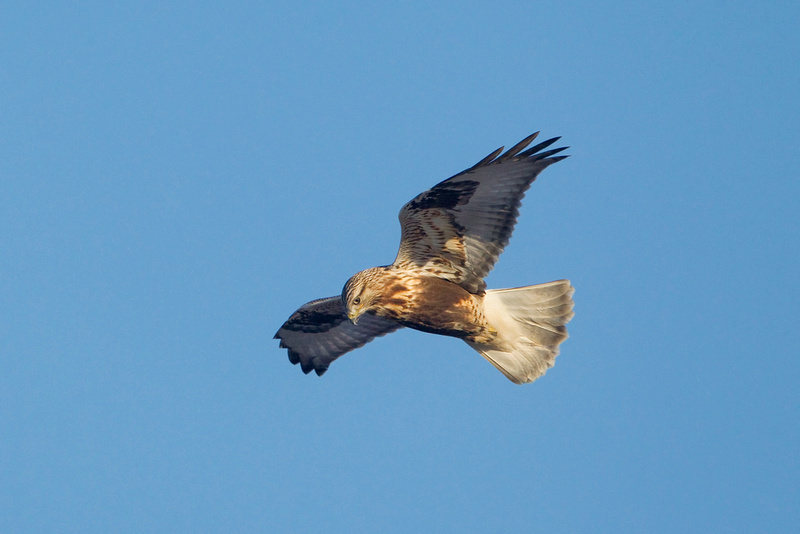
Just before Christmas I finally made it down to Stratford, stopping at Long Beach, where a number of Snowy Owls were being seen. As I was setting up my camera, a birder told me about a Glaucous Gull on the nearest breakwater. I took a few shots of it and started looking down the beach, where a Snowy Owl sat on the sand near the dunes just before the second jetty. I watched as a number of people walked past it along the waterline without disturbing it, so I started walking along the same path towards it, moving slowly and not looking directly at it. As I got closer the owl started to look alarmed so I stopped walking. It continued looking spooked so I looked behind me and saw a couple walking two large dogs along the dune line, directly towards the owl. It flew up and away, then banked and flew back toward me, gliding right over my head. I took a number of pictures of the flight but didn't have high hopes for them as I had a 2X teleconverter mounted on my 500mm lens, which I was hand holding (not the ideal setup for sharp photos!). Compounding the problem, the owl looked terrible, covered in mud on the belly, tail and wings.
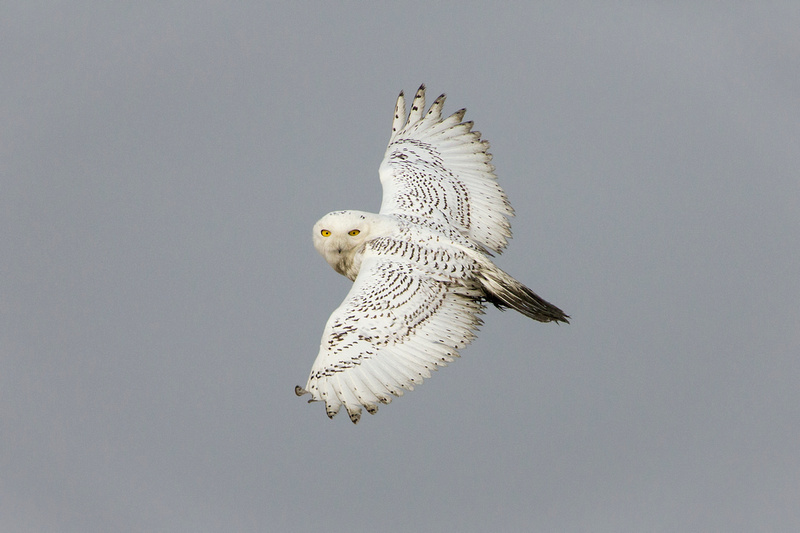
Surprisingly, I got a whole sequence of sharp photos of the owl ....
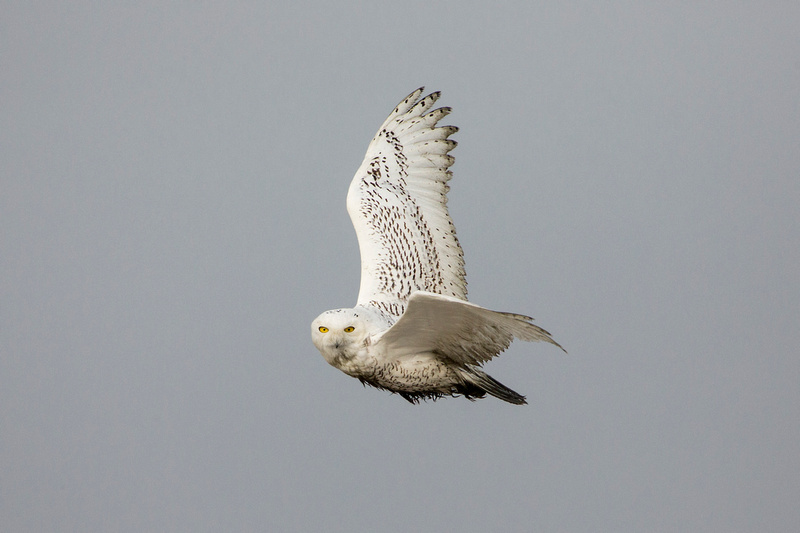
........ making the poor bird's tattered condition even more lamentable. I continued out on the beach where a photographer friend was shooting a second owl. This owl was cleaner looking and sitting up in a tree, although the clouds and fog made for a difficult photo situation. Occasionally, the sun would break through and light up the scene acceptably.

As the clouds thickened, we headed back to the parking lot to go get lunch. As we were leaving we saw the dirty owl sitting on a fence surrounded by people photographing it from all angles. The owl looked uneasy, but did not fly off. It appeared that something was wrong with it.
We went for lunch and returned to find the owl gone. We later found out that someone had called a rehabilitator who was able to pick the owl up and take it in for treatment. To end the day we went back to the first jetty to photograph the second cycle "Glaucous Gull". After I looked at the few shots I took first thing, I decided it was an Iceland Gull, not a Glaucous. When we returned to it, we both thought it was a Glaucous Gull again despite the gray wing tips, based on size, head and bill shape and behavior. It turns out that this is the infamous gull that has been stirring debate among birders and gull experts for the past two winters. There's still no consensus on the gull's identity, but the prevailing thought is that it's a very large "Kumlien's" Iceland Gull. I have no expert opinion to add, only a few more pictures.
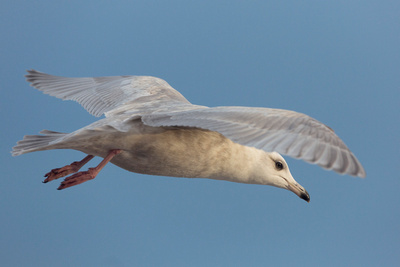
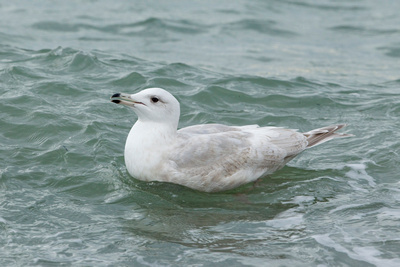


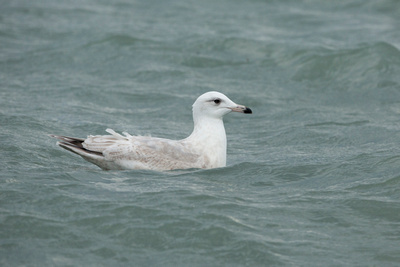
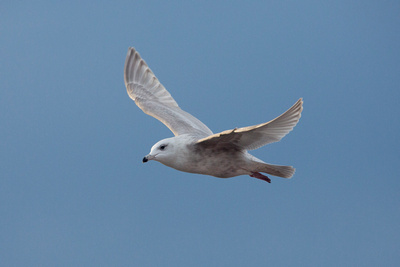
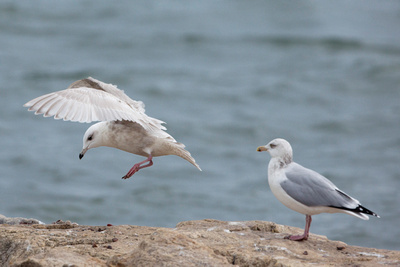
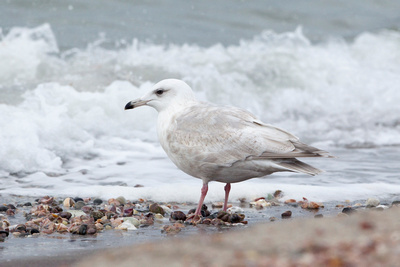
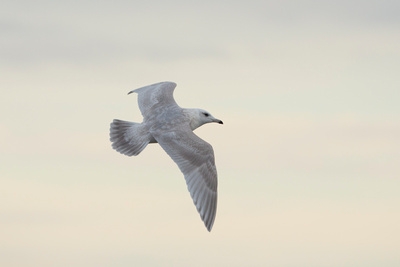
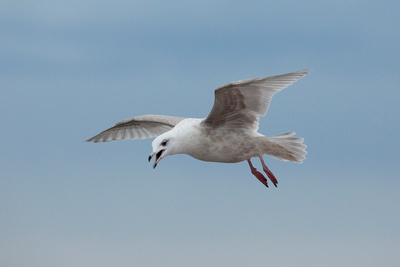
The end of the year was pretty quiet, but there was a large flock of Starlings around at Hammonasset that I spent some time photographing. I marveled as the flock swirled through the west end of the park, changing directions on a dime in unison.

At one point they wheeled around in tight horizontal swirls, known as murmurations, before I noticed a Red-tailed Hawk flying west in the middle of the flock. The behavior is a defensive mechanism to confuse birds of prey with overwhelming numbers.
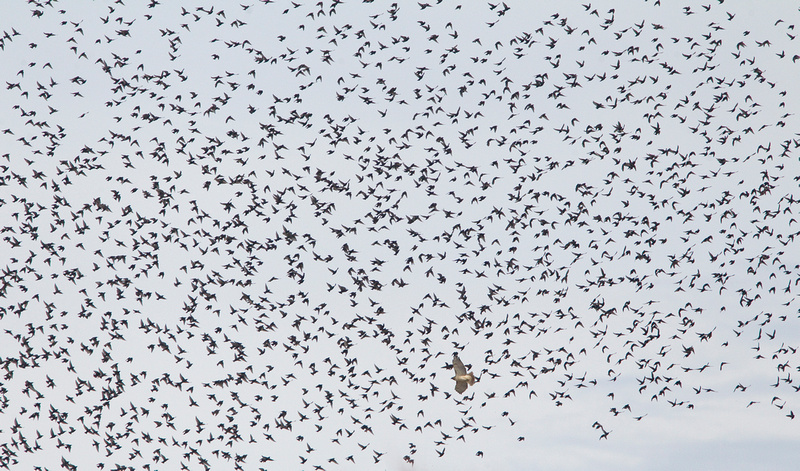
I was reviewing those pictures in the camera back and when I looked up the Starlings convulsed into a vertical comma shape. I quickly aimed the camera at the distant shape and fired off a number of frames. When I stopped shooting they were again in a long line spread out horizontally. As I reviewed these pictures discovered the cause of the gyrations, a stooping attack from above by a Peregrine Falcon that I had not even seen.

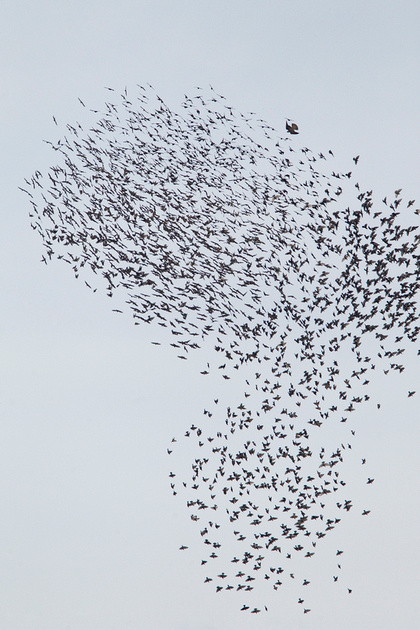
Even common and unpopular birds like Starlings can make interesting subjects. As I wrap up 2013, I look back on the many exciting observations throughout the year. It kicked off with Crossbills and Razorbills last January and ended with a spectacular South American Fork-tailed Flycatcher and the biggest movement of Snowy Owls into New England in decades. Along the way, there were plenty of great opportunities to photograph birds, from the ordinary to the exotic, that made this venture worthwhile. I'm not disappointed that I didn't see anywhere near the number of different birds that I'd hoped to. For me, it's more about quality than quantity. It's a lot more satisfying to see and photograph birds up close, even the common ones, than to compile a big list. I'll continue to work on seeing more uncommon birds, and will continue this journal on a regular basis, writing about field observations and photography. Thanks to all who followed my blog this past year.
]]>
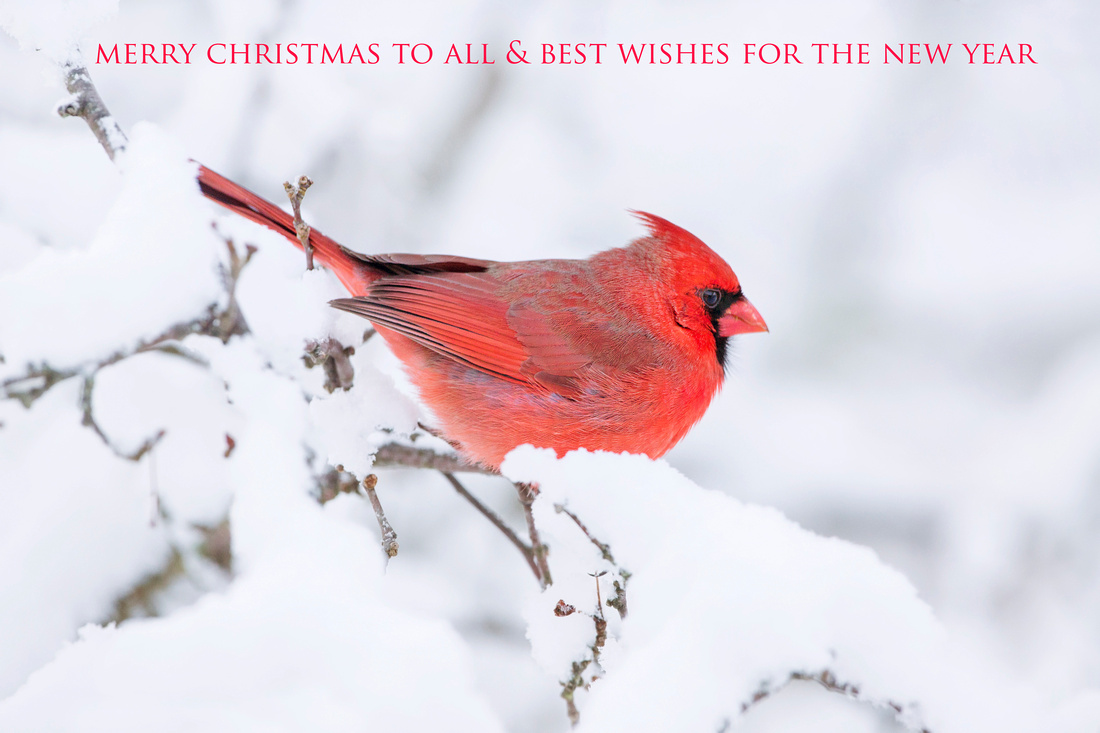 ]]>
]]>
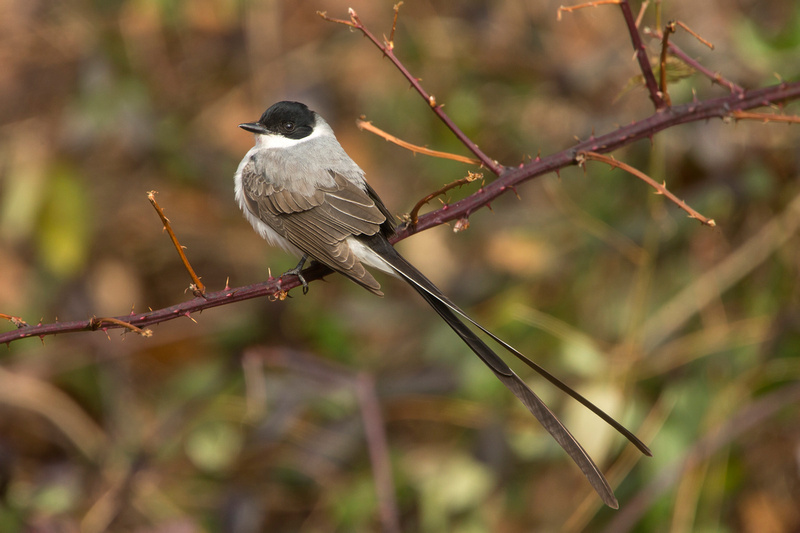
The Hadlyme Ferry Landing would usually be pretty quiet this time of year, actually all of Hadlyme would. The ferry stopped running in November, and the road dead ends at the Connecticut River. But, on the three different visits I've made to see and photograph the bird, there have been at least a dozen birders and or photographers there, coming and going all the time, all day long. Even some local residents stopped by to see the star attraction that was drawing visitors from far and wide to their quiet community. I spoke to people who drove from Massachusetts, New York and Pennsylvania to see it. One resident thought it might even be an economic boom for the Hadlyme Country Store, where he had run into a number of birders here to see the wayward wanderer.
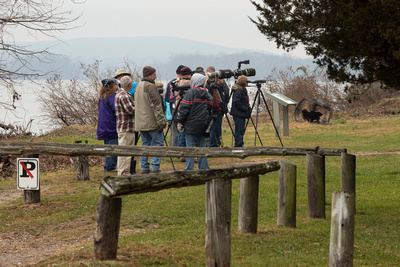
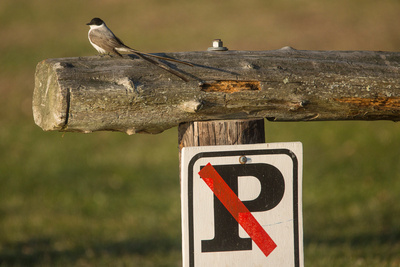
I doubt anyone visiting went away disappointed, either. This bird is not a camera shy, and often sat perched in the open at various spots around the tiny parking lot and lawn, posing for the crowds. Given its behavior, and the amazing number of people with cameras, it's probably one of the most photographed birds in state history. And it's not a bird you need to get that close to, either. On my second visit, while the crowd was at the far end of the little park looking for the bird, I waited near a tangle of vines in the middle that it frequented. As the bird flew in, I heard someone from behind me call out "there it is" and then "it's right over your head". The bird landed on a post right in front of me, too close to fit the whole tail in the frame. I took a couple shots and quickly tried to remove the teleconverter on my lens as the group from the far end closed the distance quickly. Just as I got the converter off and the camera back on, the pack closed in and the bird flew off.
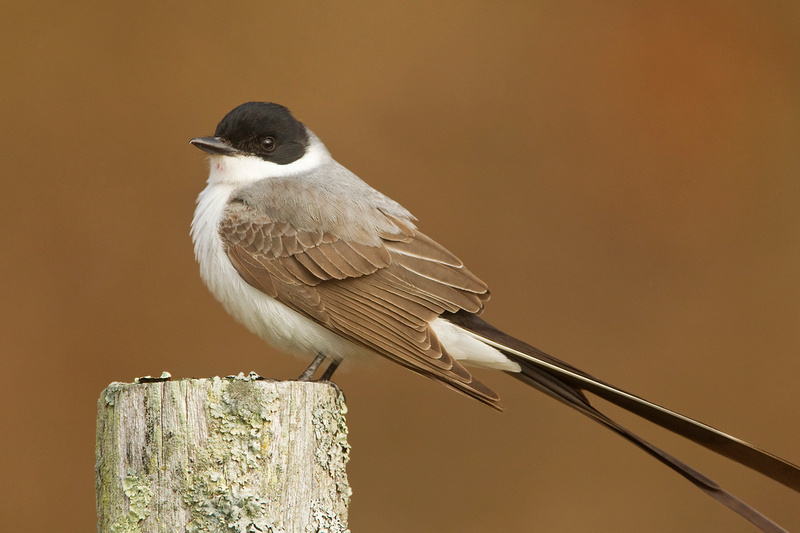
Fortunately, on my next visit I planned accordingly and was able to get the shot I'd missed days earlier.

It's strange to think that these birds, whose normal range is thousands of miles farther south, and whose diet is primarily insects could wind up in Connecticut, twice in three years, just as winter is about to get going. The theory is that instead of migrating south during spring in the southern hemisphere, one will occasionally head in the opposite direction, winding up more than 1000 miles to the north instead. As with the one in Greenwich, this one seems to be finding enough insects considering the time of year. It's also supplementing its diet with berries, like pokeberry, pictured below.
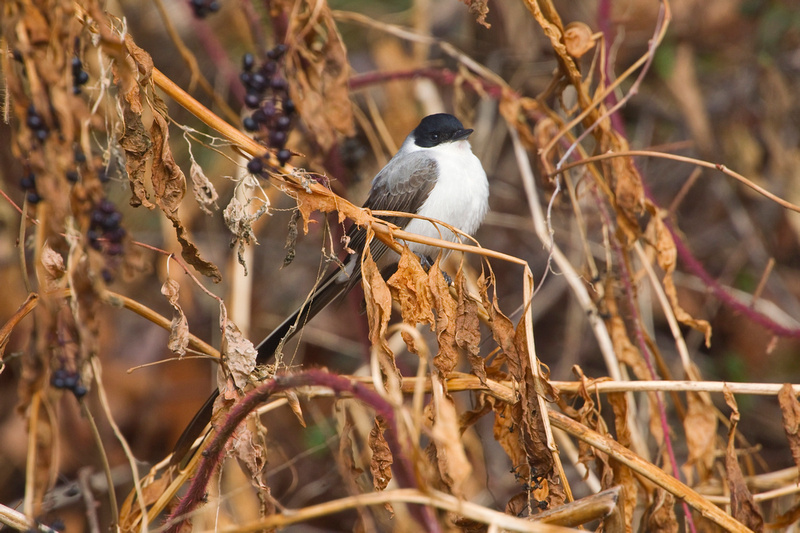
On one of the warmer afternoons, there were definitely some bugs buzzing around and the bird was flying out and snapping at them. I was hoping to get pictures of the bird in flight, especially flycatching. Taking my camera off the tripod, I trained it on the bird as it perched in the branches and tried to anticipate which direction it would fly out. All I got were some tired arms from handholding the camera and a few marginal flight shots for the effort, but it was fun to watch. I only hope the bird has the sense to head south before winter really sets in.

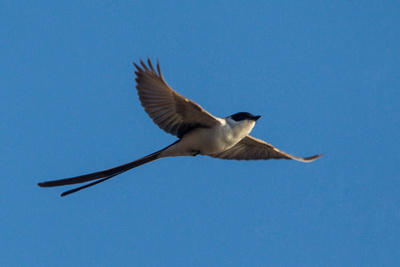
The Snowy Owls in Connecticut didn't completely take a back seat. Most of the sightings lately have been in the southwestern part of the state, but there have been a few reported from Hammonasset Beach State Park, in Madison, as well. I was able to photograph one there last week on the jetty at Meig's Point, along with a whole group of photographers.
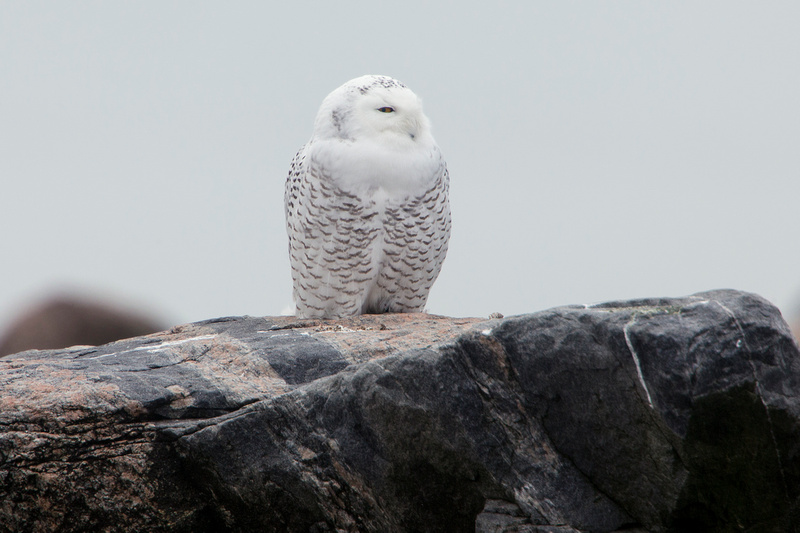
This one was a lightly barred bird that sat calmly on the rocks, allowing a group of photographers to shoot from the beach at a respectful distance. I used two teleconverters, a 1.4x and a 2x, stacked together to get tighter shots while it sat quietly. As it started to stretch and preen, I took the 2x off in case the bird flew. The time stamps on my pictures show that I was there for more than 15 minutes before the bird took flight, and many were there long before I arrived. I don't think anyone moved any closer to the owl the entire time I was there. Over the weekend, another was spotted off Cedar Island and there were dozens of people out there looking for it. There were also an amazing number of photographers toting big lenses, and it's fascinating for the few of us "old timers" to see how many more people there are now that share our craft.

At Hammonasset, I saw the Clay-colored Sparrows reported in the campground, mixed in with a big flock of juncos. While looking for them, I also saw a Pine Warbler and a Blue-headed Vireo.

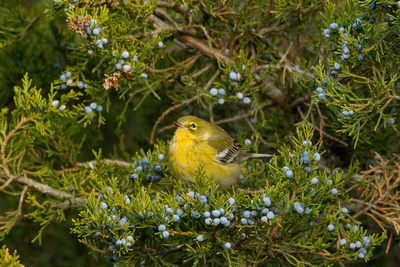
So far, the female King Eider at Harkness State Park, in Waterford has eluded me on two occasions, but I did see a flock of 17 Purple Sandpipers there while looking for it.
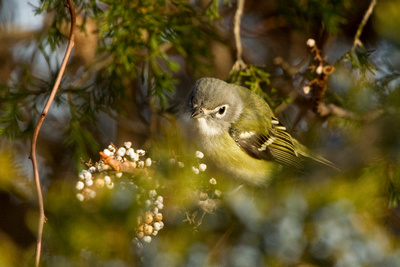
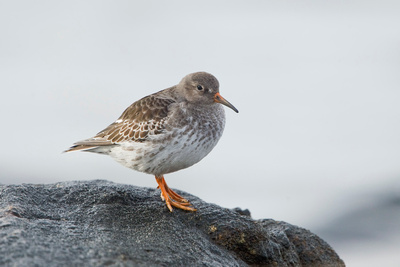
I added three new birds in the past week, including Clay-colored Sparrows, Snowy Owl and Fork-tailed Flycatcher, bringing my year total in Connecticut to 236.
]]>
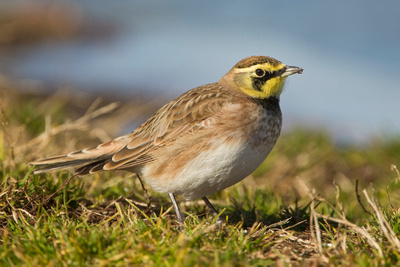
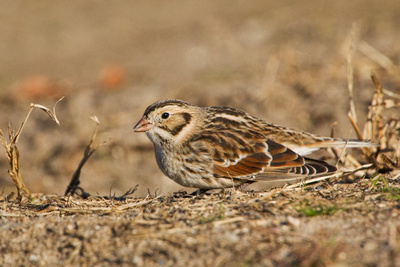
I was about to give up for the day when I saw that Keith Mueller reported a Greater White-fronted Goose in Durham. I decided to take a look since it was nearby and I haven't seen one this year. When I arrived there were about 100 Canada Geese tightly packed in the back end of the pond. Scanning the flock, I saw a few female Common Mergansers, Ruddy Ducks and Mallards, but no GWFG. I kept looking for 45 minutes as the Canadas slowly broke their tight formation and drifted towards the center of the pond, and a few made their way to the near edge of the pond. There were plenty of smaller Canada Geese of different races to look through, although none appeared to be Cackling Geese. Finally, I spotted a tiny goose in the center of the pond with its back to me. When it turned around, there was the GWFG. Eventually it joined the Canada Geese at the near end of the pond, then waddled out right in front of me and started feeding in the grass field.

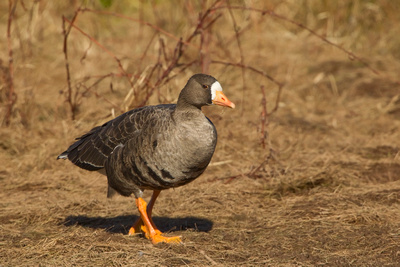
As I was heading home I saw a Barred Owl perched low in a tree at the edge of the road in Old Lyme. It was mid-afternoon and it appeared to be hunting. I was able to take a bunch of pictures from my car window without it flying off.
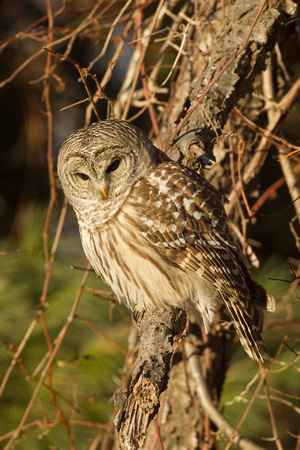
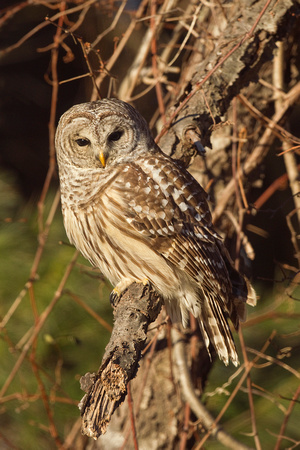
Since I was on a roll, I stopped at the Great Island boat launch to look for owls. I try to check there at sunset for Short-eared Owls flying over the island, but have not seen any there in a few years. With the influx of Snowy Owls to the region the possibility was there for one of those, too, but the only thing I saw was a Northern Harrier.
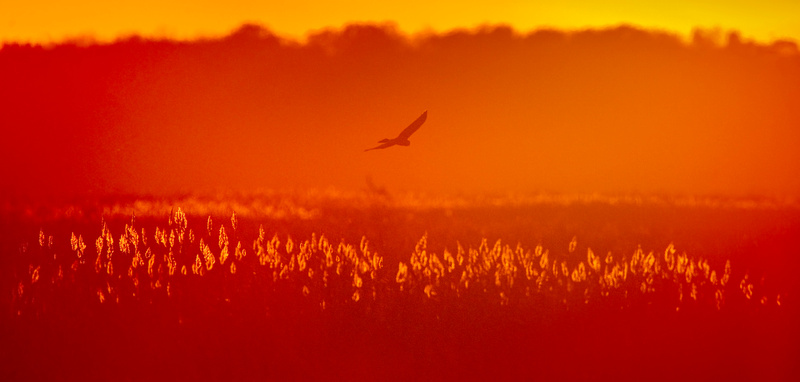
On Tuesday I had to pick my daughter up from school in Boston. Hoping to avoid potential traffic, we decided she would take the commuter train to Attleboro, MA so I decided to check a few spots in Rhode Island on the way there. My first stop was the Charlestown Breechway, where the first thing I saw when got out of the car was a Snowy Owl on the dune across the channel.
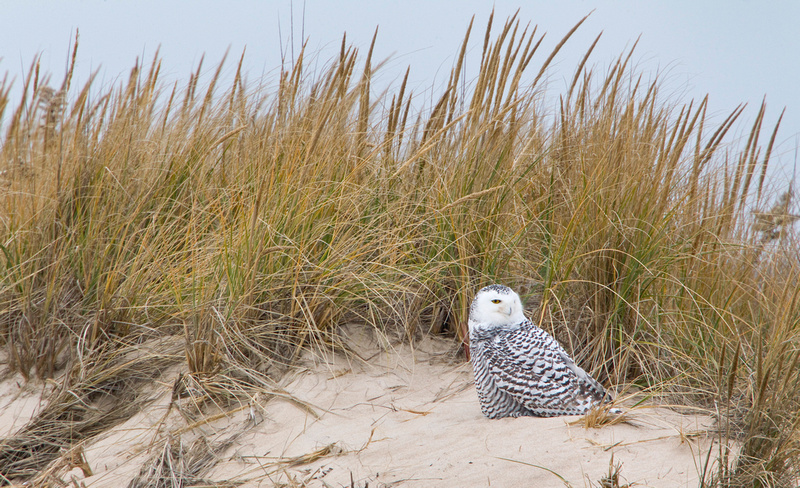
I told a Rhode Island birder about it and asked about the protocol for posting owl locations in the state, because Rhode Island has a private bird list that I'm not a member of. He said that the policy is not to report owls and asked me not to post the sighting. After quick stops at Trustom Pond and Moonstone Beach I left for Attleboro. We got home after dark to find that we had avoided a 33 mile traffic jam on the Mass Pike leaving Boston and that Hank Golet found a Snowy Owl at Great Island. Later that night I saw that the Charlestown owl was posted on the RI ABA site that is rarely updated. I checked for the Snowy at Great Island in the rain early Wednesday morning but saw nothing.
After a great Thanksgiving, I headed out early Friday morning hoping to avoid anything related to Black Friday. Arriving in Charlestown as the sun rose, there were at least a dozen Common Loons at the mouth of the breechway. There were a few fisherman and their pickup trucks across the channel in the area I saw the owl Tuesday, and an owl was perched on the sand fence father down the beach (at far left, below).
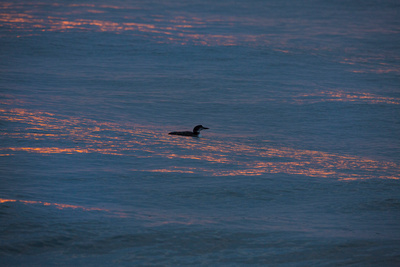
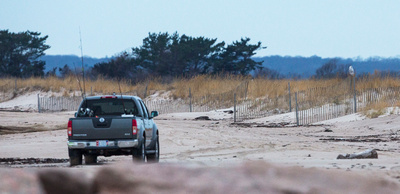
I thought there was another lighter owl farther down the beach, but it was too far to be sure. While I was watching across channel, another darkly barred first year owl flew down the beach from behind me and landed on the rocks fairly close to me.

This owl looked skinny and perched with its wings hanging awkwardly before flying across the channel to join the other owl in the area the fisherman had since departed. Although I never saw all at once, I believe there were three owls on East Beach near the breechway, two darkly barred ones (pictured together) and a lighter one (at right).

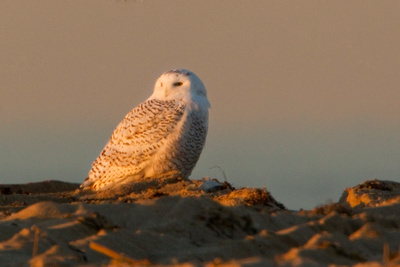
Next, I headed to Sachuest Point NWR in Middletown, RI to join a friend who photographed one of the Snowy Owls there. The owl was still sitting on the rocks at the edge of the water and dozens of people at a time stopped to look at it from the trail above.


Nothing draws crowds of spectators, including birders, photographers and casual observers like Snowy Owls, a rock star among birds. This combination of crowds of people with a wide spectrum of experience and interests and spectacular, rare birds is a powder keg that invariably explodes. The owls are here because there is a food shortage in their normal range, and there have already been several venomous exchanges on the Massachusetts and Connecticut bird lists about people harassing them. It's silly to generalize, and blame groups of people for the behavior of a few, but it's also unrealistic to expect no human disturbance to these owls in such a crowded region as southern New England.
While we were watching the Sachuest owl from the trail along with many others, I wondered aloud what the owl might be thinking about the crowd of people who just stared at it, not posing any apparent threat. Many were people just out for a walk with their families, and stopped to see what the attraction was. Some climbed on the rocks nearby, a common activity there, but were eager to steer clear of the owl when alerted by onlookers. But as I was setting up my camera before walking out to the owl, a young man approached and asked if I was going to photograph it. He was excited to show me the picture he got of the flying owl. "Does that mean it flew away?", I asked as he showed off the nearly full frame picture of the owl taking off from the rocks that he shot with his 70-200mm zoom lens. "It came back", he replied, but I'm sure the damage to the reputation of "photographers" was already done.
The situation in Charlestown is even more complex. It is an area that is frequented by fishermen, duck hunters, rabbit hunters, dog walkers and off road enthusiasts. Most of these people are just going about their usual routine, not intending to disturb the owls, but it's unavoidable. Fisherman fished from the breakwater, while the owl tolerated their presence from the rocks on the opposite side. But when a boat went through the channel the owl was flushed from a favored perch.
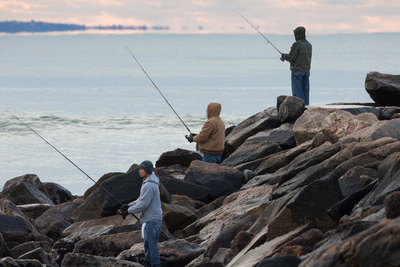

Later, a jeep made it's way down the two mile stretch of beach, chasing the owls back to the east, directly towards me.
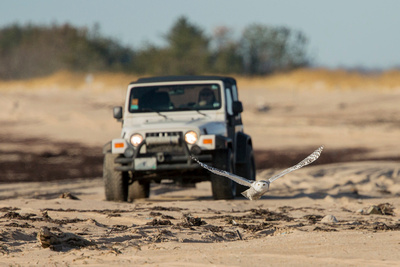

All these pictures were taken from a distance with a long lens, and some are cropped significantly. I got some unexpected chances and took advantage of some unintented disturbance of the owls, hopefully without committing any "fouls". I hope the owls stick around for a while, but they might not if they can't find enough food or are continually harassed. It would be great to get some closer pictures but it might be better to wait until the novelty wears off, and some other rarity like a FORK-TAILED FLYCATCHER (.... next post) shows up and draws the crowds away from the owls.
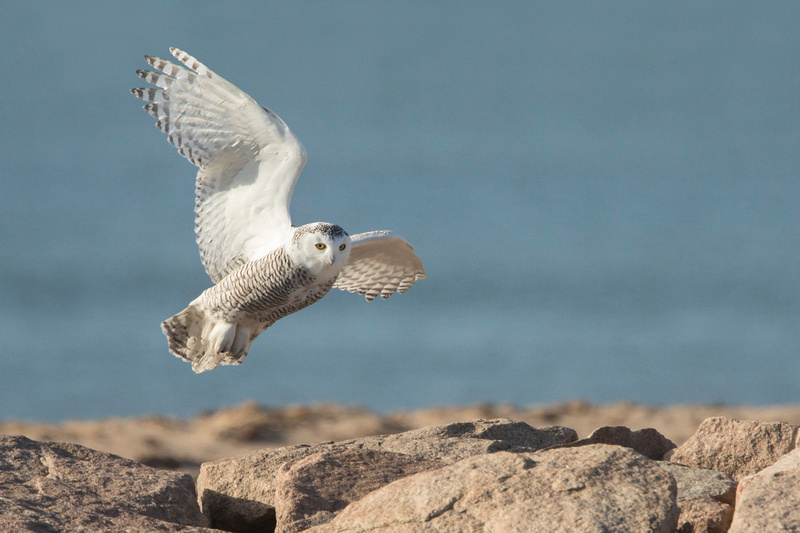
]]>
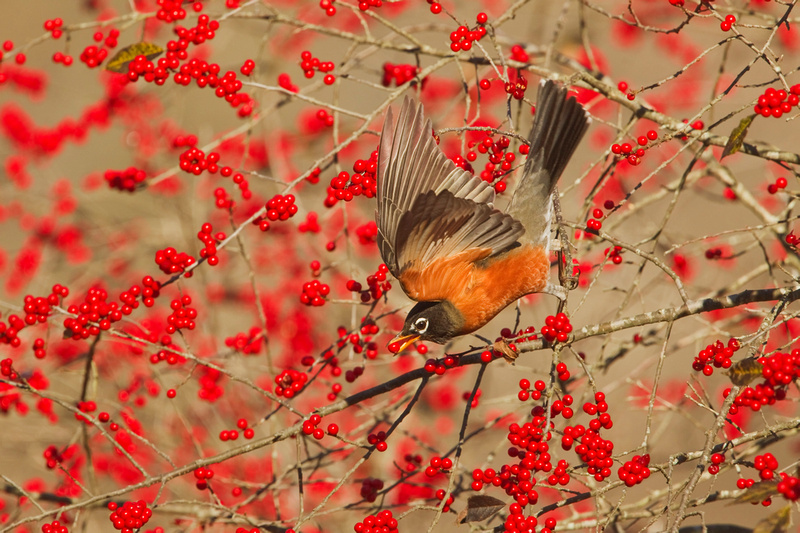
Grabbing my camera, I walked closer and saw that it was a Winterberry bush, and it was under attack. I set my camera up quickly and started shooting. The first birds I saw were American Robins, nearly a dozen at a time. They were feasting on the berries with little concern for my presence, reaching to grab a choice one, and gulping it down whole.
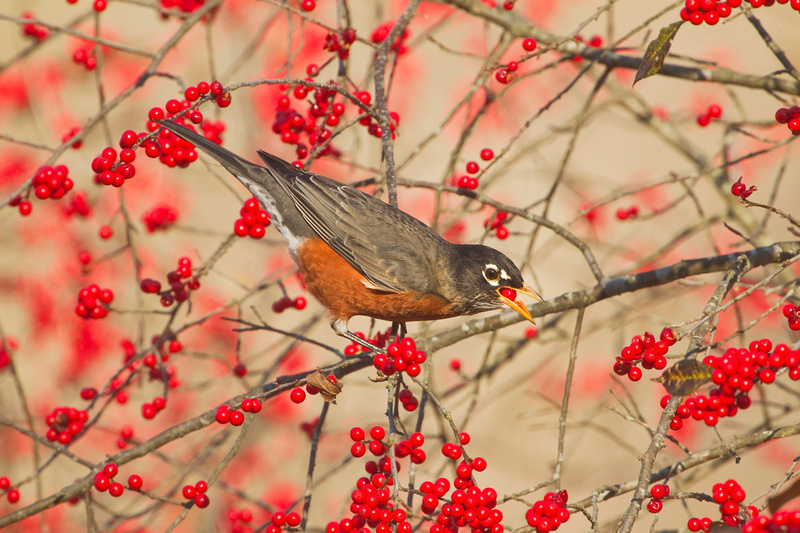
Soon I heard familiar high-pitched whistles, and a small flock of Cedar Waxwings descended on the bush, joining the robins at the all you can eat buffet.

A Red-bellied Woodpecker also joined in, hanging upside down while it fed.
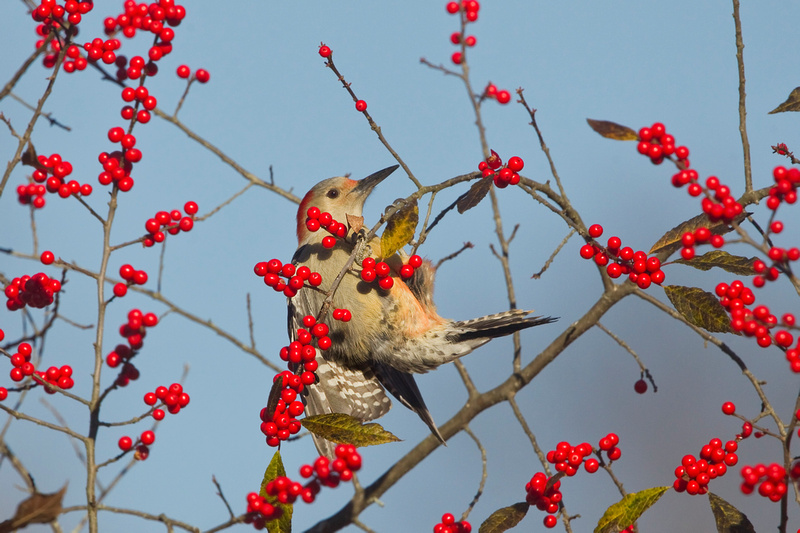
Next to arrive were two pairs of Eastern Bluebirds, although the males kept to the other side of the bush.
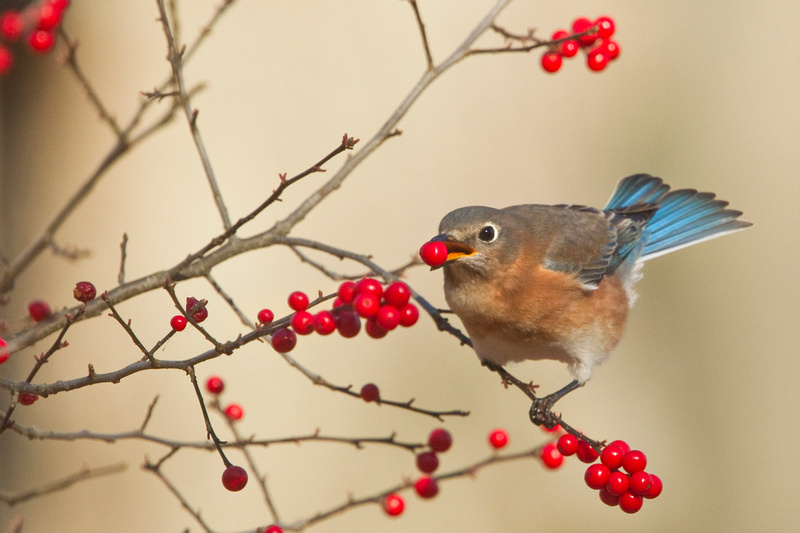
Even a White-throated Sparrow sampled the berries, crushing them with it's beak to eat the inner parts.
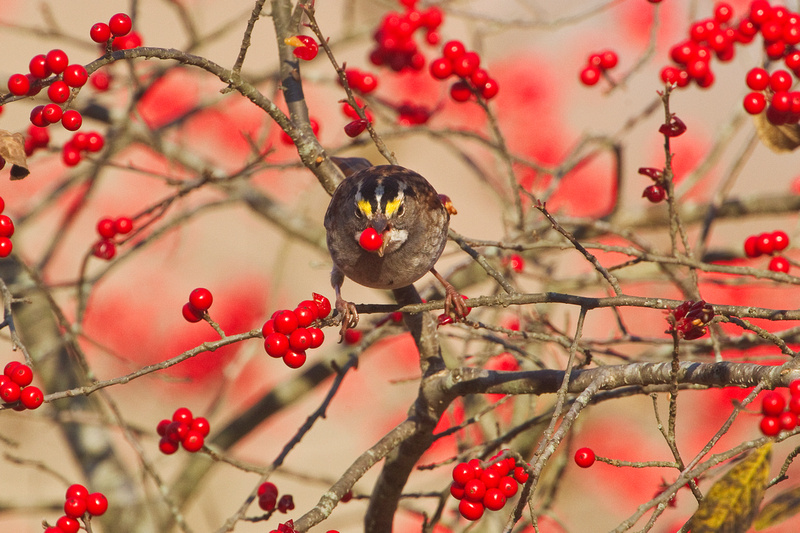
I had to leave for the day, but came back a few days later to find the bush had a lot fewer berries. There were still lots of birds in the area, though this time they were more spread out. Walking down the street a way, I found a flock of Cedar Waxwings feeding on a crabapple tree nearby.
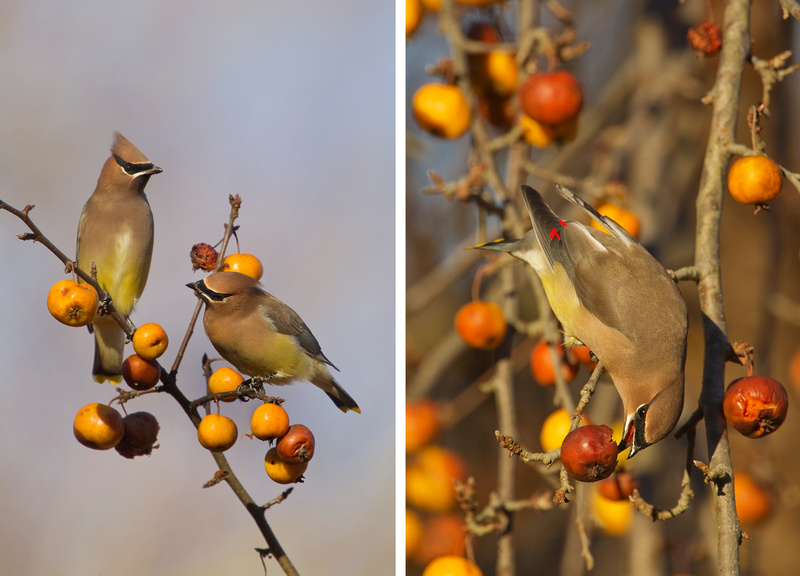
Finding a good food source is one of the best ways I've found to get close enough to birds to photograph them. In the late fall and into the winter, when insects become scarce, finding a good crop of berries like these can turn out to be a gold mine. It was puzzling that so many birds were eating Winterberry so early in the season. I've always thought that it's one of the last berries that birds eat, lasting late into the winter, but there doesn't seem to be any rhyme or reason to the birds' berry picking schedule.
In my yard there is a flowering dogwood that is a prolific berry producer. Every fall, a day arrives when birds decide that the berries are ready to eat. I try to watch it closely, hoping to photograph them, but there are years when I come home one day and the berries are gone, picked clean in a matter of hours. This usually occurs in November, and it's always the same birds, American Robins, European Starlings and the occasional Northern Flicker that eat the berries.

In 2012, the birds decided the berries were ready in early October, a month earlier than usual. The robins, starlings and flickers were all there, but because it was so early there were also some unexpected guests. These included Scarlet Tanagers, Swainson's Thrushes, Brown Thrashers and Gray Catbirds.

The truth is, I've photographed birds eating berries in all seasons. I also have a honeysuckle bush in my yard that draws the a crowd of birds, and for years I have photographed robins, catbirds and waxwings from my back deck as they swarm when the berries ripen in July.
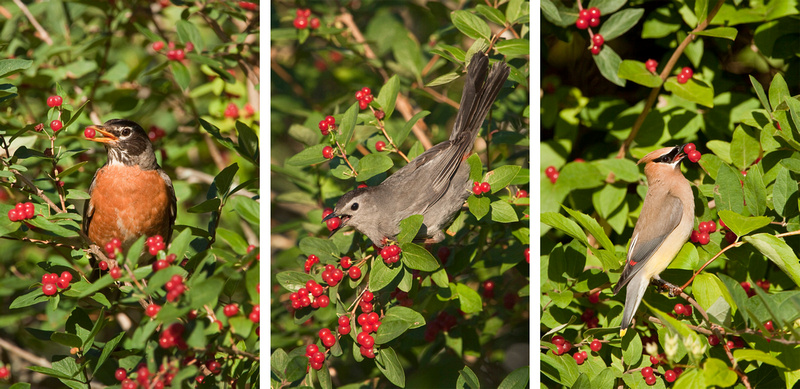
Even though these are common bird species, the bright red berries make for attractive pictures, the kind that calendar and magazine editors always seemed to like. One of my backyard berry pictures was chosen for a magazine cover years ago.
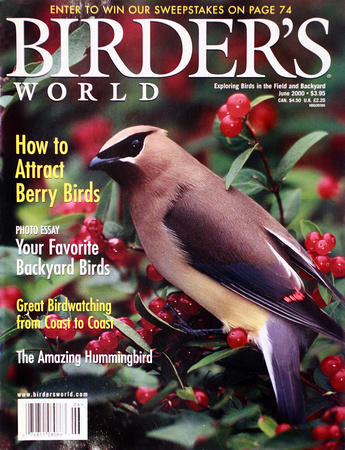
So it's a good idea to keep track of the trees and bushes in your neighborhood that produce berries that birds eat, because for birds and photographers, berry picking season can be quite a bounty.
Elsewhere, I was able to see three new birds this month, including Cave Swallows at Hammonasset, a beautiful drake Eurasian Wigeon found by Hank Golet in Old Saybrook and a Long-billed Dowitcher at Rocky Neck bringing my total to 233 this year, still way short of my goal.
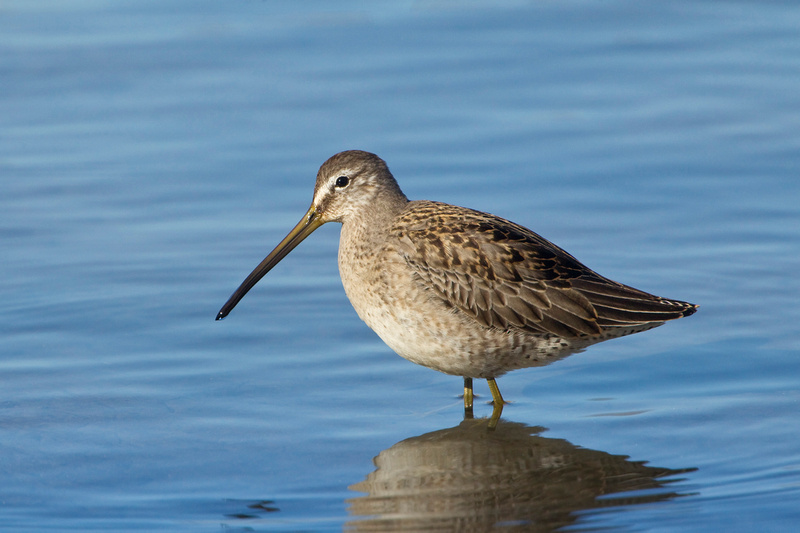
The dowitcher was first reported two weeks ago, and after checking for it several times with no luck I had given up hope of seeing it. More than a week later, it reappeared, in the company of some Greater Yellowlegs and stayed until November 20th. Now if I could have the same luck with the Short-eared Owls I keep missing and a few of the Snowy Owls showing up in neighboring states can make there way into Connecticut it could be an interesting winter.
]]>Sure, the calender says it's fall for five more weeks, but at that moment it unofficially ended. It's not like you couldn't see it coming, the temperature was dropping, the crisp breeze had turned into a biting wind, and the gaudy foliage was fading to more somber hues with each passing day. When the sun went down the night before, though, there were still plenty of leaves on the trees, and the hope of another colorful autumn day. But overnight it all changed, it always seems to happen that way.
For as long as I can remember, fall has been my favorite time of year. No surprise really, autumn in New England is pretty spectacular. I've always liked the cooler weather, fall sports, apples, cider and just about everything else that goes with the season. As a photographer, the spectacular colors and softening light create seemingly limitless picture possibilities, as well.
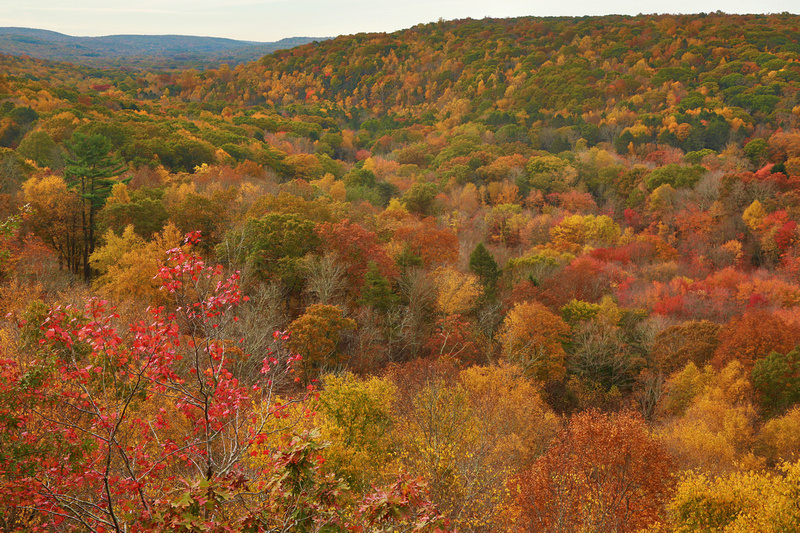
Every autumn I spend many hours trying diligently to capture the color and beauty I see all around. The pictures always seem to fall a little flat, though, photographs rarely outshine nature itself, or images captured in the human eye and mind. But that doesn't keep me from trying, and the results aren't all bad.
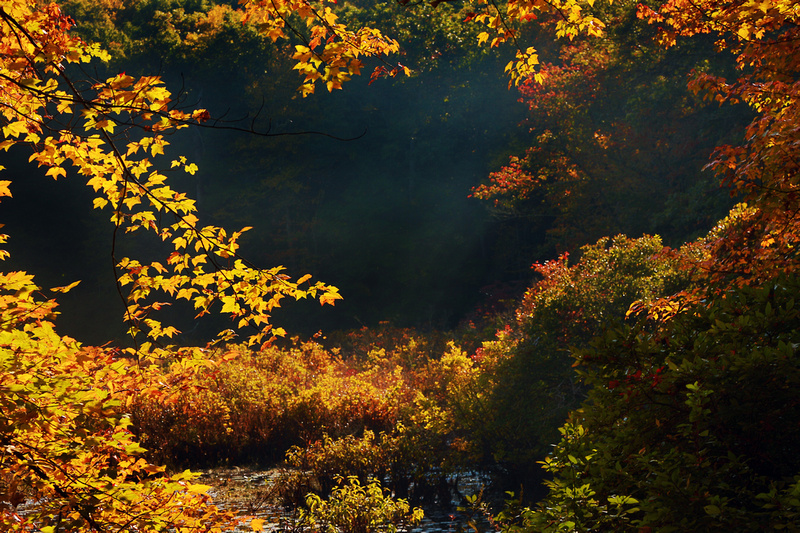
I'm usually most underwhelmed when I first go through the photos, because they don't live up to my memory of the scene. As time goes by and the mental images fade, the photographs tend to grow on me. Shooting fall foliage depends so much on the light. In order to capture the rich colors, I shoot mostly on overcast days, a holdover from the film days. That helps keep the colors saturated, but pictures can look dull and flat. It's harder to capture the brilliant colors on a crisp sunny autumn day, and I rarely shoot foliage in direct sunlight, although I do sometime like the results of backlighting, like the picture above. Another problem I have is, that despite the beautiful colors, editing foliage pictures is very laborious for me and takes away a lot of the fun of the capturing the beauty of the season. With stationary subjects, it's easy to take lots of different views, but I find it painstaking work to choose between them.
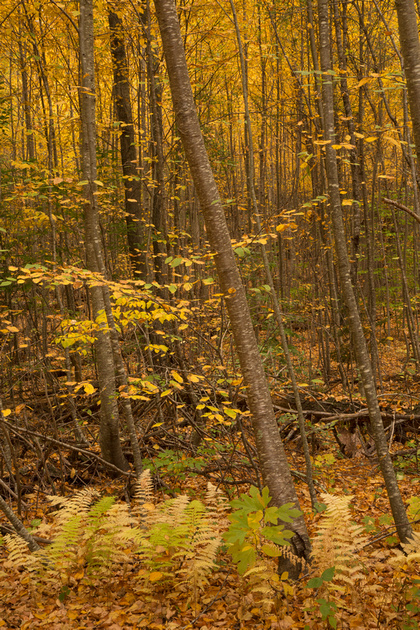
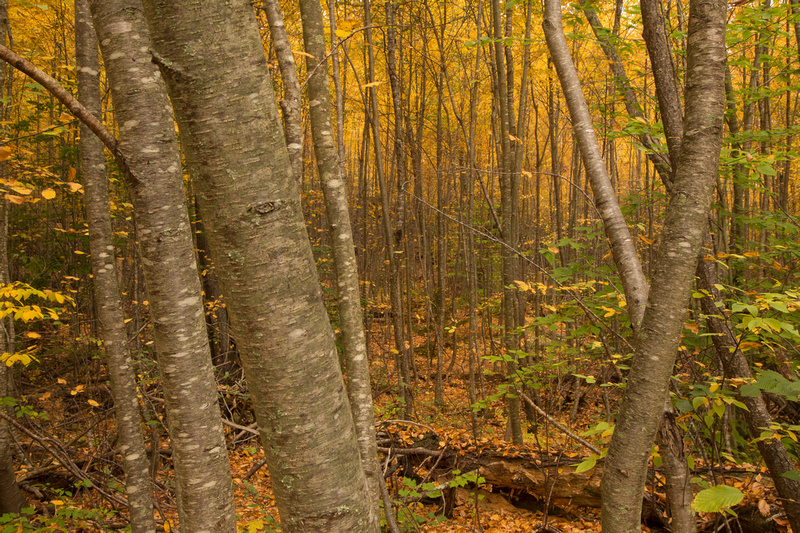
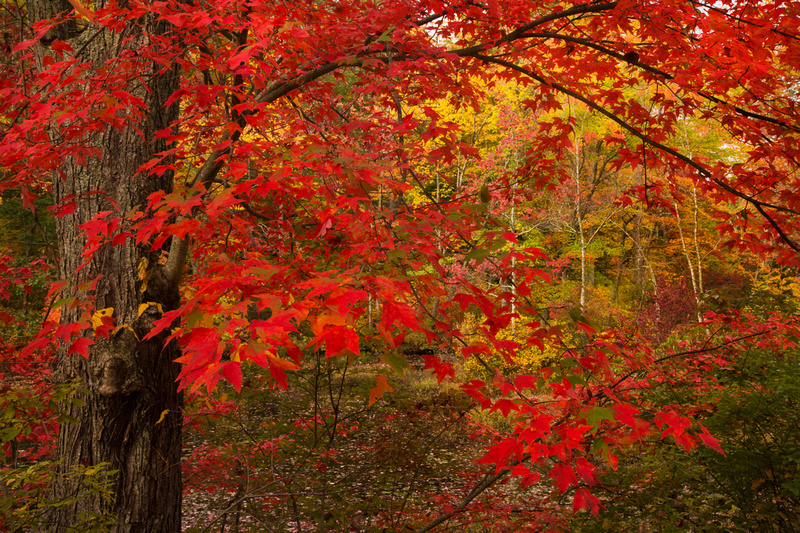
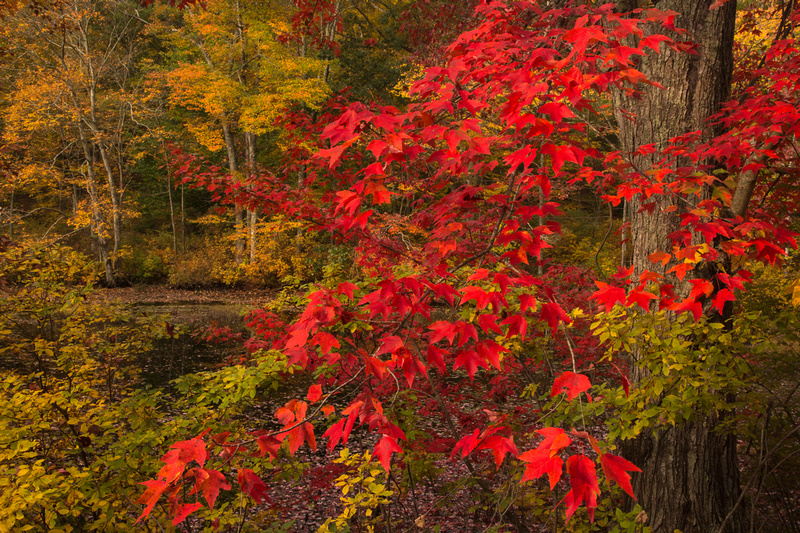
I also like to vary my subjects. Trees and foliage are everywhere, but I like to find the equally colorful but less obvious plants, like Sumac and Virginia Creeper. One of those is plants is Glasswort, which grows in salt marshes and turns deep red in the fall. It really stands out to me and every year I shoot it, though I'm rarely happy with the results. This year I photographed a few nice patches of Glasswort and pushed the processing a bit to get the pictures below. The saturated colors in the photographs are a bit exaggerated, but that's how I remember seeing it.
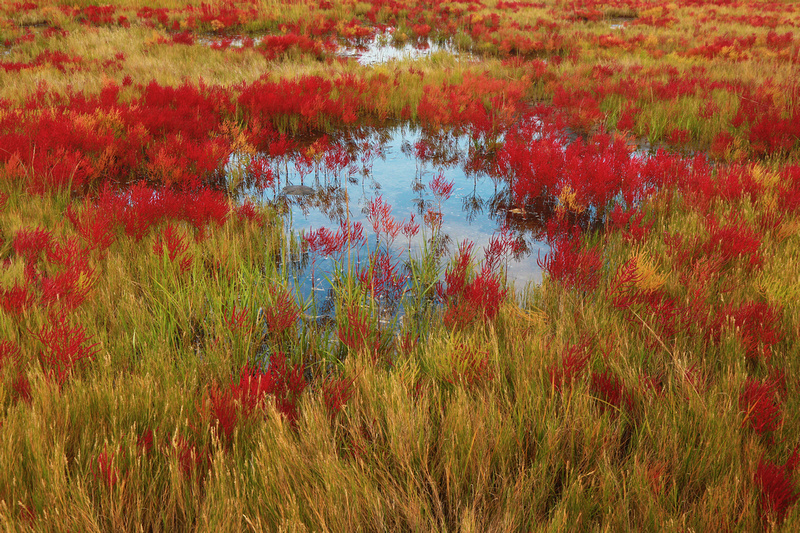

When I find a patch of Glasswort in a marsh, I keep checking it hoping to photograph a bird or animal walking through it, but it never seems to happen. This year I finally found a Great Egret that would feed in such a spot, and even though it was a little past peak, the red plants added a splash of color to the otherwise ordinary pictures.
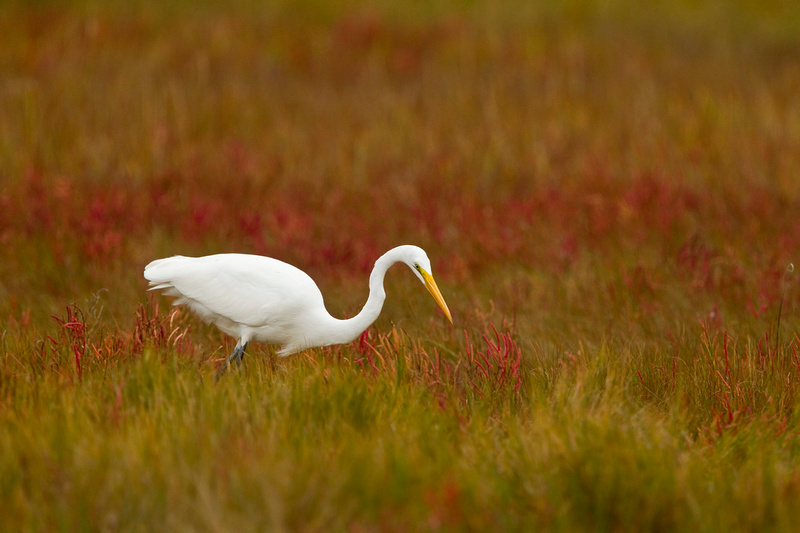
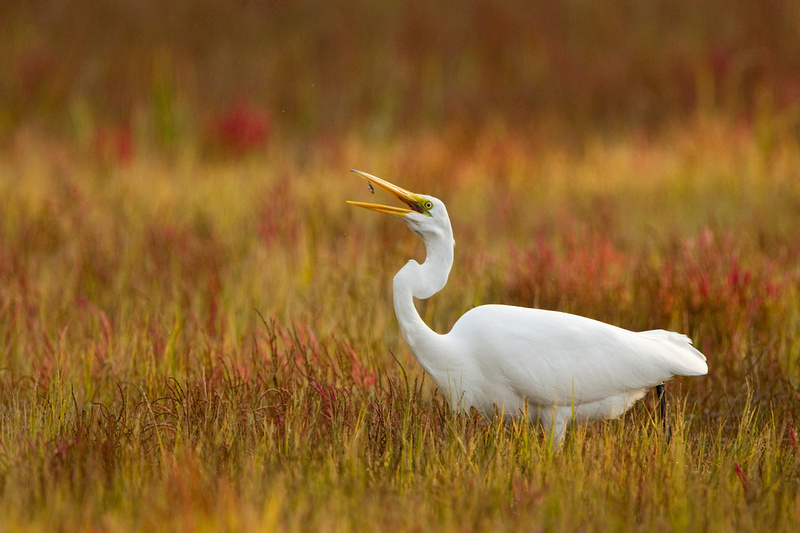
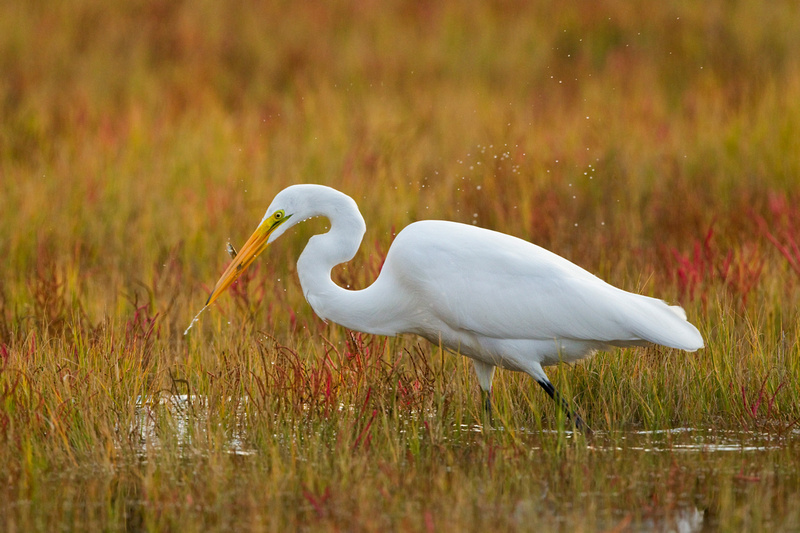
Since taking an interest in birds, I've come to appreciate fall for yet another reason. With migration in full swing, the variety of birds in Connecticut is great. Whether it's a rare bird passing through the state or a common one found year round, photographing birds with a backdrop of brilliant fall foliage or even a hint of autumn color is always a bit special, and has resulted in some of my favorite pictures over the years. It's also easier and more enjoyable for me to work on pictures that capture the colors of the season, but also have an interesting subject as the focal point.
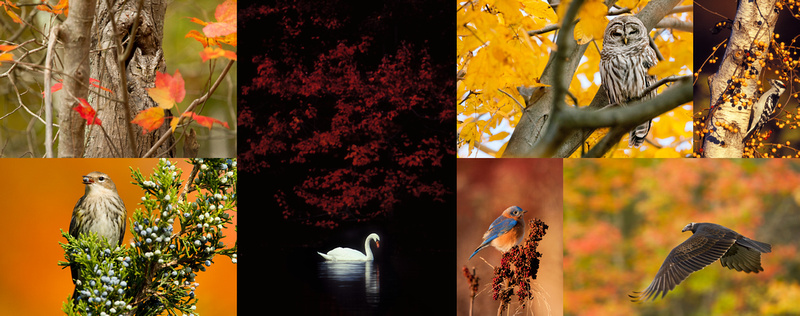
This fall I spent quite a few mornings working in the community gardens at Bauer Park in Madison. In past years I've photographed there in early September, because the flower gardens attract a good variety of butterflies. With reports of some uncommon birds being seen there this October, I stopped to see if I could get a look at them. I did get to see most of the better sightings in my fist couple visits, including Blue Grosbeak, Grasshopper, Vesper and Lincoln's Sparrows, but didn't get any good pictures of them. What kept me coming back was the colorful autumnal backdrop that had all kinds of picture potential.
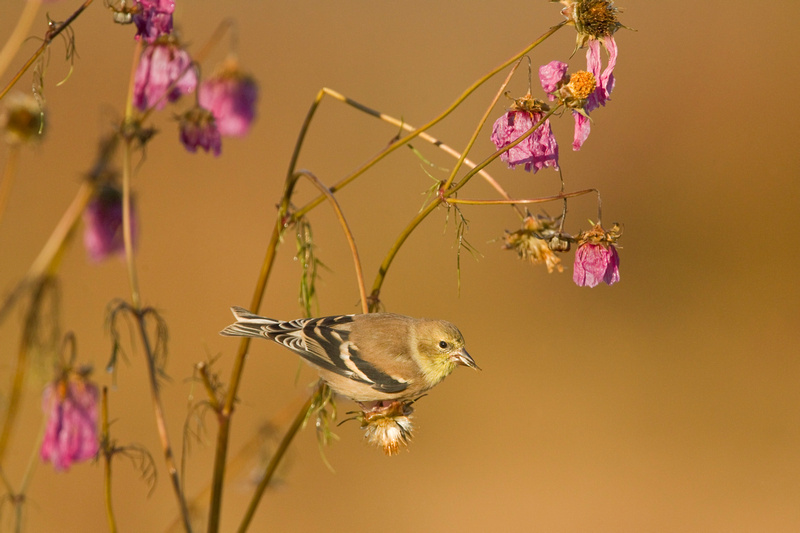
I have adopted "ride the hot hand" strategy for photography that has worked out many times over the years. When I find an area where I see good stuff, and get some good shots, I keep going back to it until it cools off. Sometimes these are pretty odd locations, like a stretch of a residential street that I drove through or a commuter parking lot. I may have never seen anything there before, and might never again, but for a week or two the area was hot spot. Bauer Park is a more likely spot, but when I started having some luck there, I kept going back. Most of the birds I photographed were common ones, plain looking goldfinches and sparrows that you could find anywhere. But, feeding on the sunflowers, overgrown weeds gone to seed and fading flowers in the garden, they seemed to capture the color of fall perfectly.
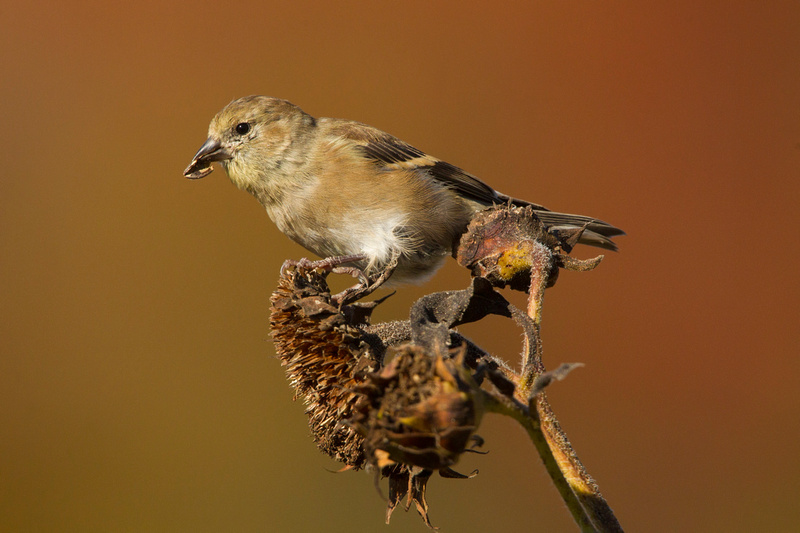
Savannah Sparrows were most plentiful, but their coloring and feather patterns are so variable that they always drew a long look. They also seemed to blend in perfectly with the autumn backdrop.
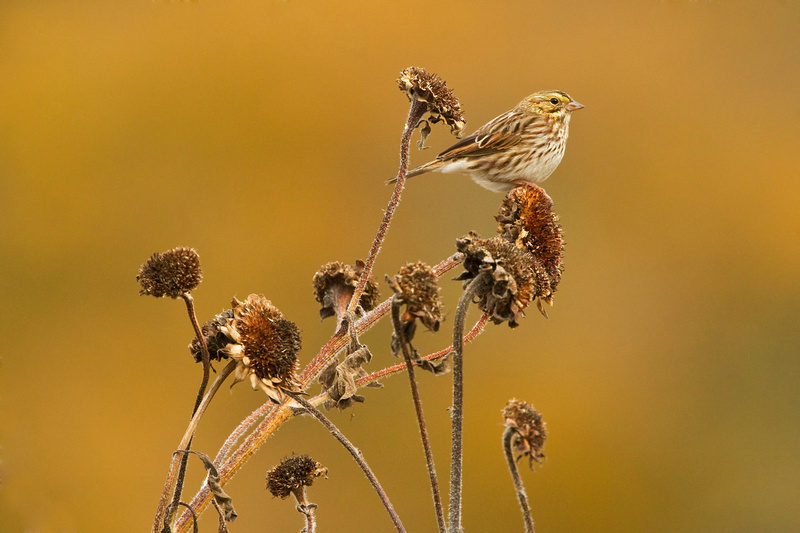
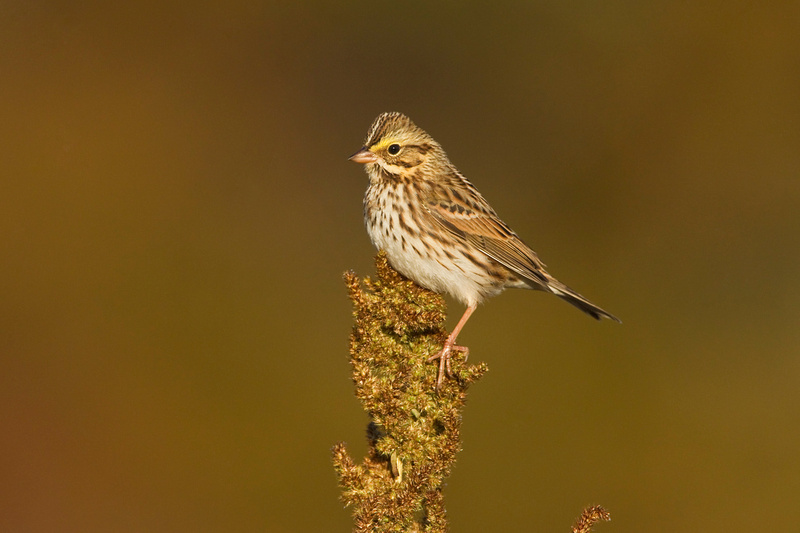
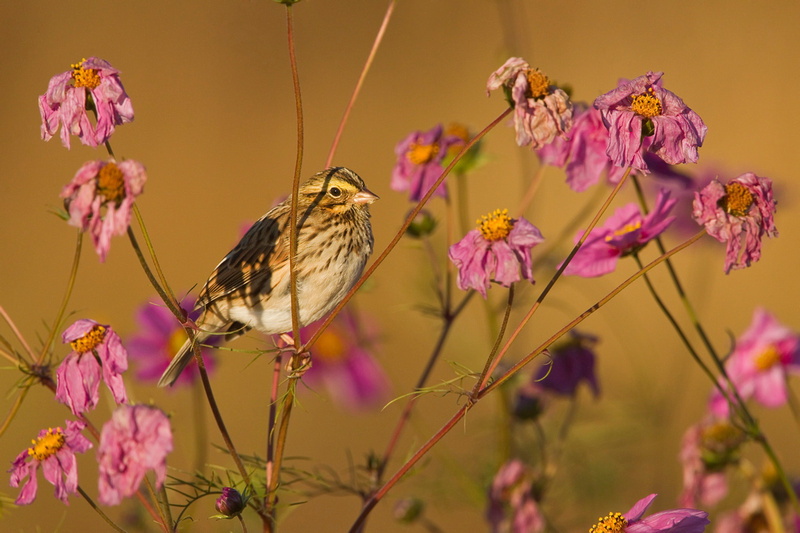
Among the most colorful birds there were Palm Warblers. They were not feeding on seeds at all, but hopping through the leftover vegetable plants looking for bugs.
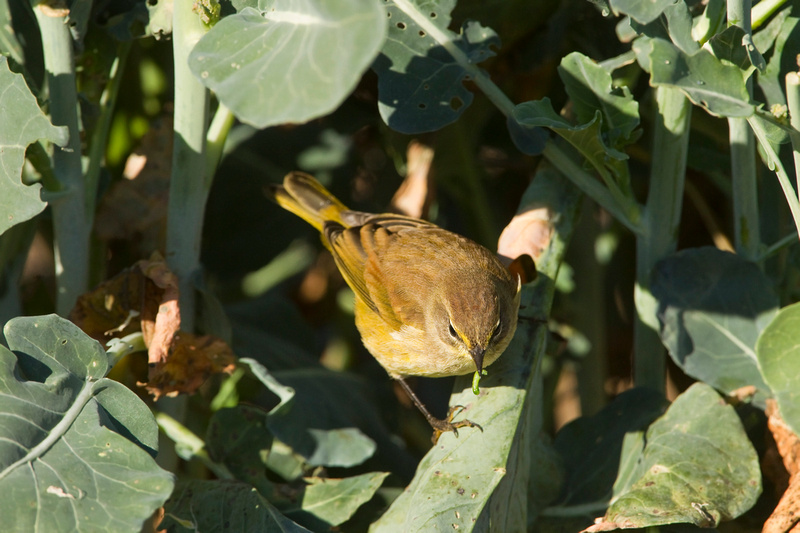
These Palm Warblers were the yellow eastern race birds that also seemed to match nicely with the fall color scheme.
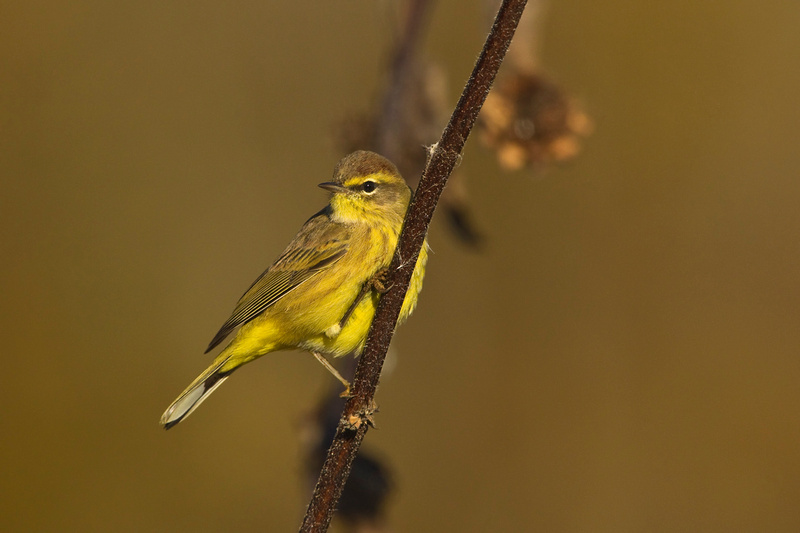
One day, from across the garden I kept seeing Eastern Bluebirds landing on the sunflowers. I moved closer, wondering if they were actually eating the sunflower seeds, too. As I got close enough, I could see that it wasn't the seeds they were after, but insects, like the spider caught by this male bluebird.
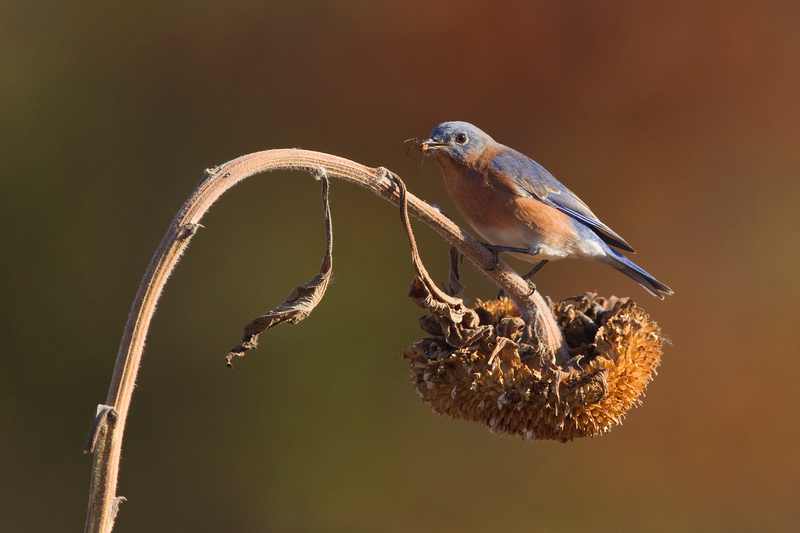
Eventually, this hot spot cooled off, like they always do. And a couple weeks later, a rainy, windy morning brought this colorful season to an end for another year.
]]>Most years the fall migration kicks off in mid summer when the first shorebirds arrive from their nesting grounds farther north. I'm usually not in "migration mode" that early and still working on the resident birds until the end of August. This year was a bit strange, though, because there were very few of the expected terns gathering along the Connecticut shoreline. While looking for Roseate Terns, which I usually see by July, I noticed that it was hard to find any terns in the southeastern part of the state at the end of the summer.
Turning to other subjects, it was a good season for the many herons and egrets staging in local salt marshes. These aren't the most exciting subjects for me, but they are plentiful and can be fun to watch as they show off their various fishing techniques. At Rocky Neck, a young Green Heron used a stealthy approach, stalking its prey.
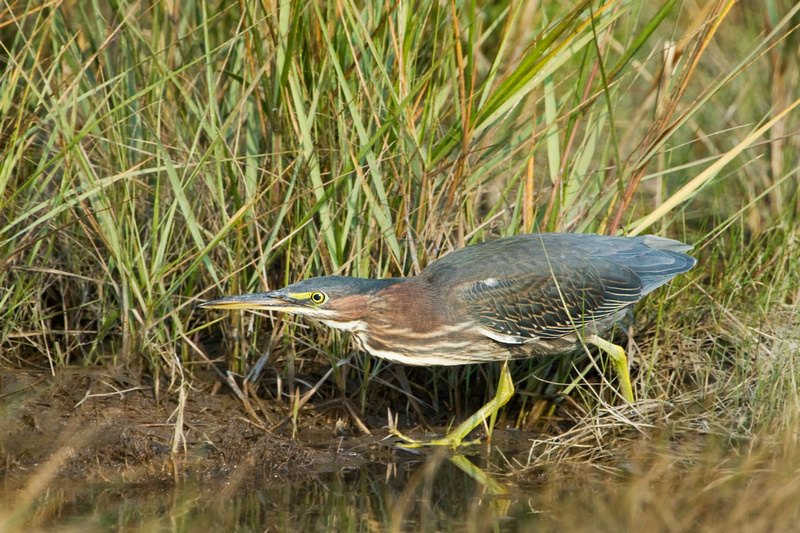
Great Egrets congregated in tight groups around productive pools in the Hammonasset salt marshes, spearing small fish in the flooded Spartina grass.
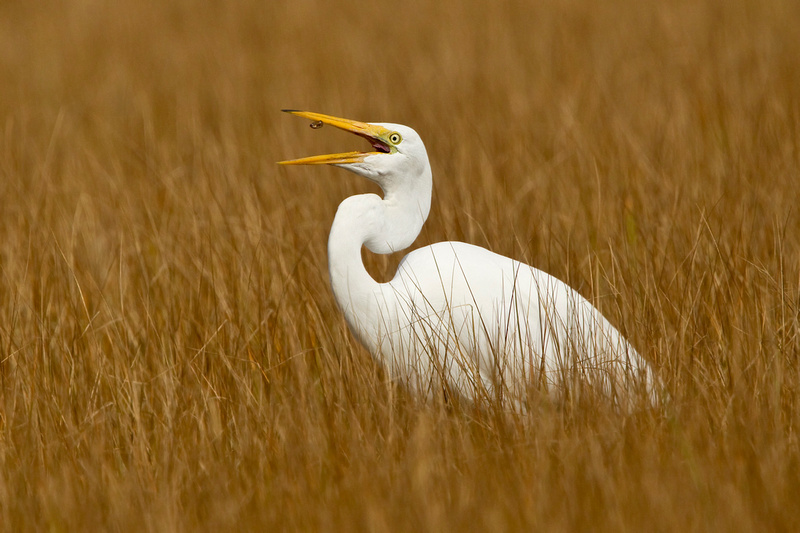
Occasionally, the close quarters led to noisy outbursts as dominant birds battled for elbow room in the best locations.
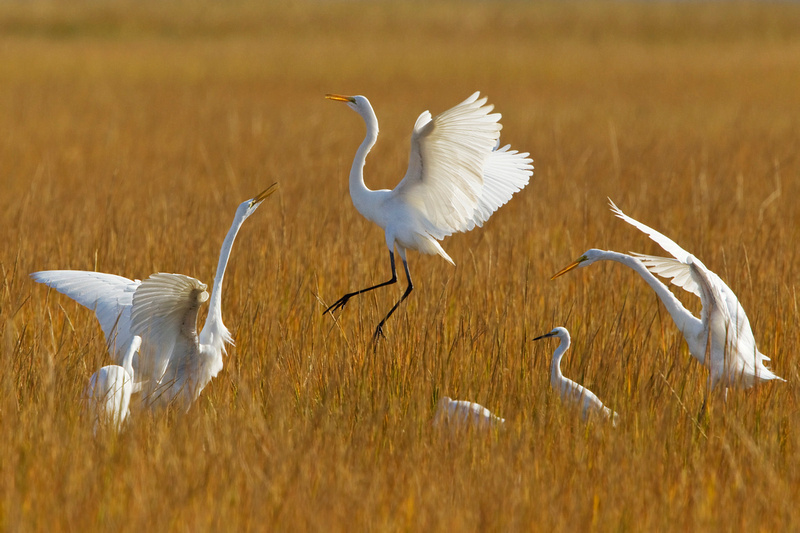
Immature Little Blue Herons usually joined them in the golden grass.
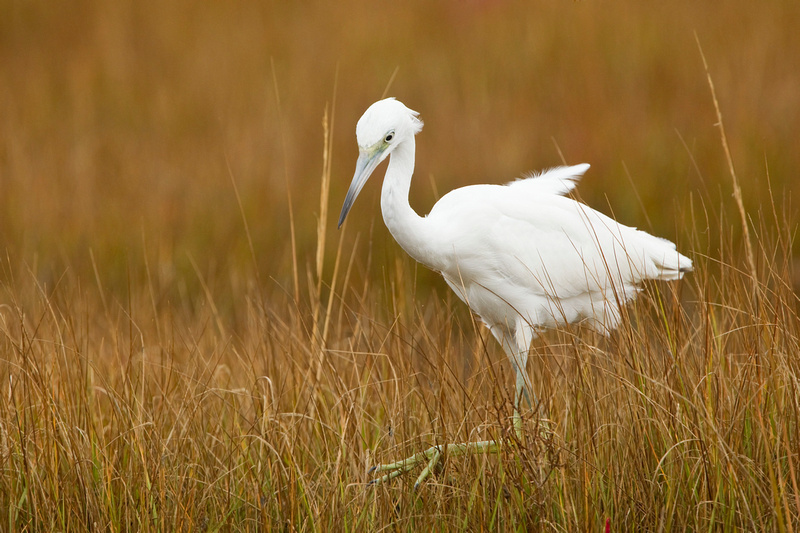
In Old Lyme, a Snowy Egret used a technique I have never seen before. Standing motionless in the shallow water, it seemed to be blowing bubbles or disturbing the surface of the water with its bill. It stayed in this position for more than ten minutes, stabbing into the water twice in the time I watched it, coming up with a small fish on both tries. I'm not sure if the tactic was designed to attract fish to the egret or to obscure the water surface so fish could not see the danger above. Either way, this patient method seemed far less productive than the more active stalking I'm used to seeing them do.
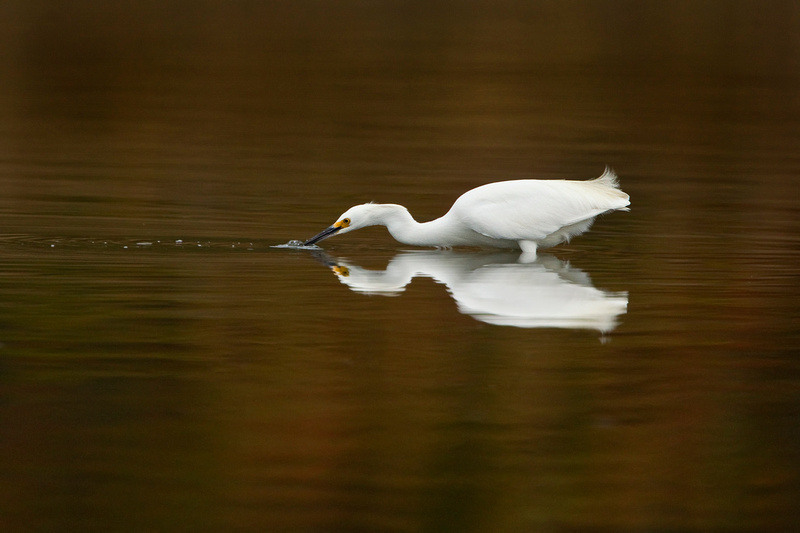
Much was made of the DEEP filling in the potholes in the parking areas at Hammonasset Beach State Park this summer. These holes would fill with rain water and attract shorebirds in fall migration. Well, rain was so scarce the past few months that there were very few puddles to be had, anyway. Shorebirds still pass through Connecticut, but the puddles create easily accessible spots to view and photograph the birds. Without the puddles, birds stay farther out in the marshes, often hidden in the grass. Because of this, I saw and photographed fewer shorebirds this fall than in the past few years. Ironically, my best shorebird sighting of the fall was an Upland Sandpiper at Hammonasset that I photographed standing in one of the hydro seeded "filled in" areas.
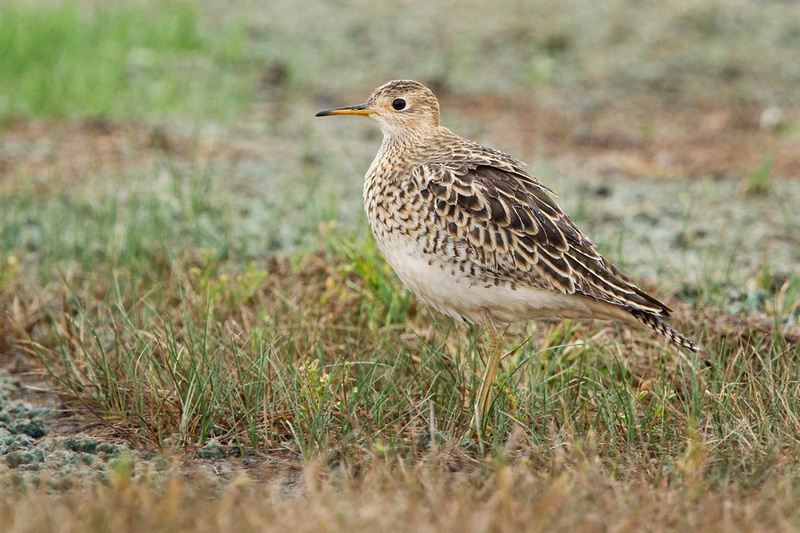
The same evening, there was a Short-billed Dowitcher in a tiny puddle a short distance from the Upland Sandpiper at the bottom of the Nature Center parking area.

As the few puddles quickly dried up, the shorebirds were noticeably fewer (except for the dozens of Killdeer), although a couple American Golden Plovers stayed a few day feeding in the grass parking lots. This sharp looking juvenile seemed very tame, and as a friend and I lay on the ground photographing it one afternoon, it walked past us so close that we couldn't even focus on it.

It turns out there was a plentiful food source in the grass that the plover was feasting on. Grubs.
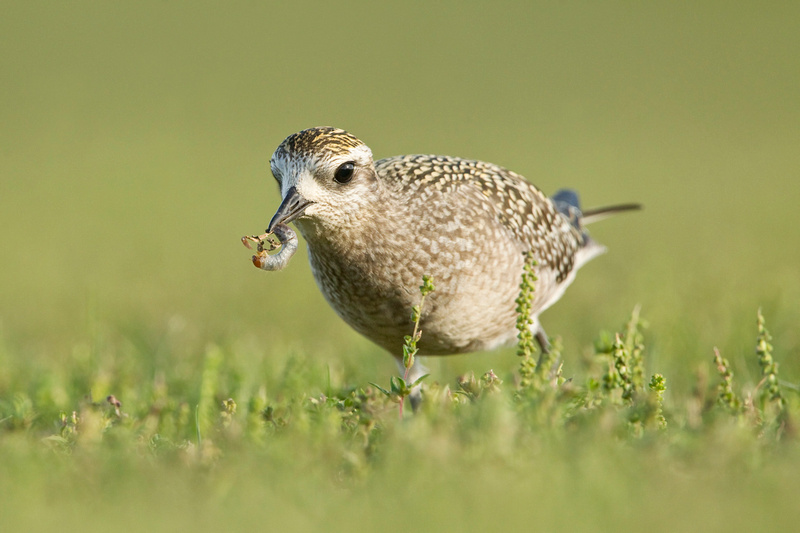
This plover stayed in the same area for a couple days, gorging itself on the plentiful bug banquet. American Golden Plovers breed in the high arctic and winter in central and southern South America. For a bird with one of the longest distance migrations, it's vitally important that they find these productive refueling stops along the way.
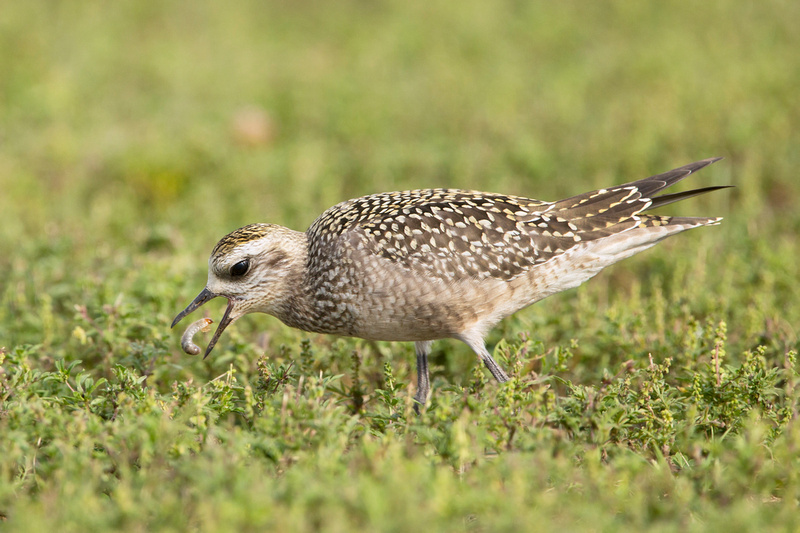
A week later an adult American Golden Plover stopped over for a couple days, this time in the west end of Hammonasset.

Despite the lack of rain, it turned out that a decent variety of shorebirds could be found feeding in the dry grass lots at Hammo, including Pectoral Sandpipers.
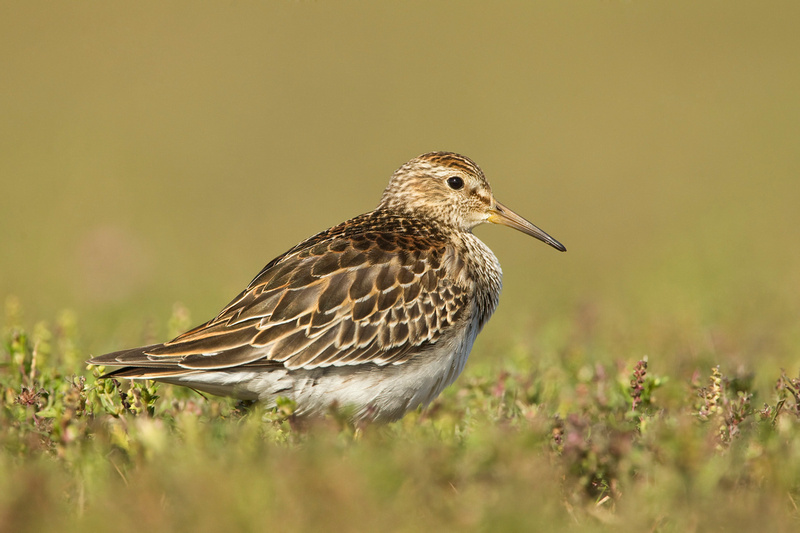
A juvenile (at left) and an adult White-rumped Sandpiper fed in the same area one day, allowing for easy comparative photos.

In tidal pools and pannes, the typical peeps and yellowlegs were plentiful .....
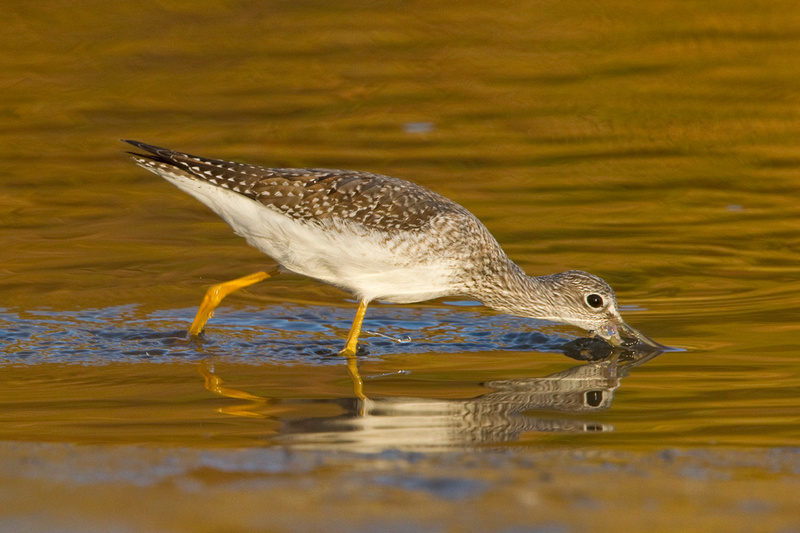
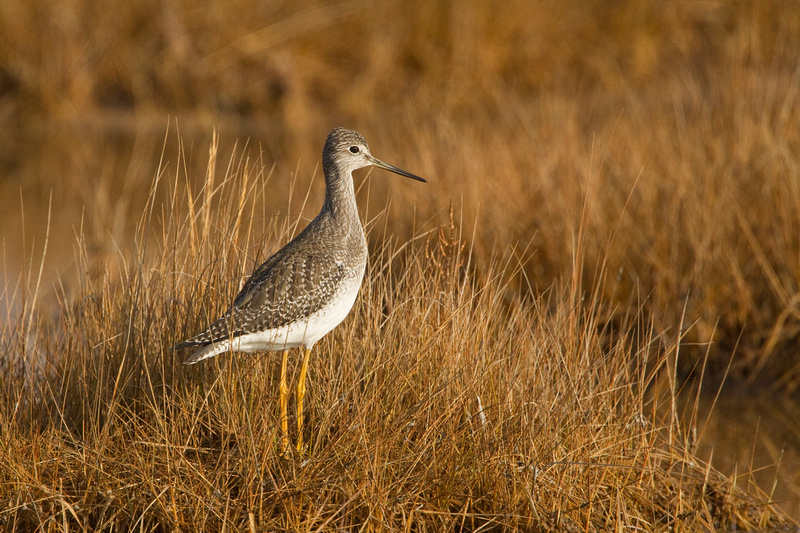
...... but despite searching for it for two days, I missed seeing the Wilson's Phalarope that was hanging out with the yellowlegs at Hammonasset in September.
Hawk watchers in Connecticut have described the raptor migration this year as disappointing, too, at least through mid-October. The lower numbers, I assume, are the result of fewer than normal cold fronts that produce good hawk flights. I've seen all the common migrants this fall, Kestrels, Merlins and Peregrine Falcons and Sharp-shinned and Coopers Hawks, but no unusual sightings. Getting pictures of hawks is always a challenge, but Cooper's Hawks put on a show this fall. The one below was chasing sparrows through the tall weeds at Bauer Park, and after coming up empty, popped up close by me to look for another potential meal.
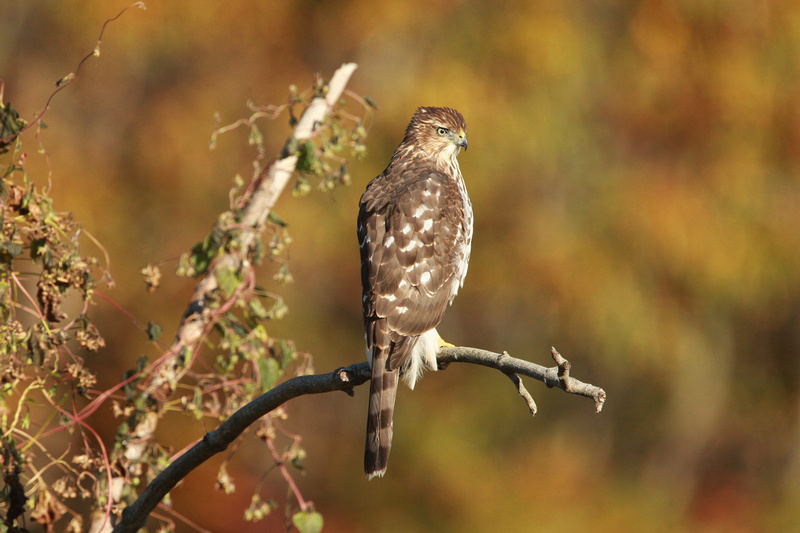
One day at Hammonasset, there were at least three immature Coopers Hawks flying around the west end, playfully jousting with each other and a dozen or so crows. They seemed oblivious of the small group of birders and photographers gathered around to watch them play.
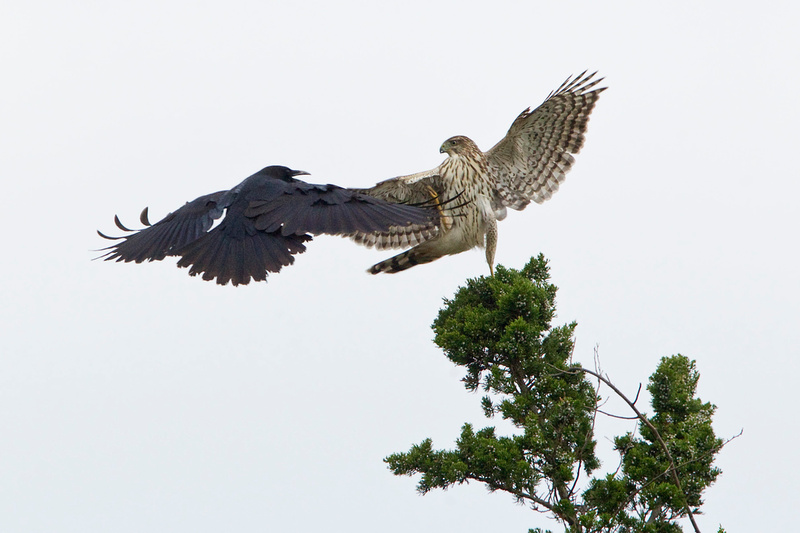
Unfortunately, the beautiful morning light vanished as the sun disappeared behind clouds just in time to put a damper (at least from a visual perspective) on the frolic.

I mentioned in my previous post that I didn't spend any time photographing migrating warblers at Bluff Point State Park this fall, and missed a lot of the warblers I usually see there. This year I tried some different locations for songbirds, seeing a much smaller variety of migrant warblers, but plenty of the common ones, especially Palms and Yellow-rumps.
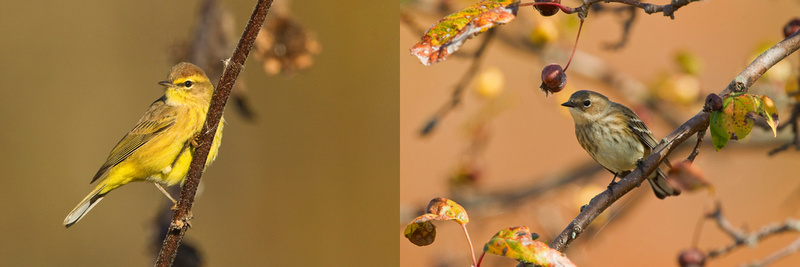
Kinglets, both kinds, have been plentiful this fall, too. Golden-crowned Kinglets often feed by working through the outer branches of cedar trees and often will allow very close approach as they appear totally focused on their task. Despite this, the tiny, fast moving birds are difficult to get good pictures of as they flit from branch to branch, often leaving me with shots of blurry feet and tail feathers exiting the frame. Finally, this year I got a cooperative kinglet. After catching a (relatively) large moth, this Golden-crowned Kinglet moved to an open branch and spent at least a couple minutes in the same spot, working to dispatch it. My favorite picture shows the hairs and dust flying as the bird shook the moth violently to dislodge the wings.
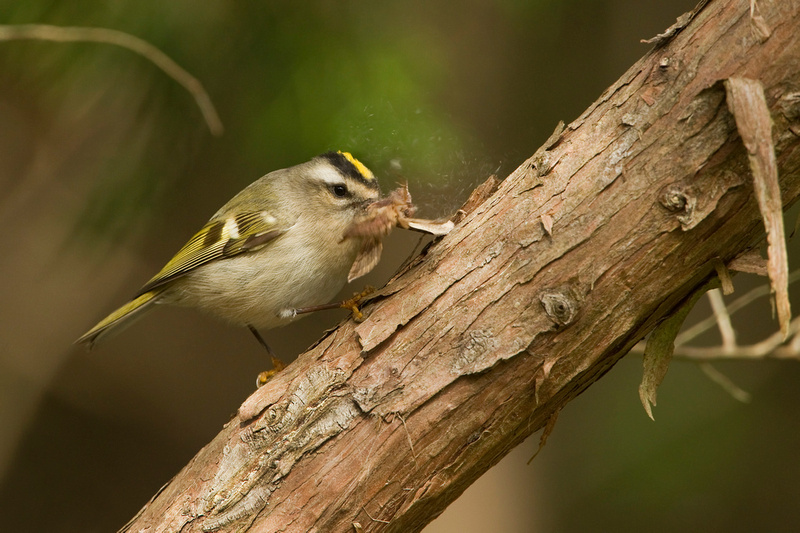
I spent a lot of time this fall working in open and brushy areas. At Harkness Park I got a distant look at a molting Indigo Bunting and was able to see the Blue Grosbeak reported at Bauer Park on a couple different occasions.

Finding the grosbeak, at times, could be quite a challenge, as it fed in the tall weeds. This shot shows how well it blended in with the surroundings.

As October arrived I began to concentrate on the many species of sparrows in transit through the state, some on their way farther south, others arriving to spend the winter. These LBJ's (little brown jobs) are often overlooked (at least by me) so I decided to concentrate on them for a while this fall. It helped that some of the less common ones were being reported from areas close by, including Grasshopper, Lincoln's and Vesper Sparrows form Bauer Park, all of which I was able to find there. Despite carefully studying scores of Chipping Sparrows, I never turned up a Clay-colored. Below is a sample of the different sparrows I was able to see this fall.
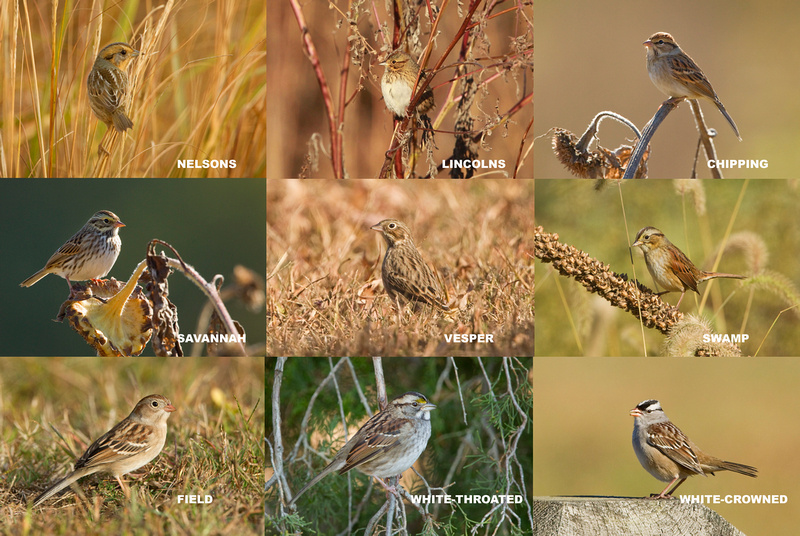
The best sighting I've seen so far this fall was a handsome Lark Sparrow found by a birder in the Hammonasset camp ground. It was feeding in the open grass, in the company of a mixed flock of sparrows, including White-throated, White-crowned, Field, Song, Swamp, and a Vesper.
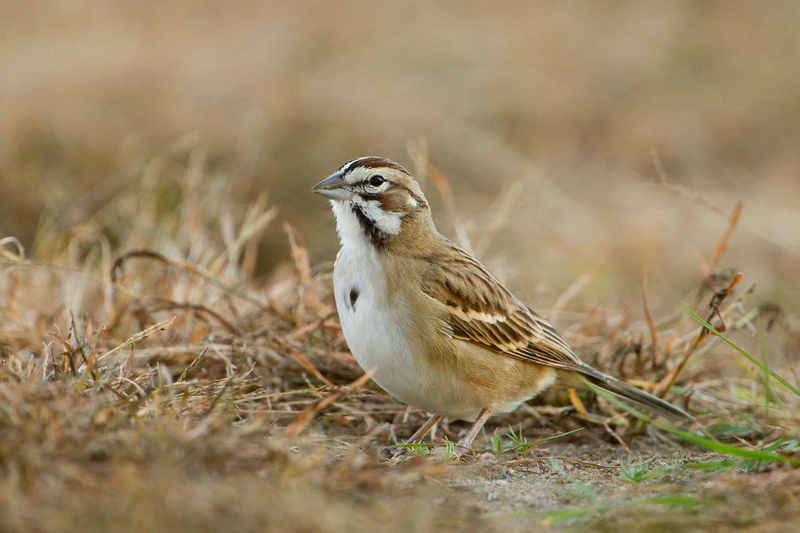
This mainly western species in a great example of the surprises that can show up in Connecticut during fall migration, and what makes it such an exciting time of year. Here's hoping there are a few more surprises to be found before the fall winds down.
]]>
One reason for the shortfall is that a some of the expected, but more difficult to find birds that I have seen in specific locations near my home the past few years, I didn't see this year. Among these are Virginia Rail, Least Bittern, Yellow-crowned Night Heron and Alder Flycatcher. It's pretty likely that I could have found them in other areas, but I decided not to chase them around the state (chalk it up to time constraints and high gas prices). A lackluster fall migration resulted in lower numbers of shorebirds, and I missed seeing Whimbrel, Red Knot and Buff-breasted and Stilt Sandpipers that usually are annual checks and Hudsonian and Marbled Godwit which are a little less regular. I also had bad luck and timing with some of the rarer birds, missing out on Pine Grosbeak, Wilson's Phalarope and a few others that I made the effort to see.
The main reason, by far, for missing out on many birds is the ever present conflict between birding and photographing. For example, I usually visit Bluff Point State Park in Groton several times each year during fall migration when the weather looks promising for the spectacular morning warbler flights. With thousands of birds pouring out of the woods, I'm usually focused on the lower branches for slow moving stragglers that I can photograph. I miss 90 percent of the sightings birders identify with fleeting glimpses as they fly past, but do see some nice birds that linger in the trees although I rarely get any great pictures. This year, I didn't visit Bluff Point at all, opting for greener photographic pastures instead. As a result, I missed seeing Philadelphia Vireo, Tennessee, Nashville and Wilson's Warbler that I see almost every year there. Below is a selection of photographs from past years at Bluff Point.
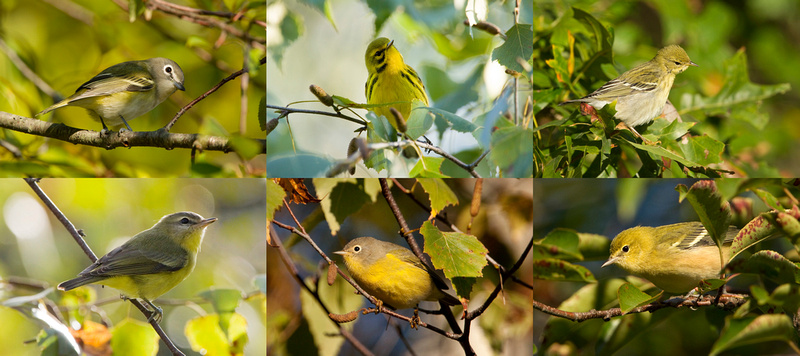
So, on to the positives. I'll try to quickly recap of the first few missing months, starting where I left off. After the rush of spring migration, I usually turn my attention birds breeding in Connecticut, and spend a lot of time in the woods looking for bird nests. It's generally hard work since most birds do their best to keep their nests well hidden, but I usually find a handful each year. Of those, I'm lucky to find one or two that can be photographed without disturbing the nest or surrounding area too much. This is a delicate subject, but I try to be extremely careful and usually pass on any nest that can't be photographed from a distance and without disturbing the birds or the habitat. In March, it looked like my nest finding was off to a good start, when I found a pair of Red-shouldered Hawks building a conspicuous nest near the main road in a busy park.
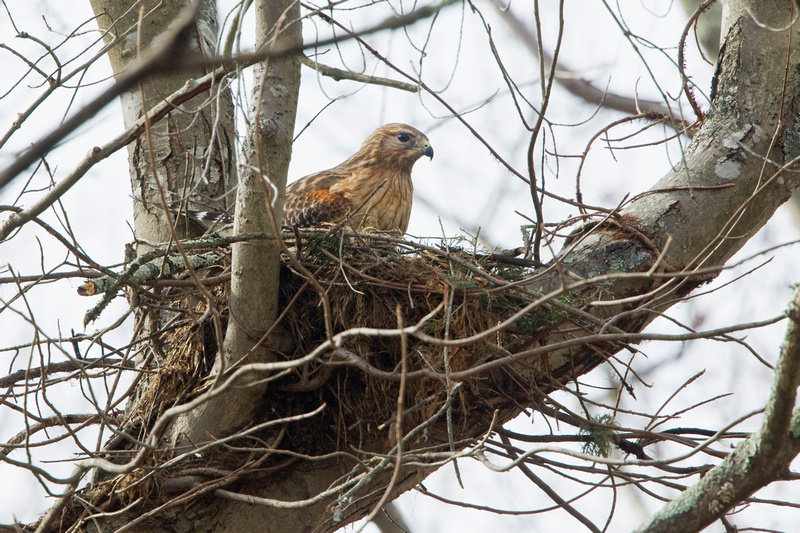
I usually don't photograph birds at their nest until they are feeding chicks, since the risk that they will stay away or abandon is smallest then. But after seeing many walkers staring at the vocal hawks and fearing that the heavy human and dog traffic might force them to move the nest, especially as the weather warmed, I decided to try to get a few shots one morning. I was able to find a fairly clear view from across the road and photographed the male hawk bringing sticks to the nest. One trip it returned to the nest with a frog, then flew back into the woods with it a hundred feet or so and presented to the waiting female before mating with her.
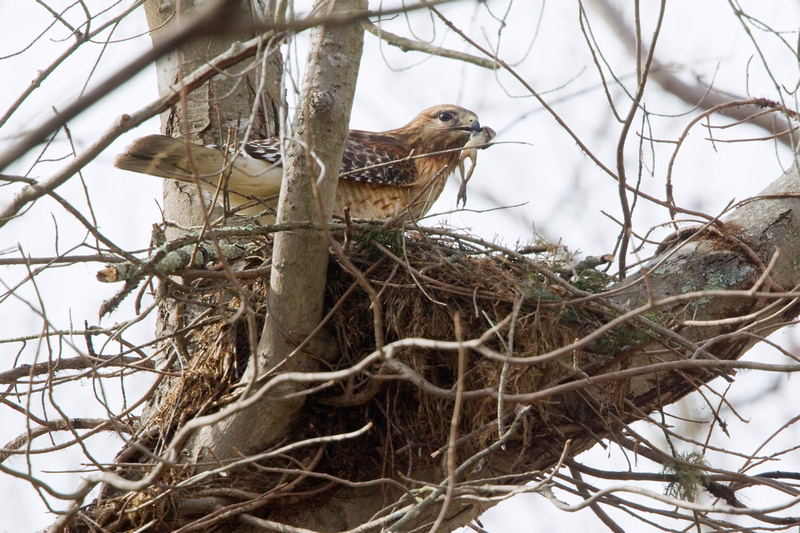
I checked the nest each time I drove past but eventually stopped seeing the hawks there, although I could hear them somewhere near by. I should have guessed that the situation was too good to last. After the trees leafed out the nest was completely obscured by the foliage anyway. In June I found another Red-shouldered Hawk nest in Lyme in a much taller tree, and was only able to find a narrow window where two of the three chicks were visible.
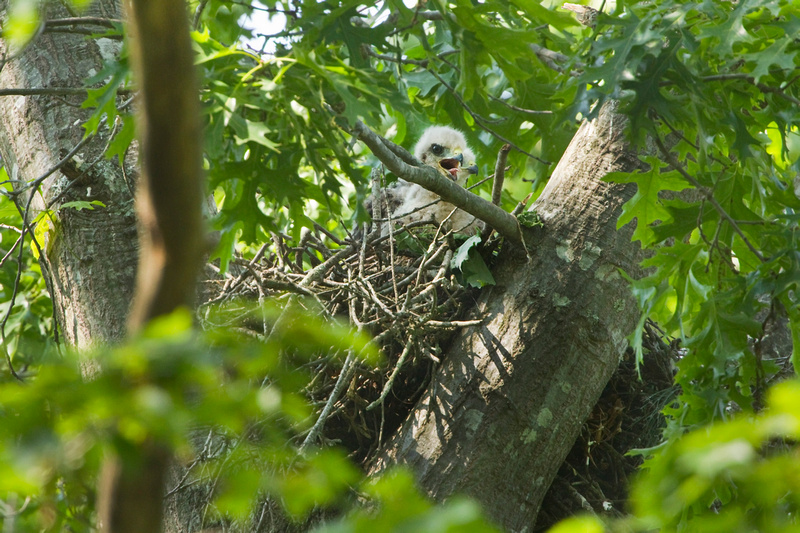
It turned out that I didn't have too much luck finding nests this season, and didn't find a single songbird nest in the woods. I did find a few nests in open marsh areas including a Marsh Wren nest, a huge tube of woven reeds, that I decided I couldn't photograph without impact. I did photograph a Red-winged Blackbird nest in a cattail marsh.
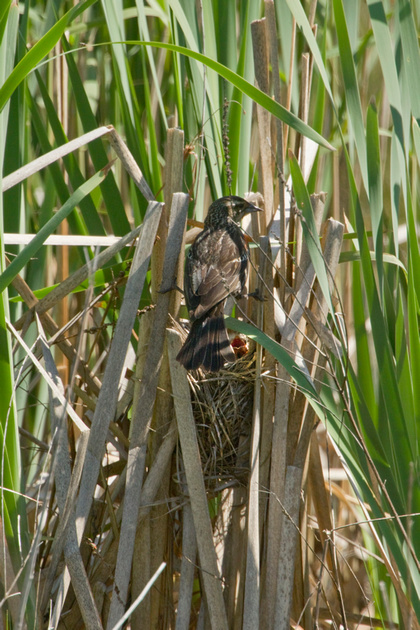
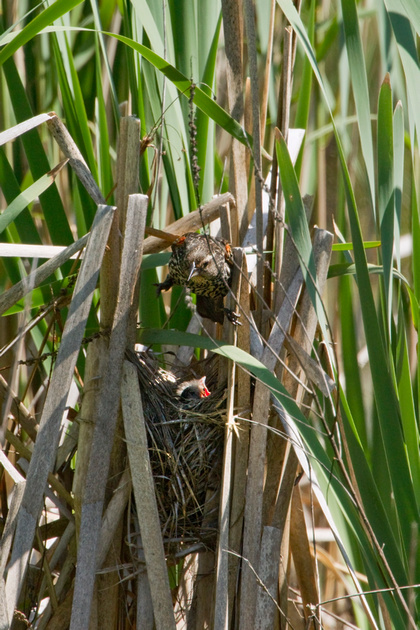
... and a very low hanging Baltimore Oriole nest in a short tree growing in another marsh. While the nest looked very promising, the orioles always took a back door route into the nest, limiting the picture possibilities.
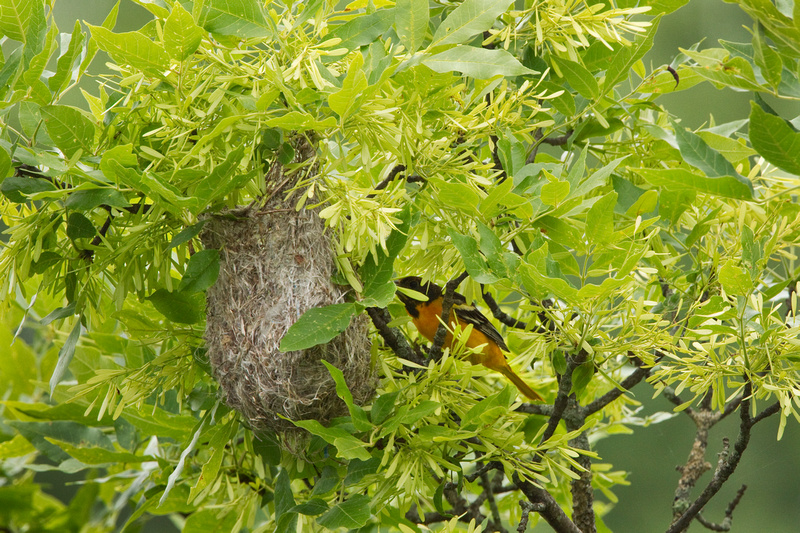
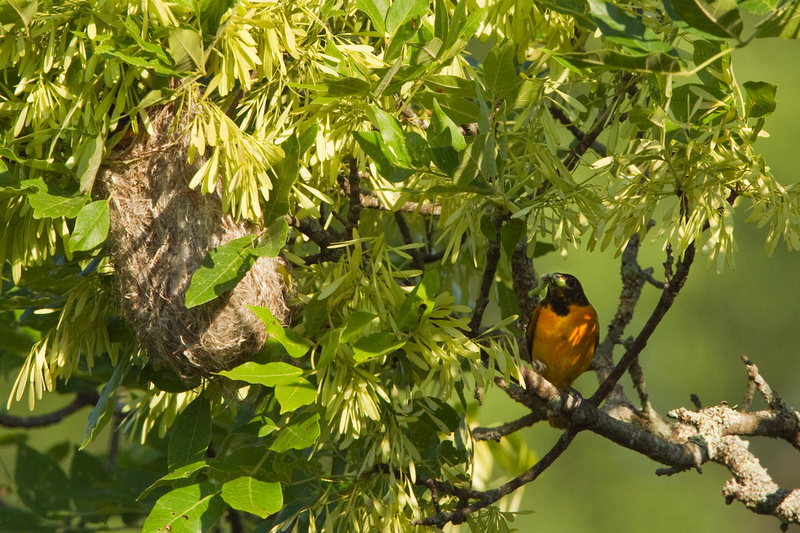
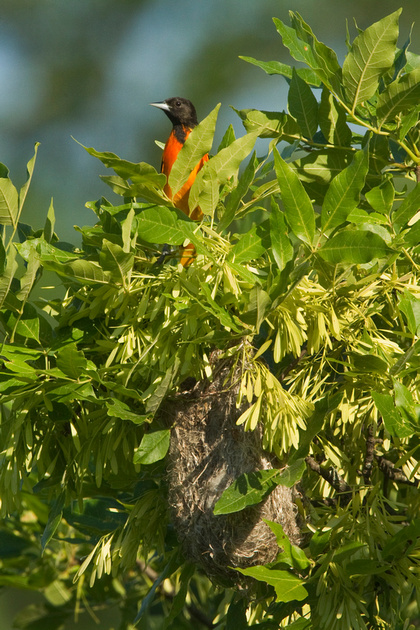
Looking to work on areas of different habitat, I went the northwestern part of the state looking for grassland birds, and was able to find some Bobolinks near their nesting area.
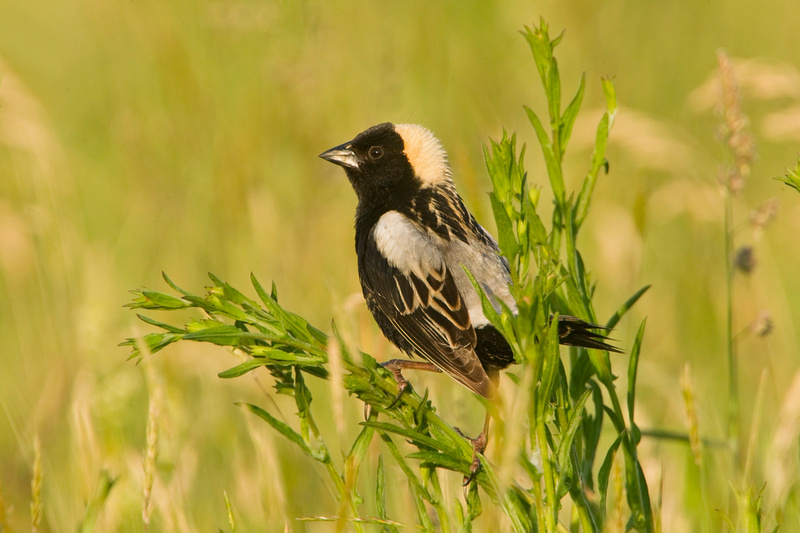
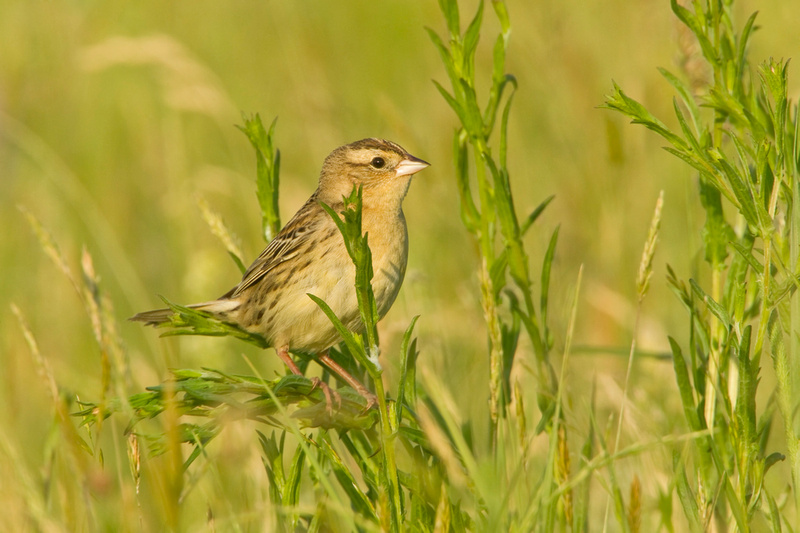

I also found Cliff Swallows flocking to the same small puddle to collect mud to build their nests under a nearby bridge.

Most of the birds got along just fine, but occasionally a skirmish broke out .....
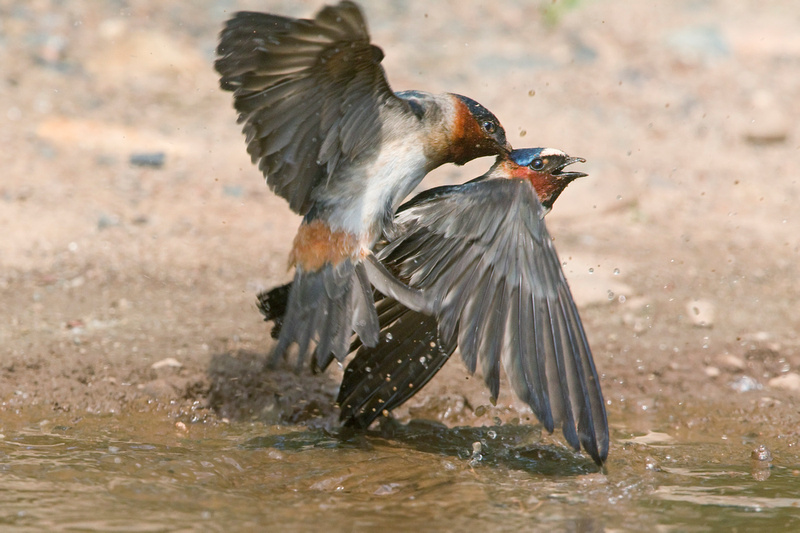
..... resulting in swallow mud wrestling matches.
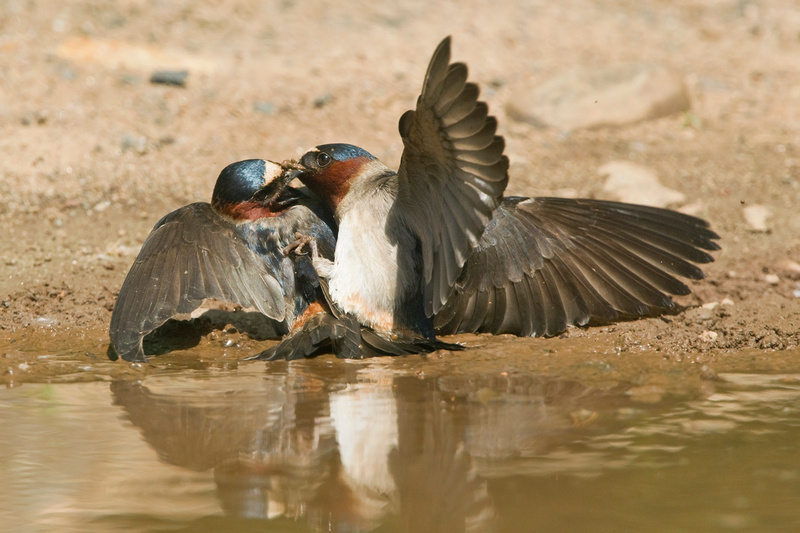
Closer to home, I spent some time checking the shoreline for birds nesting in the salt marshes. It seemed that fewer Osprey nests had chicks this year, or were well behind their normal schedule. Many platforms were damaged by the hurricane last October, and I saw many Osprey still carrying sticks to their nest well into July. Perhaps that affected their nesting schedule this summer? I saw a lot of Willets, often chasing around the marsh in noisy flocks, but did not see any chicks this year.

It was reported to be a down year in Connecticut for nesting terns, so I decided to visit a large skimmer and tern colony in Long Island. There were many American Oystercatchers, Black Skimmers and Common Terns still feeding chicks well into August and the beach goers, birds and birders all seem to get along pretty well there.
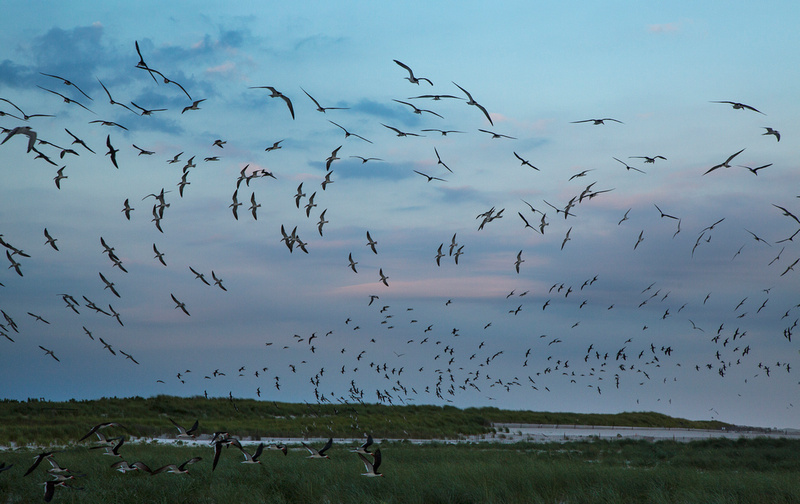



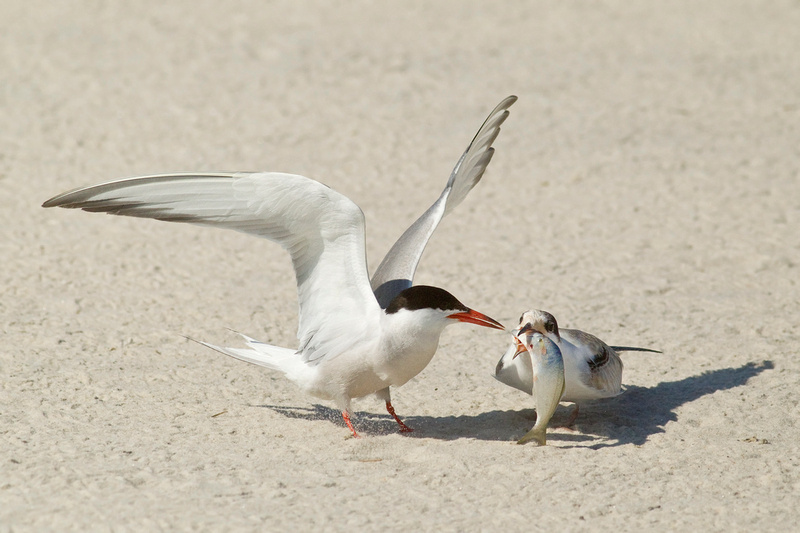

juvenile Common Tern (above)
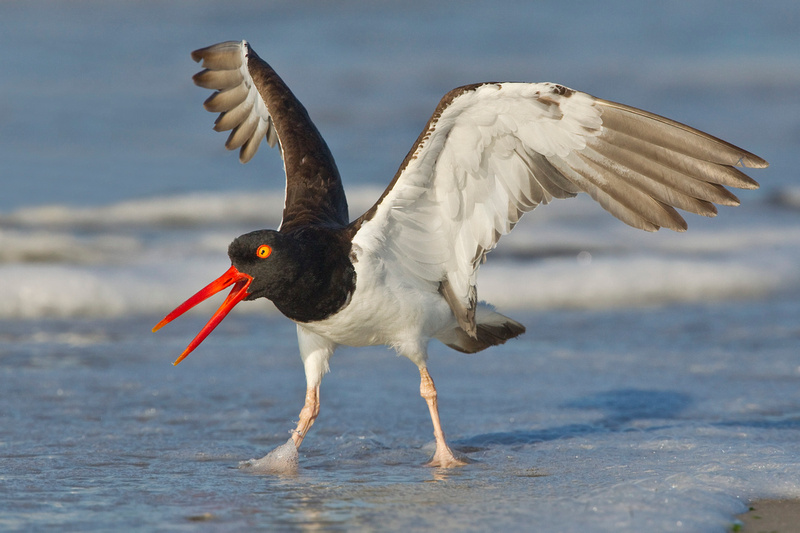
 American Oystercatcher adult (left) with juvenile.
American Oystercatcher adult (left) with juvenile.
So after wading through the thousands of pictures from the trip to Long Island and catching up on the stuff shot earlier in the summer, it was about time for fall migration to kick into full swing.
]]>
It's an Empidonax flycatcher that I thought was a Willow Flycatcher when I saw it, perhaps because they are resident birds, commonly seen and heard there in the spring and summer. The problem is that it wasn't singing, and I was busy trying to photograph it so I didn't study the details (not that I would be confident identifying it based on sight alone anyway). After reviewing the following two marginal images, I'm not sure the bird was a Willow Flycatcher. 
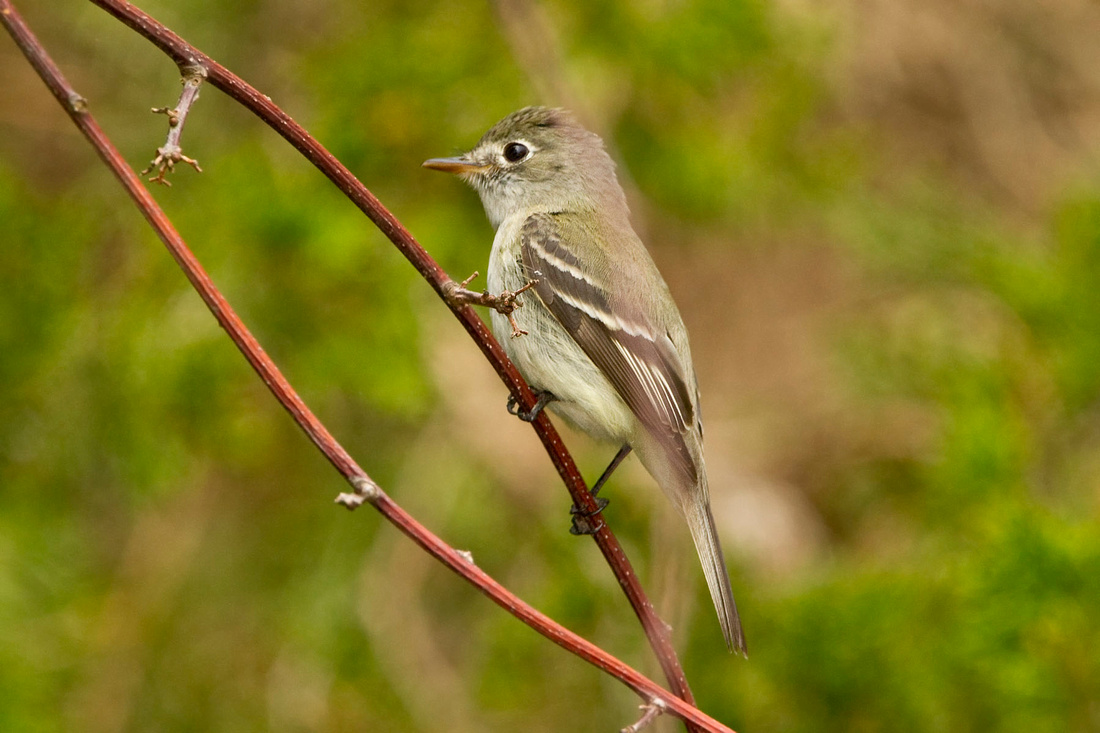
The bird in the picture has a brighter and more prominent eye-ring than Willow Flycatchers are supposed to. Based on field guide descriptions of the eye-ring, head shape and wing projection, I think Acadian Flycatcher can be eliminated. It looks a bit too elongated, with a longer bill than a Least Flycatcher, which leaves the Willow /Alder (virtually identical) Traill's Flycatcher conundrum. If anyone feels more confident calling it or has a better educated guess than I do, please let me know.
Here are some reference shots of the four species;
Acadian Flycatcher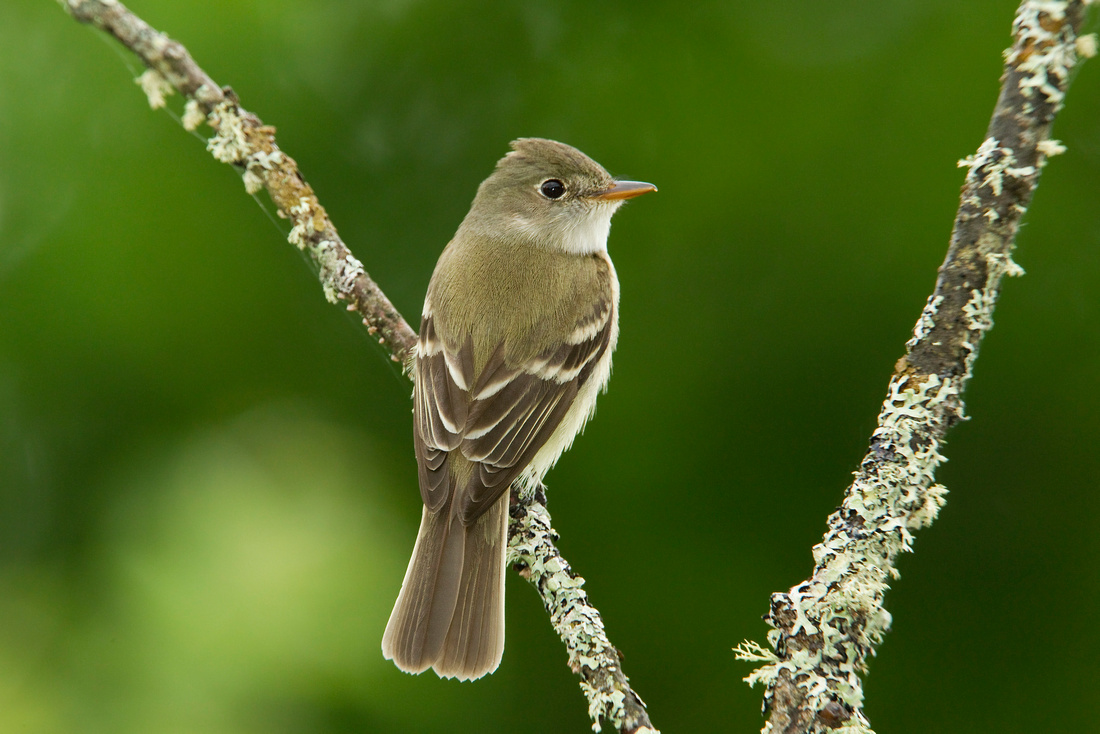
Alder Flycatcher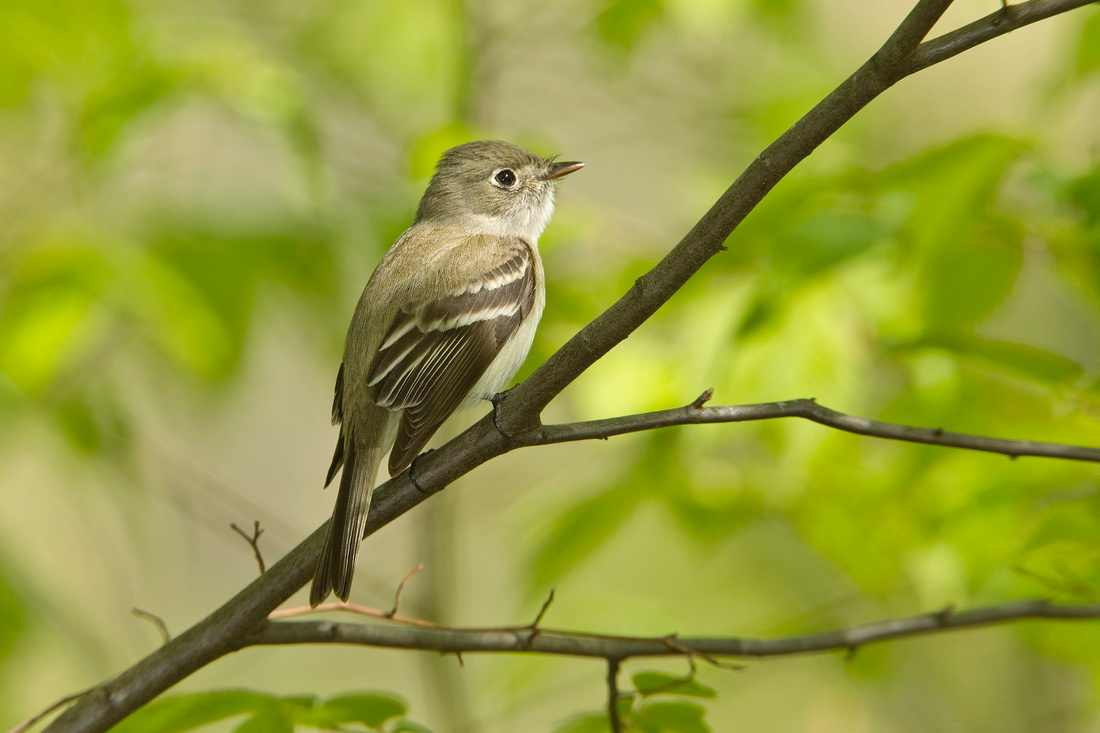
Least Flycatcher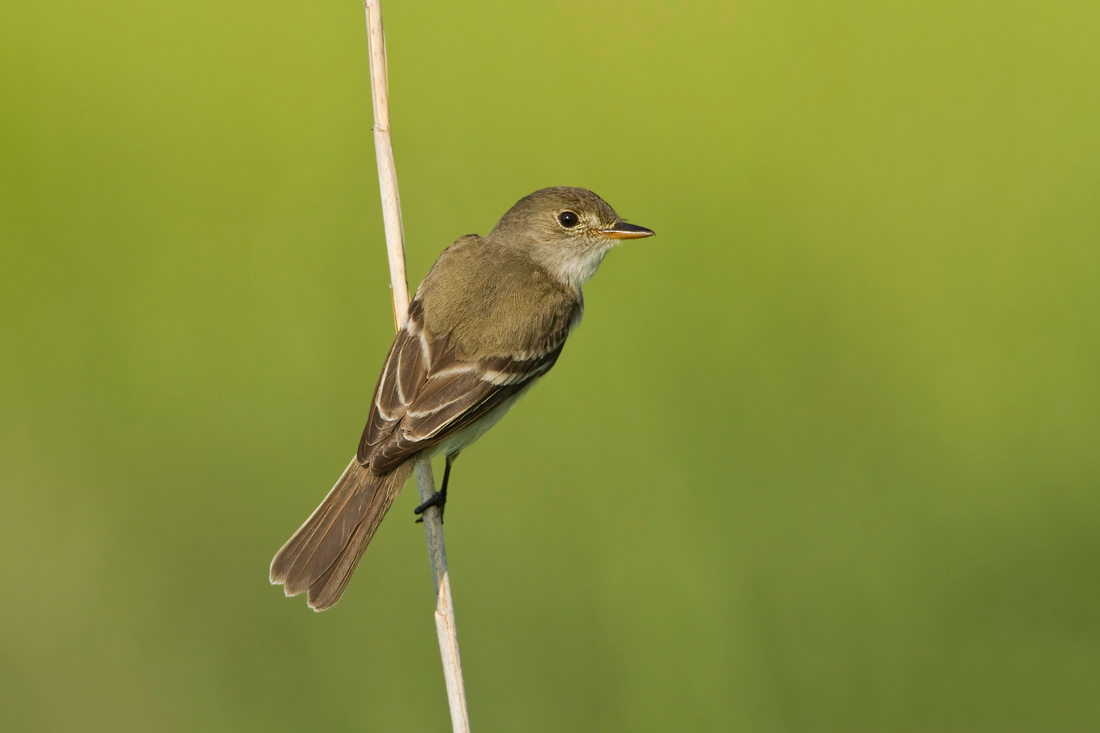
Willow Flycatcher
]]>
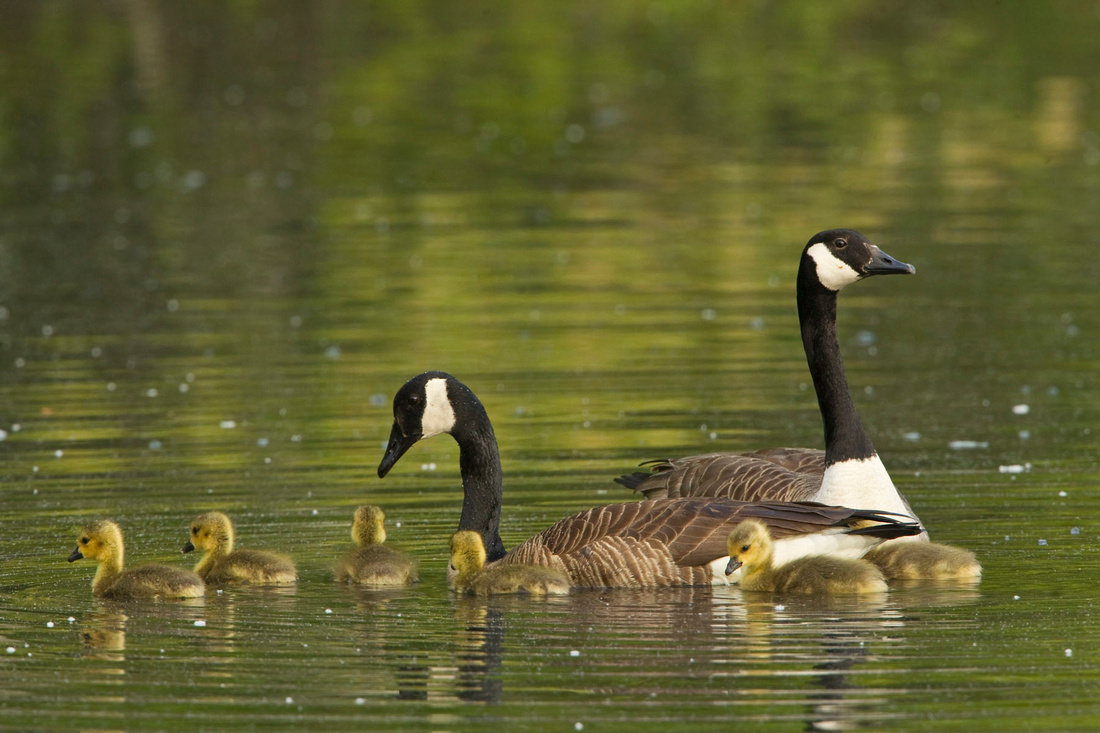
Weather-wise, there has been little rain this month, until the last few days, so there's always a draw to go out and photograph, to make hay while the sun shines. As I wrote in my last post, there are plenty of summer residents to capture as they return and set up territories to nest in different habitats. But one of the big draws of this time of year is to catch the migrants passing through on their way farther north, especially if you're hoping to see as many different species as you can. For much of early May, the weather was not great for migrating birds and some birders were saying it was the worst spring migration they had seen. I had not seen many migrants in the woods around southeastern Connecticut either, but a break in the weather pattern (away from the easterly flow) opened the flood gates and migrant songbirds finally began pouring into the state. Most of the big sightings were from New Haven west, but on May 16 at Hammonasset Beach State Park, I finally caught a good fallout day. I recorded 61 different species in one morning including a dozen different kinds of warblers foraging in the trees on Willard's Island.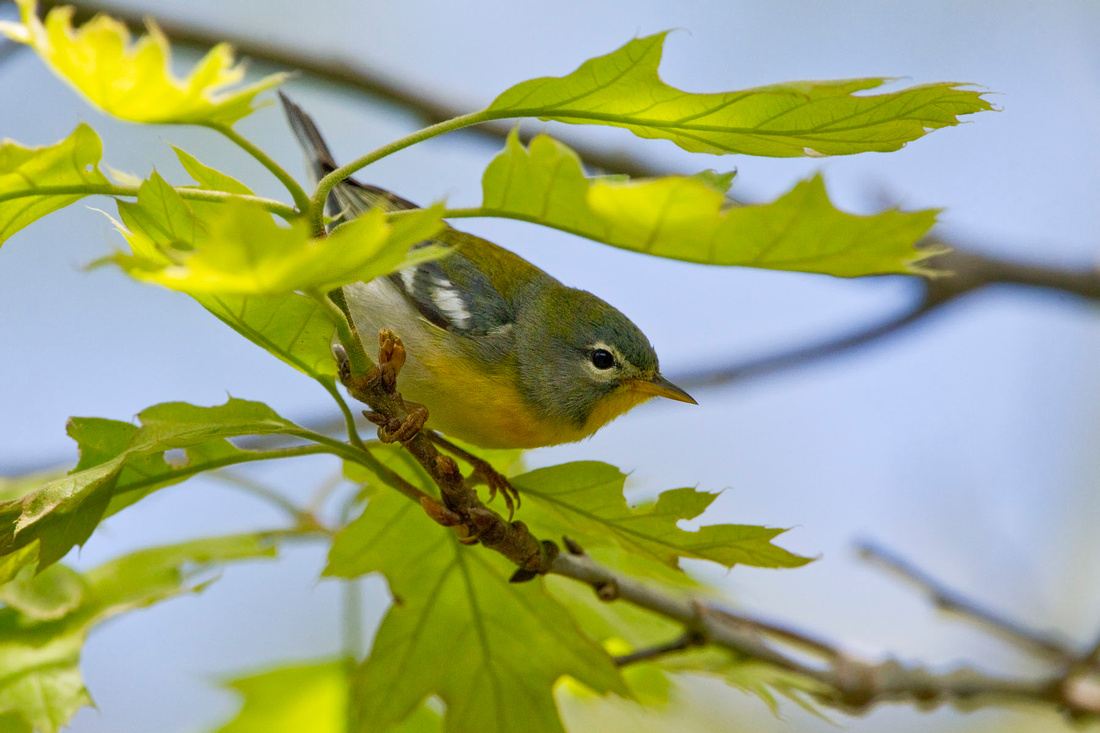
Many of these were migrants, passing through Connecticut on their way to nesting grounds in northern New England or Canada. Among them were many Northern Parulas (above), Blackburnian, Black-throated Blue, Canada, and Chestnut-sided Warblers. Most were foraging high in the trees, and were difficult to photograph, but it was great fun seeing so many different species and so much activity. As the morning wore on, some birds came down to feed in the lower cedar trees and provided a chance for some better photos. Most were Magnolia Warblers (2 below) that moved through the dense branches mercurially, and could pop out close by at any moment.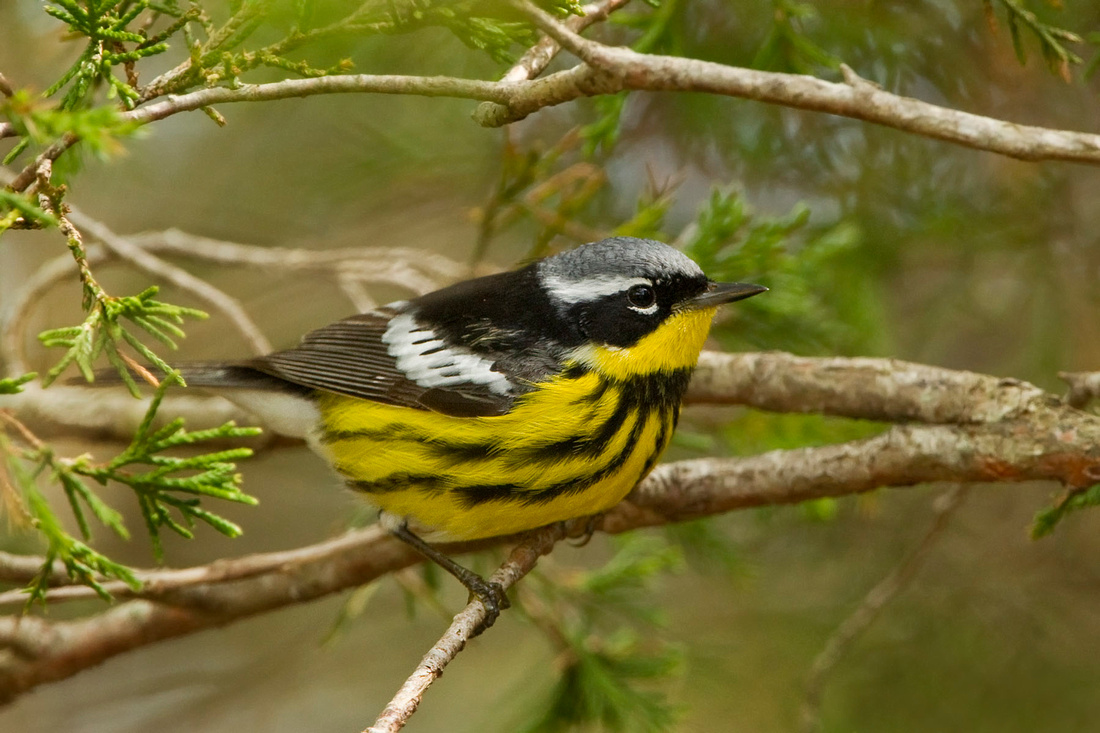
The trick was to be pointed in the right direction and prepared to get them before they flitted away to the next branch.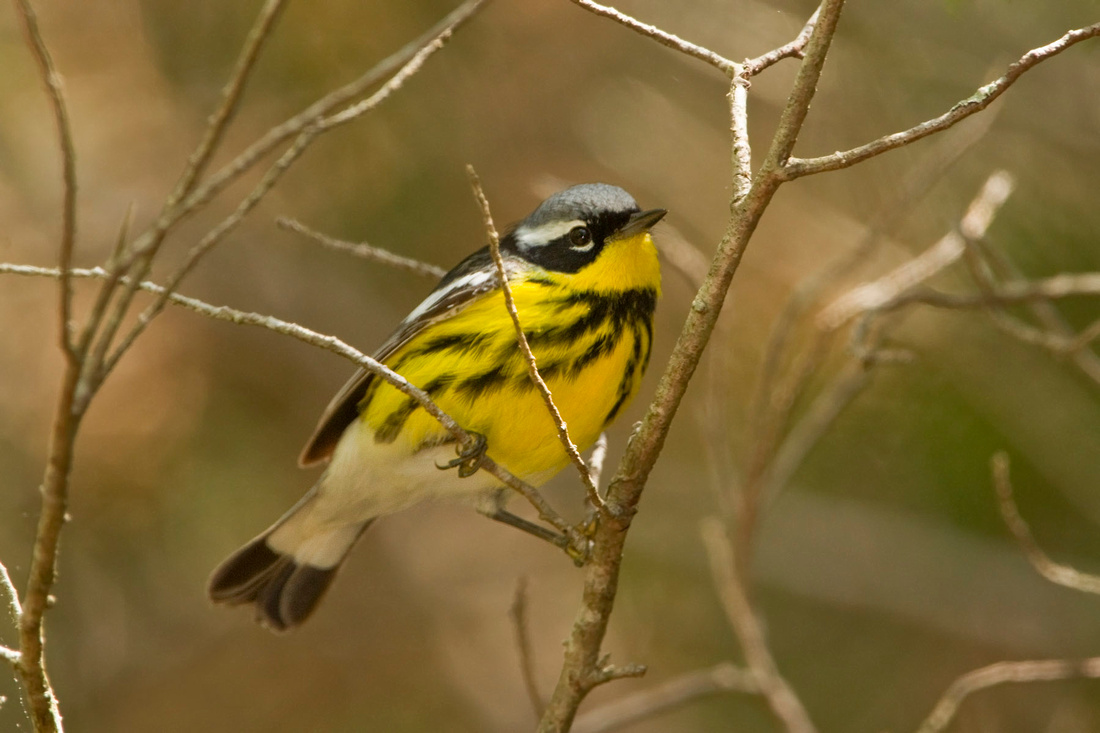 The highlight of the morning was seeing the lone Bay-breasted Warbler (below) that was found. Spotted earlier in the morning by other birders, I saw it briefly in a cedar tree a while later, before it disappeared again. A short time later it was spotted again by Shirley and Charlie Rafford, as it worked its way methodically through a cedar branch along the pathway, and I was able to get a couple of record shots.
The highlight of the morning was seeing the lone Bay-breasted Warbler (below) that was found. Spotted earlier in the morning by other birders, I saw it briefly in a cedar tree a while later, before it disappeared again. A short time later it was spotted again by Shirley and Charlie Rafford, as it worked its way methodically through a cedar branch along the pathway, and I was able to get a couple of record shots.
Along with the migrant warblers, there were the omnipresent Common Yellowthroats and Yellow Warblers (below).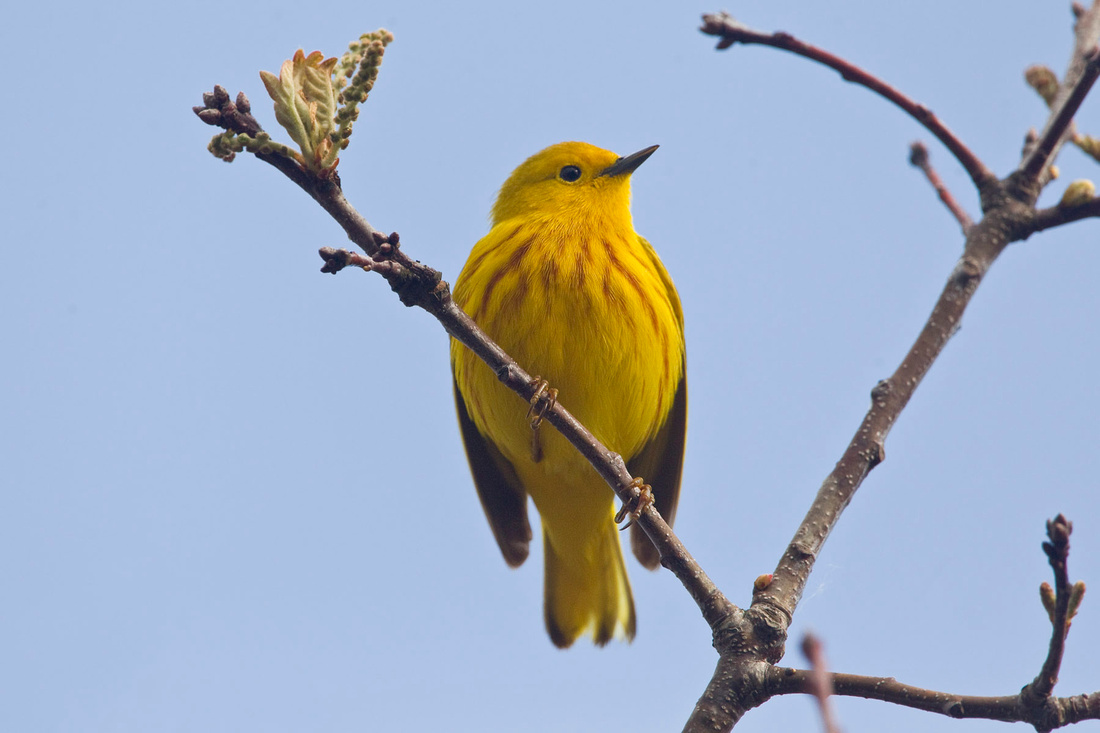
In the Hammonasset salt marshes, Willow Flycatchers, Marsh Wrens, Seaside and Saltmarsh Sparrows returned to their nesting territories. I spent some time photographing the herons and egrets because I usually don't visit the park for the rest of the summer after Memorial Day. A Little Blue Heron (below) put on a show, preening and ruffling its feathers,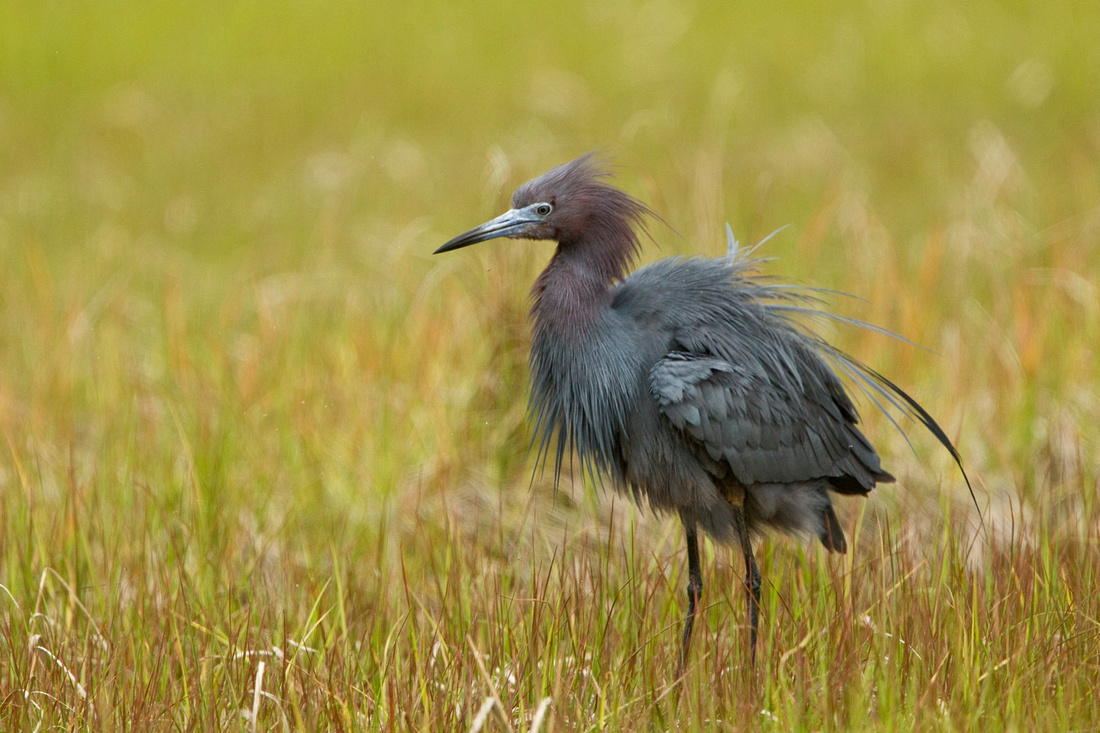
and then doing this weird gagging thing.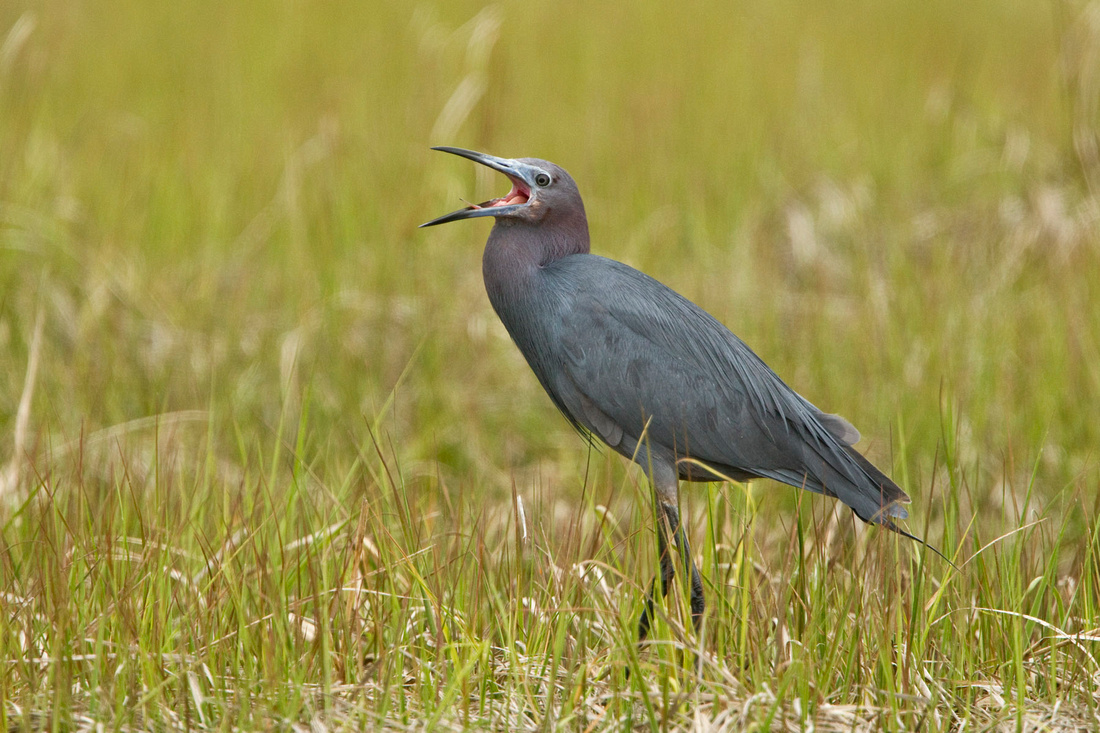
Nearby a Great Egret, patiently working a productive fishing spot, found itself repeatedly targeted by a Red-winged Blackbird. Perhaps it had strayed into the blackbird's nesting area.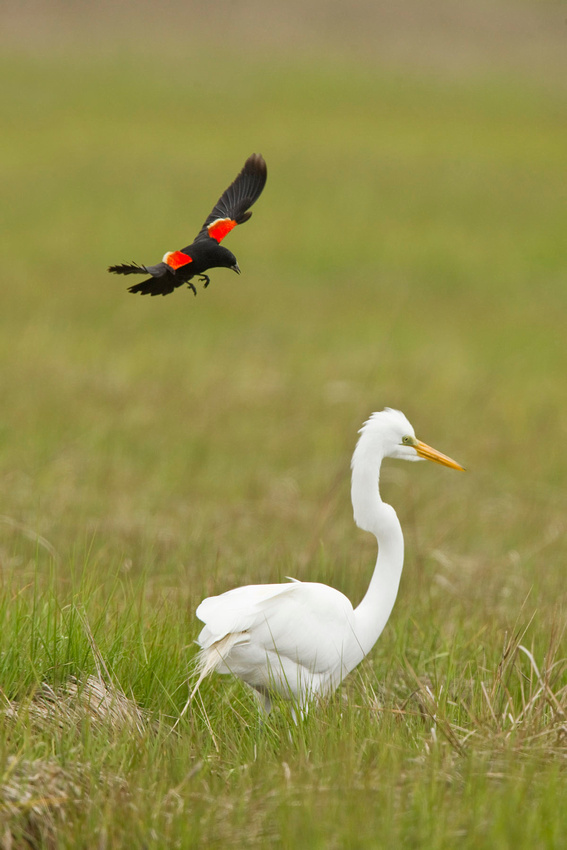
Another wading bird I wanted to see was the Cattle Egret spotted at the pond behind Cabela's in East Hartford. I missed the one seen in Portland earlier this spring. I drove up there early on a Saturday morning and could not find the egret. I went to look for Upland Sandpipers and Grasshopper Sparrows in the runway field, but before I could spot them the Cattle Egret flew in right past me and landed at the edge of the pond. I got a few backlit shots of the striking bird before it flew to the back edge of the pond.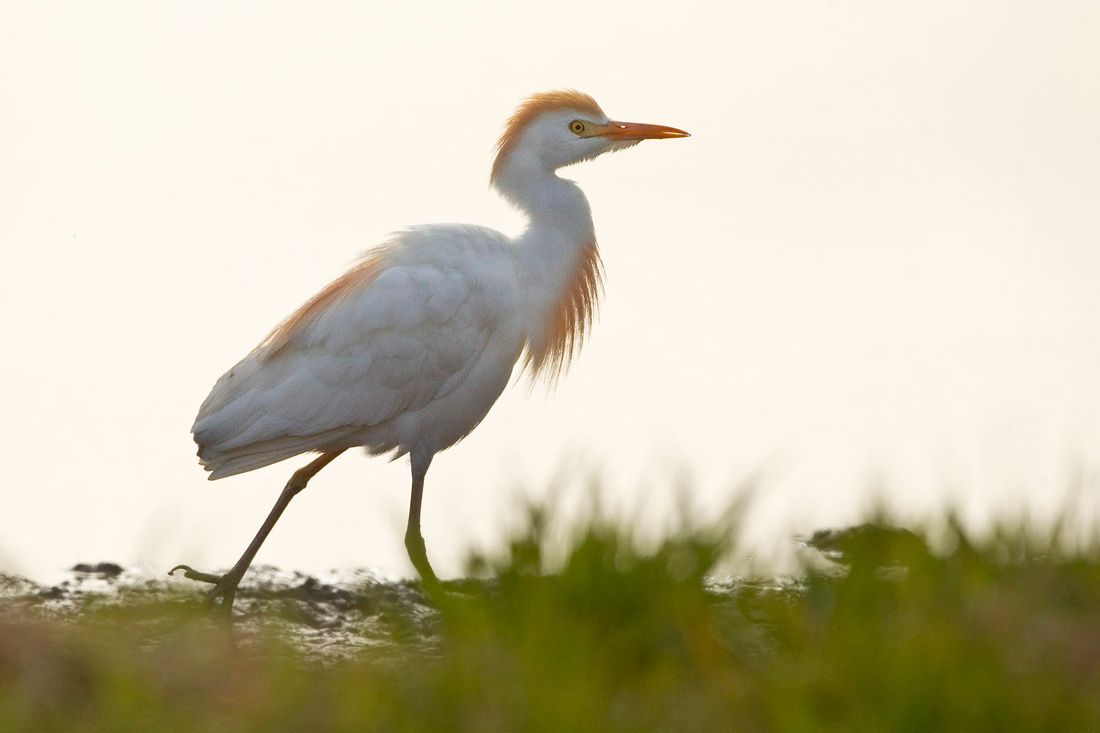
I went back and spent an hour searching the fields, seeing several Grasshopper Sparrows, Savannah Sparrows, Eastern Meadowlarks, a Bobolink and finally a distant and somewhat unsatisfying look at two Upland Sandpipers. The trip was a productive one though, as I saw four new species for the year. Before leaving, I stopped for one last look at the Cattle Egret and saw it emerge from the grass mound behind the pond with a vole, which it took a few minutes to gulp down.
The rest of the last two weeks I have been working to capture as many of the resident birds as I can, visiting a variety of different habitats for different subjects. In a cool Hemlock stand, I photographed Black-throated Green Warblers, (2 below)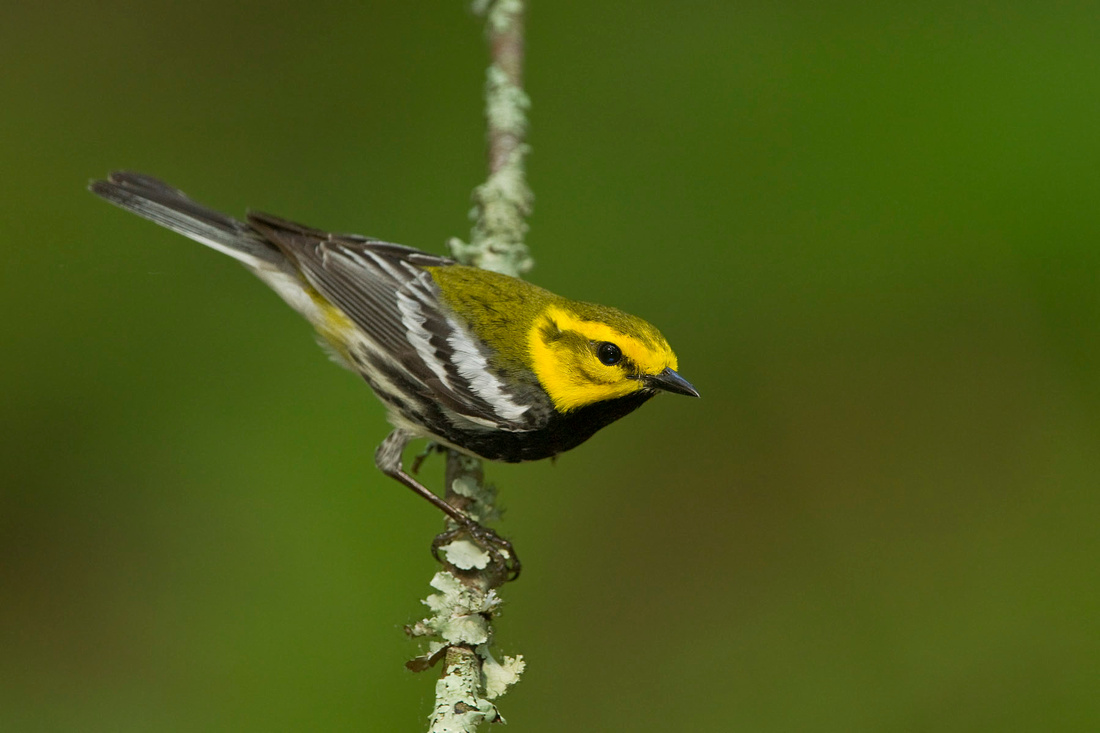
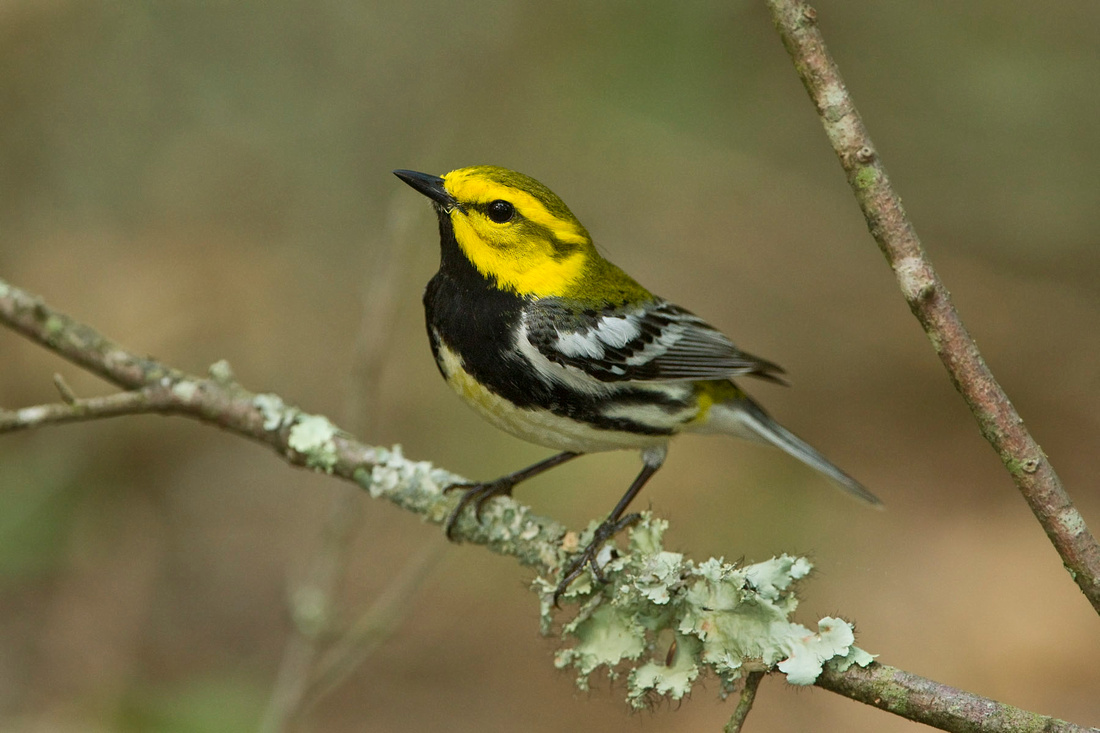
In deciduous woodlands, a brilliant Scarlet Tanager,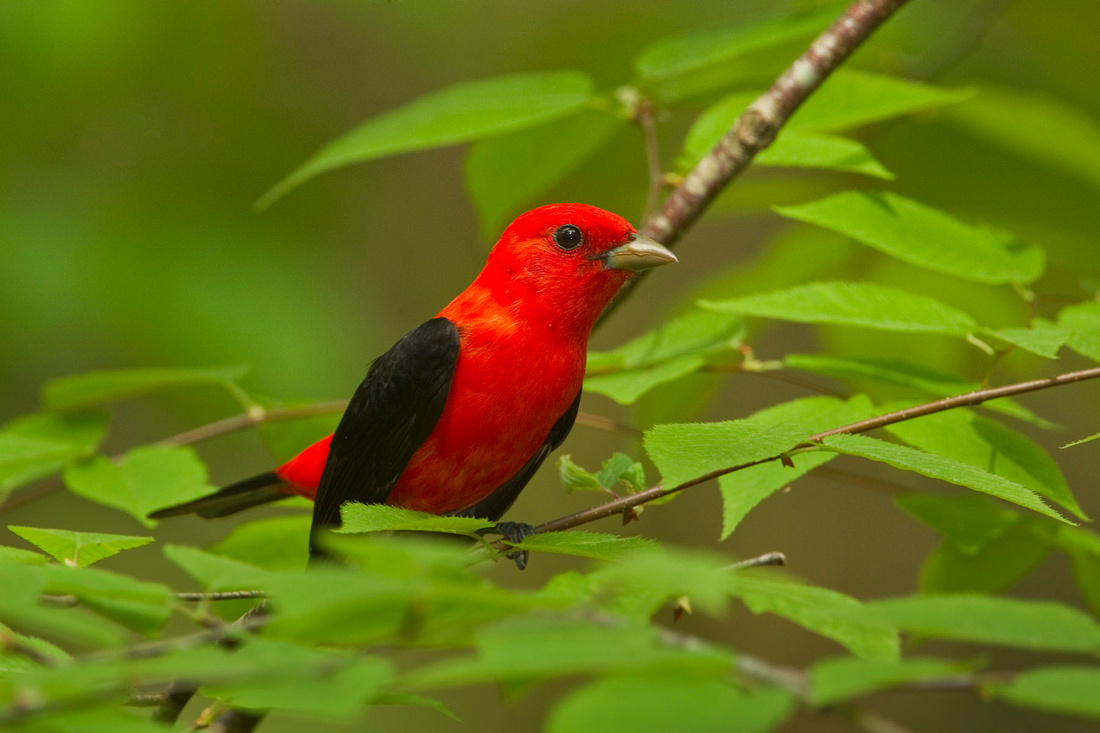 and very vocal Red-eyed Vireos (2 below),
and very vocal Red-eyed Vireos (2 below),
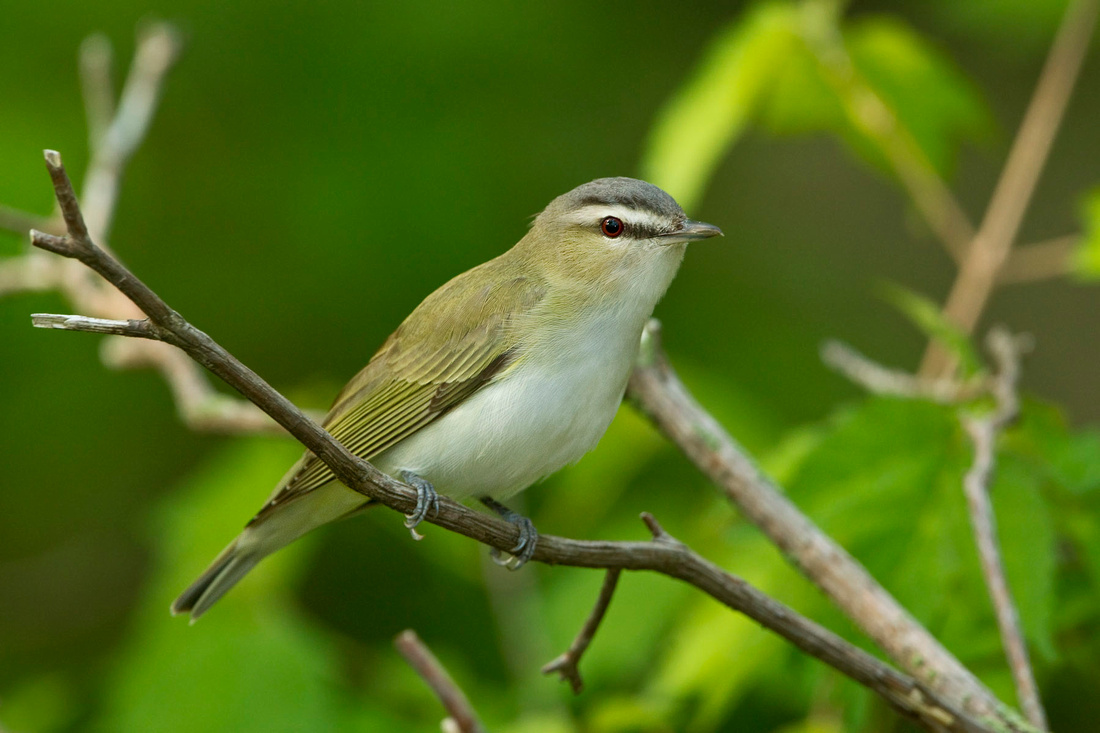
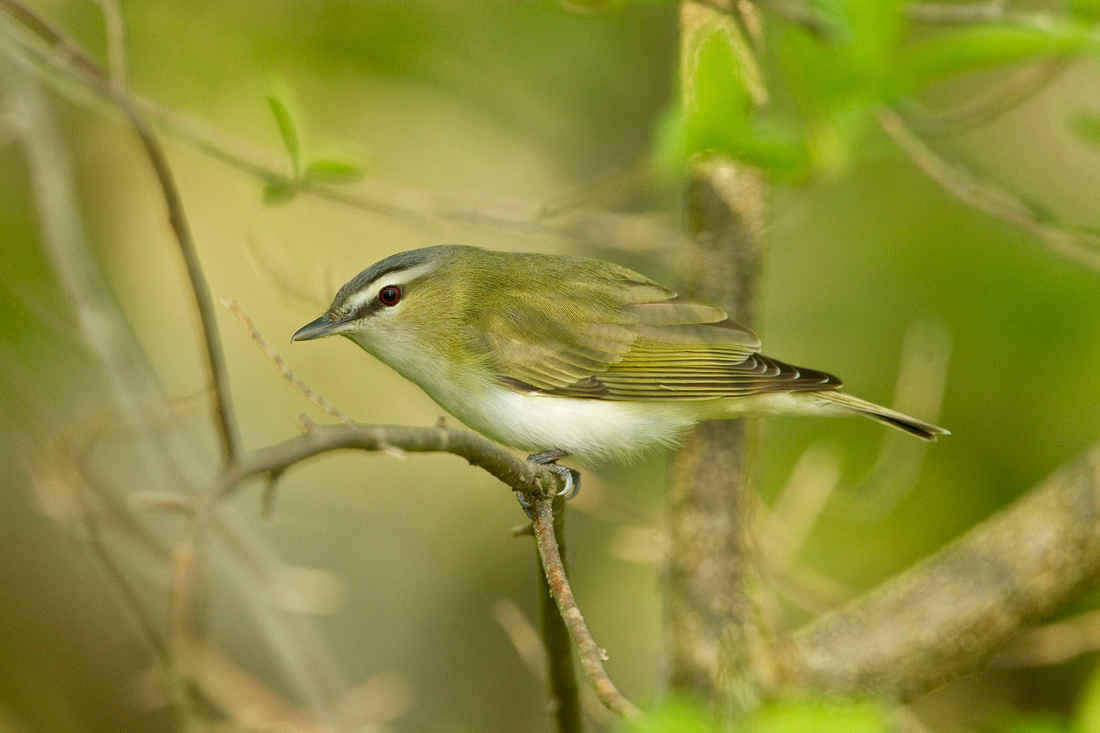
and Yellow-throated Vireos (2 below).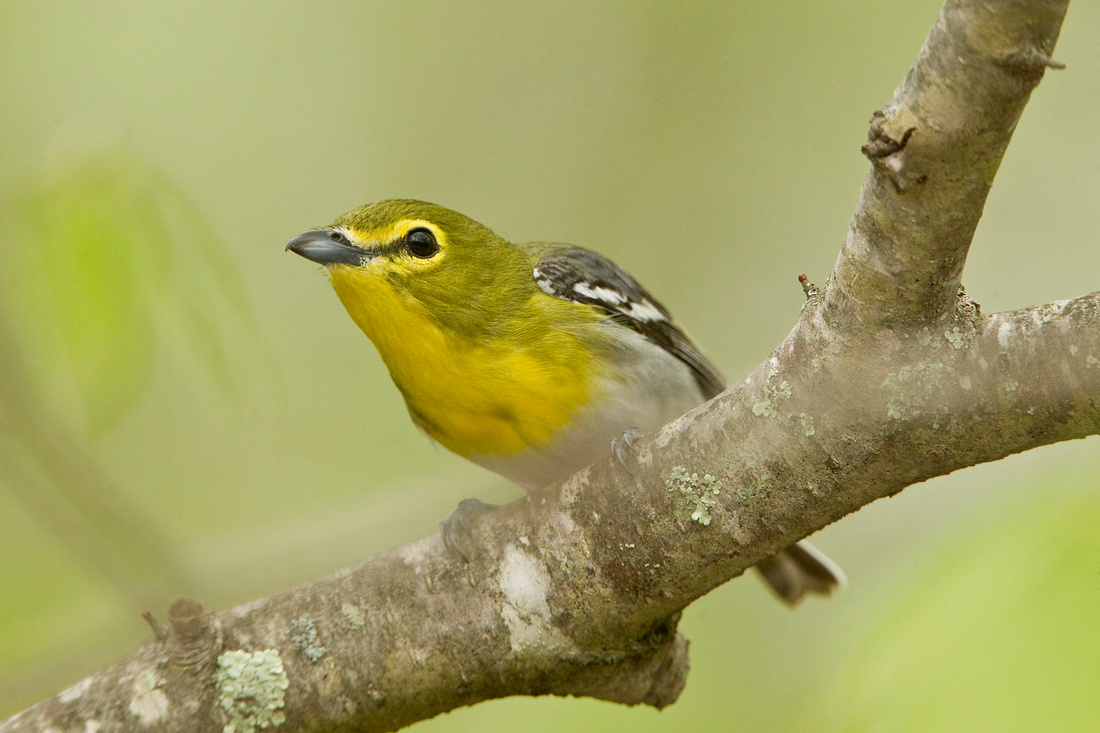

In brushy open areas, a White-eyed Vireo,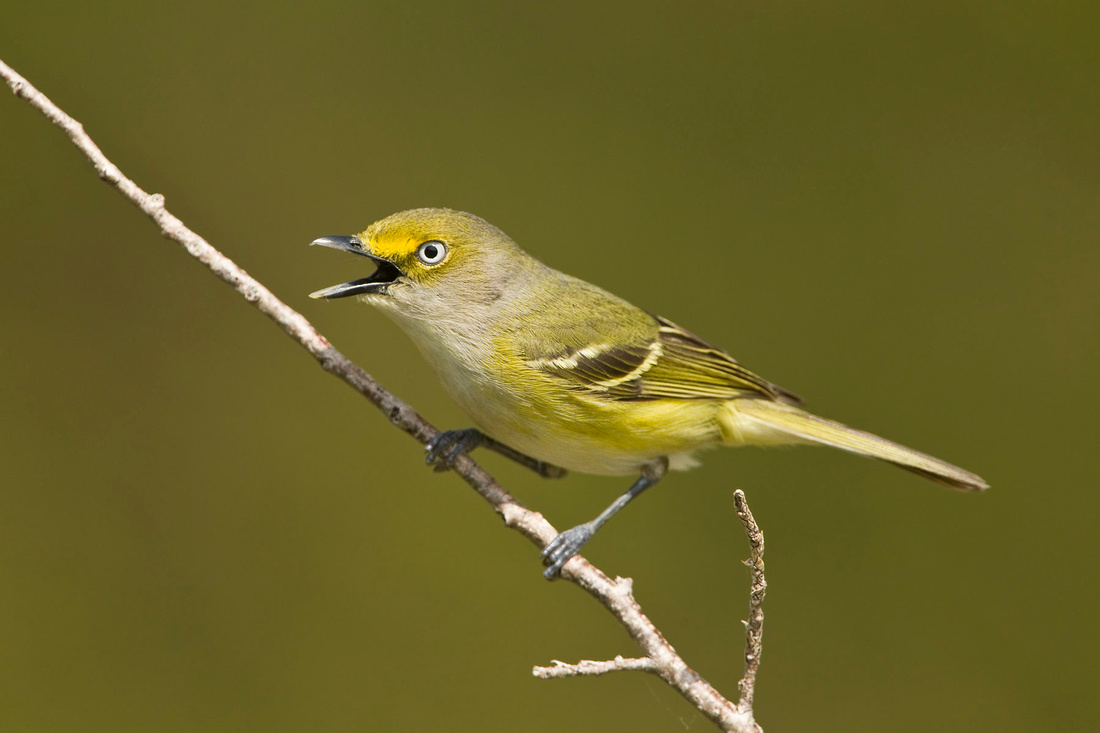
a Prairie Warbler Yellow Warbler,
Yellow Warbler,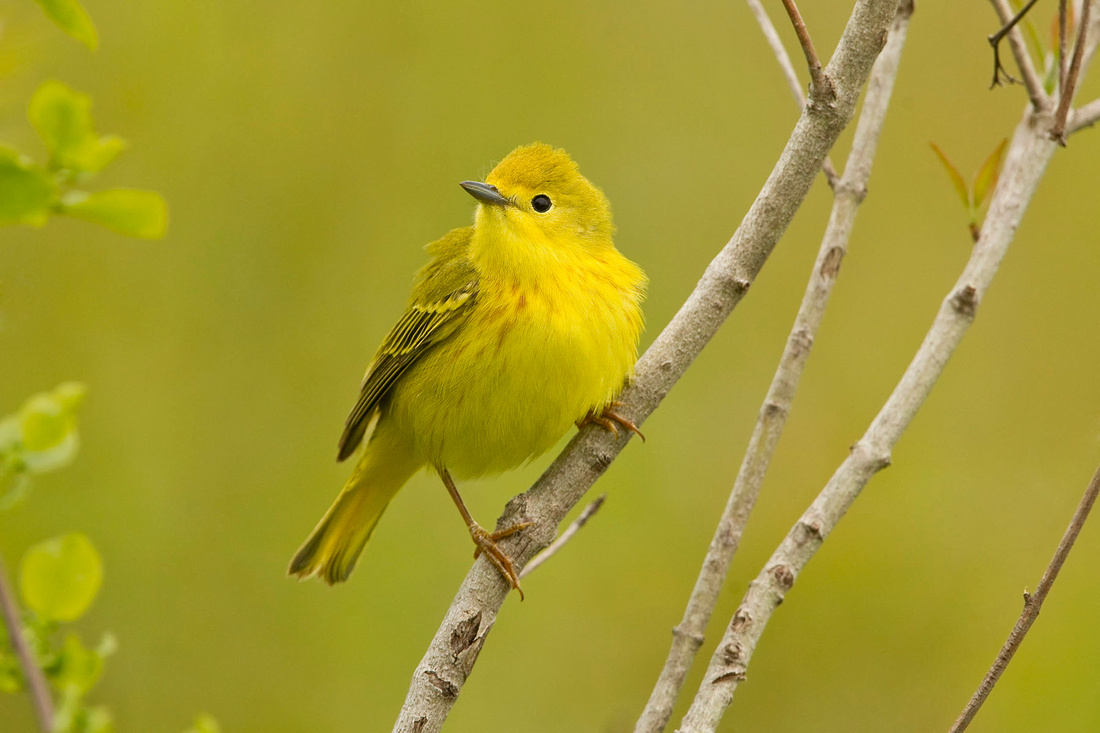
and a Common Yellowthroat.
Also in brushy openings along two different woodland edges I saw cuckoos, Black-billed Cuckoos at Walden Preserve,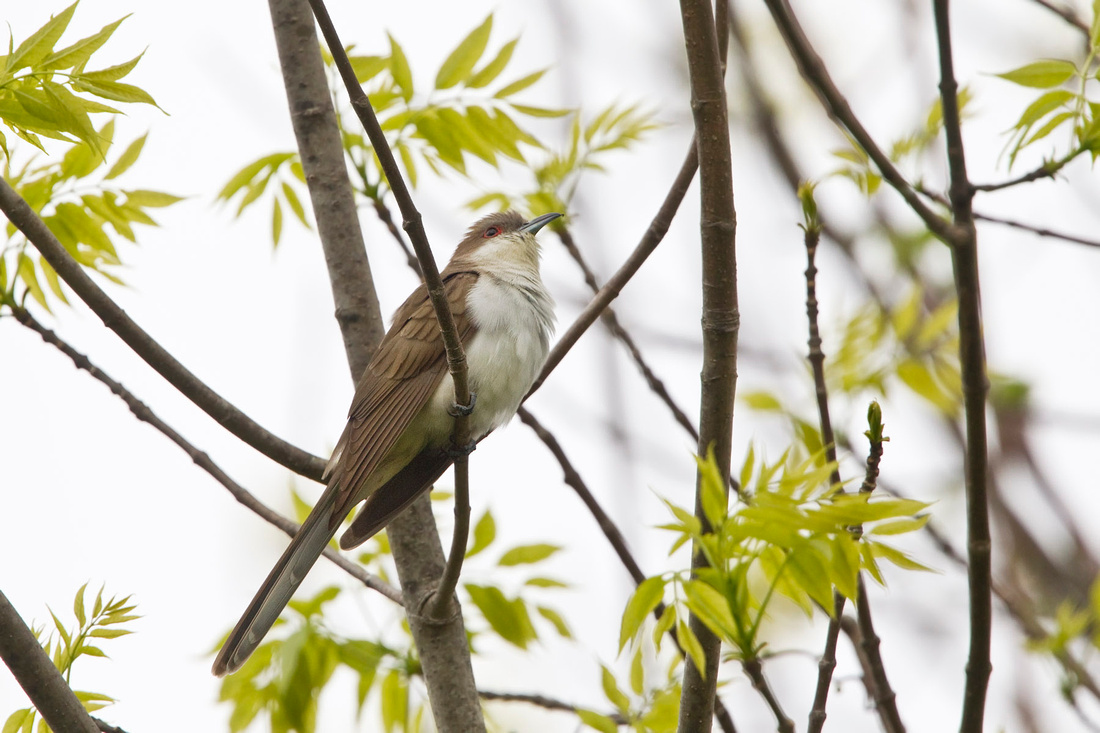
and a Yellow-billed Cuckoo, at Hartman Park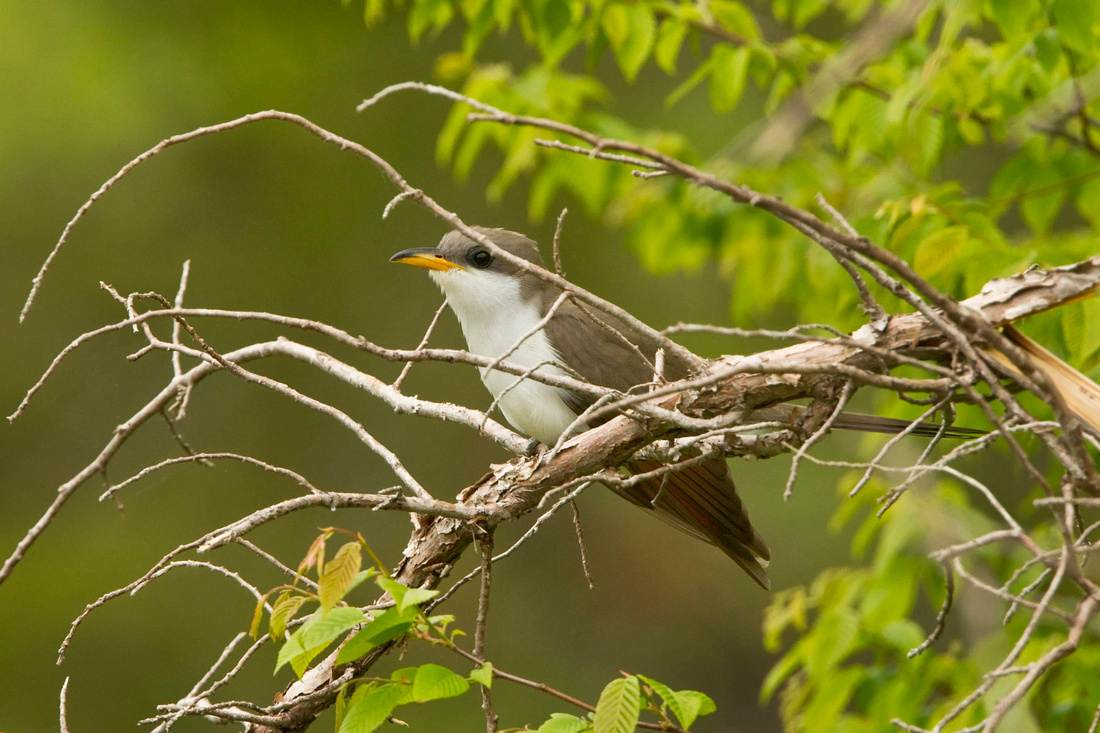
both species near webs of tent caterpillars, which are apparently a favorite food source for cuckoos.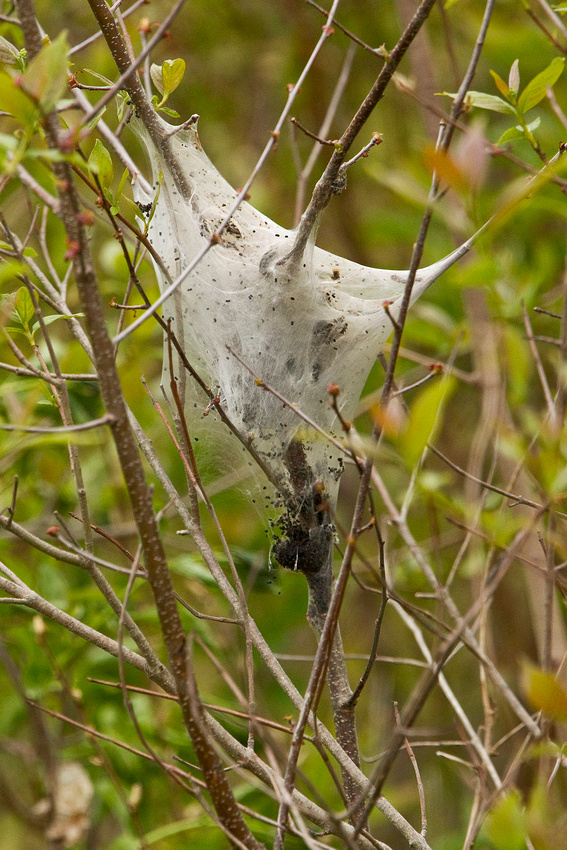
Also in similar habitat, I watched a female Baltimore Oriole gathering vine fibers for its nest,
and a Great-crested Flycatcher working along the woodland edge.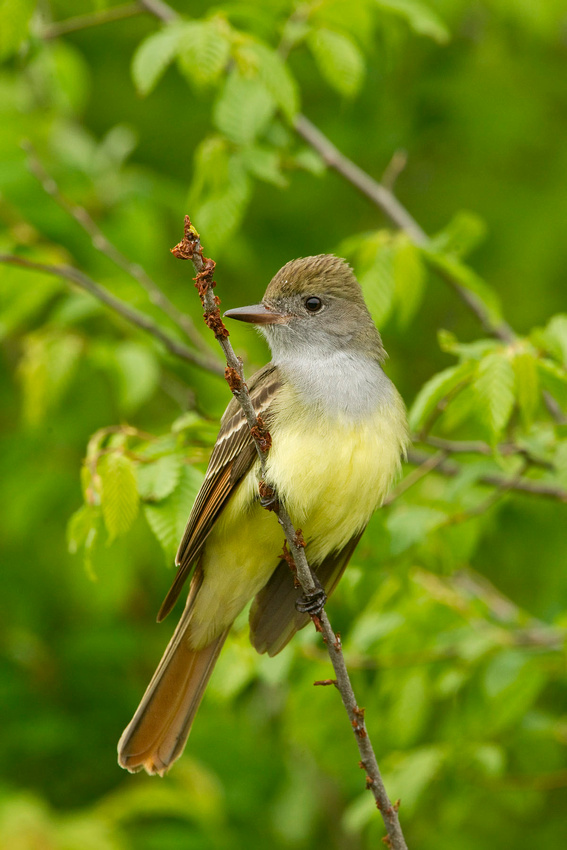
And along the edges of salt marshes, Willow Flycatchers returned, singing their distinct song and revealing their true identity (see my next post to find out why).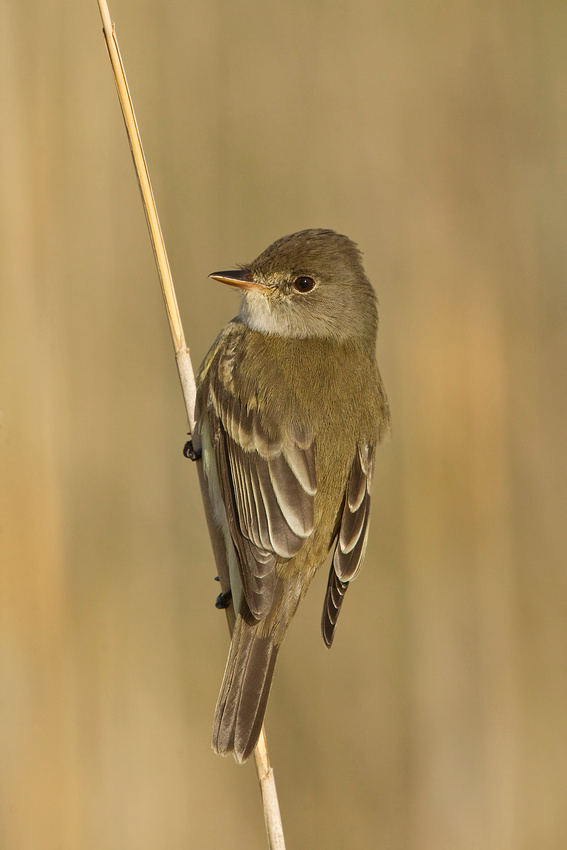
And finally, while watching my son's lacrosse game last Saturday, one of the parents looked up and spotted a sun halo, formed by ice crystals in the atmosphere creating a reflected ring of light at 22 degrees around the sun, (thank you Mr Science!) and everyone's eyes and phone cameras were trained skyward. In keeping with my bird theme, I captured a crow (no, I don't know which kind) flying through it. Just making hay while the sun shines.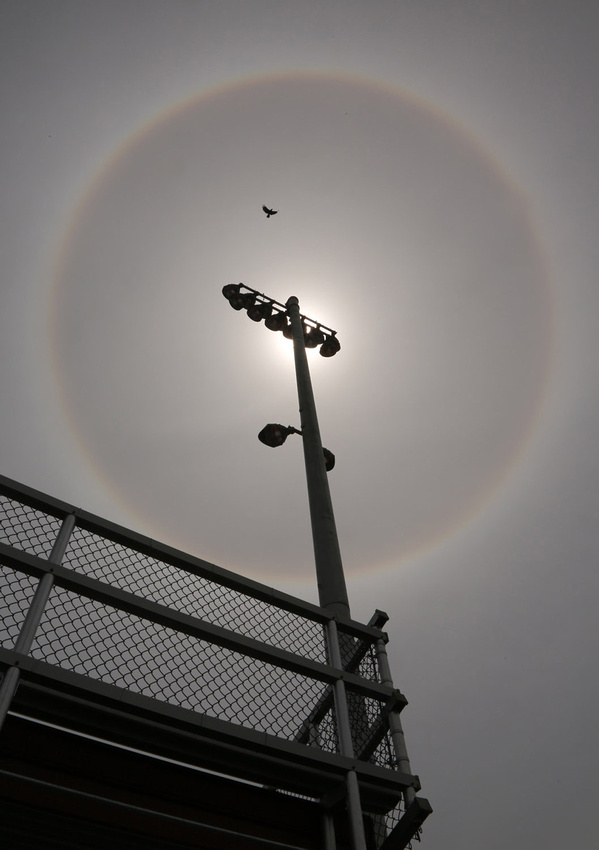
My sightings list is up to 210 species as of May 24, and I still have quite a few easy ones left.
]]>
First, I have a number of flowering trees in my yard, including apple, pear and crabapple. I always try to get pictures of birds either feeding or perched in the trees while they're in full bloom. A few years ago I had several Baltimore Orioles and a pair of Orchard Orioles feeding on the blossoms for days and got lots of pictures. Every year since then, the timing has been off, and either the blossoms came out early and the birds had not returned yet, or, the birds returned later than usual, like this year. I did have a brief visit by a first year Orchard Oriole this year, but got no pictures and just got a few of this young Baltimore Oriole feeding in the apple tree.
Fortunately, there were plenty of colorful feeder birds to fill the void, like American Golfinch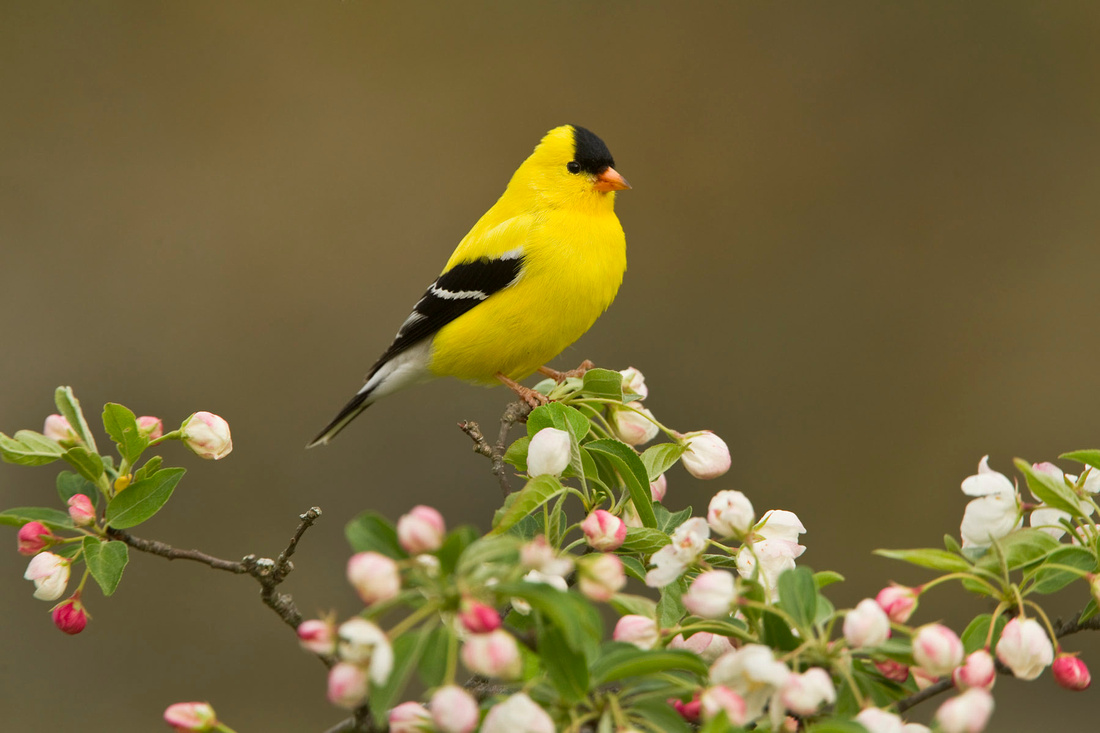
and Northern Cardinal.
Keeping the feeders out in the spring is a mixed blessing, as I also attract hordes of House Sparrows, Brown-headed Cowbirds, Red-winged Blackbirds and Common Grackles (pictured below), although they can be attractive in their own right.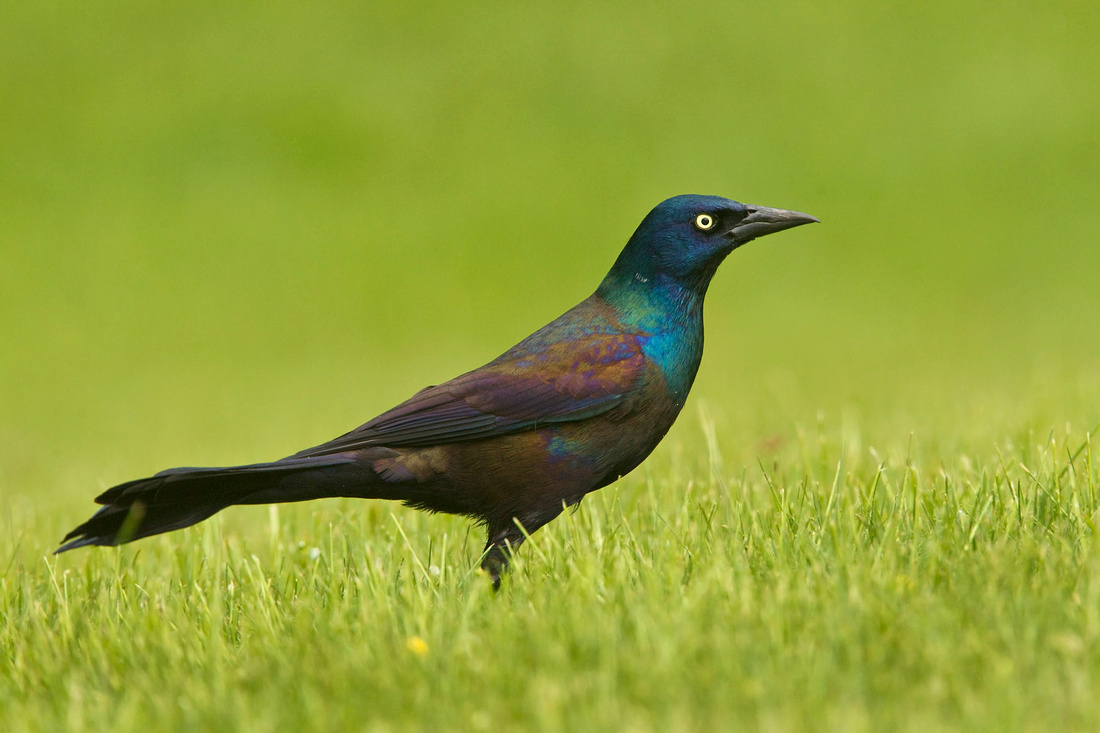
Beyond the "eye candy" at home, there are all the summer residents returning to their breeding territories. The optimal time to photograph these birds is when they first arrive and establish their territory. Once they have paired up and started nesting they are much less conspicuous. So the trick is to find the birds when they first arrive, and there are all different types of habitat to search. Along the shoreline, shorebirds and wading birds are the first targets. At Hammonasset, I photographed Glossy Ibis in the marsh,
Little Blue Heron in a salt pond,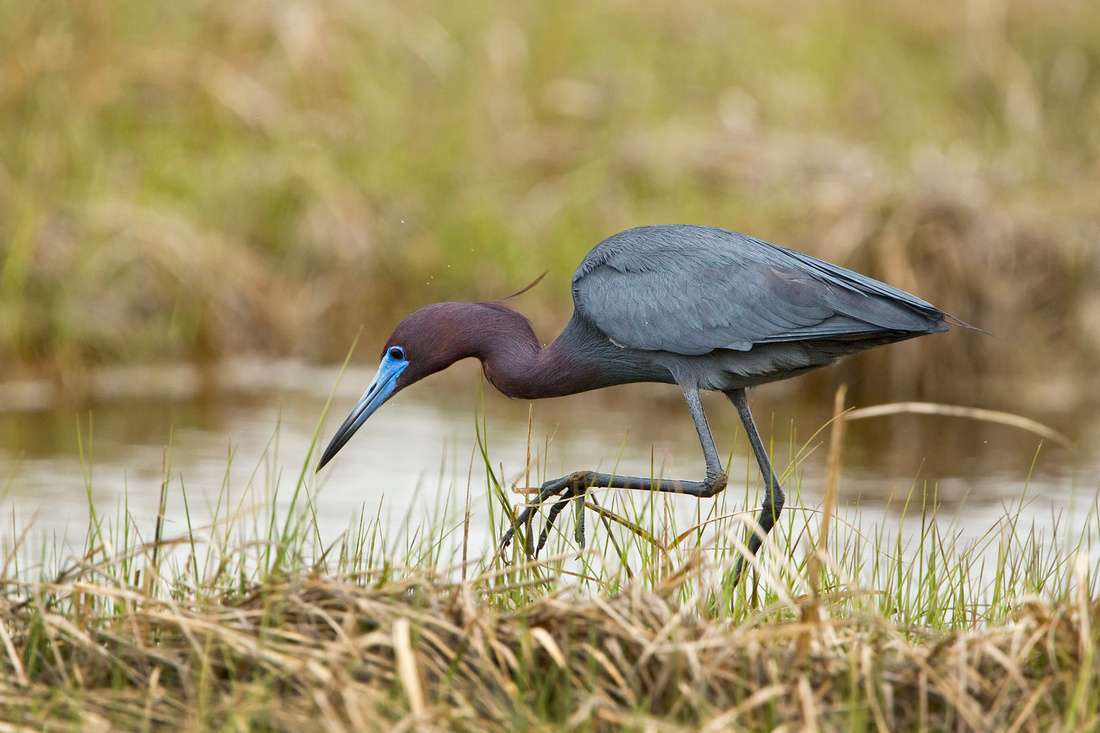 and a late pair of migrating Northern Shovelers at the Swan Pond.
and a late pair of migrating Northern Shovelers at the Swan Pond. Inland, the subjects are even more varied. Along field and forest edges, a bounty of birds can be found. I try to visit power line cuts, like this one near Hartman Park in Lyme, for this type of habitat.
Inland, the subjects are even more varied. Along field and forest edges, a bounty of birds can be found. I try to visit power line cuts, like this one near Hartman Park in Lyme, for this type of habitat.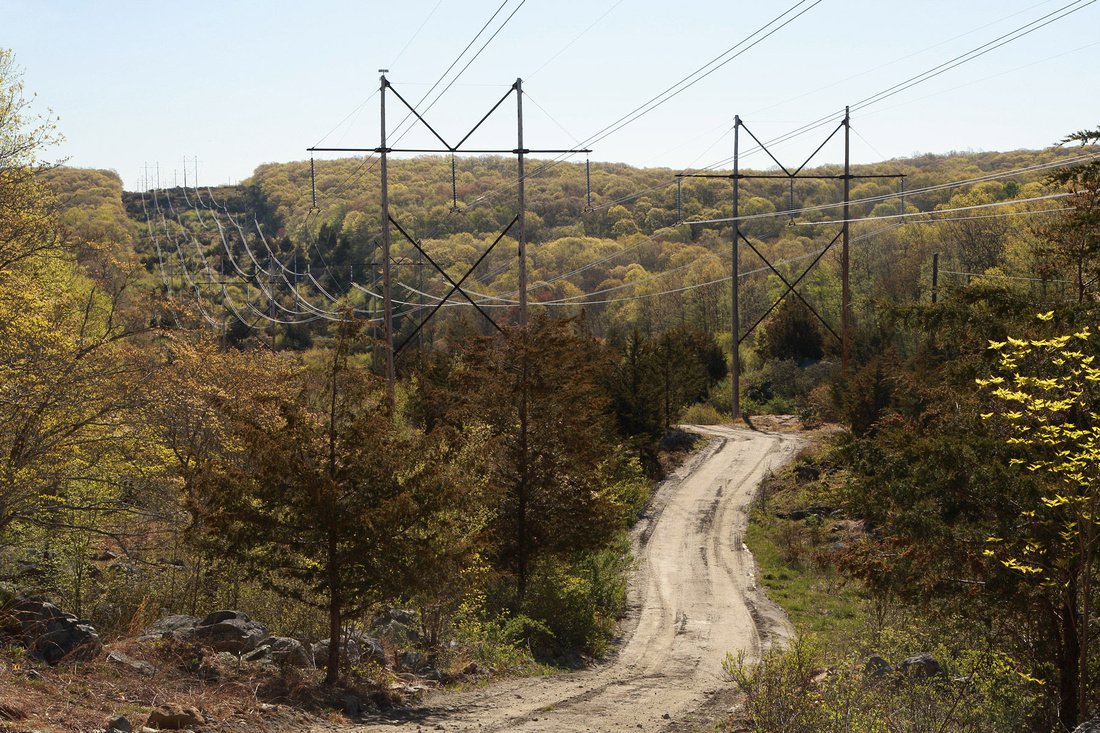 Among the residents are buzzing warblers like this well disguised Prairie Warbler, who was singing from the top of a sapling,
Among the residents are buzzing warblers like this well disguised Prairie Warbler, who was singing from the top of a sapling,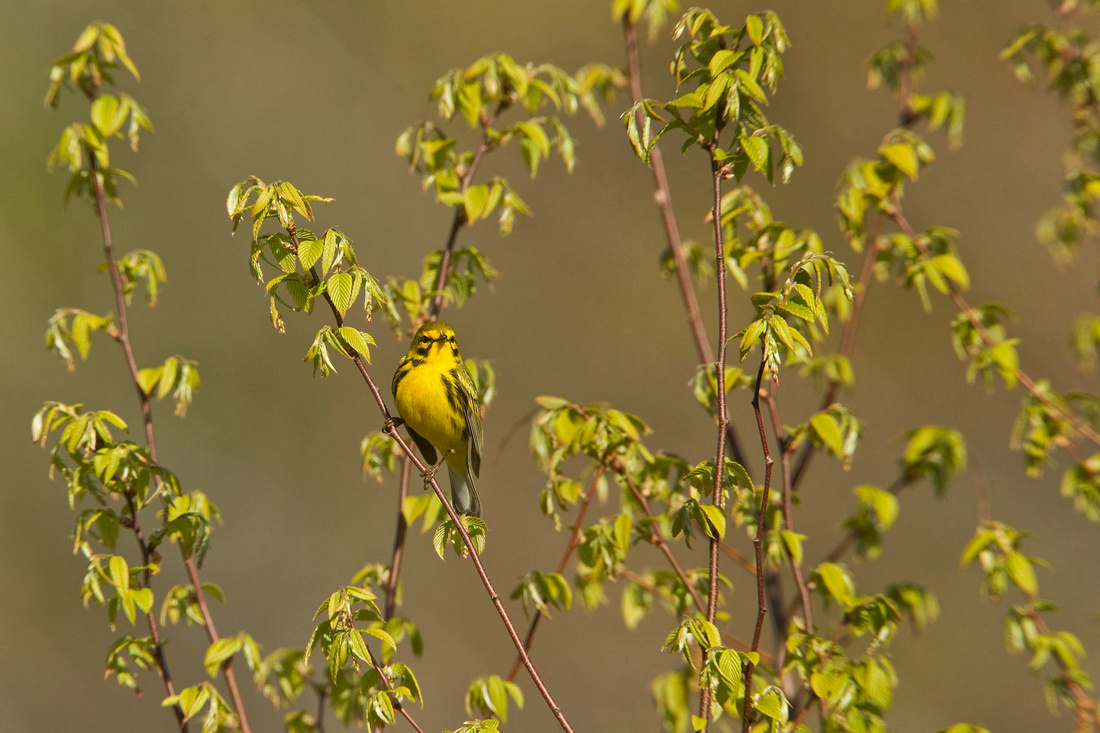 and Blue-winged Warblers abound in the low shrubs and grasses.
and Blue-winged Warblers abound in the low shrubs and grasses.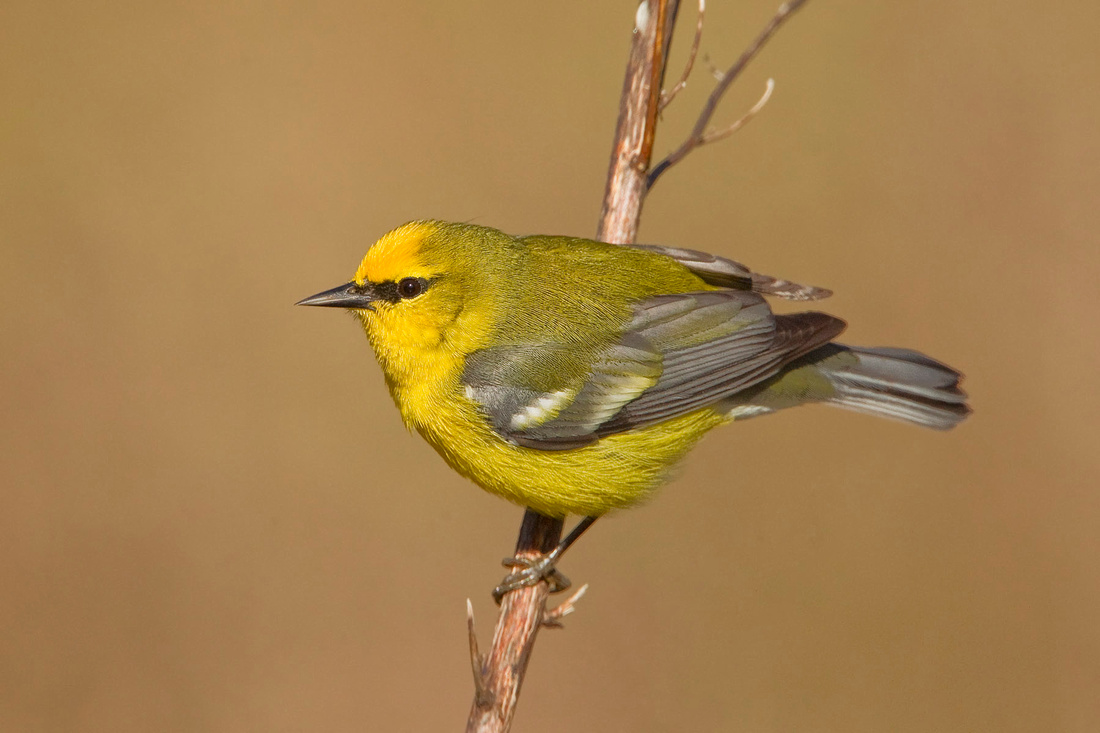 In the woodlands, Baltimore Orioles sing and chatter noisily and are easy to find.
In the woodlands, Baltimore Orioles sing and chatter noisily and are easy to find.
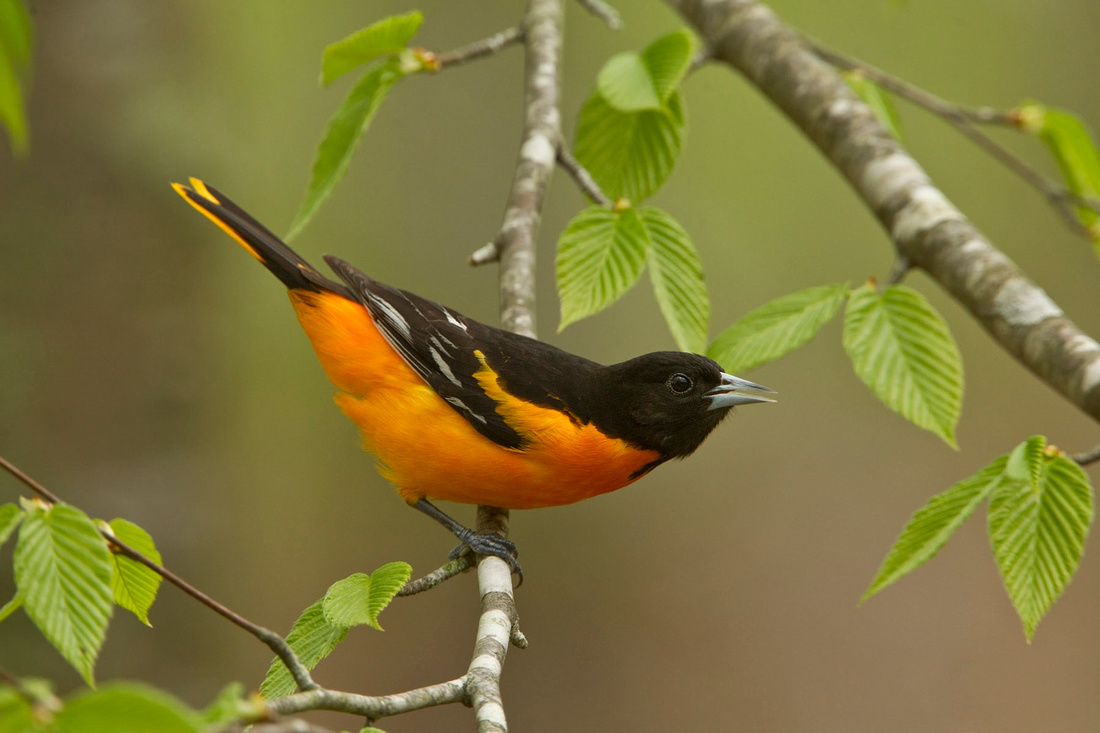 and warblers, vireos, tanagers, flycatchers, grosbeaks and thrushes add their voices to the song-filled woods. Sometimes, migrants passing through can be found along with the residents. In Nehantic State Forest, a plain looking thrush I expected to be a Veery turned out to be a migrating Swainson's Thrush. Migrants are another exciting May target, which I'll cover more about in my next post.
and warblers, vireos, tanagers, flycatchers, grosbeaks and thrushes add their voices to the song-filled woods. Sometimes, migrants passing through can be found along with the residents. In Nehantic State Forest, a plain looking thrush I expected to be a Veery turned out to be a migrating Swainson's Thrush. Migrants are another exciting May target, which I'll cover more about in my next post.
As May draws to an end, I usually shift my focus to finding nests to photograph, but it's still early for that, or so I thought. While walking along a woodland stream on May 8, a small bird flew out from a few feet away from me and fluttered over the water. I had accidently flushed a Louisiana Waterthrush from its nest in some upturned roots. I could partially see the nest through the hanging root fibers, and what appeared to be a cup of brown speckled eggs. I quickly bent down to take a shot of the nest area and noticed a lightly speckled white egg in the water. The nest is marked by the top arrow and the egg by the lower.
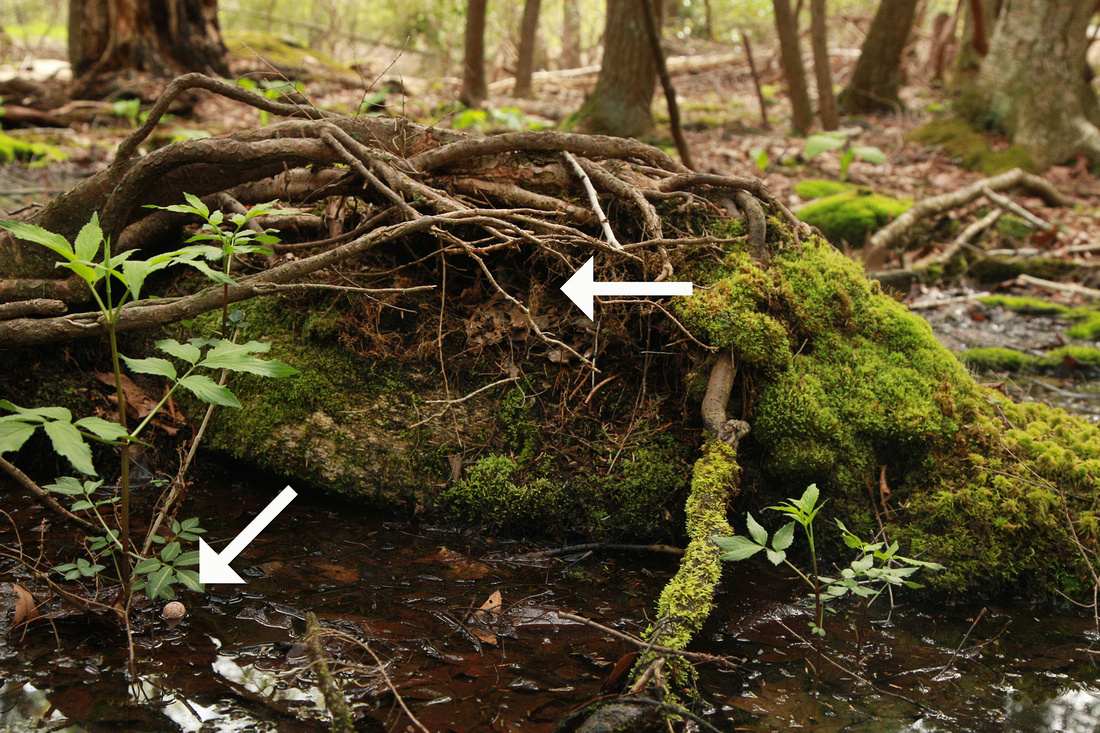
As I stood to leave, I saw another white egg at the edge of the stream, right at my feet.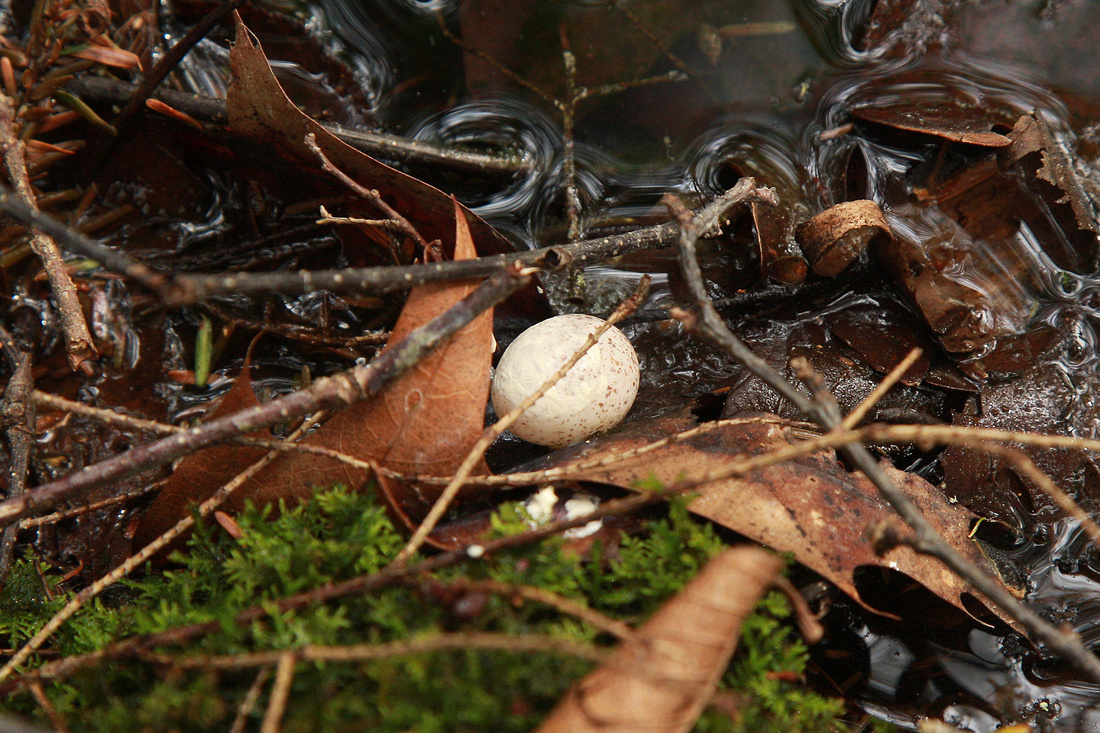
I quickly retreated and left the area. I feared that eggs were scattered by a Brown-headed Cowbirds that had parasitized the nest, since I heard them in the canopy above the stream. That night I looked up the eggs of waterthrush and cowbirds in a book I have, and my fears were confirmed. I generally do not try to photograph songbirds nesting while they are incubating, because of the risk of them abandoning their eggs. I may try to return in a couple weeks to see if chicks have hatched and if it's even possible to photograph the nest. Well downstream from the nest I continued my streamside search and found this Nursery Web Spider on a a skunk cabbage leaf.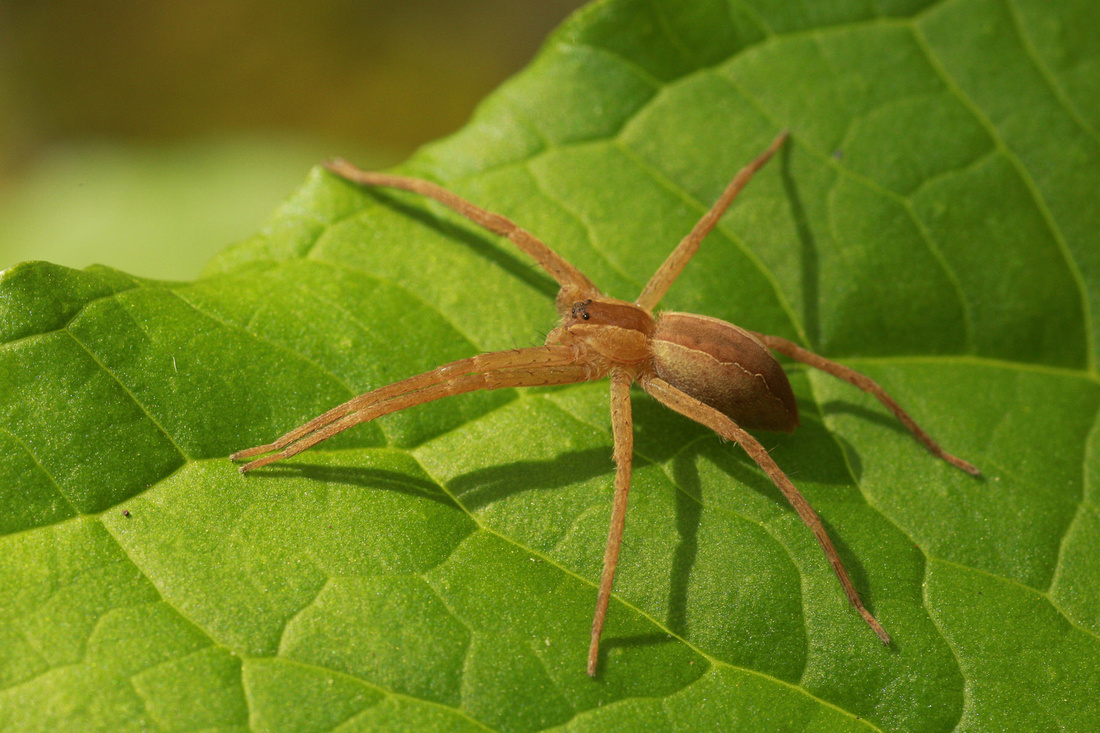
Perhaps the best find I had last week was a beautiful Eastern Box Turtle at the edge of a road in Lyme. I have never seen a box turtle in the wild, and they are growing increasingly rare in the state. I decided to move the turtle from the roadside since they are apparently hit by cars while crossing the road a lot (there were several controversial turtle crossing stories while I worked at the Hartford Courant). After a brief photo shoot, I placed the turtle about 20 feet off the road in the direction it was pointed when I found it. I hope that keeps it safe.
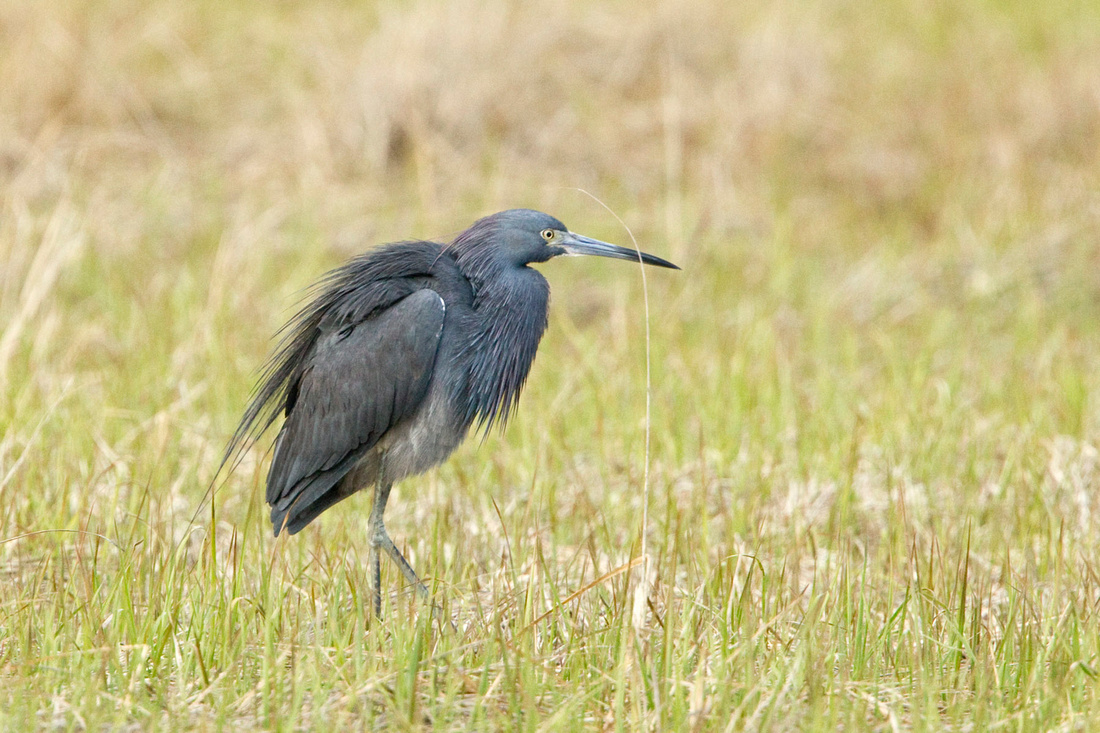
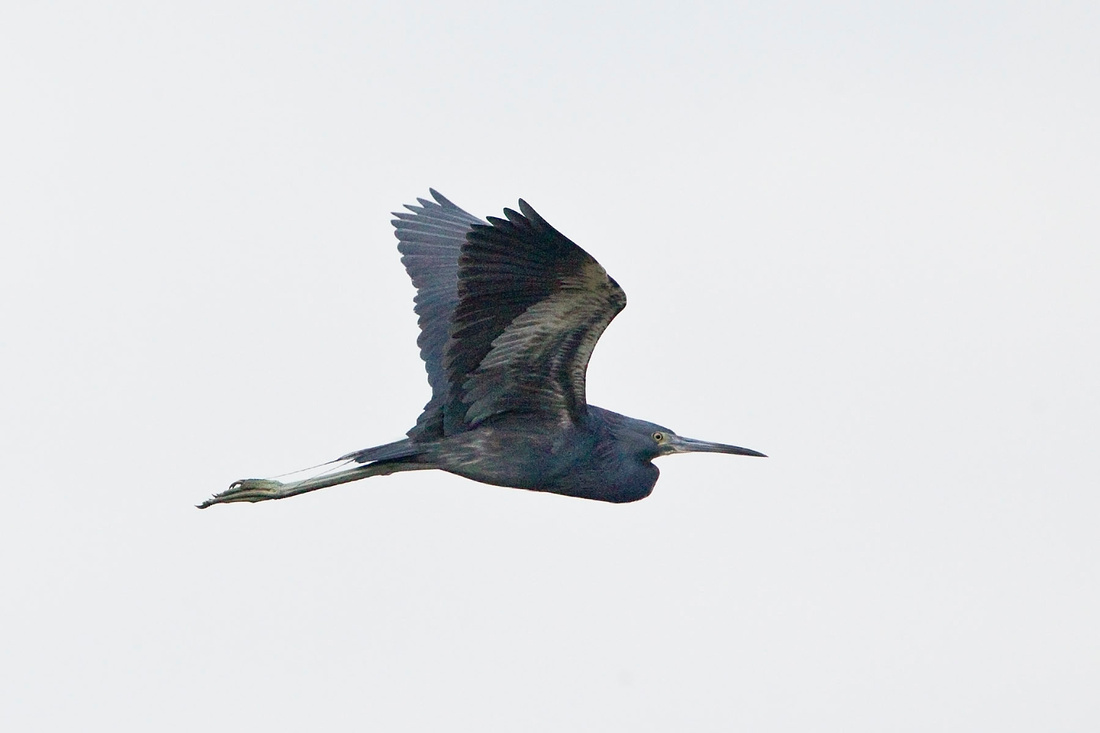
Below is one of the Little Blue Herons in the park from a few days earlier for comparison.
and an adult Tricolored Heron taken at the same pond almost exactly a year ago - note slightly longer bill and white underwings.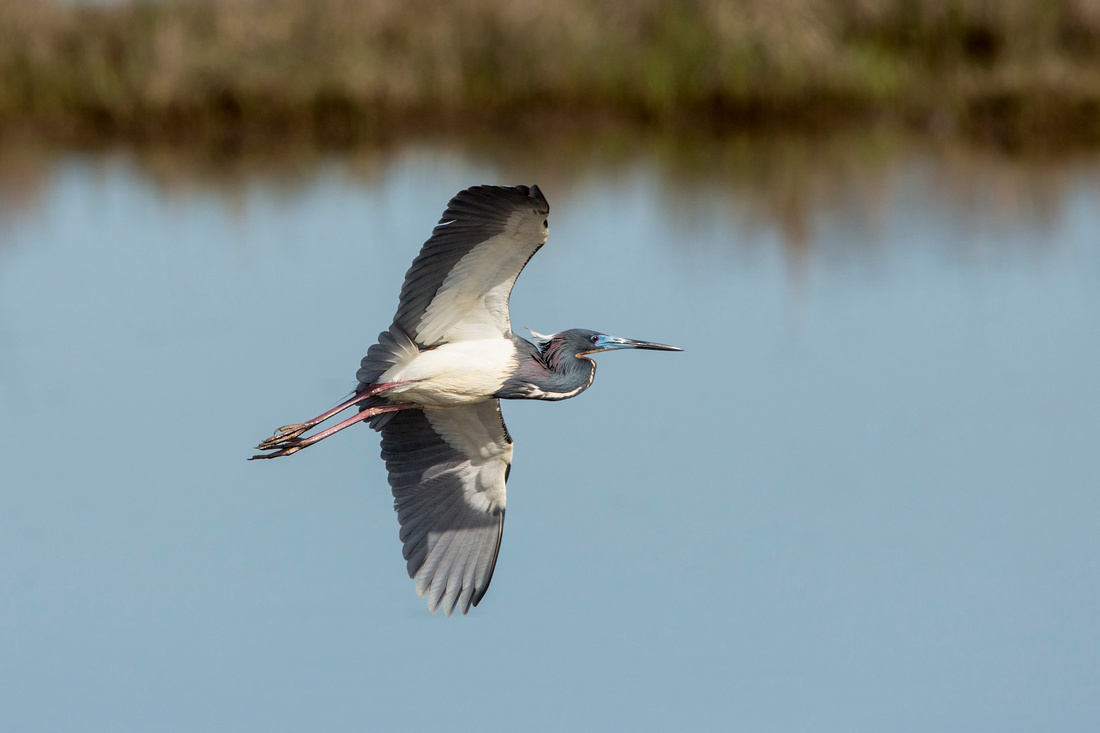
and finally a shot of one of the suspected hybrids from last fall for comparison.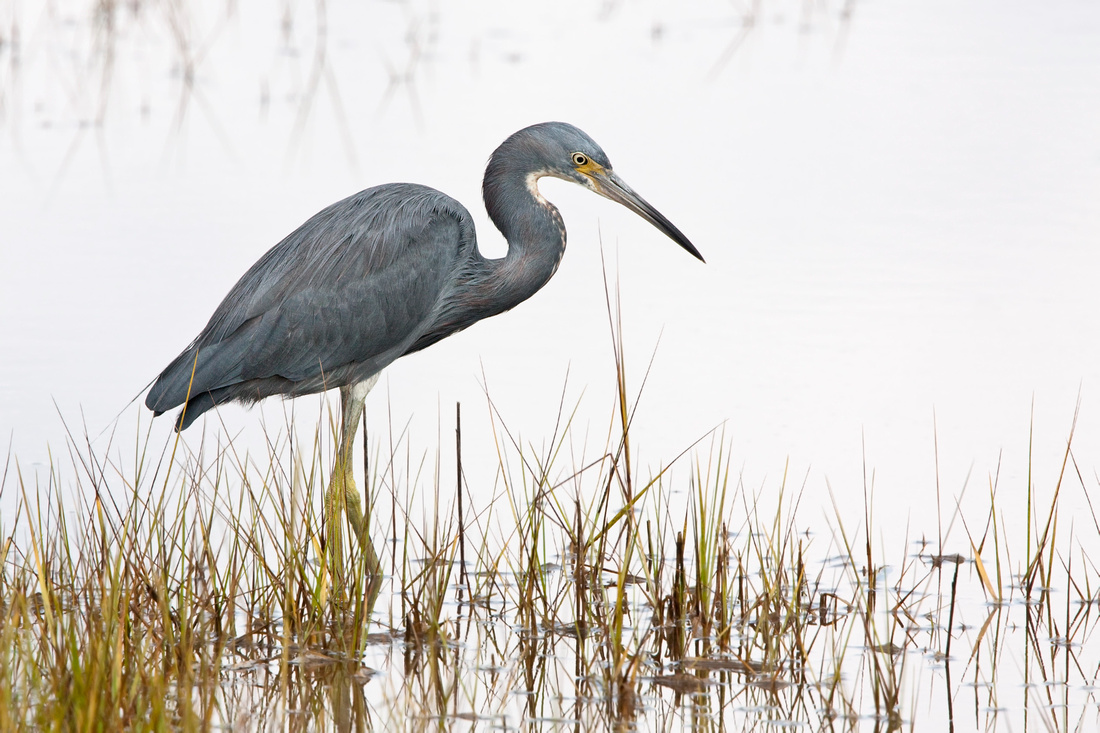
Before I get to that, though, I continued to follow the loons in Niantic Bay, and the one I photographed for my previous post continued to linger and was joined by another Common Loon in full breeding plumage fairly close to shore. Several birders have reported seeing Common Loons in full breeding plumage on ponds, lakes and along the shore in Connecticut this year and wondered if this is unusually late for them, which I have been wondering myself. I can't recall ever seeing loons that looked like these in the state in more than 20 years of birding. The first is the original one, still with a few patches of gray feathers around the eyes.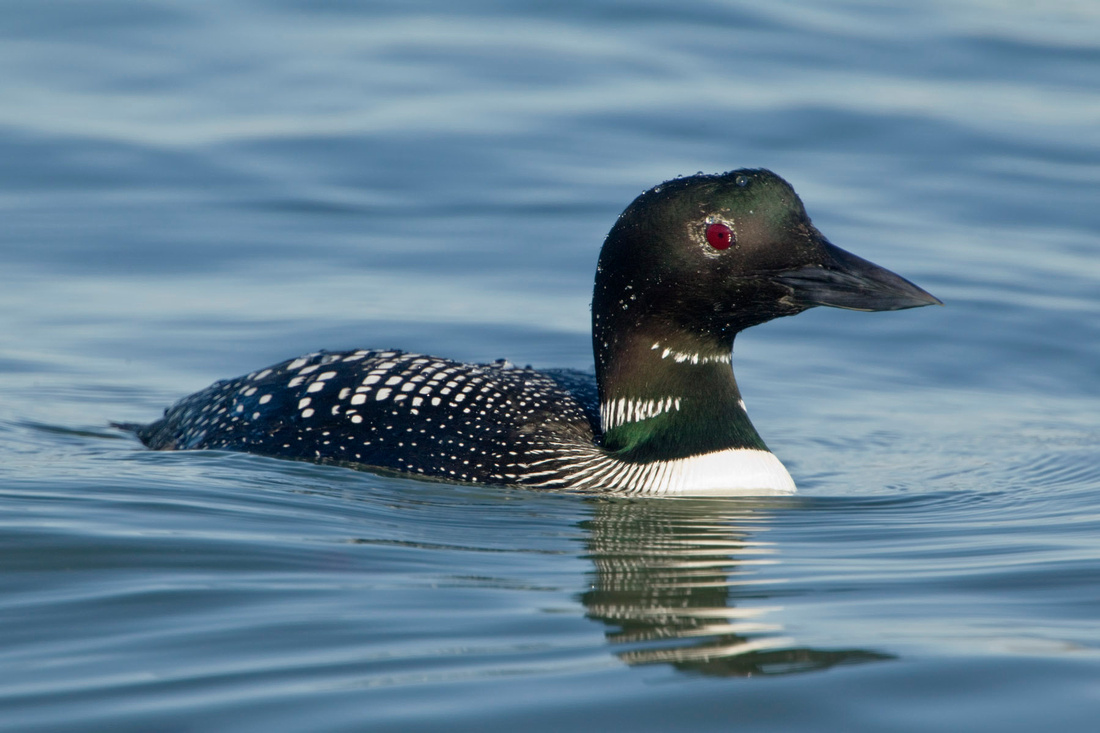
and then the very sharp looking newcomer.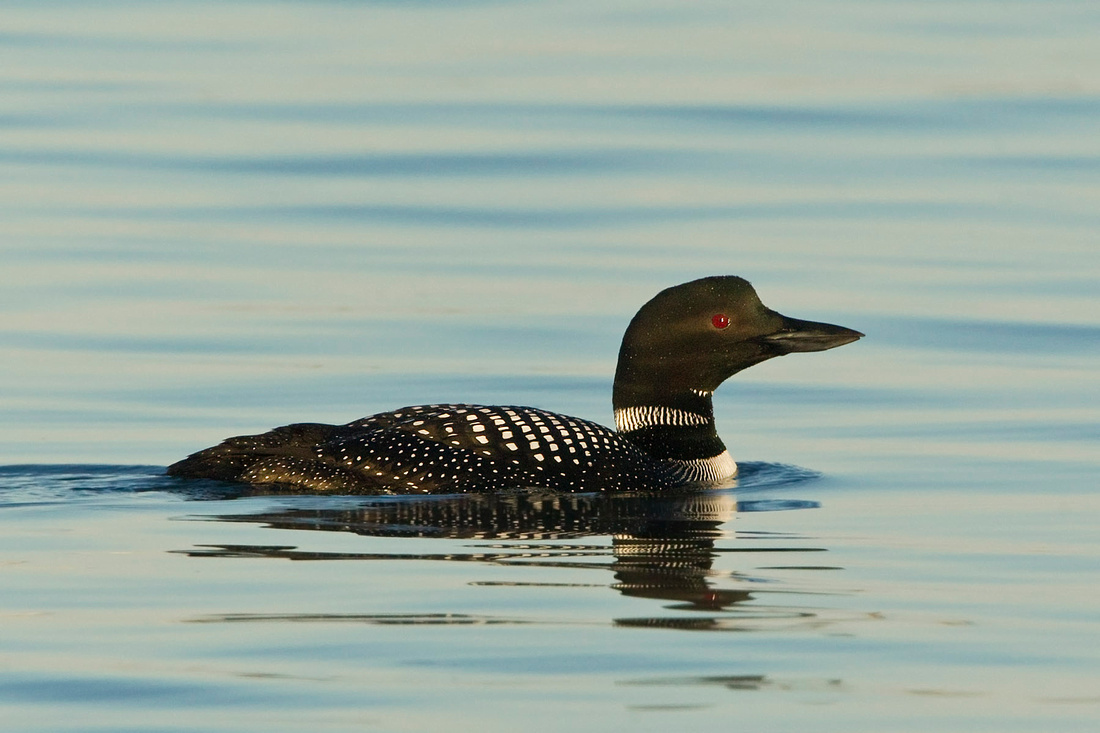
Back to the slowly rising chorus of songs filling the woods. I'm lucky to live in an area where there are quite a few great places to bird in the spring and that's where I usually concentrate my efforts for the month of May. Tracts of Nehantic State Forest in Lyme and East Lyme, Rocky Neck and Devil's Hopyard State Parks and numerous town parks and land trust preserves, especially in Lyme and Salem offer lots of different habitat to cover, and an amazing variety of birds and creatures that live there.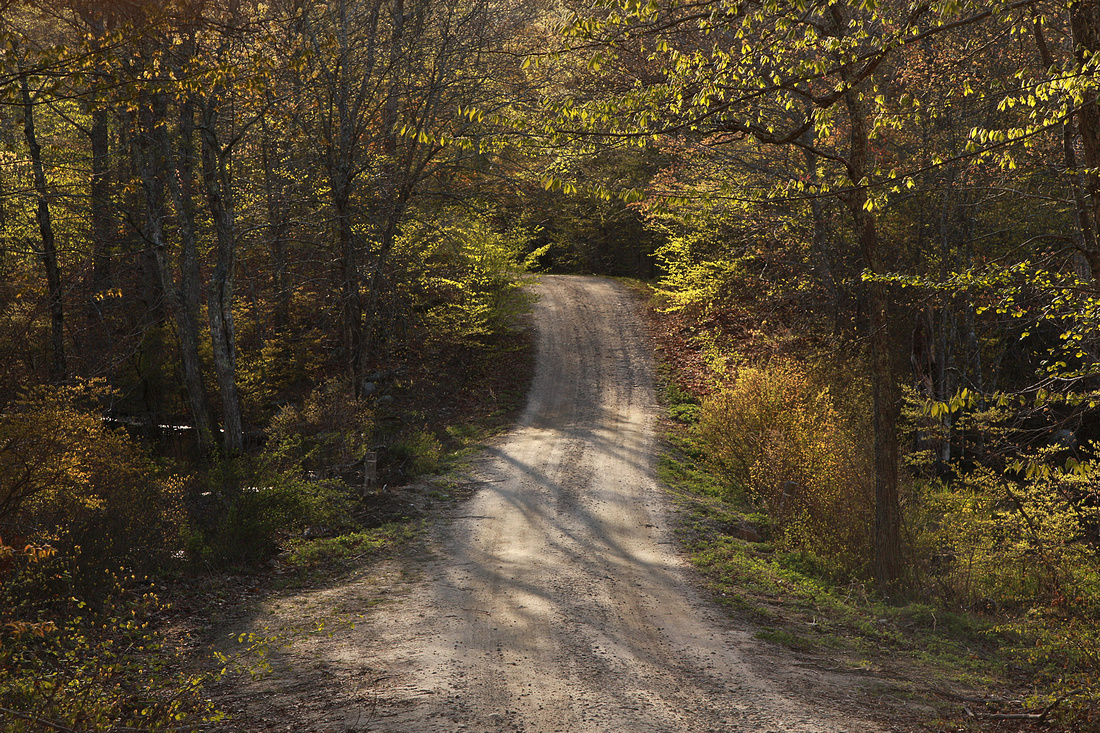
Nehantic State Forest - Lyme
Early arrivals like Blue-gray Gnatcatchers are already building their nests, and are easily spotted almost everywhere. I found two nests so far, thanks to the sparse leaf cover, although the nests are cleverly disguised with lichens that often blend seamlessly with the bark of the tree branches they are attached to. I watched the pair building the nest below, in Lyme, carefully camouflaging the outside with lichens. A couple days later it was nearly twice as high, with the bird barely visible inside.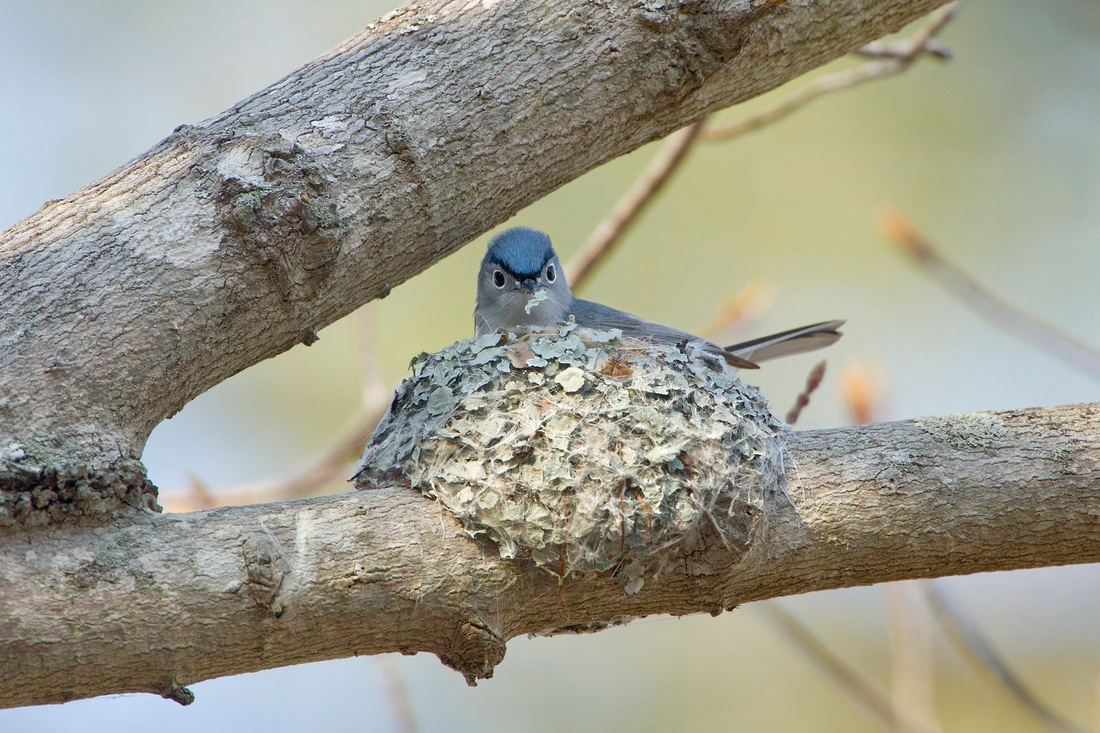
Another easily located bird is the Ovenbird, which sings loudly from the lower forest canopy. In almost every wooded area in Lyme, their piercing "teacher, teacher, teacher" song can be heard every few hundred feet. One of the largest and least colorful of the warblers, Ovenbirds nest on the ground and are fairly easy to see and photograph because they are often found in the lower branches and walking on the ground. 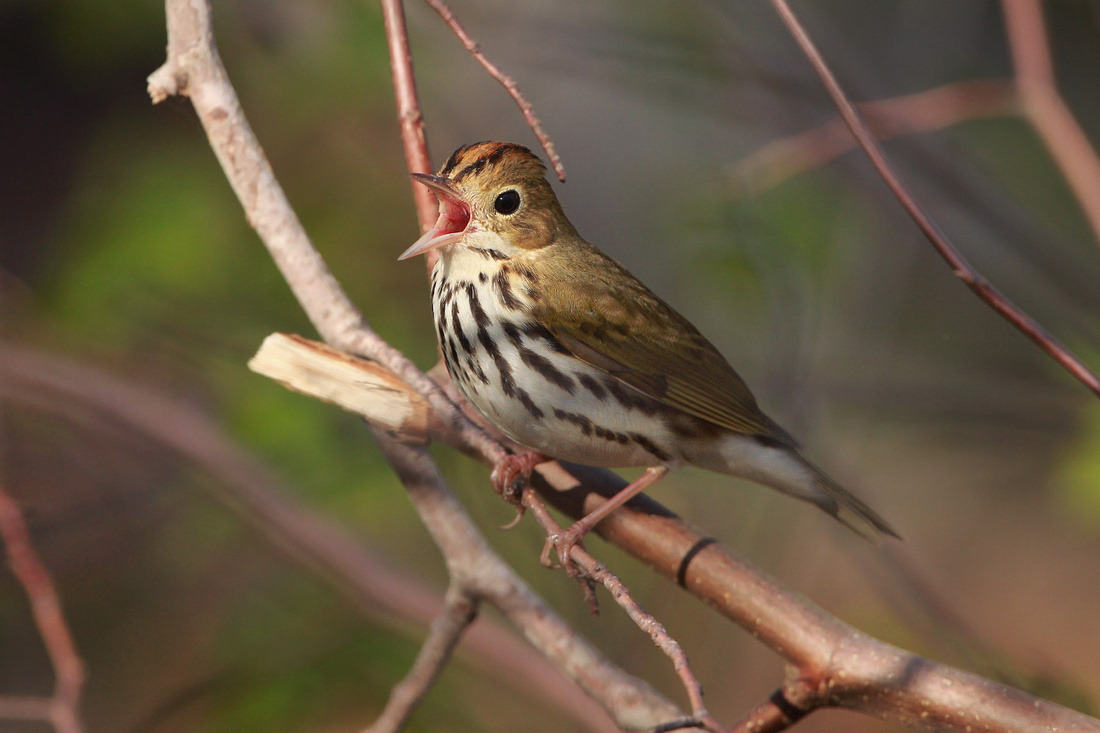
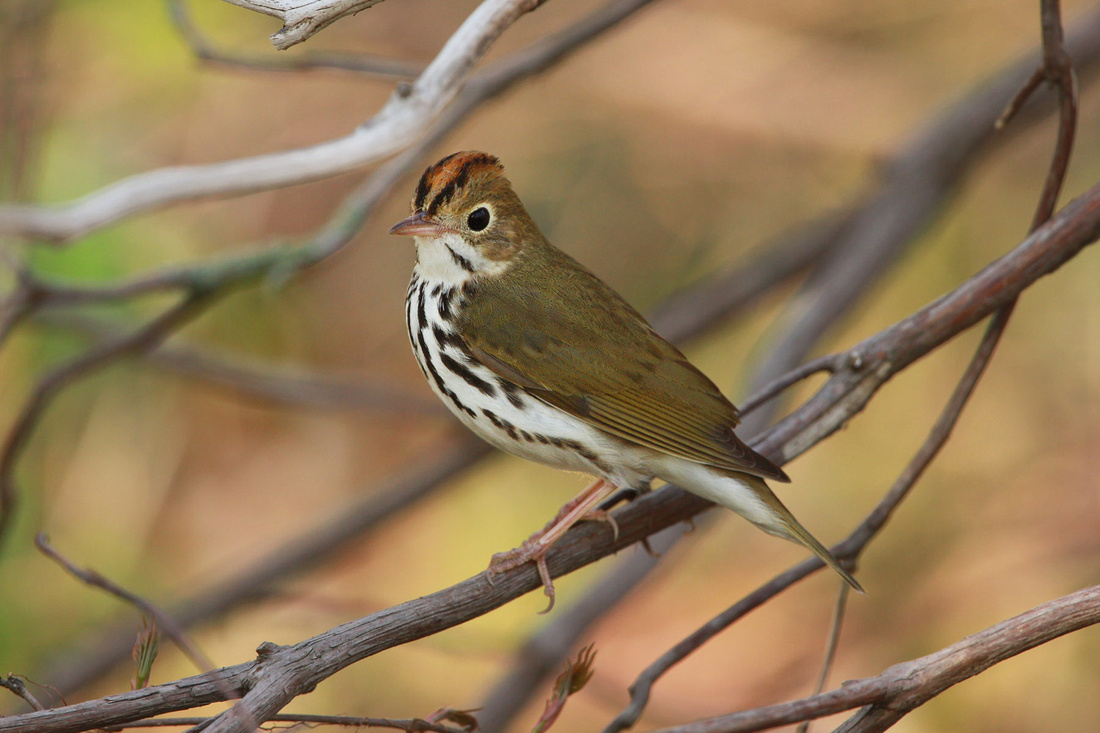
Another low, loud warbler easy to hear but tougher to spot, the Northern Waterthrush sings loudly from wet, swampy areas. They, too lack the bright colors of most warblers and their song has a ventriloquial quality that doesn't easily reveal their location as they walk slowly along the waters edge. The one below was also photographed in Nehantic State Forest.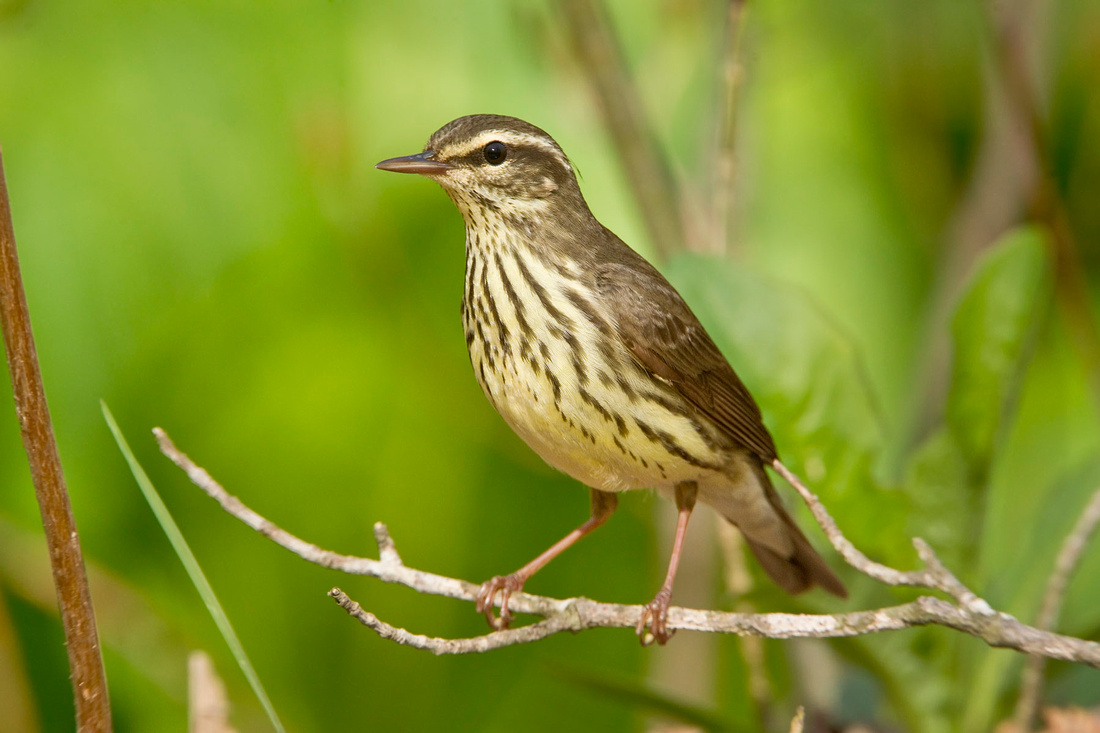
Another prolific singer, usually found near woodland streams is the Winter Wren. A tiny bird with a very long, complex and musical song, they are easy to pick out when singing but are usually found close to their specific habitat, and are not that readily found.
I usually see, or more often hear them when hiking in Devil's Hopyard, and located a territorial pair on a hillside in there, although in a different spot than I have ever seen them before.
Some others from the past week include Worm-eating Warbler.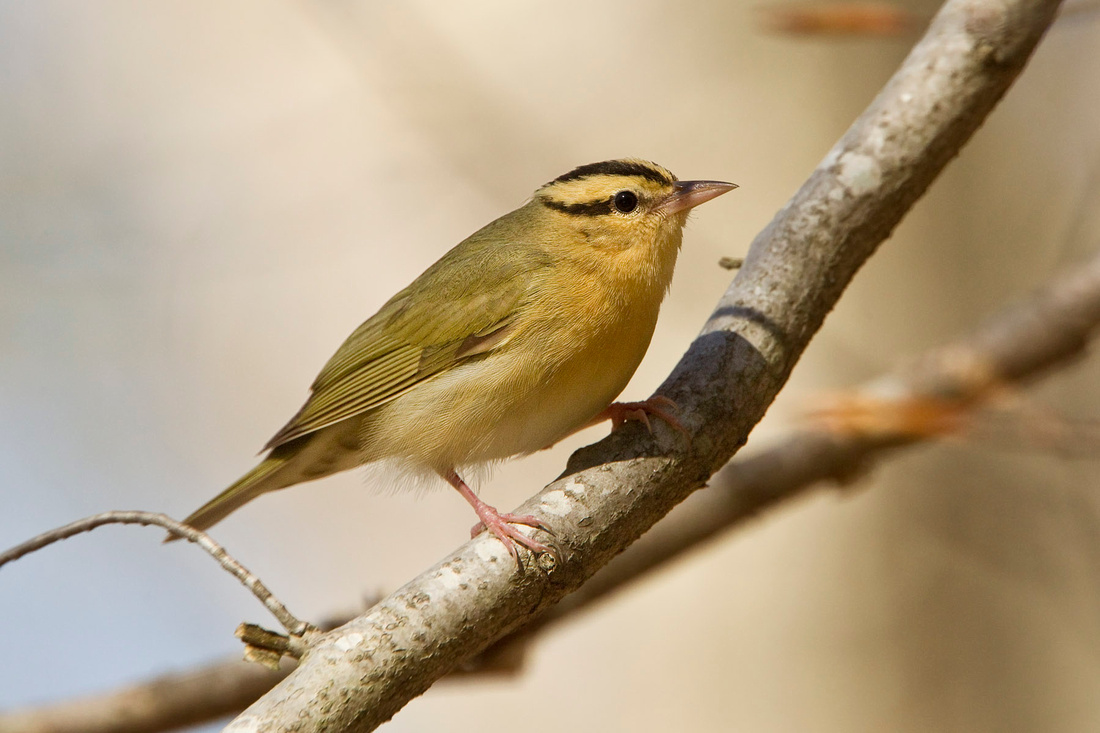 American Redstart - male,
American Redstart - male,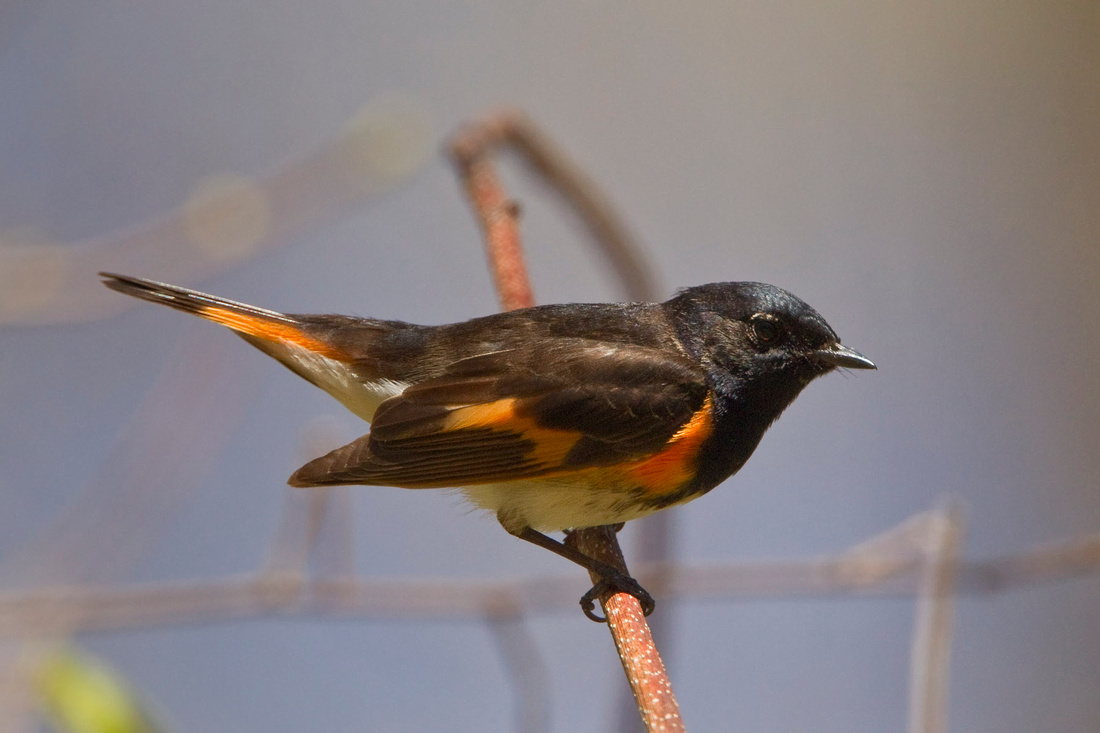
Blue-winged Warbler, Wood Thrush,
Wood Thrush, and higher up in the trees, a Black-throated Green Warbler,
and higher up in the trees, a Black-throated Green Warbler,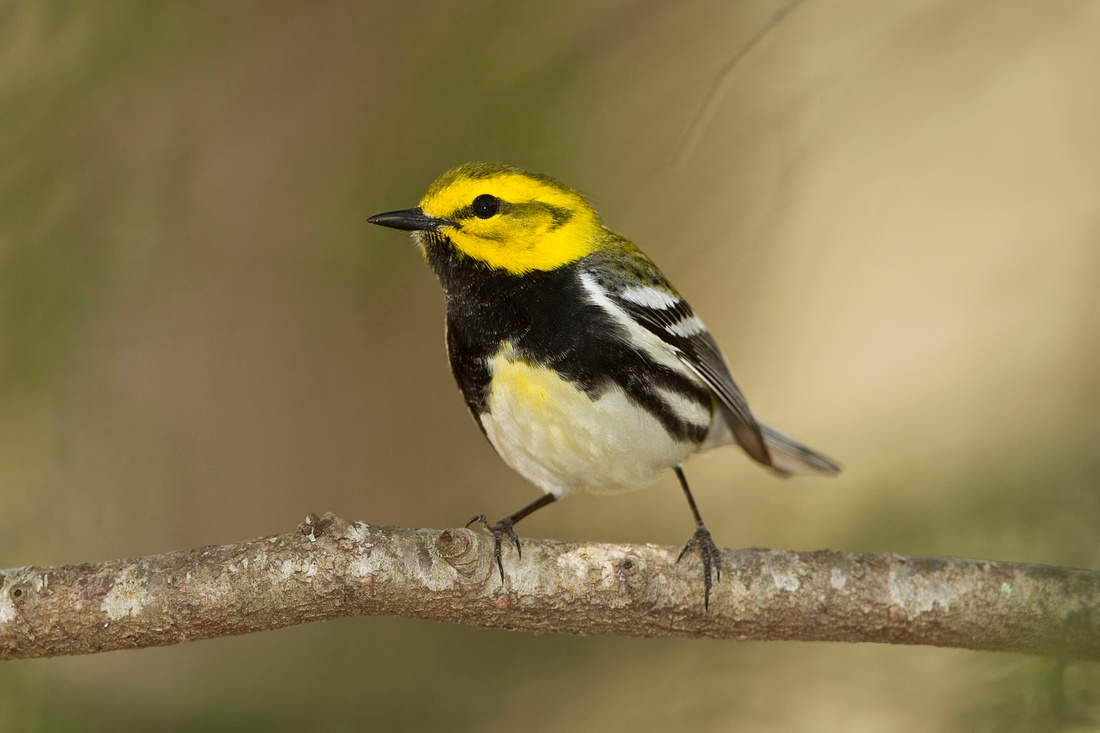 Cerulean Warbler,
Cerulean Warbler, Yellow-throated Vireo,
Yellow-throated Vireo, and Broad-winged Hawk.
and Broad-winged Hawk.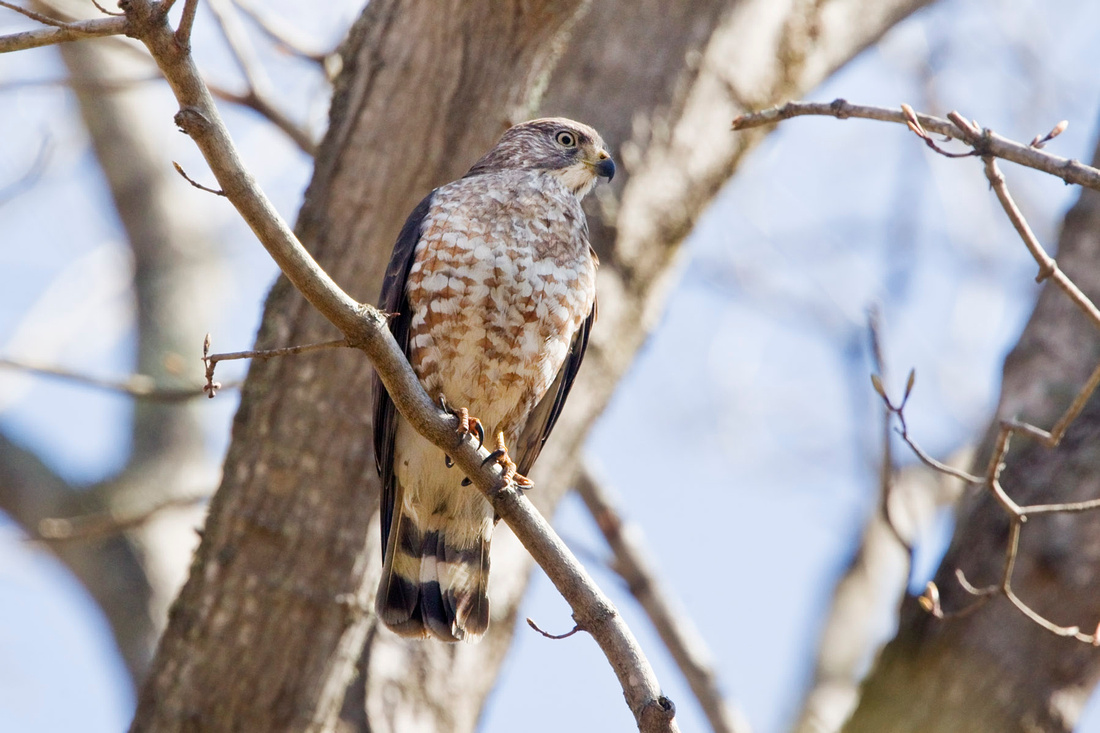 Not all the activity was in the woods, though. I came a cross a bunch of amazingly tame Barn Swallows that were building nests under a bridge. I slowly walked up to them and photographed them perched on the railings,
Not all the activity was in the woods, though. I came a cross a bunch of amazingly tame Barn Swallows that were building nests under a bridge. I slowly walked up to them and photographed them perched on the railings,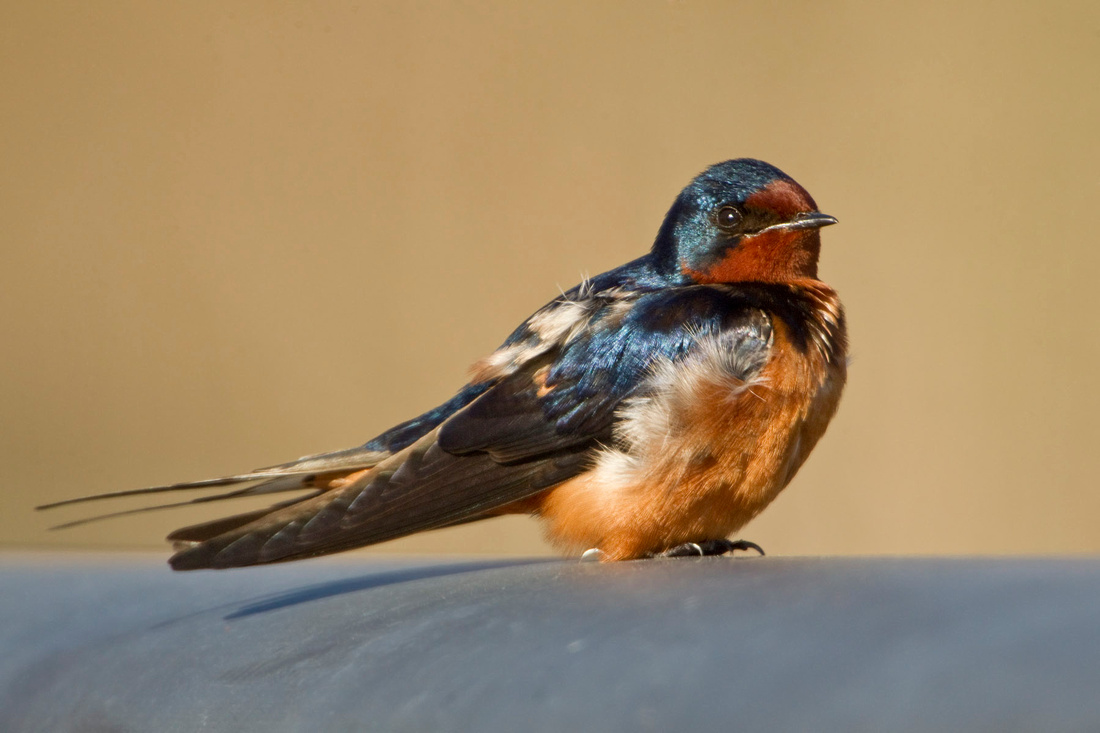 collecting mud and twigs for their nests,
collecting mud and twigs for their nests,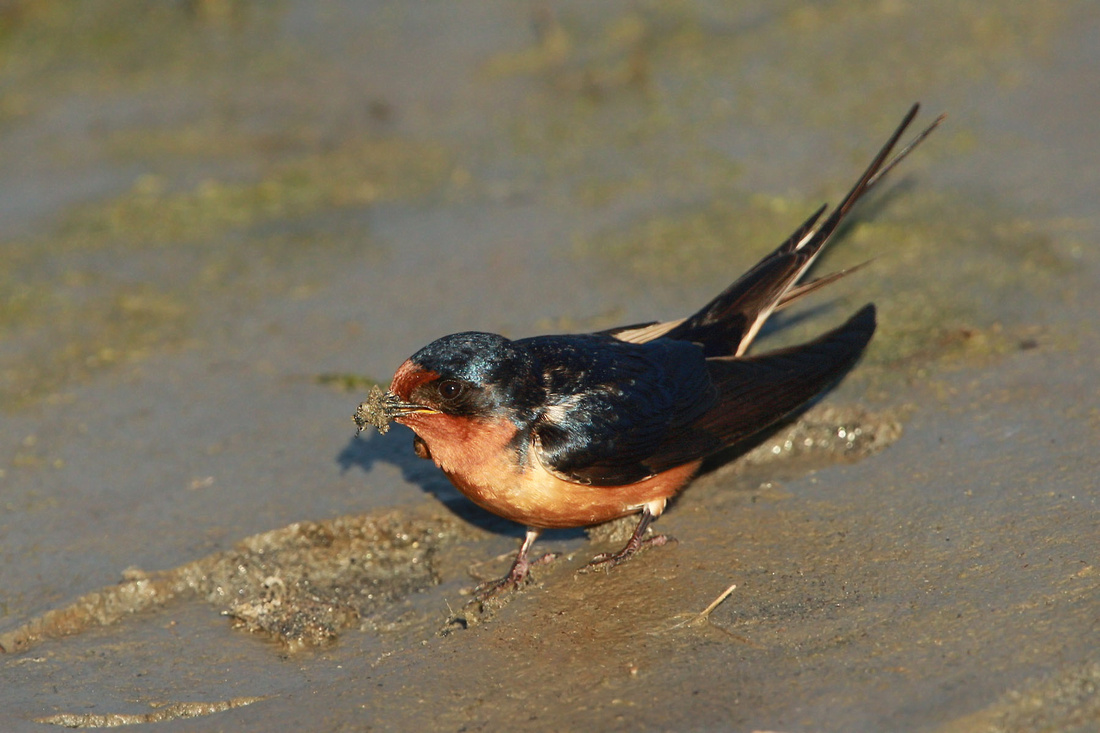
and taking the material to their nests below the bridge,
I tried in vain to get shots of them flying around, at times just a few feet from me, to my immense frustration. My annoyance was overcome when, on a few occasions, one would land fearlessly right next to me. Now that's something to sing about.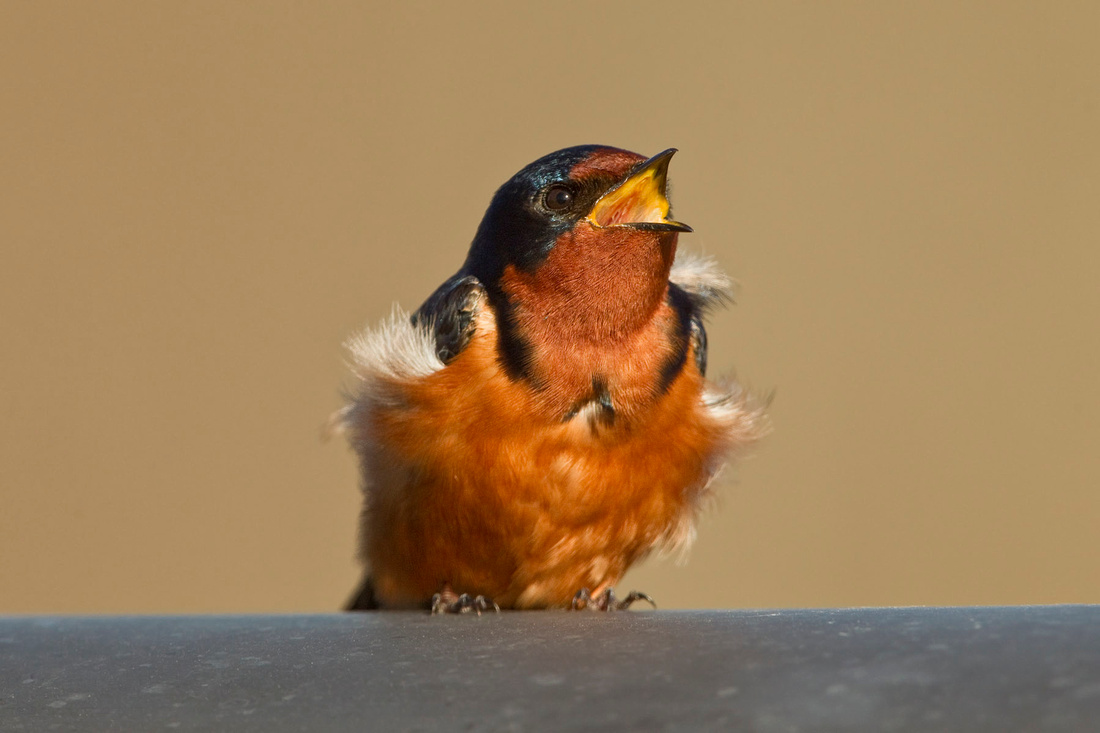
Current total - 172 Connecticut Species.
]]>
At Rocky Neck, things have quieted down in the Bride Brook marsh. Most of the Osprey have paired up and chosen nest sites. Many of the ducks have moved on, but a few still linger, mainly in the north end of the marsh. I have not seen the two sub-adult eagles lately, although there was a tattered looking juvenile flying over the park last week.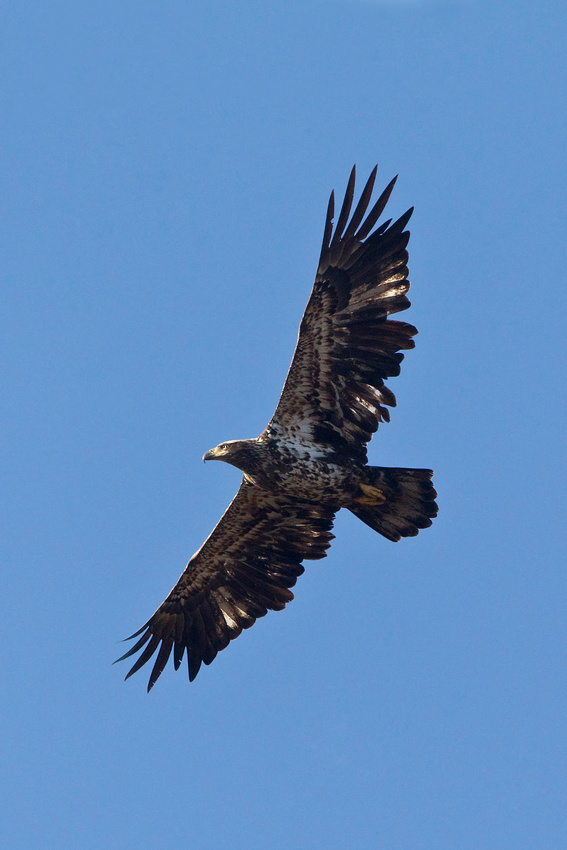
The egrets have also thinned out a bit, although both Great and Snowy Egrets still dot the salt marsh. So far no sign of the Little Blue Heron I've seen the past few springs in the park, but the Snowies are starting to morph into full breeding plumage.
Double-crested Cormorants continue to build along the shoreline, and large flocks can be seen flying overhead well inland as they head north.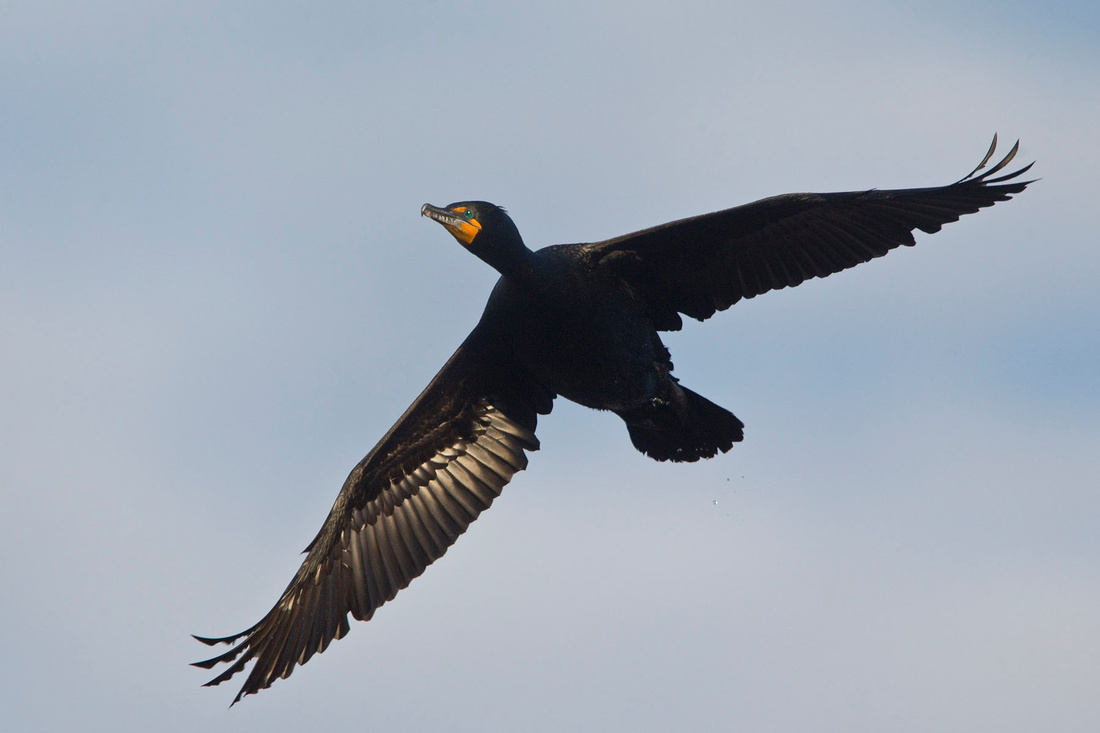 In many of the ponds in Niantic, flocks of cormorants gather to feed on the alewives that have made it to their spawning destinations. I spent an hour one day, patiently waiting for one to surface close enough to see the tiny crests on the head that they are named for.
In many of the ponds in Niantic, flocks of cormorants gather to feed on the alewives that have made it to their spawning destinations. I spent an hour one day, patiently waiting for one to surface close enough to see the tiny crests on the head that they are named for.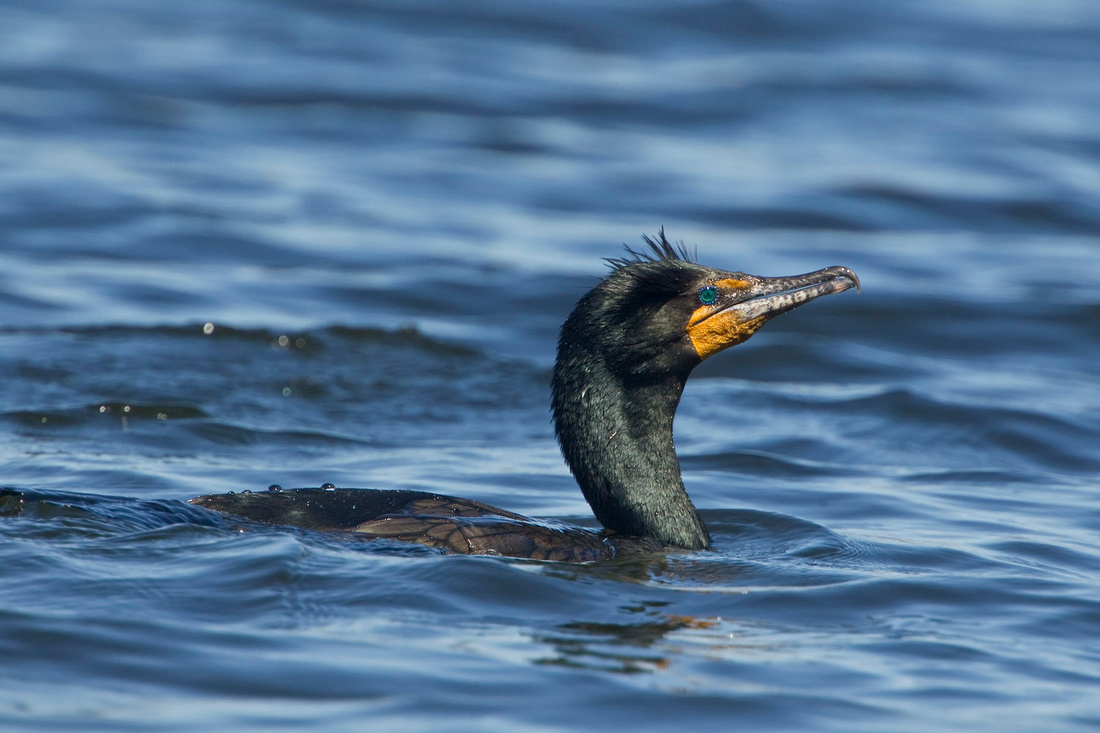 A few more shorebirds have arrived in coastal locations. The early nesting Killdeer are already on eggs, and seem to fly up from the strangest locations where they have chosen to nest (like the middle of a gravel parking lot), to distract innocent passers-by away.
A few more shorebirds have arrived in coastal locations. The early nesting Killdeer are already on eggs, and seem to fly up from the strangest locations where they have chosen to nest (like the middle of a gravel parking lot), to distract innocent passers-by away.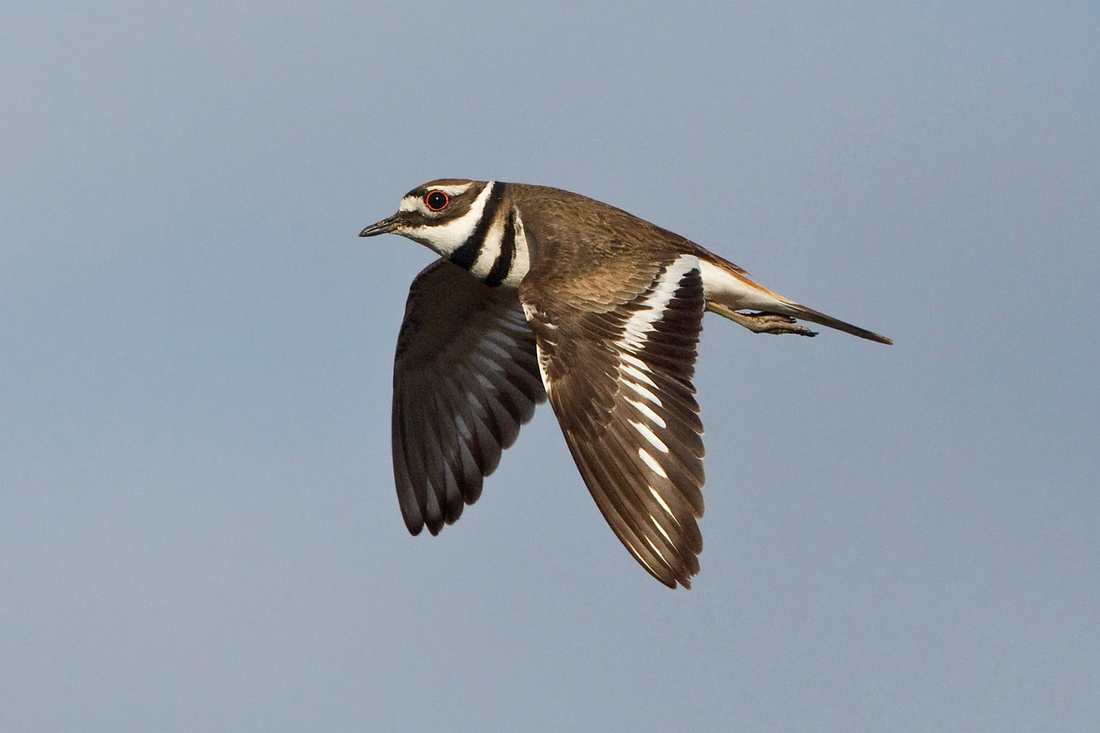 Noisy Willets have returned to marshes along the East River in Guilford, at Hammonasset, in Madison and Great Island in Old Lyme. Lesser Yellowlegs (pictured below) have joined their larger cousins both at Rocky Neck and Hammonasset.
Noisy Willets have returned to marshes along the East River in Guilford, at Hammonasset, in Madison and Great Island in Old Lyme. Lesser Yellowlegs (pictured below) have joined their larger cousins both at Rocky Neck and Hammonasset.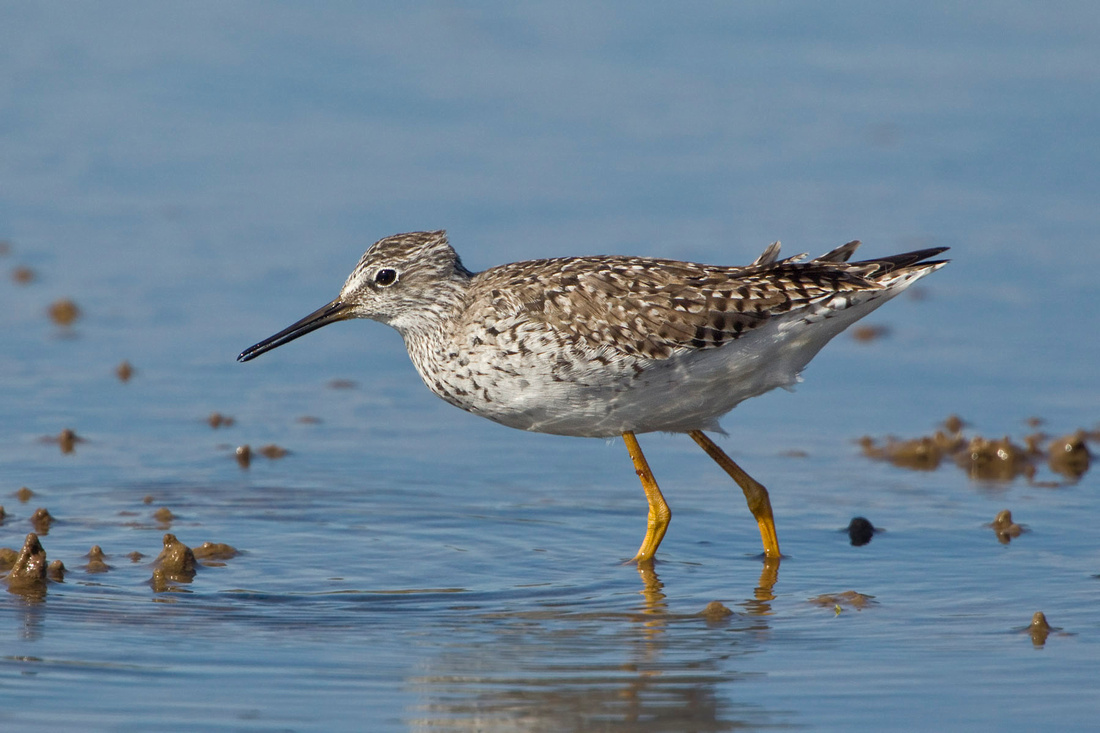
Also at Hammonasset last week, I spent a morning on a wild bittern chase, waiting a couple hours to see an American Bittern that had been seen repeatedly in a small creek area across from the Nature Center. I couldn't locate it at first, but after getting tips from a couple different birders, I did get a brief look at it as it walked across a small pond before disappearing again into the reeds. Another photographer joined me and we spent a while talking, hoping it might pop into the open again. I was about to give up the quest, when we decided to walk back toward the creek to see if it had stealthed it's way back there. I trained my binoculars down the length of the creek but did not see it. Luckily my friend, sans binoculars, took the wider view and found it frozen at the edge of the creek, just a few feet below us. Scrambling to take off my teleconverter and back up a little, I was able to get some shots of it as it hunted and caught a fish. Again, a bit of patience was rewarded.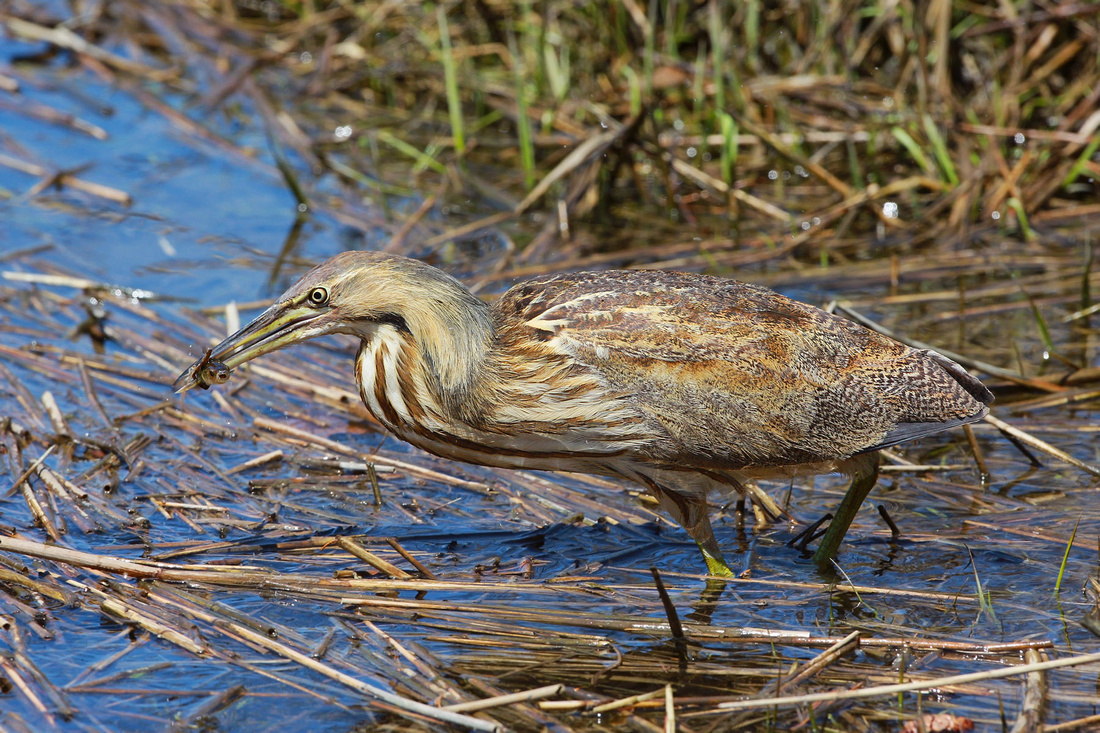
While taking a break from the bittern exercise, I took a detour to see the Purple Martins (top) and Tree Swallows (below) setting up shop near the Nature Center.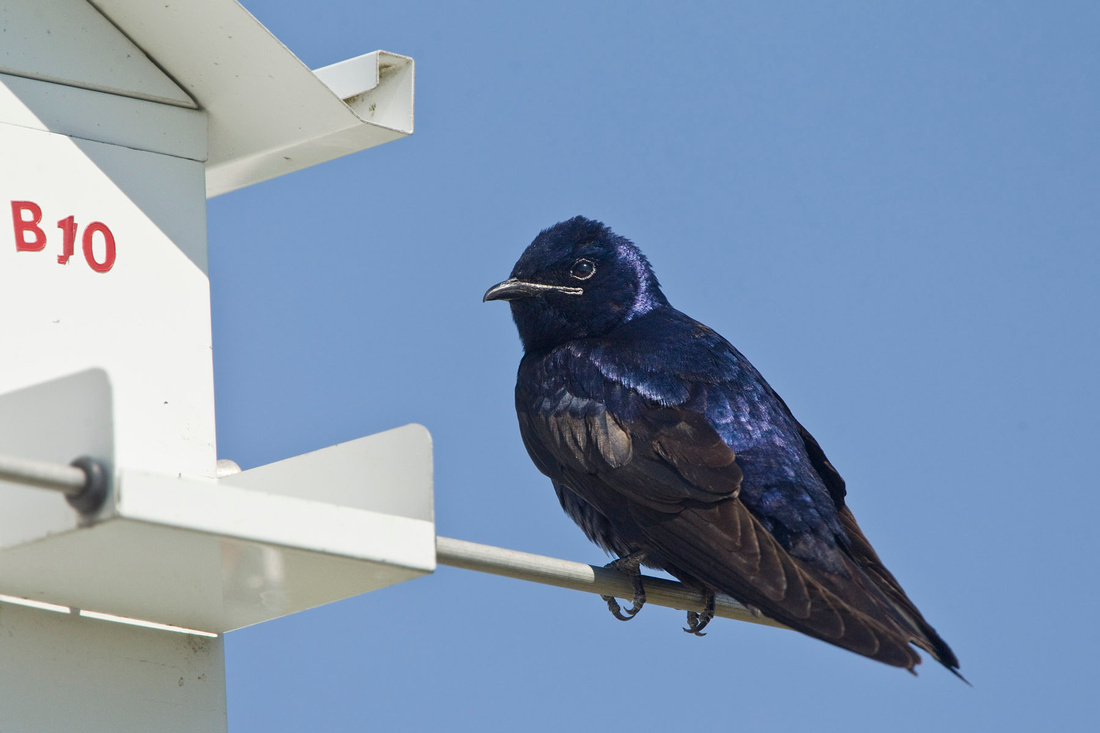
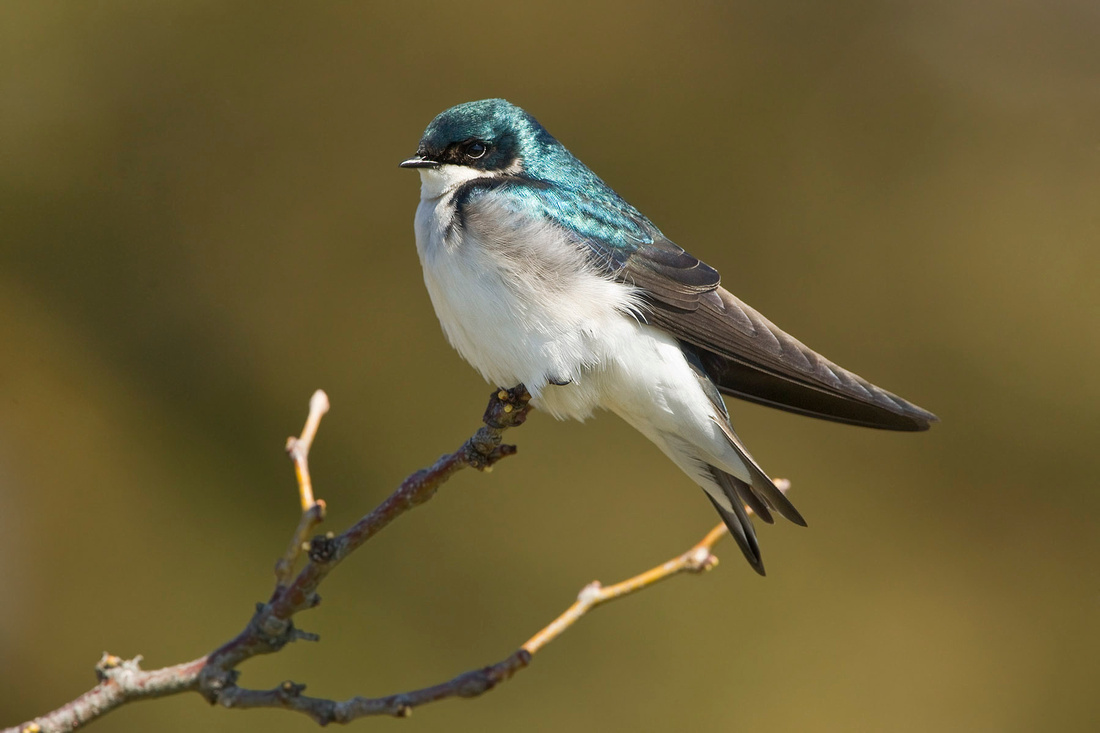 My main focus has been on migrant songbirds and I took several walks and drives through my favorite wooded spots in Lyme and East Haddam to look for warblers and other migrants that may have arrived. Towhees were the most often heard but seldom seen, except for the omnipresent Chipping Sparrow which could be seen and heard almost everywhere.
My main focus has been on migrant songbirds and I took several walks and drives through my favorite wooded spots in Lyme and East Haddam to look for warblers and other migrants that may have arrived. Towhees were the most often heard but seldom seen, except for the omnipresent Chipping Sparrow which could be seen and heard almost everywhere.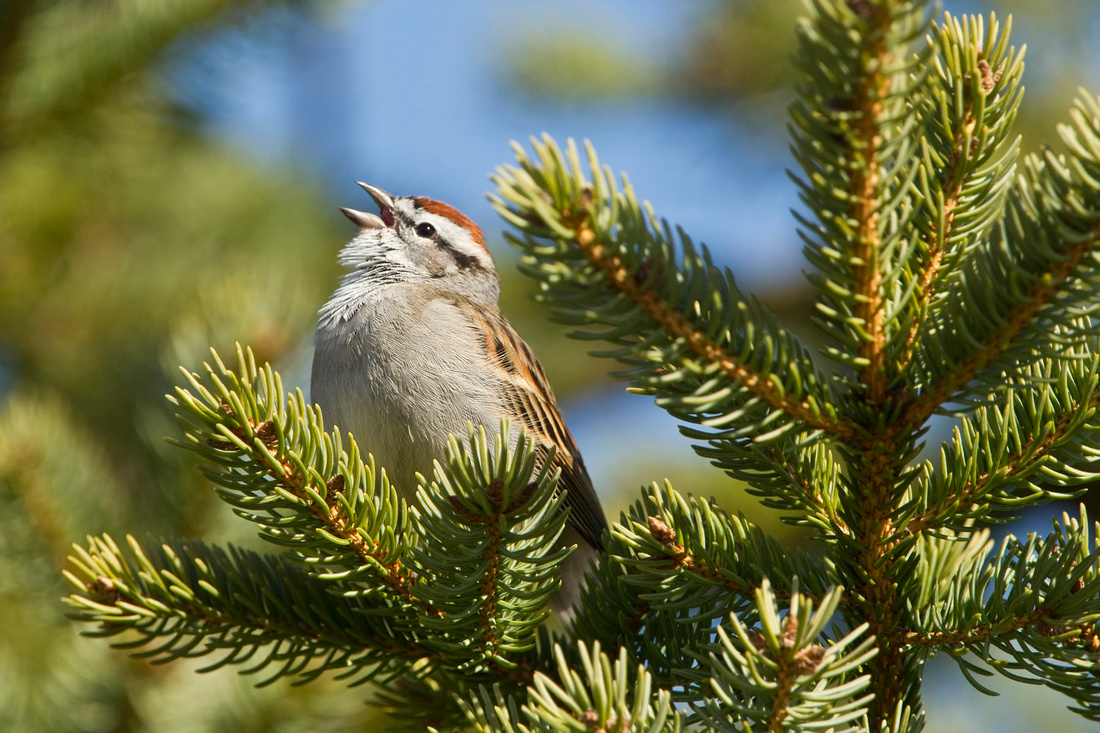
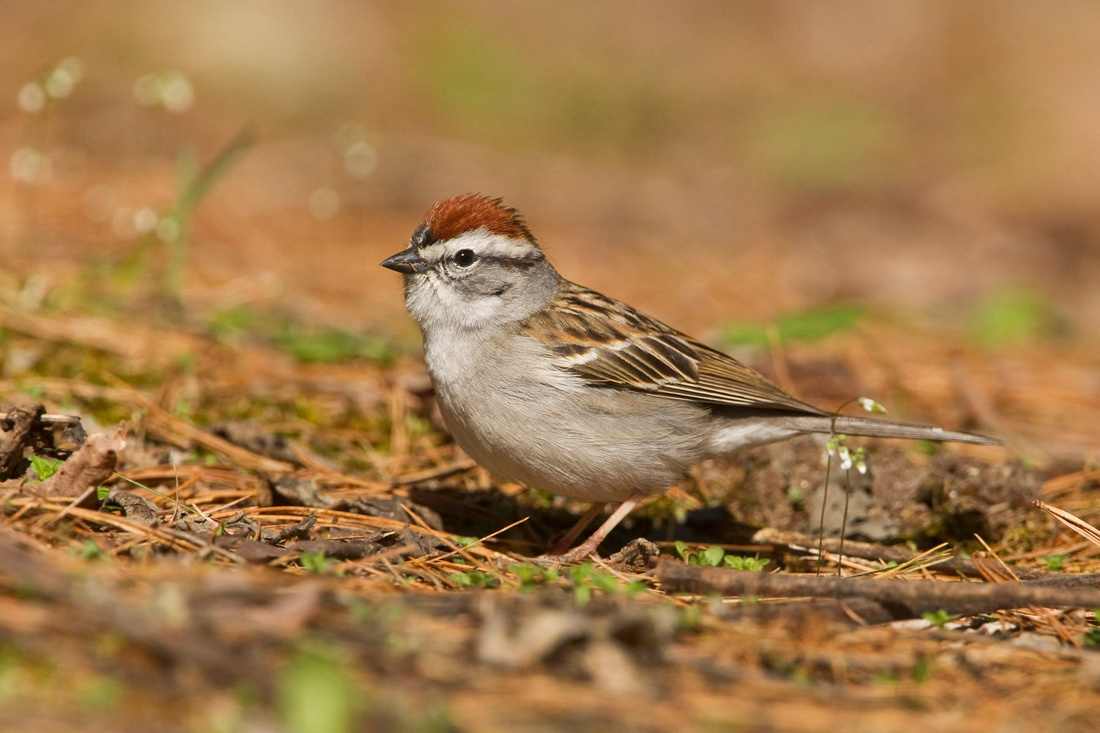 In a few locations, a more musical version of the rapid fire Chipping Sparrow song signaled the presence of a Pine Warbler, one of the earliest arriving migrant warblers.
In a few locations, a more musical version of the rapid fire Chipping Sparrow song signaled the presence of a Pine Warbler, one of the earliest arriving migrant warblers. In some locations, I found a few small pockets of warblers, including Yellow-rumped (the first this year as they have been unusually scarce this winter), Palm, a lone Ovenbird, Cerulean, Northern Parula and Blue-winged all foraging quietly, and a couple Louisiana Waterthrush singing sporadically. Blue-gray Gnatcatchers were numerous, but overall the woods were still frustratingly quiet. Again, I'll have to be patient, as eventually the woods will come alive with their songs.
In some locations, I found a few small pockets of warblers, including Yellow-rumped (the first this year as they have been unusually scarce this winter), Palm, a lone Ovenbird, Cerulean, Northern Parula and Blue-winged all foraging quietly, and a couple Louisiana Waterthrush singing sporadically. Blue-gray Gnatcatchers were numerous, but overall the woods were still frustratingly quiet. Again, I'll have to be patient, as eventually the woods will come alive with their songs.
Since the wave of migrant songbirds hasn't hit my home turf yet, I shifted focus and tried to work on some of the wintering seabirds that would soon be departing. At Hole-in-the-Wall Beach in Niantic, a few Horned Grebes remained, some nearing full breeding plumage. I draw some strange looks from beach goers, lying prone of the breakwater rocks waiting for birds to surface close by. Again, patience required. None of the grebes were bold enough to approach too close to shore but this nice looking one came the closest.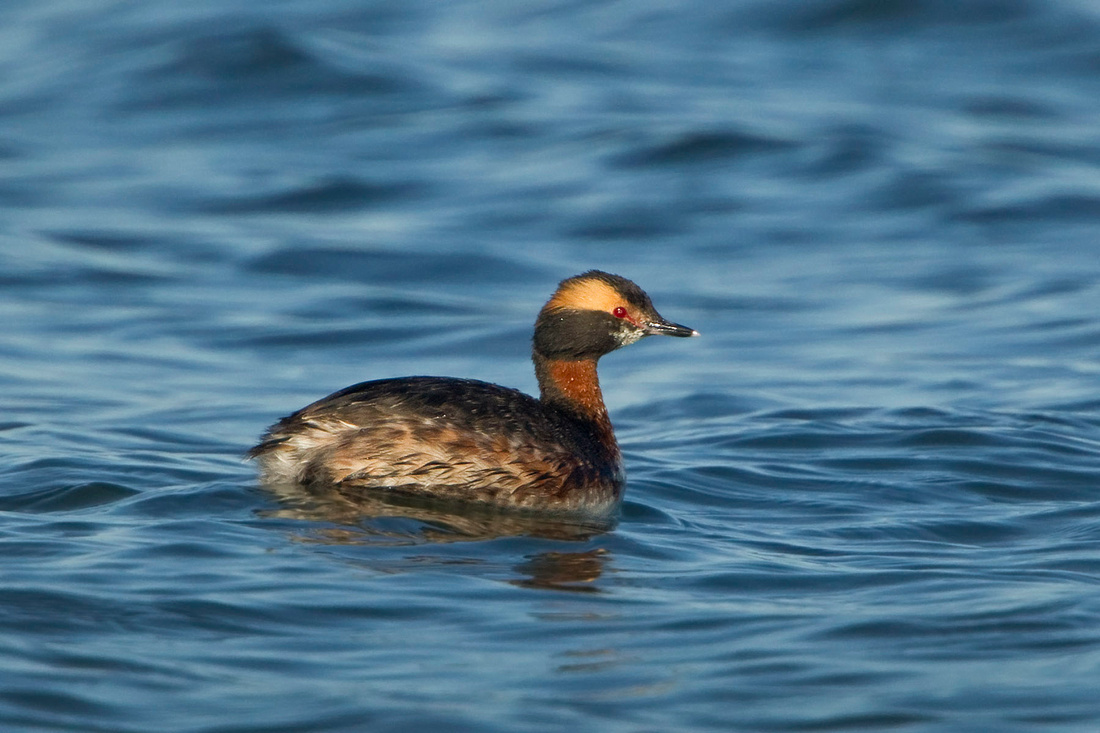
A few Red-breasted Mergansers also lingered, with the females showing the less dramatic, but more recent transformation into breeding plumage (a black ring around their eyes).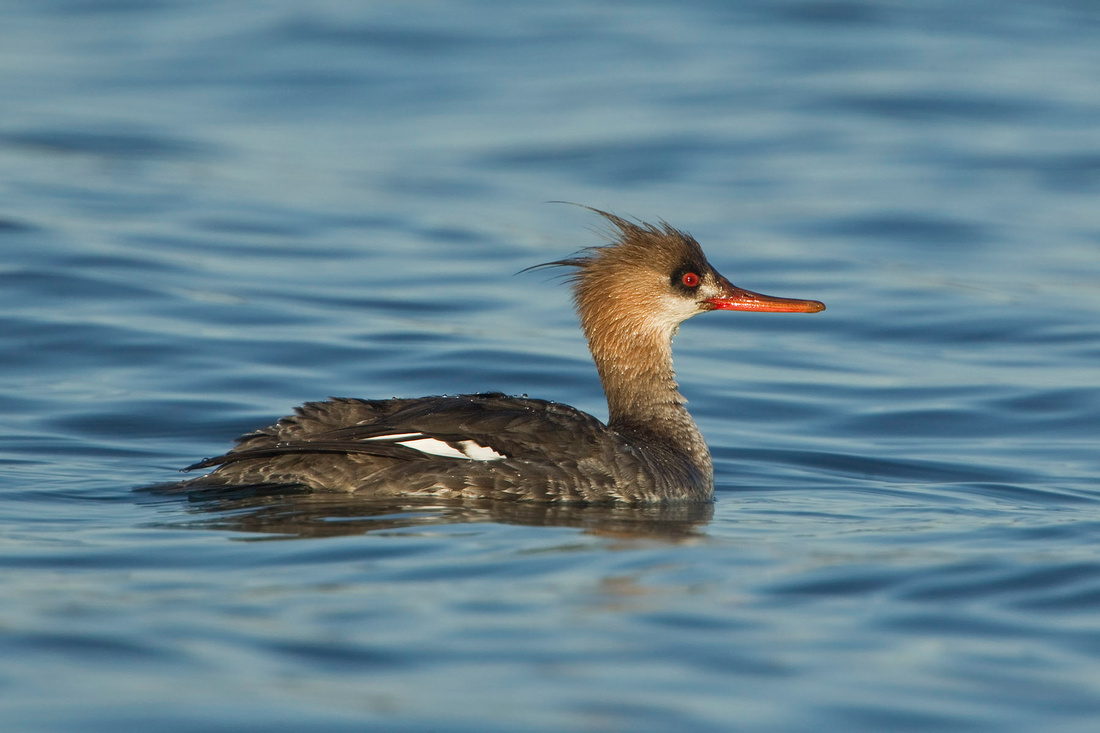
The most dramatic transformation goes to the Common Loon, which turns from drab winter gray to striking black and white and irridescent green. I found that one loon would make a few passes close to shore in the afternoon diving for crabs. The pictures were taken over the last two weeks and show some the final phase of this dramatic transformation. 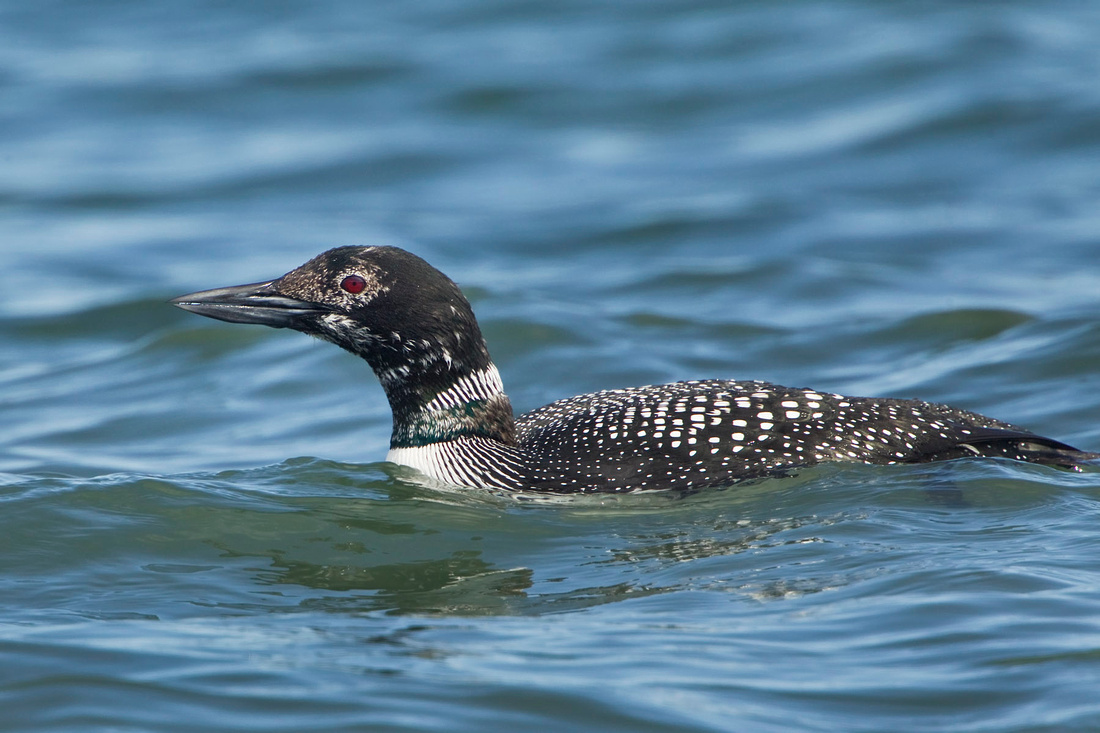
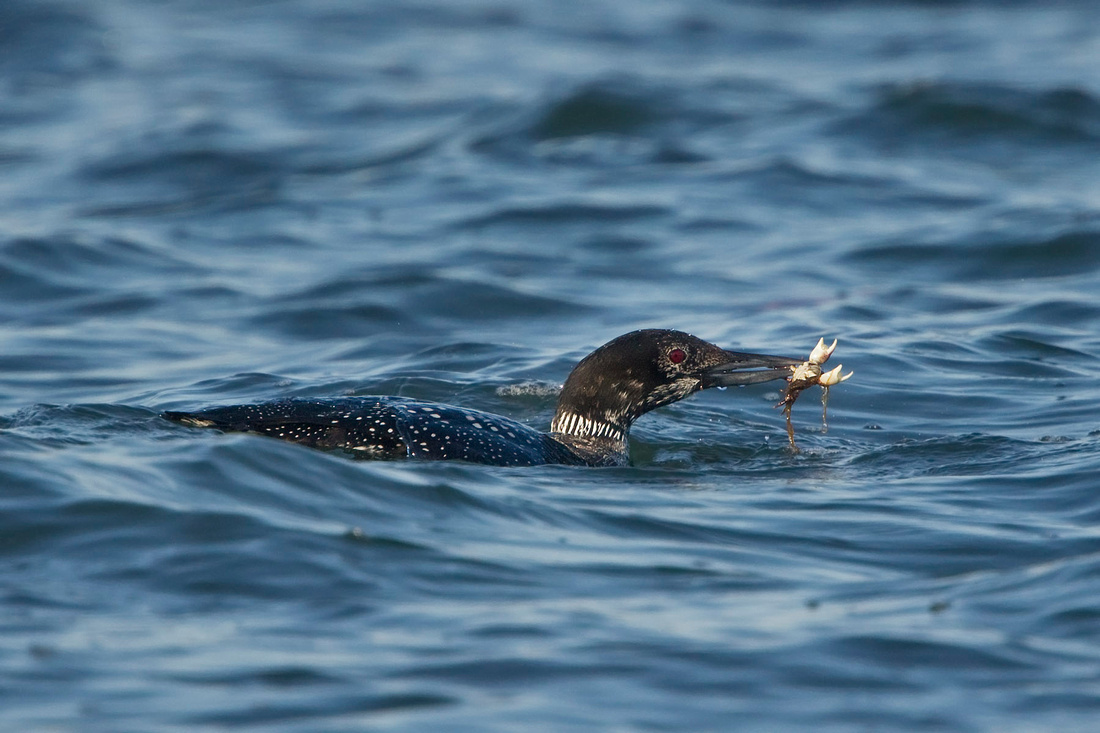
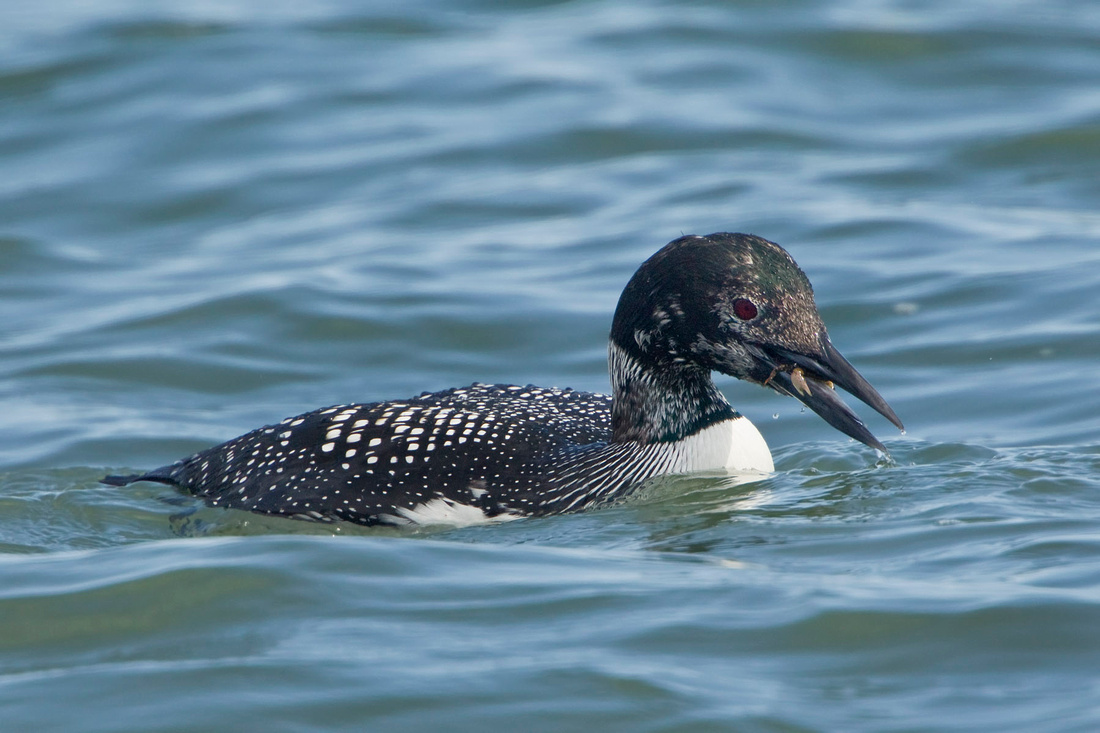

 I often assign myself specific subjects to work on each year, and sometimes I do not get around to it. Many years I've vowed to work on Common Loons in breeding plumage (one of the most beautiful birds in my opinion) but have never gotten to it. This is especially troubling since they are the closest of the loon species to reach, breeding in northern New England, yet I have many more photos of Pacific and Red-throated Loons which breed near the arctic. This year, they are again one of my targets, and hopefully I'll break through finally.
I often assign myself specific subjects to work on each year, and sometimes I do not get around to it. Many years I've vowed to work on Common Loons in breeding plumage (one of the most beautiful birds in my opinion) but have never gotten to it. This is especially troubling since they are the closest of the loon species to reach, breeding in northern New England, yet I have many more photos of Pacific and Red-throated Loons which breed near the arctic. This year, they are again one of my targets, and hopefully I'll break through finally.
As for my Big Year, I'm up to 150 species of birds in Connecticut, and that should starts growing in leaps and bounds in the next few weeks. I'll need to see just about every expected migrant and breeding bird species in the state, and still get lucky with some rarities if I'm going to reach 300 though.
]]>Of course not everything in nature is entirely predictable. By repeatedly visiting the same spots, I occasionally find that one of my regular patches gets really active, and turns into a hotspot. When that happens, I try to concentrate on that one area to take advantage of all the activity. To use a sports analogy, it's like riding the hot hand.
Rocky Neck State Park is only a couple miles from my home, and is one of the patches I frequent, but it's usually not one of my favorite or most productive spots. At most times of the year, there are other areas nearby that I spend a lot more time at, but the exception is in early April. At this time of year, Rocky Neck is a hotspot of activity. Osprey return to the area and begin their nesting routine and a variety of ducks stage in the marsh before their migration north. The marsh is also teeming with gulls, egrets, herons, Glossy Ibis and Double-crested Cormorants. Every year at this time I visit the the park often to photographing them, and this year is no different. 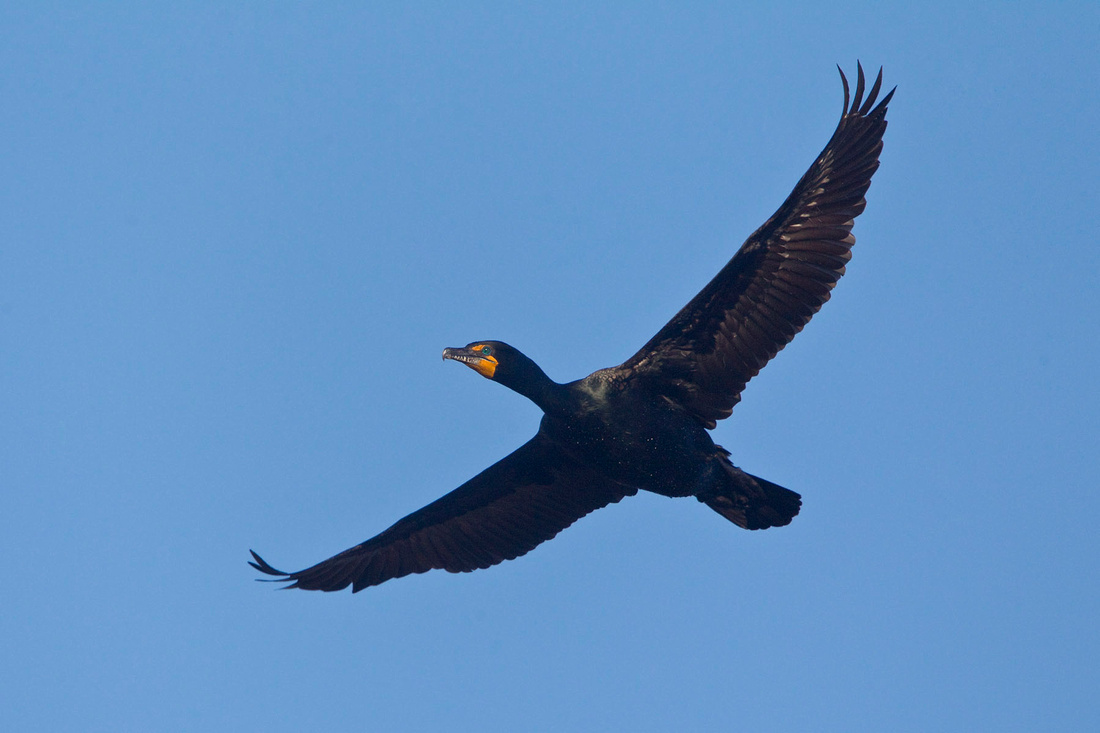 The cormorants are one of my favorites, as they gather in the marsh to fish, and collect sticks for their sparse nests. Not the most agile birds in flight, it takes them some time to gain altitude, and they often fly out of the marsh at a very low height. I like to wait at the spots they fly out of and photograph them as they wing past, often carrying a single tiny twig for their nests on the rocky offshore islands. One day this past week, I heard a crashing sound in the trees and turned to see a cormorant that had struck a tree top, and tumbled all the way down through the branches, before hitting the ground. None the worse for its ordeal, it shook itself off and flew back out into the marsh.
The cormorants are one of my favorites, as they gather in the marsh to fish, and collect sticks for their sparse nests. Not the most agile birds in flight, it takes them some time to gain altitude, and they often fly out of the marsh at a very low height. I like to wait at the spots they fly out of and photograph them as they wing past, often carrying a single tiny twig for their nests on the rocky offshore islands. One day this past week, I heard a crashing sound in the trees and turned to see a cormorant that had struck a tree top, and tumbled all the way down through the branches, before hitting the ground. None the worse for its ordeal, it shook itself off and flew back out into the marsh.
Egrets abound in the salt marsh, gathering to hunt fish in the shallow tidal pools. Snowy Egrets, as part of their breeding rituals, emit rude, guttural squawks every time the fly from one puddle to the next, belying their graceful motions and elegantly plumed appearance. Great Egrets, less noisy than the than their smaller relatives, show off their own fine plumes and the lime green lores of their breeding plumage. The Snowies are still a bit behind developing their vivid red lores. 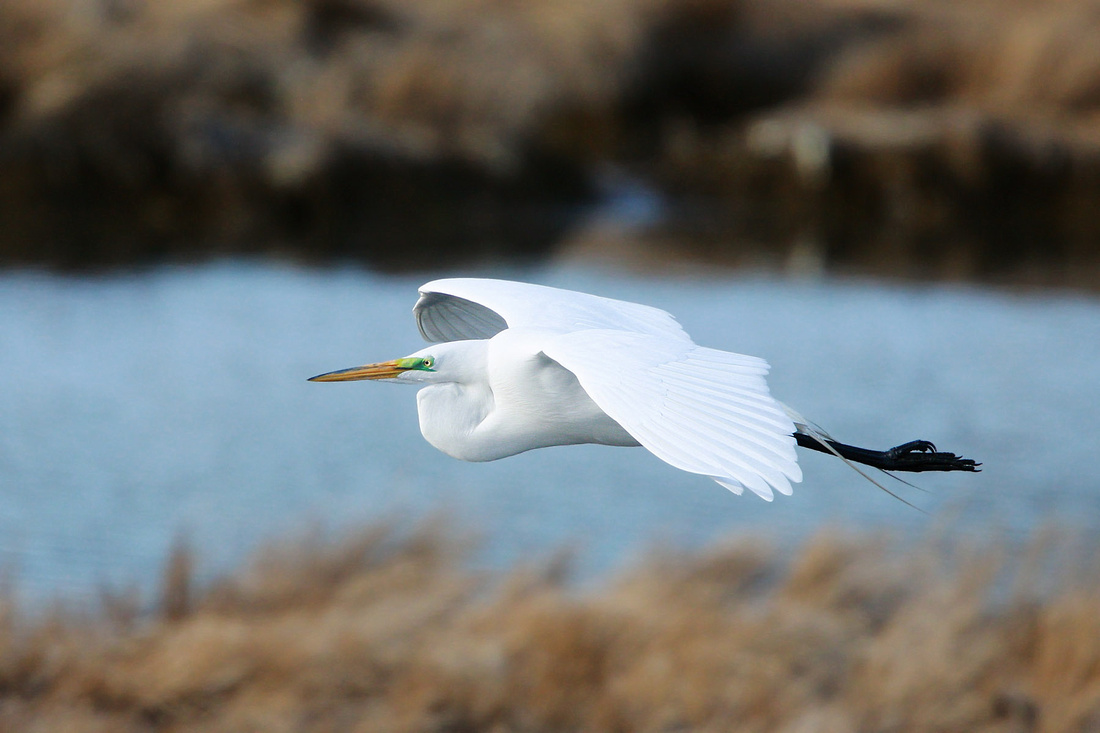
 The most exciting thing to photograph is the Osprey activity as they fish and set up their nests. Osprey time their arrival here with that of the river herring, particularly Alewives, which return from the ocean each spring, heading up into rivers, streams and eventually into ponds where they spawn. The Bride Brook, which runs through Rocky Neck has one the healthiest herring runs remaining in Connecticut, where they have suffered a decades-long decline. Every spring Osprey follow the thick schools of herring as they make their way up into the brook and surrounding salt marsh. This years there seemed to be more Osprey fishing in the marsh than I can remember. I was able to count 12 Osprey in the marsh at one time, including three birds jockeying for position over one small pool in search of the fish.
The most exciting thing to photograph is the Osprey activity as they fish and set up their nests. Osprey time their arrival here with that of the river herring, particularly Alewives, which return from the ocean each spring, heading up into rivers, streams and eventually into ponds where they spawn. The Bride Brook, which runs through Rocky Neck has one the healthiest herring runs remaining in Connecticut, where they have suffered a decades-long decline. Every spring Osprey follow the thick schools of herring as they make their way up into the brook and surrounding salt marsh. This years there seemed to be more Osprey fishing in the marsh than I can remember. I was able to count 12 Osprey in the marsh at one time, including three birds jockeying for position over one small pool in search of the fish.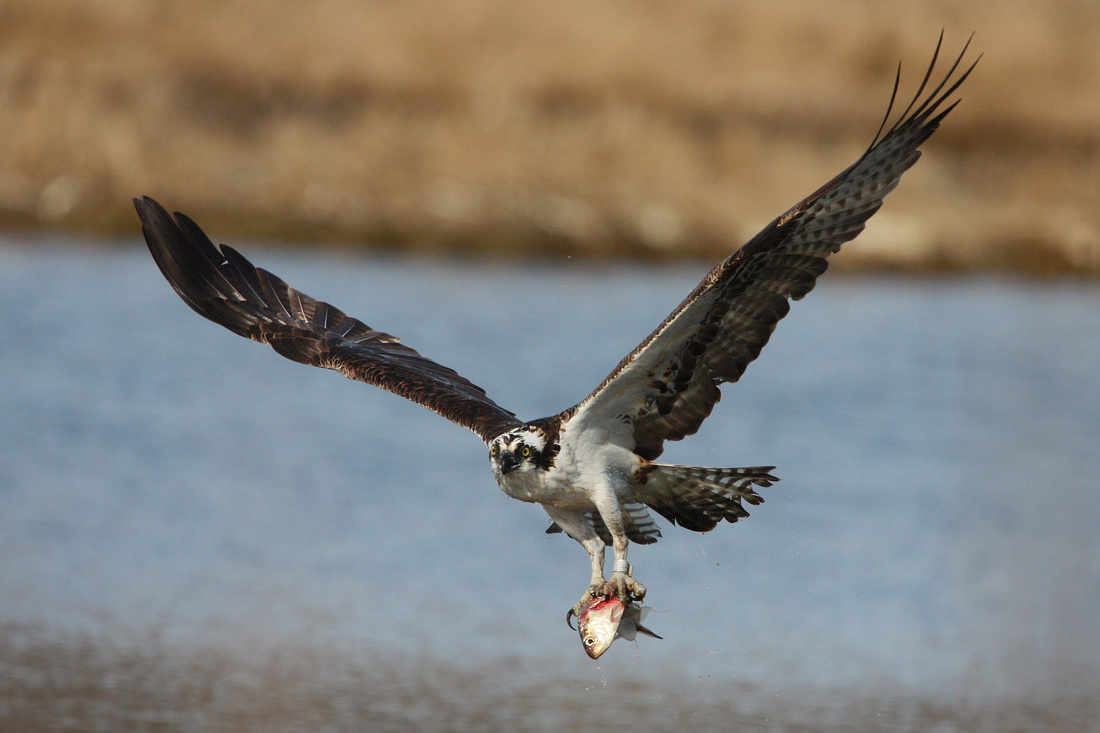
The reason for the increased number of Osprey might signal some good news for a change. I have been interested in the plight of river herring for a several years, since I worked on a story for the Hartford Courant about the Connecticut DEP (now DEEP) efforts to restore the diminishing runs. Earlier this week I stopped at one of the streams that was being restored to see how the fish were running and was surprised to find a big school them. As I was setting up to photograph them, a DEEP technician I first met while working on the Courant story stopped there to count the fish. He told me that last year the number of river herring returning increased, particularly in New London County and this year the early results were also promising, leading to some guarded optimism. The picture below shows the school of Alewives.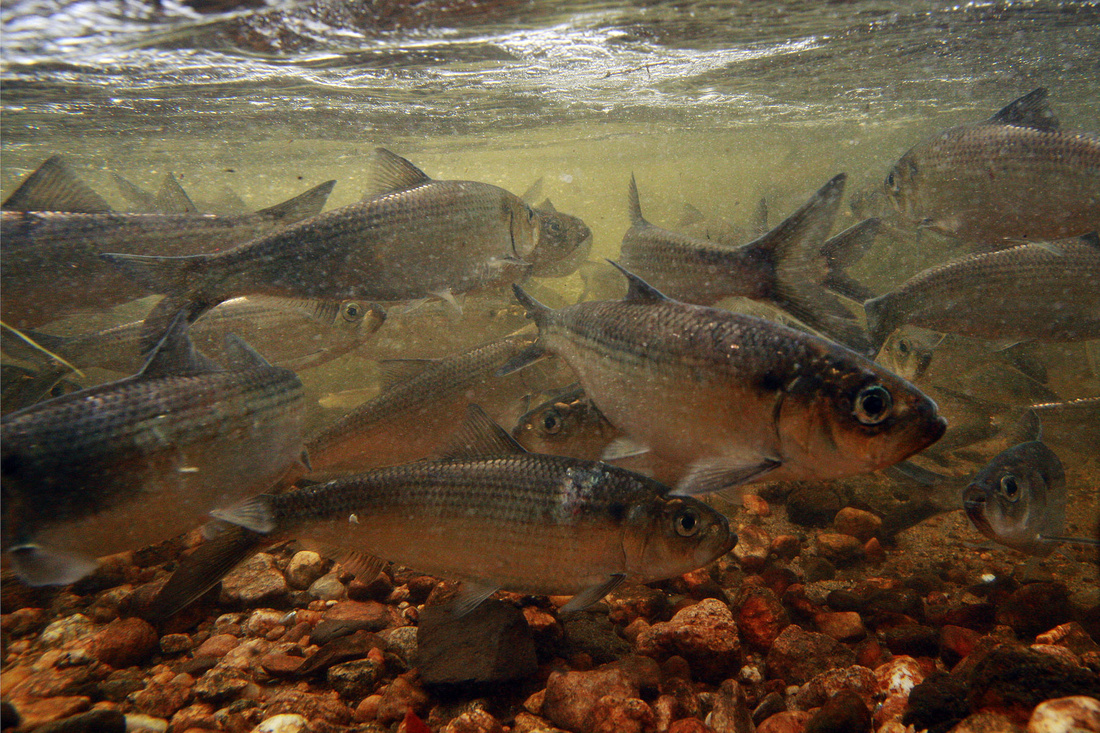
Since Rocky Neck was so hot, I went there every morning and evening that I could. All the pictures in this post except the one above were taken there this past week. I spent a lot of time trying to catch all the different stages of the Osprey's dive for fish, including the first stage when they tuck their wings and plummet towards the water, head first.
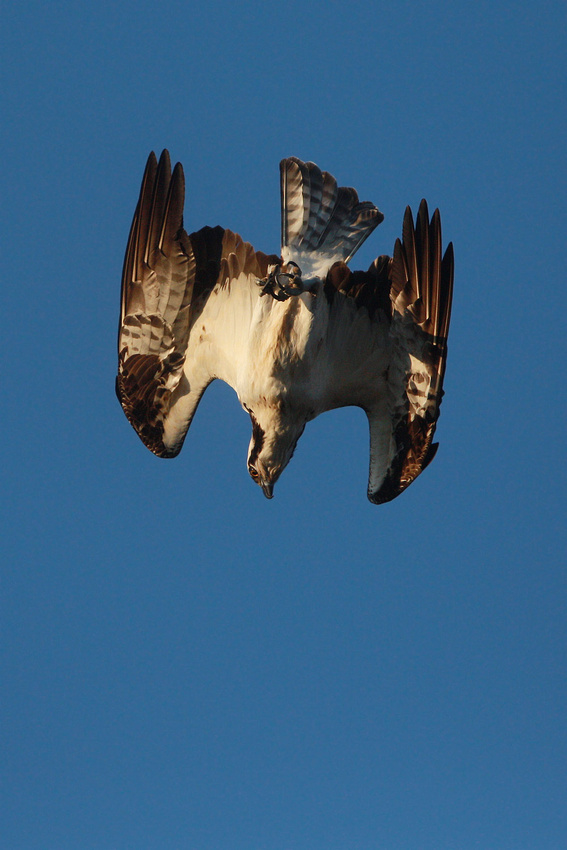
...... followed by the downward glide where they start to deploy their landing gear ......... 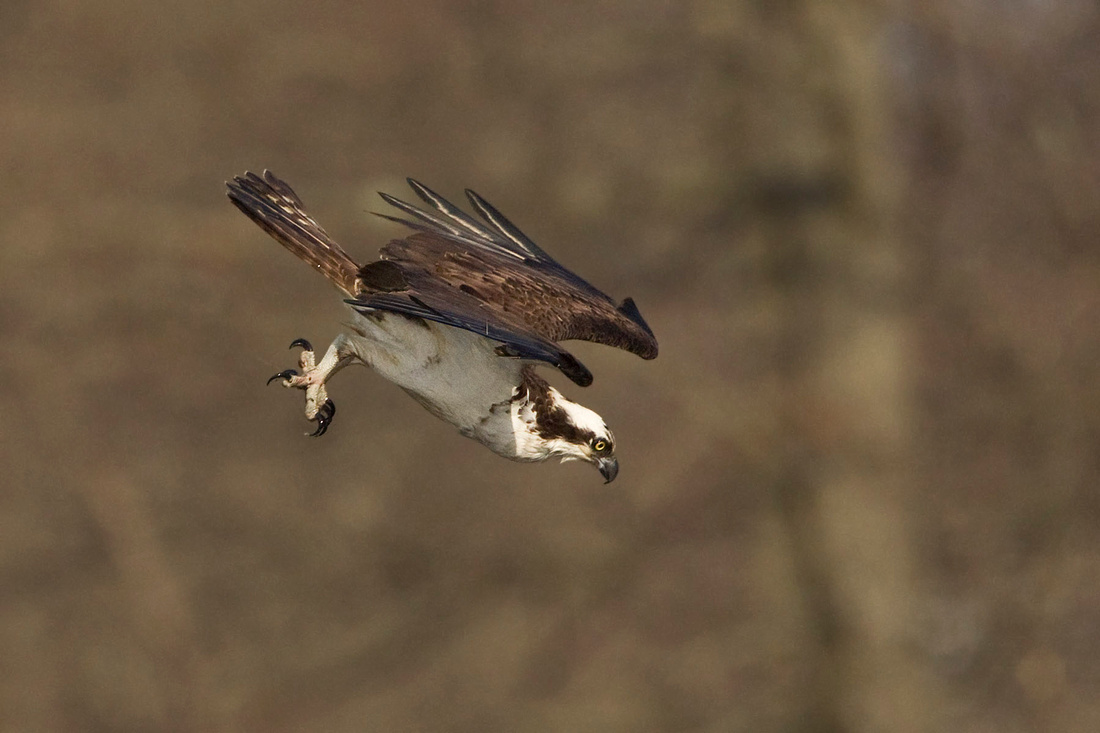
.... and then the hardest to capture, where they throw there feet forward just before hitting the water.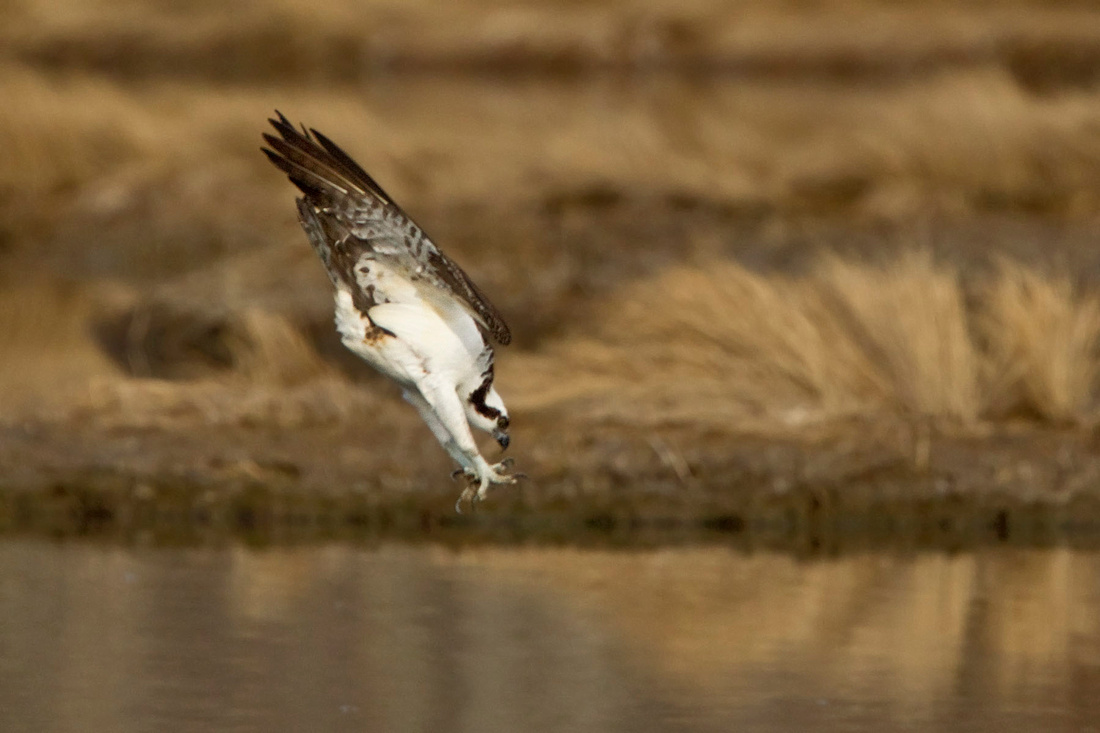
.... which I still need to work on because all my pictures are either soft (not in sharp focus) or completely out of the frame. And then the catches ...

and misses, which were split about 50/50.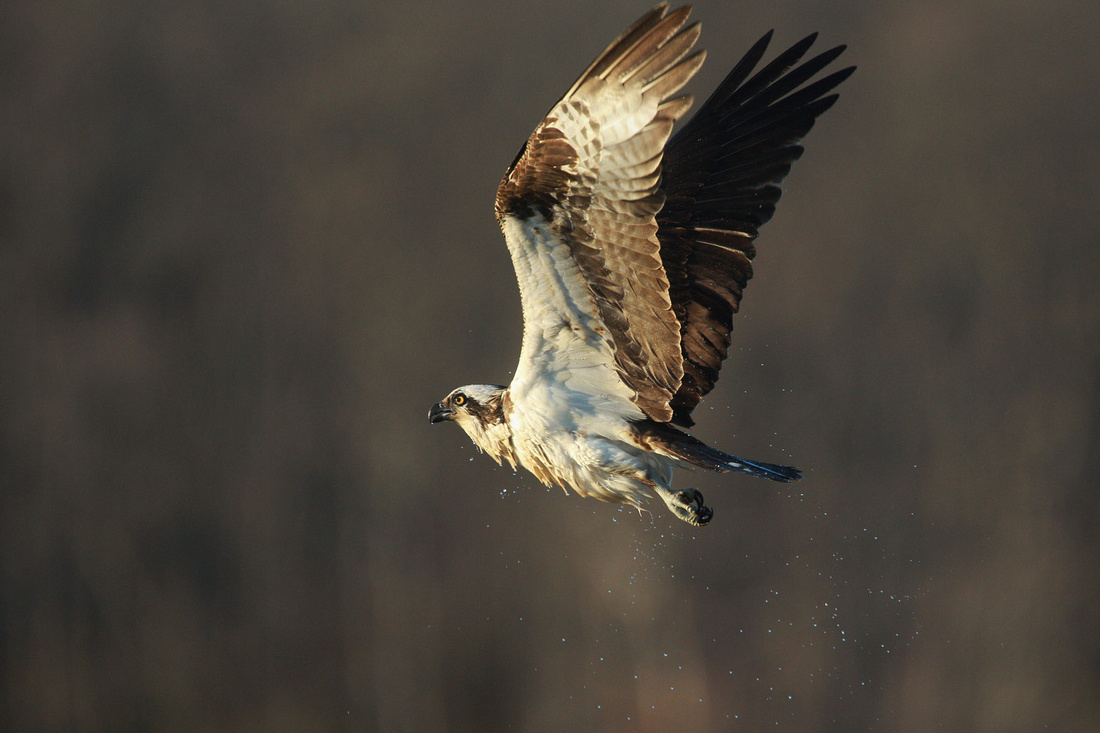
One Osprey hit the daily double, coming up with two fish in one try 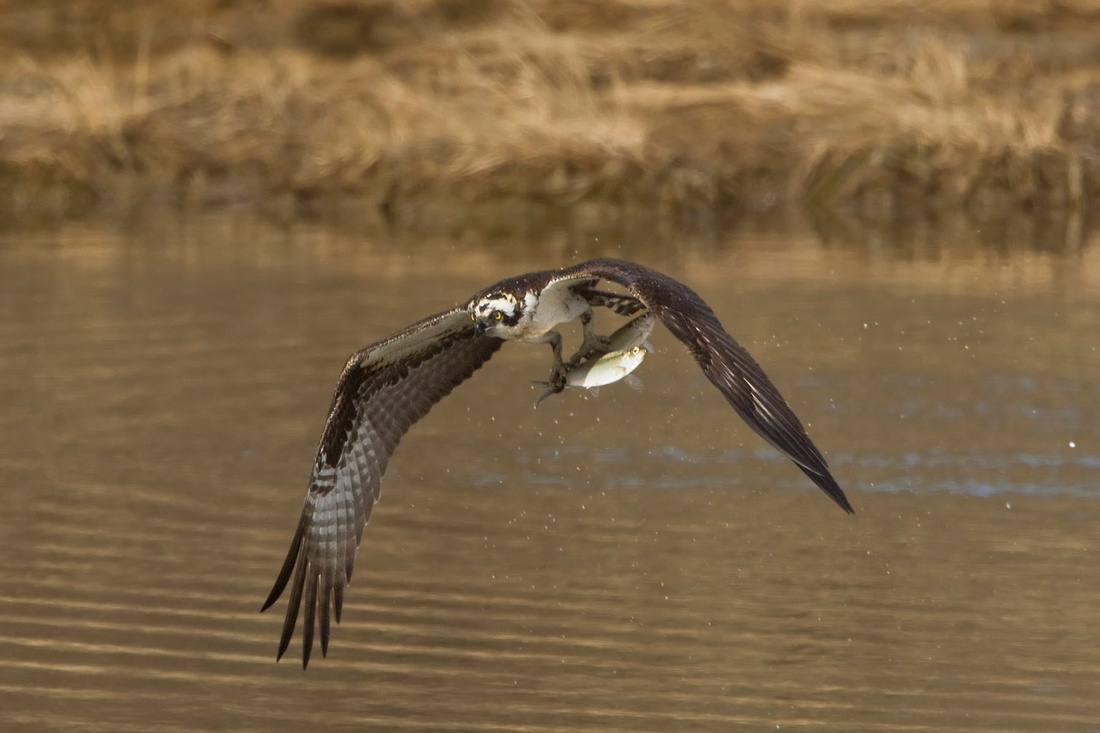
but then couldn't hold both of them, and dropped one back into the water.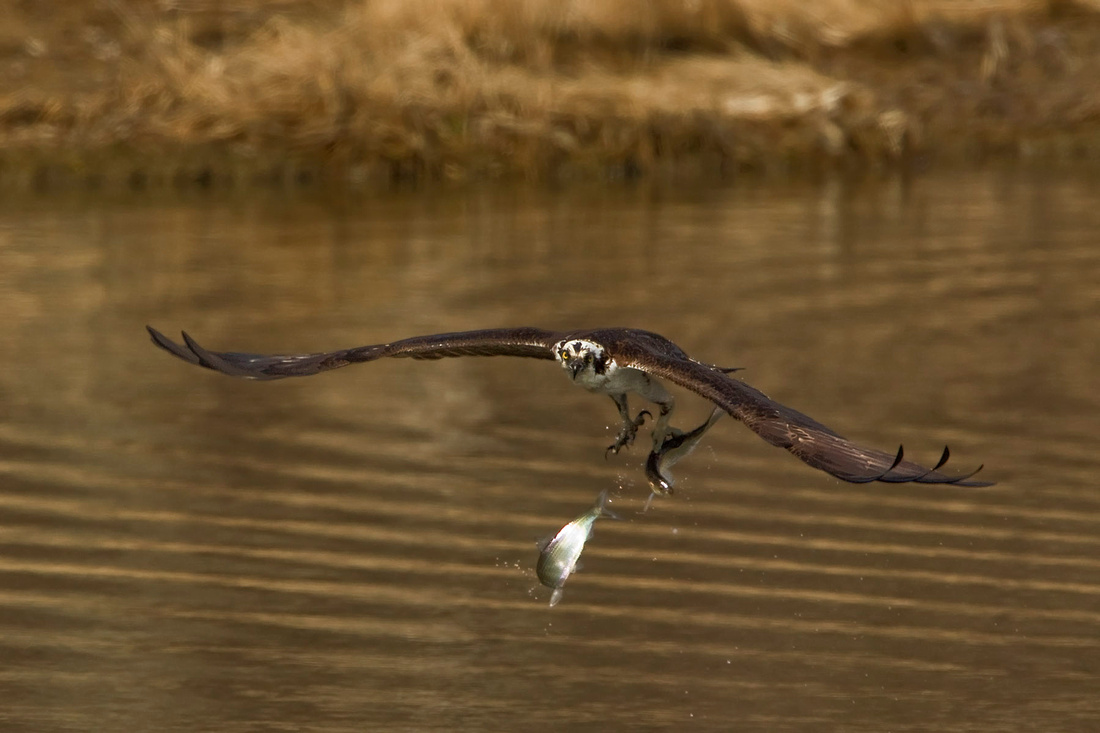
While I continued following the Osprey, now with only one fish, I didn't see what became of the dropped fish, but a few seconds later an aptly named Herring Gull flew by with a mouthful .....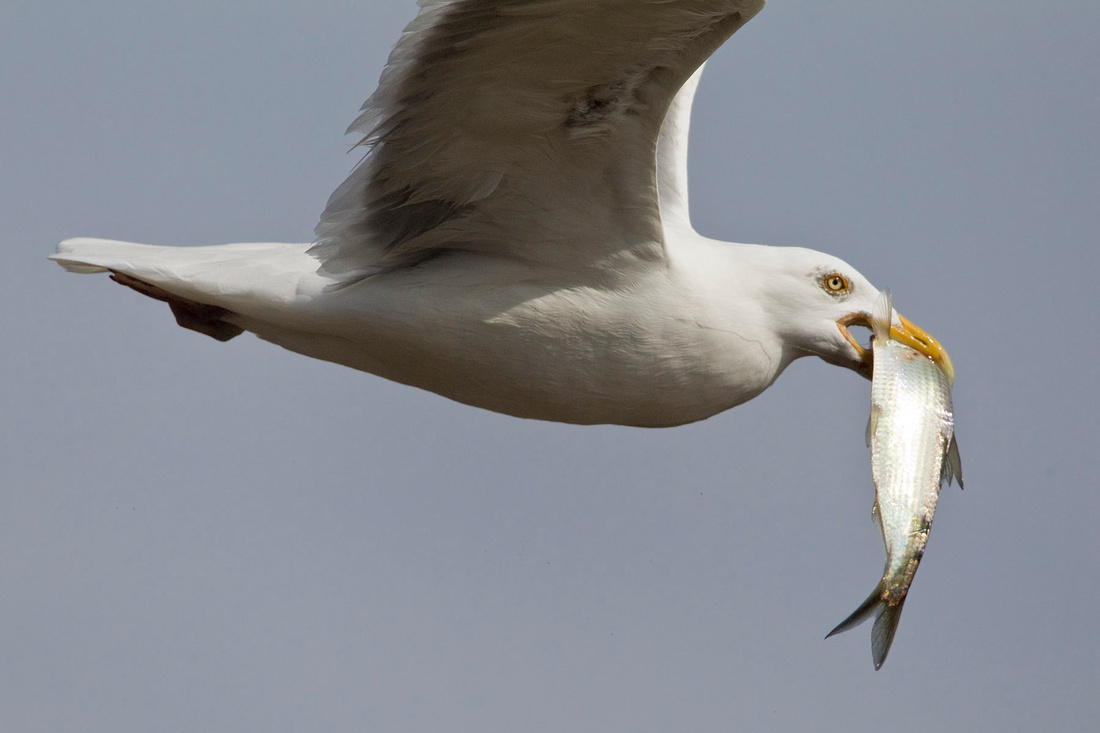
......... which it proceeded to gulp down in mid flight.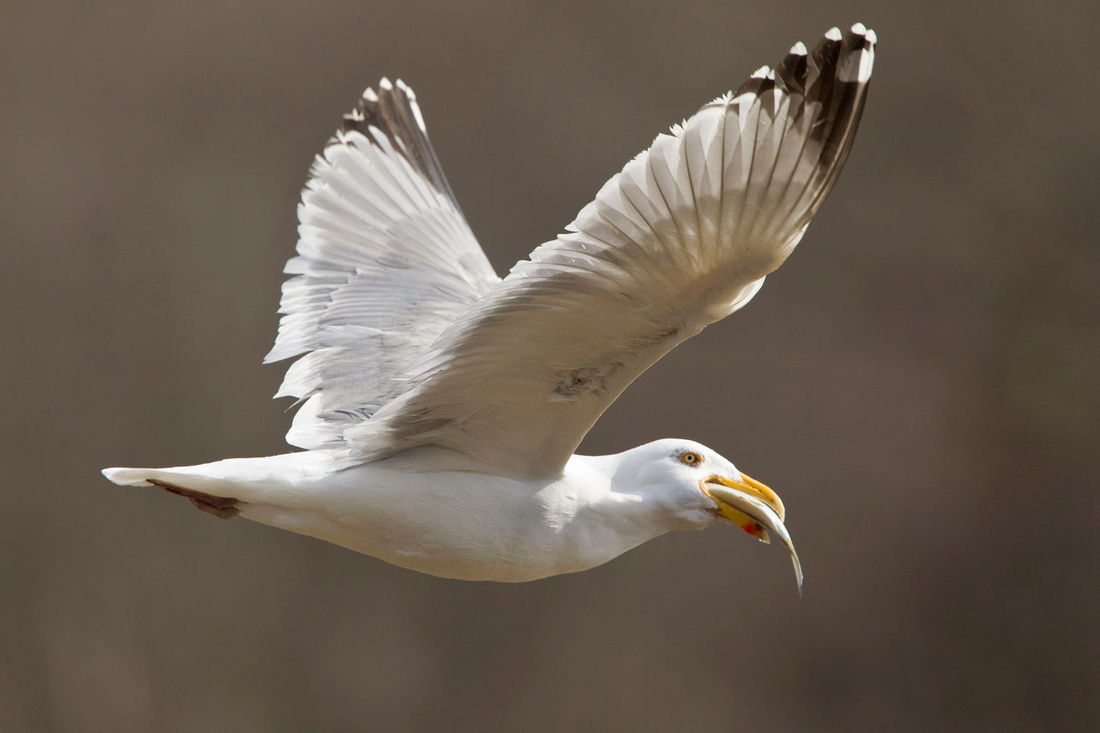
Adding to the excitement this year is the presence of two sub-adult Bald Eagles. Both appear to be four year old year birds, and at least one has been around every day I've visited the park recently. 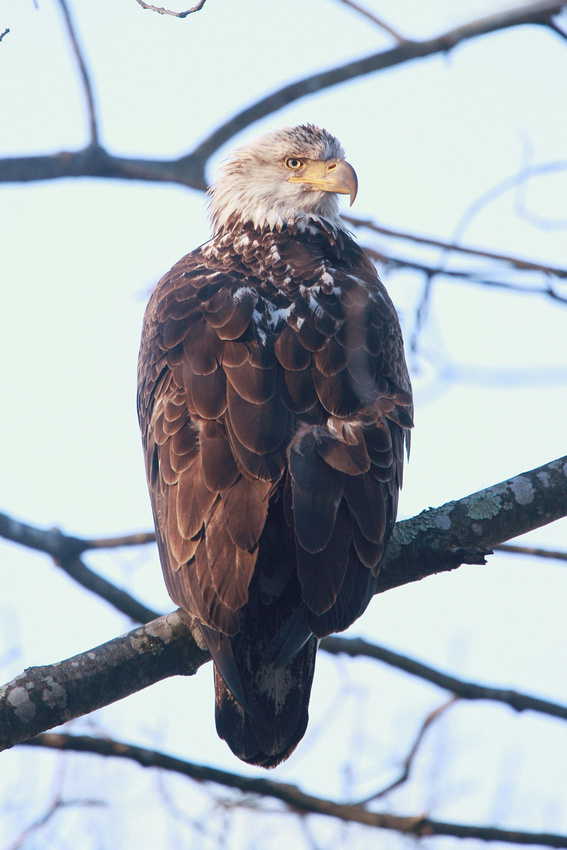
Occasionally one or both of them fly out over the salt marsh putting every bird around into the air.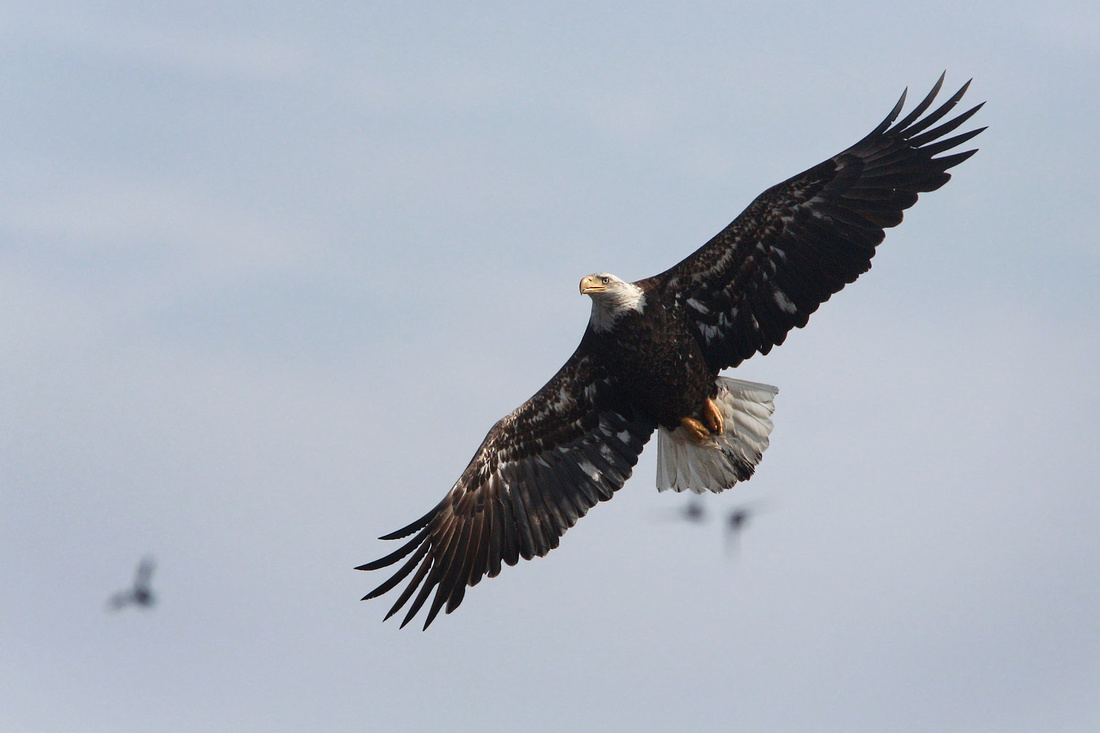
but, most of the time I see them, they are sitting in the trees on the west side of the marsh, waiting for an Osprey to catch a fish ........
then the eagles fly out from the trees and the chase is on.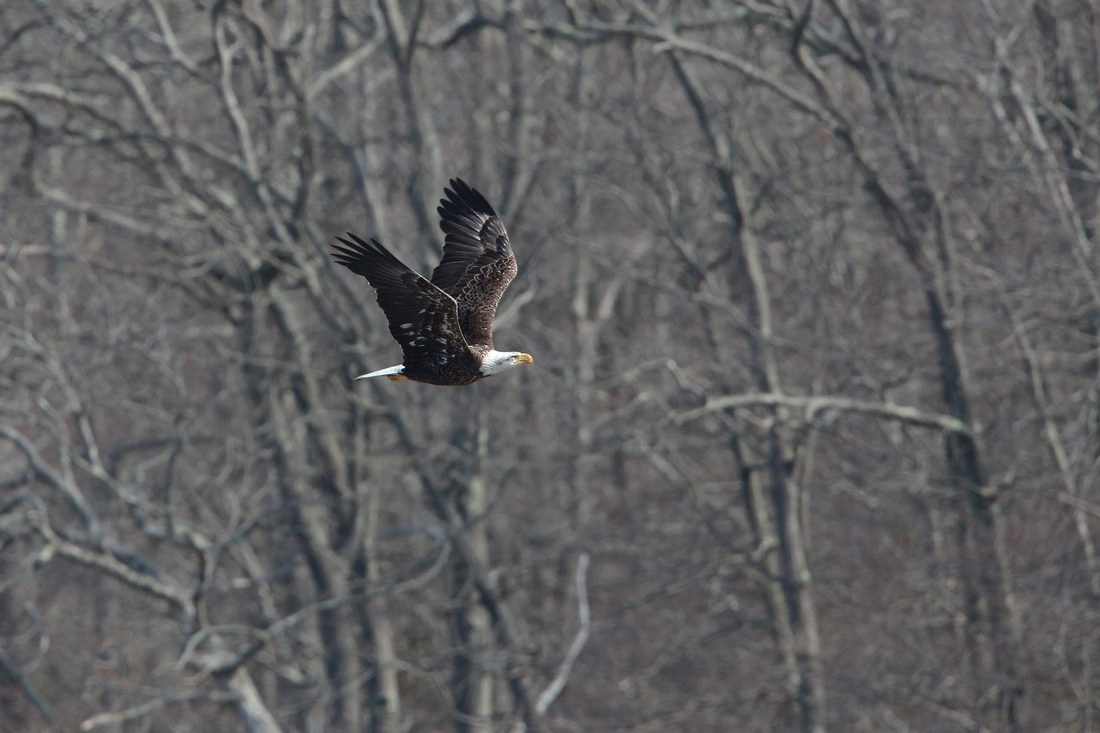
One eagle chased an Osprey returning to its nest with a clump of seaweed for nearly a minute (based on the time stamps from my pictures). The eagle was close enough to easily see the seaweed, but continued the chase until the Osprey released it and the eagle grabbed it in midair. The pursuer returned to its perch with the loot, and was joined by its cohort, but they seemed a bit puzzled by what to do with it.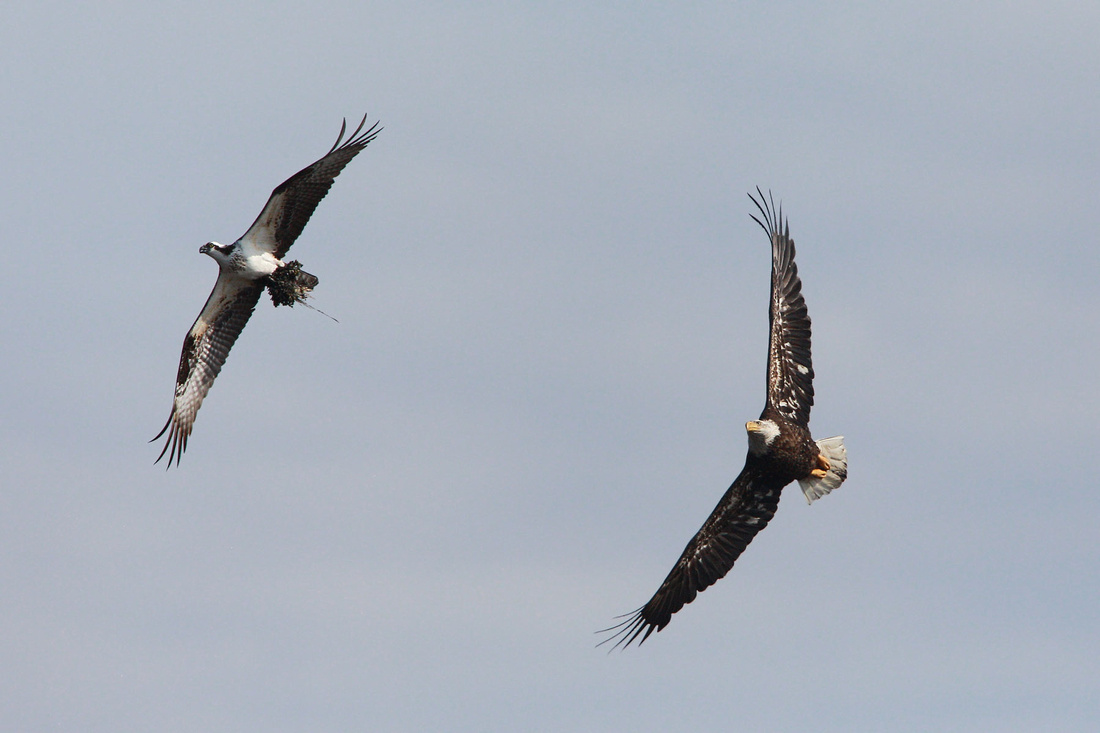
The high number of Osprey in the marsh following the herring run has had the resident nesting Osprey pair on edge. By the end of the week the resident male spent much of his time trying to drive off the interloping Osprey, fishing in close proximity to their nest. Some of the intruders flew over their nest clutching fish and chirping loudly in an attempt to lure the nesting female away, which drew more aggitated responses from the male. Add to that the presence of the Bald Eagles, making every bird in the marsh nervous, and the stage was set for high drama. With the resident Osprey continually chasing off other Osprey, the Bald Eagles chasing Osprey with fish, even the lowly Herring Gulls pursuing Osprey with fish on occasion, there was seldom a dull moment (a slight exaggeration) in the park the past week. Even a nervy Red-winged Blackbird got into the act, hounding a poor Osprey that strayed too close singing perch.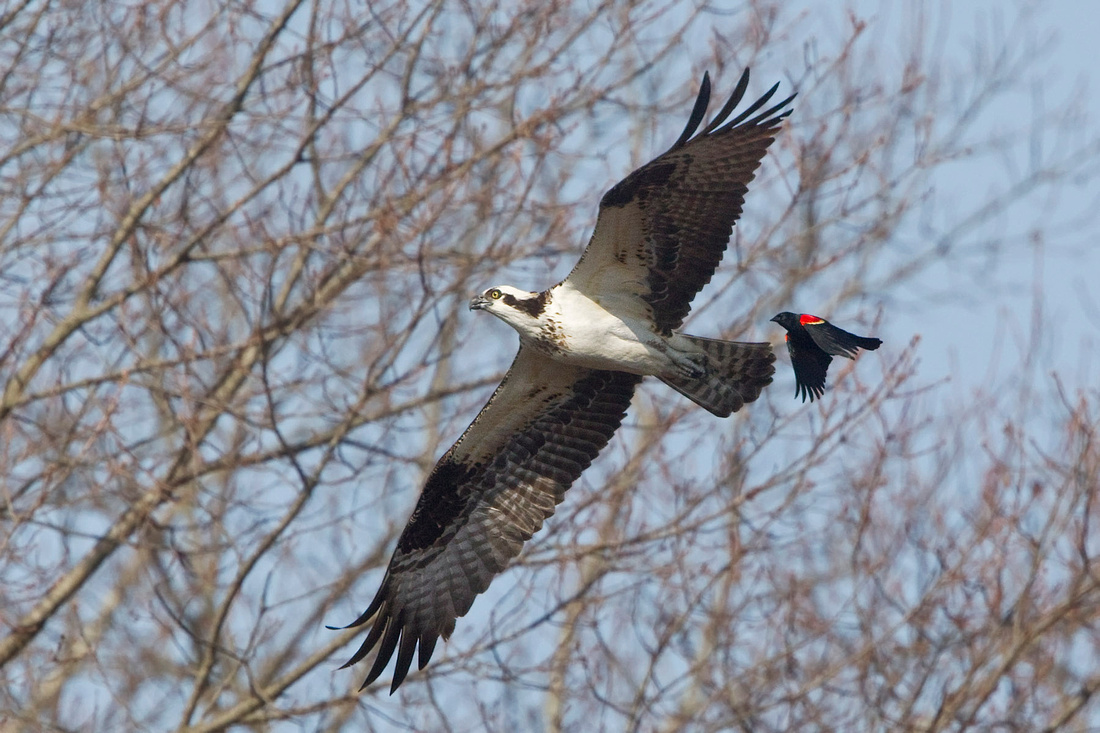
Add to that the squawking egrets, the dozens of ducks erupting into the air at the sight of the eagles and the comings and goings of the awkward cormorants and Rocky Neck has been quite a hot spot the past week.
]]>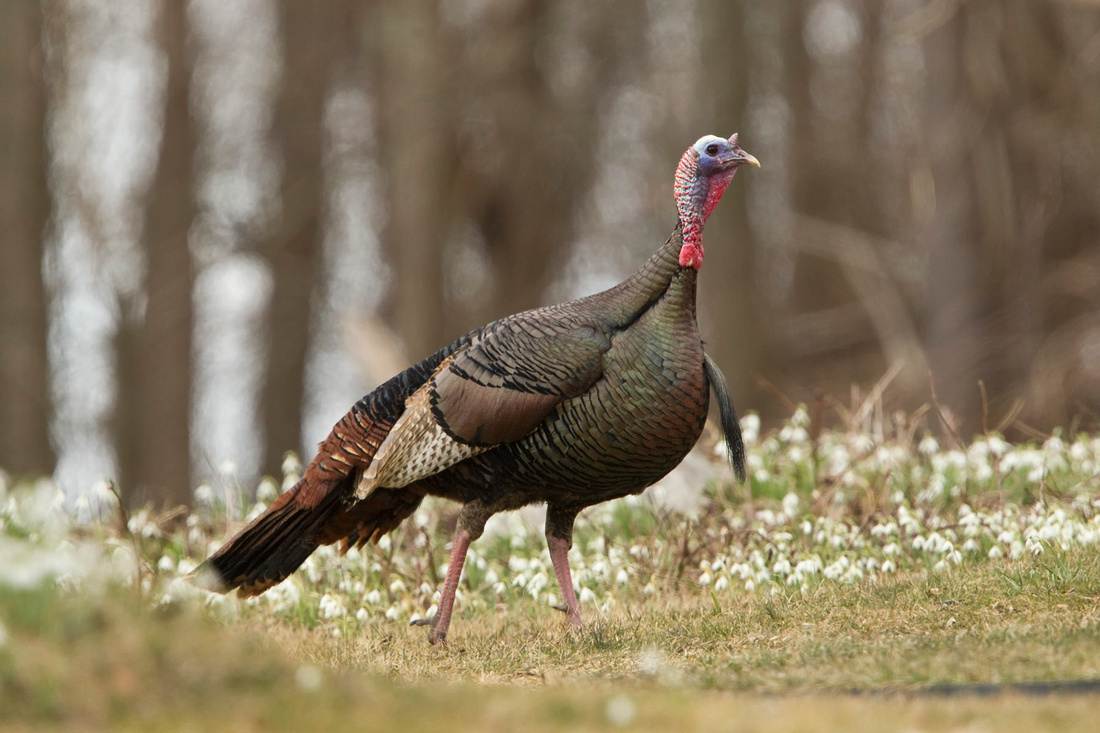 It slipped between two patches of flowers, avoiding the main one were I was focusing on, then continued straight across the field towards the refuge headquarters, a stone building with an arched entry way. The tom walked right into the entry and disappeared for a few minutes, leaving me scratching my head. As I was about to get out and see what was going on, it reappeared in the stone archway, strutting about in full display.
It slipped between two patches of flowers, avoiding the main one were I was focusing on, then continued straight across the field towards the refuge headquarters, a stone building with an arched entry way. The tom walked right into the entry and disappeared for a few minutes, leaving me scratching my head. As I was about to get out and see what was going on, it reappeared in the stone archway, strutting about in full display.
Then back It went back into the entry and vanished for a while. This time I had to see what the attraction was. I got out and walked out a way so I could see inside the archway, and noticed a female turkey feeding along the edge of the building just beyond the entry. At this point a jogger went by and I figured the show would end, but the tom continued strutting, as if trying to scare the runner off. I've heard stories of Wild Turkeys attacking people at certain times of the year and have photographed them active aggressively or without fear of people in the spring. The tom continued parading around in front of the doorway, but the female moved on around the building and he eventually followed. After they were out of sight I walked into the archway to see what the attraction could have been. The door was glass but had white window panes that broke up the reflection. Maybe it saw just enough of itself to see rival presenting a challenge to his territory. On a spring trip to Florida years ago I photographed a male Prairie Warbler attacking the side mirror of my rental car, where he saw his own reflection and perceived a challenge. How it ever got close enough to the mirror to see a reflection in the first place I'll never know. Crazy things happen during the season of love.
The tom continued parading around in front of the doorway, but the female moved on around the building and he eventually followed. After they were out of sight I walked into the archway to see what the attraction could have been. The door was glass but had white window panes that broke up the reflection. Maybe it saw just enough of itself to see rival presenting a challenge to his territory. On a spring trip to Florida years ago I photographed a male Prairie Warbler attacking the side mirror of my rental car, where he saw his own reflection and perceived a challenge. How it ever got close enough to the mirror to see a reflection in the first place I'll never know. Crazy things happen during the season of love.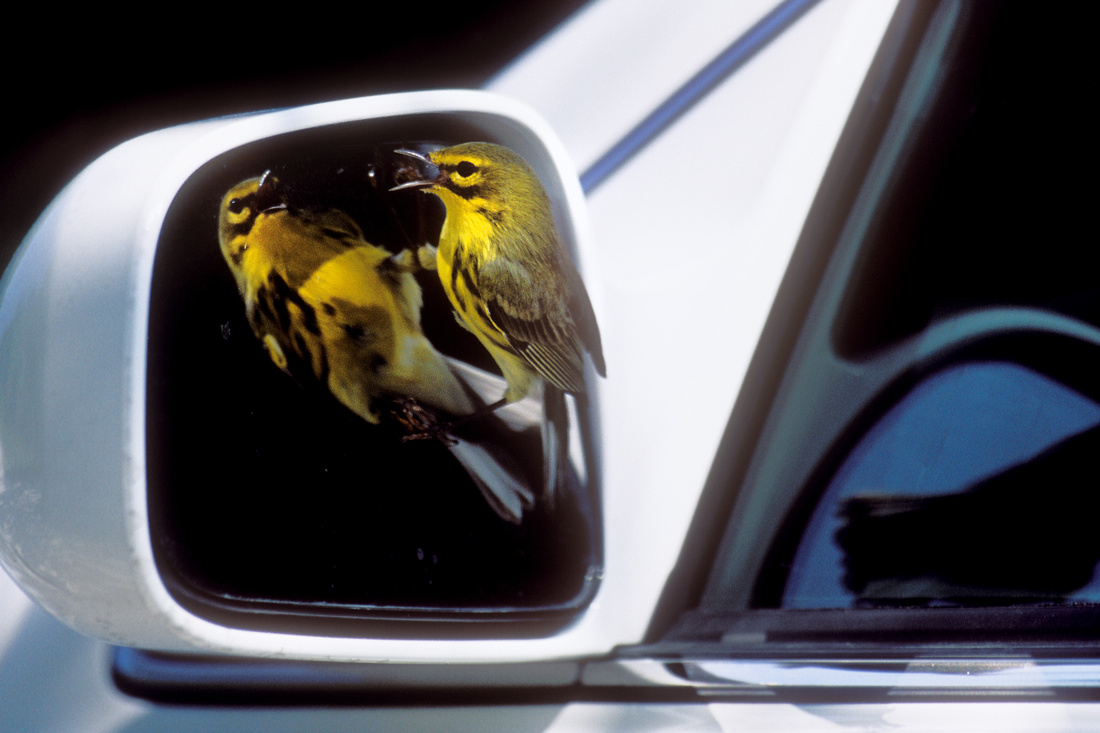
Elsewhere, the first egrets, both Snowy and Great appeared at Rocky Neck, along with a number of Osprey, Green-winged Teal, Gadwall and American Wigeon out in the salt marshes.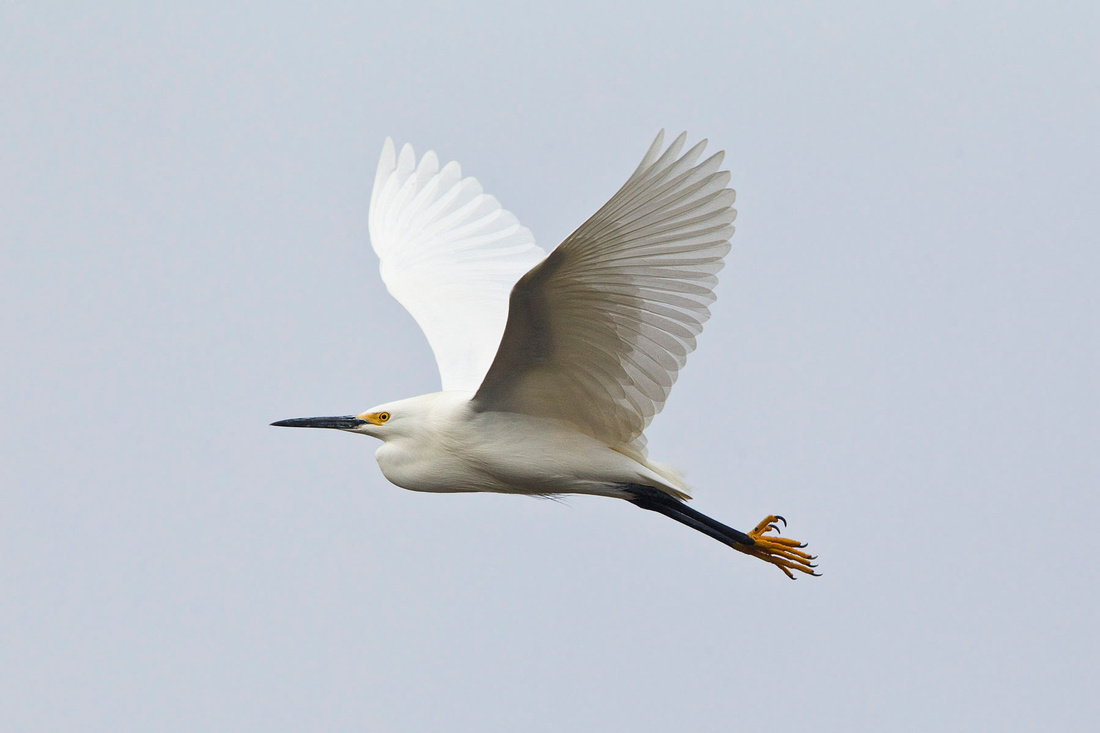
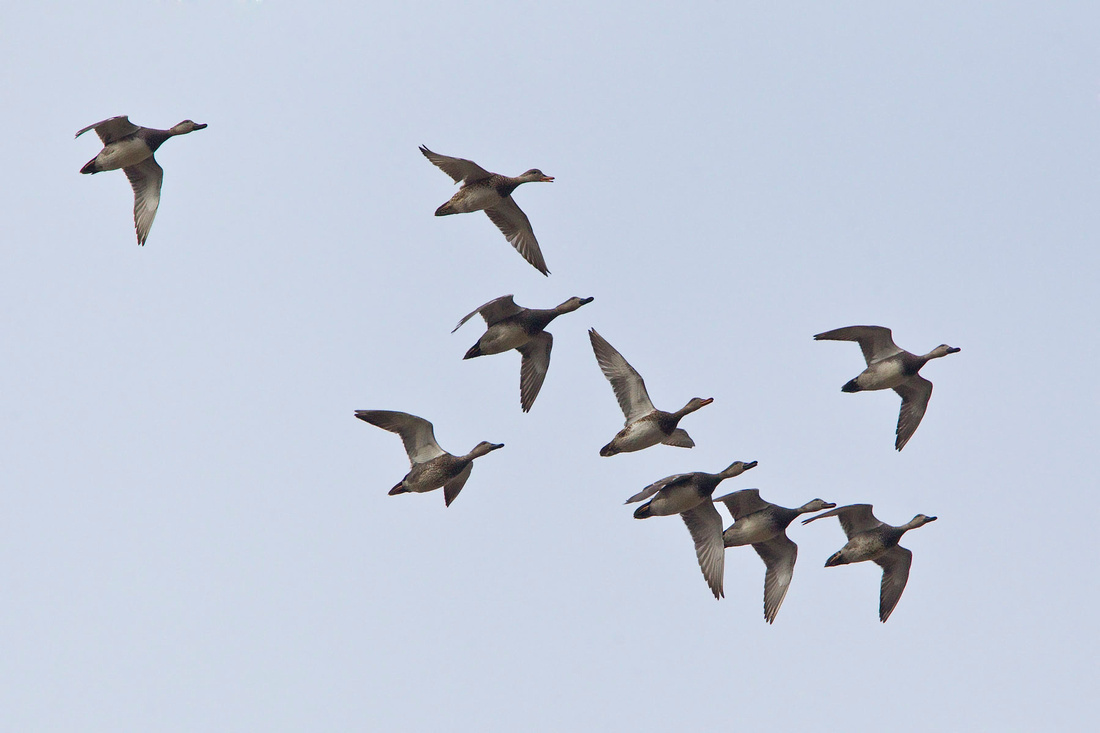
 In a tiny woodland pool in Waterford, a pair of Wood Ducks made a brief appearance (male pictured).
In a tiny woodland pool in Waterford, a pair of Wood Ducks made a brief appearance (male pictured).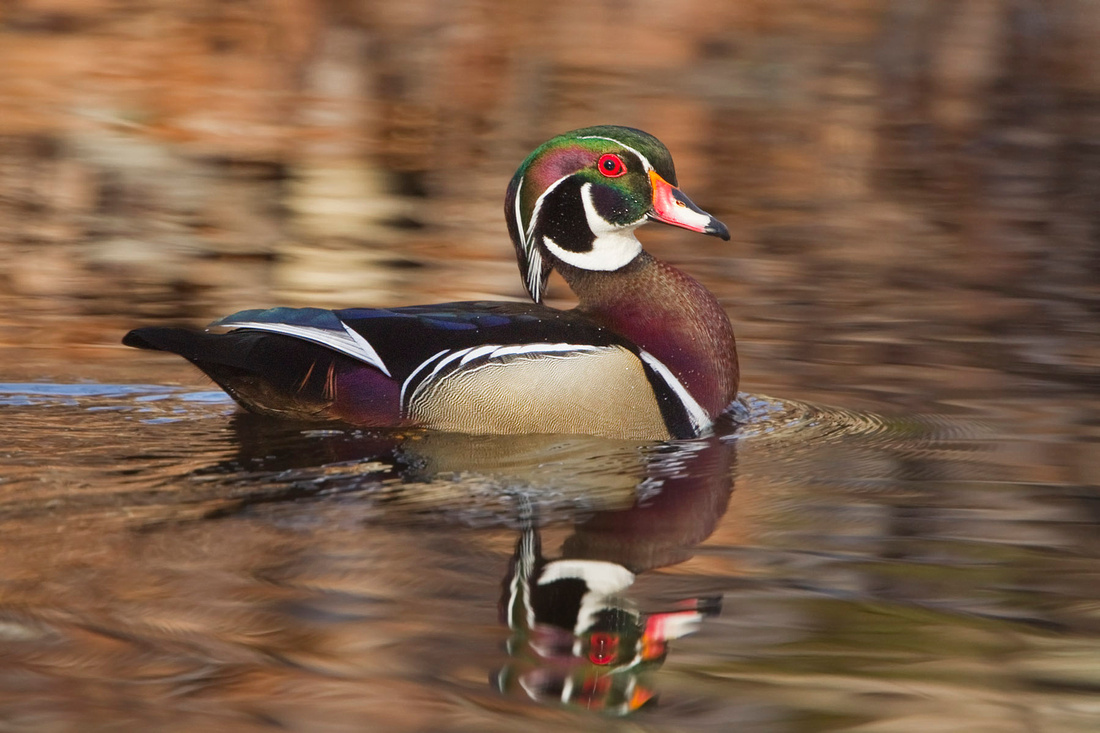
And at Hammonasset I saw my first (2) Greater Yellowlegs of the year.
To close out the month, I went looking for a Piping Plover. These beautiful shorebirds still may have a tiny foothold of a nesting area at Griswold Point, where despite the close proximity, I have not been out to in a few years. Last Saturday I unknowingly timed an early morning walk with dead low tide and was able to walk out as far as the original breech. It's a great feeling walking on a deserted beach as the sun rises, with your shadow stretching out for yards in front of you. Dozens if not hundreds of Brant stretched out along the shore, nearly the entire way, feeding on the algae covered rocks. Where the beach ends, I made my way across the exposed mud flats and drainages and scanned ahead. A dozen or more Osprey circled around fishing or sat on nests at Great Island. More ducks, including Green-winged Teal, a few American Wigeon and Gadwalls fed in the cove and at the edge of the mud flats while father out on the sound a couple loons and Horned Grebes remained. 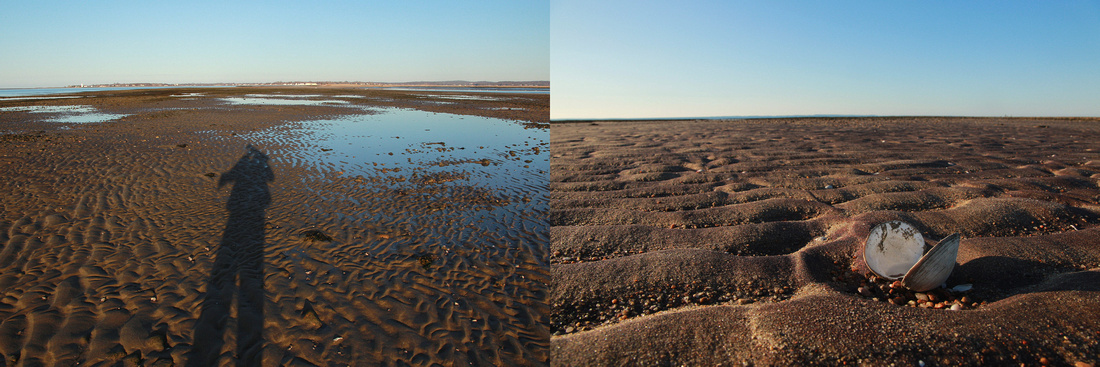
As I approached the first small dune (it's actually just a sandbar that doesn't get covered all the way) that survives, I heard the familiar two syllable peep of a Piping Plover, but it took me a while to find it with my binoculars. As I continued scanning, I saw a total of four plovers, mostly feeding out on the mud flats. As I was walking back past the first dune, one plover walked close by and 'guided' me away as though it was protecting its nest territory. I took a few quick pictures and kept going. 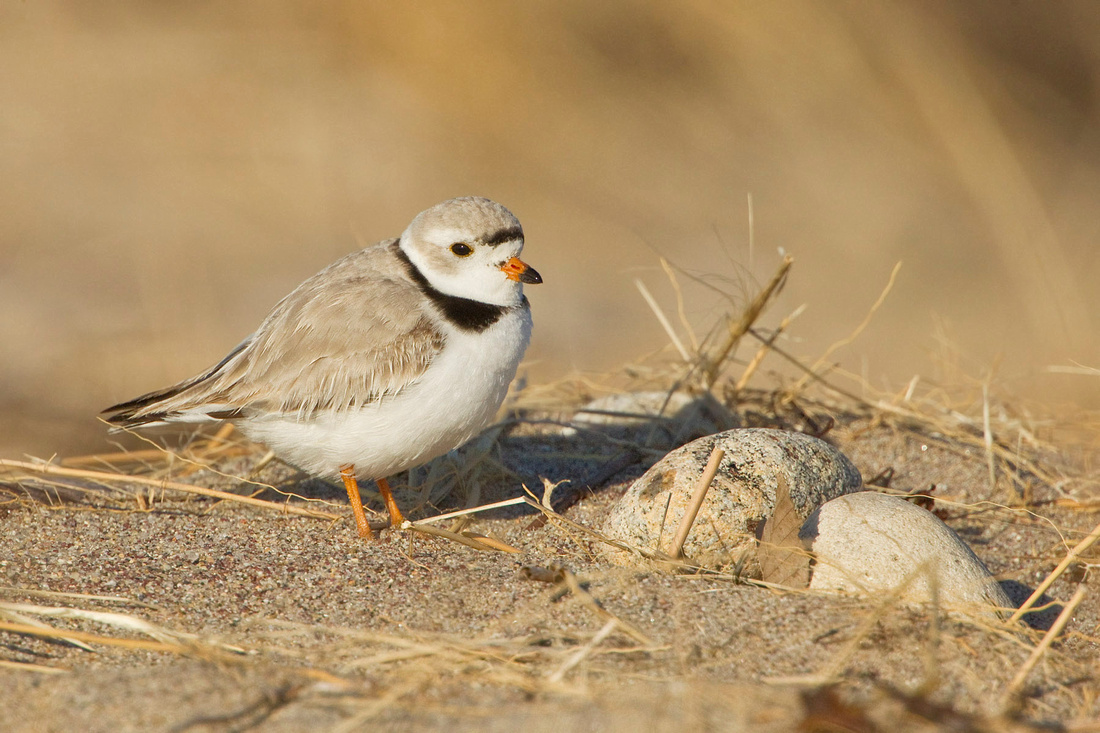 I had a job to photograph in a few hours so I had to make it an early day. As I headed back to my car the first dog walkers were heading out to the point. It will be interesting to see if the plovers can retain their nesting tradition on the tiny suitable section of the point that is left.
I had a job to photograph in a few hours so I had to make it an early day. As I headed back to my car the first dog walkers were heading out to the point. It will be interesting to see if the plovers can retain their nesting tradition on the tiny suitable section of the point that is left.
March ended with spring migration officially underway. The first Osprey, my "first sign of spring" arrived March fourth, a couple weeks earlier than I usually see one, and woodcock started a bit early this spring, too. But then the cold weather kept the new arrivals down to a trickle. Migrating ducks and waterfowl dominated as photography subjects in March, although they are tough to get close to in Connecticut. Many of my pictures were pretty distant, but ducks in breeding plumage are some of the most beautiful birds to see. Blue and Green-winged Teal are among my favorites, although their wariness and diminutive size continue to frustrate my efforts to get really nice pictures. The Common Teal(s??) in Portland added a bit off excitement, although I should revise my list down because they are not considered a separated species from Green-winged Teal. Some of the stunning ducks I had some success with include Wood Duck, Lesser Scaup and Northern Shoveler.
As the month drew to a close, new shorebirds arrived including greater Yellowlegs, American Oystercatcher and Piping Plovers. Wading birds like Snowy and Great Egrets and Black-crowned Night Herons are increasing in numbers even though a few over wintered in Connecticut. Soon the real fun will begin with the arrival of migrant songbirds. Here are my photo highlights from the past month.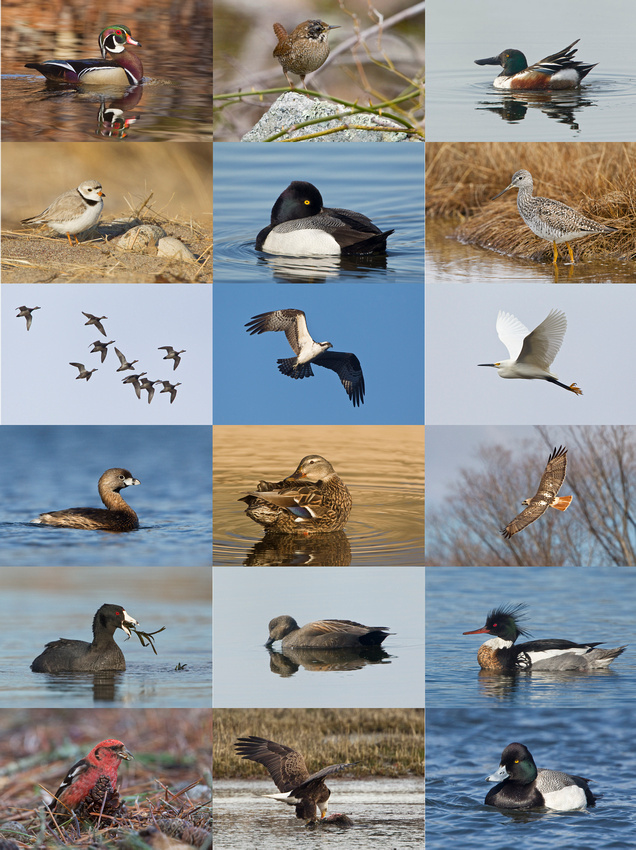
]]>
******************************************************************************************************************************************************
Have you ever wondered why most wild animals are so wary of humans? It's obviously an instinctive behavior because for millions of years the two-legged creatures walking upright have tried to kill them, whether for food, self defense or more recently (in historic terms) for sport. Even the founding fathers of American ornithology like Alexander Wilson and John James Audubon shot most of their subjects to better study them. With a history like that, it's no wonder that birds and animals can be tough to get close to.
Last fall, a very large Cooper's Hawk (pictured below) terrorized my bird feeders for several weeks. When the Coop flew in, some of the birds would dive for cover in the tall weeds below the feeders and the hawk figured out how to stomp through the grass to find them. One day I watched from my window as the hawk, stomping around on the ground like a T-Rex, crossed paths with a Gray Squirrel eating fallen seeds. What followed was hilarious, but also very illuminating. The hawk rose up and repeatedly flashed it's wings to scare the squirrel off, but the squirrel ignored the puffed up accipiter, and continued stuffing its face. The standoff continued for a few seconds, when the squirrel grew tired of the threats and made a head fake towards the hawk, causing it to jump back and pursue its quarry in another clump of weeds. The squirrel, often prey to other hawks, instinctively knew that this type of hawk was not a threat even though it was bigger and acting aggressively. I wish I could have captured this drama, but the first move I made from behind the window sent them both scattering.
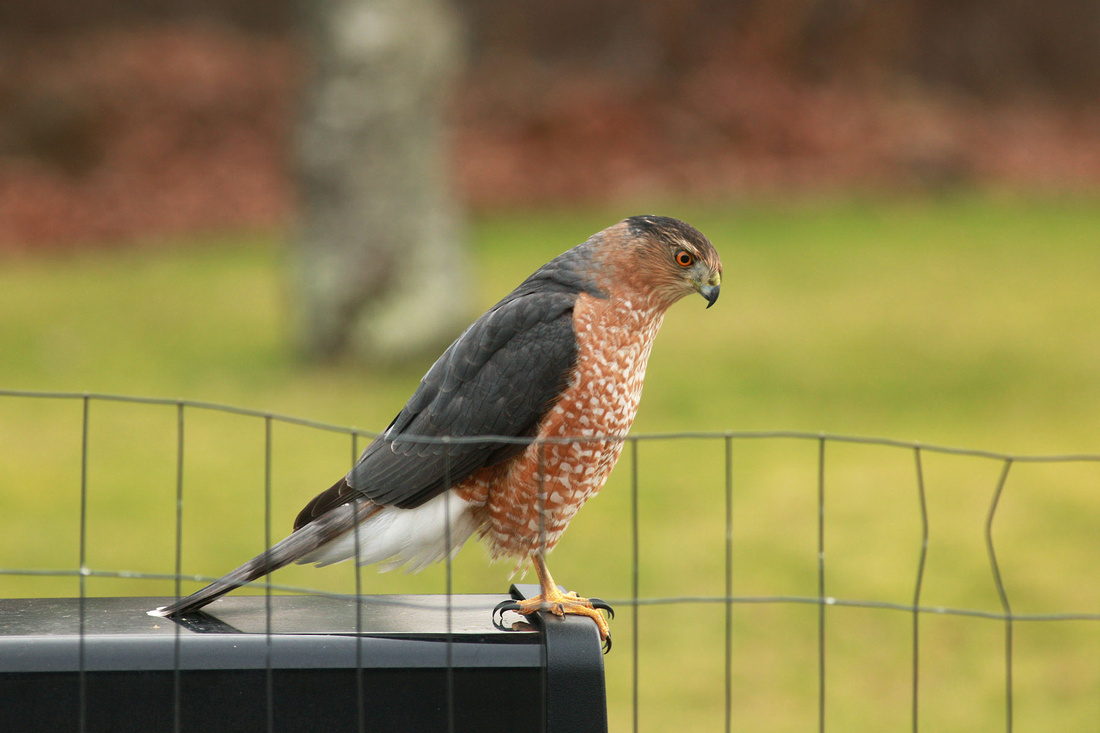 Knowing its diet, the birds were terrified of the hawk while the squirrel paid little mind to it. Humans are not so predictable. Even though most people today mean no harm to individual animals or birds, there are now, and always have been plenty who do. So instinct tells most creatures to err on the side of caution when it comes to humans. And we don't like it when the tables are turned, and we are the ones in danger. Most predators that see humans as food or a threat to be challenged are not tolerated in populated areas, and are banished to the most remote areas, or parks and zoos. Imagine how different wildlife photography would be if you could just walk right up to birds and animals. It would be far less challenging to get close to a subject, and would eliminate the need to use a telephoto lens. It would also eliminate the biggest controversy about wildlife photography, getting too close to subjects. There are times when a creature shows no fear of people, but it's never likely to become the norm.
Knowing its diet, the birds were terrified of the hawk while the squirrel paid little mind to it. Humans are not so predictable. Even though most people today mean no harm to individual animals or birds, there are now, and always have been plenty who do. So instinct tells most creatures to err on the side of caution when it comes to humans. And we don't like it when the tables are turned, and we are the ones in danger. Most predators that see humans as food or a threat to be challenged are not tolerated in populated areas, and are banished to the most remote areas, or parks and zoos. Imagine how different wildlife photography would be if you could just walk right up to birds and animals. It would be far less challenging to get close to a subject, and would eliminate the need to use a telephoto lens. It would also eliminate the biggest controversy about wildlife photography, getting too close to subjects. There are times when a creature shows no fear of people, but it's never likely to become the norm.
I'm not a hunter, but I grew up with a little exposure to it and first learned some of the skills I use today in wildlife photography watching my stepfather hunt. These skills include knowing the behavior of your quarry, figuring out how to find and get close to it and having the patience to wait for the right shot. We occasionally had a freezer stocked with venison and my folks always used every part of the deer, very little went to waste. One of my few hunting memories as a kid is being sent back to where a deer was field dressed to get the heart, liver and kidneys. I couldn't relocate the gut pile, but that may have been a subconscious effort on my part to avoid having to eat the organs. The message was clear, though, if you are going to kill an animal make sure it isn't done wastefully.
So when we recently we had a free trial period of the Sportsman's Channel on our television programing and I was compelled watch some of the hunting shows. I don't harbor a hateful grudge against hunting, but some of these shows were really shocking to me. One show featured a mom and her two daughters, a teenager and a pre-teen in matching pink and black camo t-shirts, on an African safari. They hunted from a blind at a water trough, reading books and playing on their Ipads as they waited for their quarry, obviously habituated to the water feature, to arrive. Each of them shot their own Kudu and warthog and after each kill, they posed with their trophy and repeated their signature line to the dead animal ... "Rest in peace, dude. Thanks for the awesome hunt". Another hunter repeatedly thanked God for providing such magnificent animals for him to kill, all of which were apparently destined for a wall in his house. In yet another, a hunter was shooting endangered African antelope on a Texas game farm. His message, ostensibly to the African people who might get the channel, was to show that hunters would be willing to pay far more to visit their country to shoot these endangered species, than the six dollars a pound they were worth as food. Therefore, they should protect these antelope for economic reasons.
Everyone has a different perspective when it comes to nature, and what some find ethical or entertaining is shocking or offensive to others. I liken it to talking politics, no matter what your viewpoint, there's always a group of people who think you are uneducated, misguided, crazy, evil or worse. Obviously, these hunting shows have an audience, but I certainly wouldn't pay to watch them. I know many hunters have immense knowledge of and respect for wildlife, and that hunting organizations and license fees do a great deal to preserve critical habitat for creatures. But, I suspect many hunters would cringe if they watched these types of shows, too. I've never been a fan of trophy hunting, and find it ridiculous to thank an animal you killed to put on your wall or suggest it would somehow be rewarded for its sacrifice in the animal afterlife. But hunters and wildlife photographers have little something in common, more than just an interest and knowledge of birds or animals, and a perhaps camouflage wardrobe. What we think is a worthy and harmless pursuit, some others see as a selfish and unnecessary exercise that puts wildlife under undue stress or danger. And just as in the hunting community, there are always photographers who push the limits and give the group a bad reputation.
When I began photographing birds in the early 1990's there were only a few "bird photographers" in Connecticut. There was a large network of avid birders, and many were very kind, and willing to share their knowledge. I learned a lot from them, and still do. But birders and photographers were sort of like oil and water, they didn't mix well, and there was often tension between the two. I sometimes felt like I was being eyed disapprovingly when photographing in the presence of birders. They were the protectors and defenders - photographers got too close to the birds, pushed them or scared them off for selfish reasons. To them a picture was like a "trophy".
That's not to say that I agreed. Years ago I was out at Griswold Point in Old Lyme when terns nested there (before a succession of storms reduced it to its present state). It was August, near the end of the nesting period, and many newly fledged terns gathered at the water's edge, waiting to be fed by adults returning with fish. A string line cordoned off the nesting area, but I slowly crawled on my belly along the waterline and got within a reasonable shooting distance of the terns without scaring them off. After a short while photographing, all the birds spooked suddenly. I looked up to see what caused the commotion and saw a man with binoculars walking through the center of the nest colony directly towards me. I was about to tell him he shouldn't be walking through the nest area but he spoke first. He politely told me that I was in a sensitive bird nesting area and that I would have to leave. He went on to explain that he was monitoring the colony for the Nature Conservancy, and that my presence could scare the adult terns away from nests leaving any unfledged chicks at risk to predation from gulls. I looked incredulously at him, since that's exactly what he had just done, and explained that I'd spent half an hour crawling along the waterline without scaring off the birds, any of them. He insisted I should leave, even though I was never above the high tide mark. In his mind, he was protecting the birds.
I have photographed nesting terns and other nesting birds and I didn't think I was harming the birds. The birds returned to the nest, fed their chicks and carried on as usual, but it's all in the eye of the beholder. The 20-year old picture below, left, shows an ill-fated effort devised to benefit the terns at Griswold Point, where wooden baskets were placed over the nests to protect them from predation. I was told that predators figured out that under each basket was a meal, and that's what put an end to the project. Sometimes even those trying to protect the birds may do more harm than good.
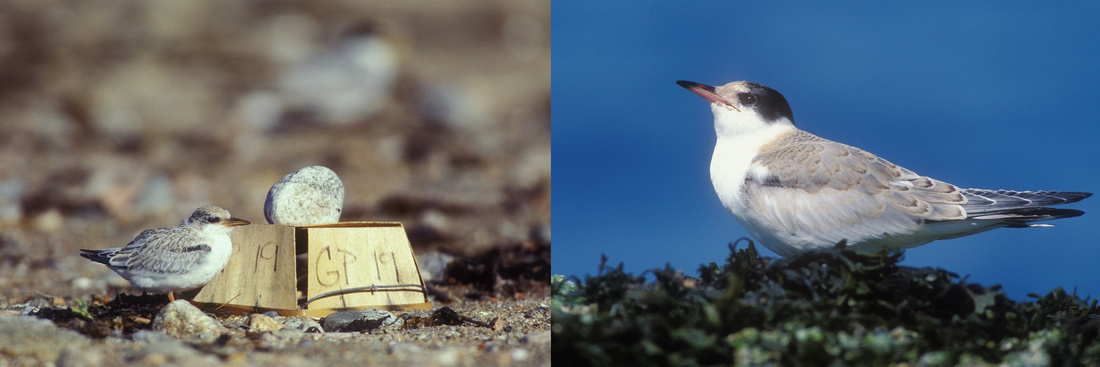
Scrutiny came not only from birders, but from other photographers as well. As a novice, I was eager to show off my work and gave out pictures I had taken, including one from a newspaper story I did about the recovering Osprey population. Amazingly, in the early 1990's there were only a few dozen Osprey nests in the state. I went out with volunteers who monitored the nests and the banded chicks under the auspices of the D.E.P and U.S. Fish and Wildlife Service, and with their permission, I was allowed to climb the ladder and photograph the chicks in one of the platform nests. I heard from someone that renowned birder, photographer and hawk bander Ray Schwartz saw the picture and was very upset with me, not knowing the story behind the photo, or me very well. Fortunately, I got to know Ray and we became friends. I thought of him as a mentor and spent a lot of time talking to him in his hawk blind at Hammonasset before he died. Ray loved hawks and devoted countless hours to their study, but he confided that he, too, sometimes felt the disapproval from some in the birding community who thought banding needlessly endangered the hawks.
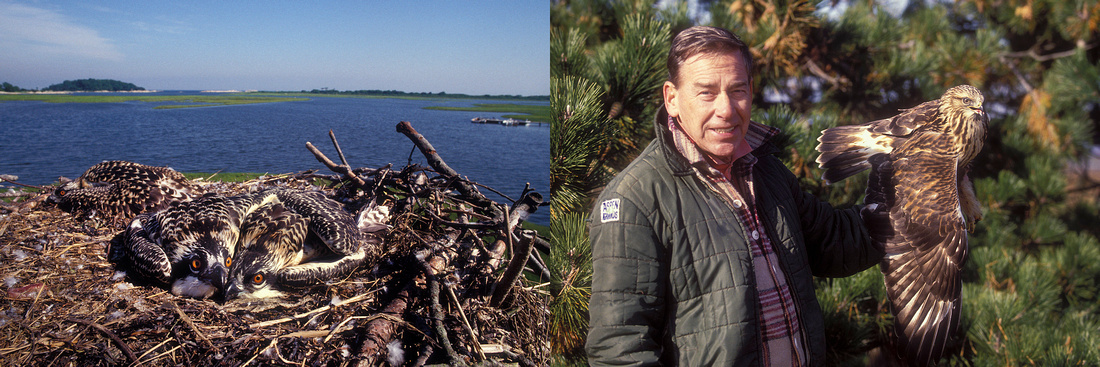
With the advent of the digital age of photography, there are many more wildlife photographers around now than two decades ago. It's also particularly interesting now that things have come full circle, and many more birders have cameras, and want to photograph the birds they see. It's not uncommon to see dozens of people photographing a "good" bird when it shows up. Birds and animals often react differently to a single photographer, approaching slowly, lowly and indirectly than they would to a large group, spread out and jockeying for position. Internet postings detailing the locations of subjects also allow many more people to "visit" a subject. A creature may not mind one or two visits, but what if that turns into dozens of people a day stopping by? I appreciate it when someone posts a sighting that I get to see or photograph and I have certainly been part of a group stalking a bird or animal. There are plenty of times, though, when I just don't feel too good about those situations. Sometimes it's just just being a part of something I know isn't best for the animal. Other times I cringe when I see a photographer doing something I believe is "wrong", but then I wonder if people see me the same way. The result is that I spend a lot of time searching and photographing alone.
As wildlife photographers, passionate about both subject and craft, we're often faced with the challenge of balancing the pursuit of one at the expense of the other. There are numerous accounts of photographers who ignore or lose sight of the welfare of a bird or animal in their quest to get a better picture of it. Sometimes they even ignore their own welfare. Some prefer wider, more environmental shots, others tight portraits, others simply want a record photo, easily obtained from a distance. Everyone's priorities and perspectives are different. I like to capture the natural behavior of birds and animals, so if they are acting alarmed or take flight, I have failed. There are some common sense guidelines that I try to follow, but I'm sure I've done things within these guidelines that others don't approve of. In general, my goal is to get the best photographs possible, and I try to let the subjects decide how close I should be based on their behavior.
]]>DATELINE:
NIANTIC, CT - USA
MARCH 22, 2013
A local woodchuck caused a scene in a neighborhood eatery last week. Pattagansett Pete, of 1492 Park Place, was spotted dining at/on a posh lawn, but was forced to flee when he was confronted by reporters and news cameras seeking reaction to the fraud charges filed against his distant cousin, Punxsutawney Phil, for false forecasting. Making his first public appearance since the botched prediction, Pete declined to comment on his cousin's legal troubles, but as he beat a hasty retreat he was quoted saying "You people are crazy to trust that dirty rat".

PATTAGANSETT PETE reacts as he is confronted by reporters about the fraud charges filed against his cousin Punxsutawney Phil for inaccurately forecasting the end of winter. (Staff photo / Bob MacDonnell)
************************************************************
Elsewhere, police were called to a Lyme vernal pool when neighbors complained about excessive noise and loud croaking. Officers suspected a Spring Weekend pool party had gotten out of hand, but when they arrived on the scene they discovered a Wood Frog orgy, even as snow flurries flew. We reported on the potential for trouble last week, and a bystander sent us this shocking cell phone video of the melee. **** Warning ***** Viewer discretion is advised.
A police spokesman said more than two dozen frogs were arrested for lewd behavior and public indecency and the pool was left littered with egg clusters.
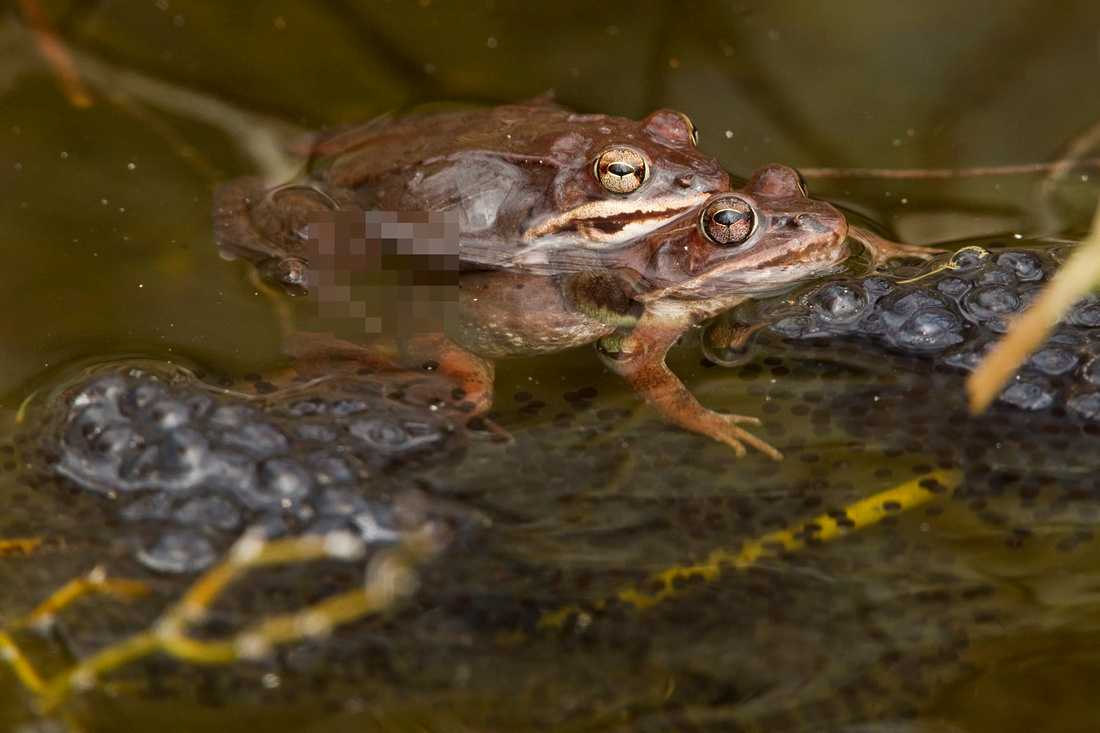
Tensions were high as stunned residents gathered around the pool to protest the decline of the once quiet, family neighborhood. A distressed looking Winter Wren made a rare appearance and spoke out against the amphibious assault on the community. "This used to be a respectable neighborhood", he lamented, "Then the Wood Frogs moved in, and the Spring Peepers and American Toads, where will it end?"

****************************************************
Okay, back to reality. New spring arrivals are turning up every day, and I had a number of new sighting to add to my list. Last week I checked the Portland Fairgrounds after a report of several species of ducks there, including Blue-winged Teal which I had not seen this year. I arrived to find the gate closed, but the ducks were in the pond adjacent to the entrance, and fairly close. Included were more than a dozen Green-winged Teal, three striking Northern Pintails, two Ring-necked Ducks and a pair of Blue-winged Teal, along with the common Mallards and Black Ducks. Ducks are usually very wary, so I drove close to the gate with my window down and waited, never leaving the car. Gradually the Mallards worked their way to the near edge of the pond and as luck would have it, the BW Teal followed. I got a few pictures that basically amounted to record shots (you forget just how small teal are) before the ducks worked their way out to the flooded grass field.
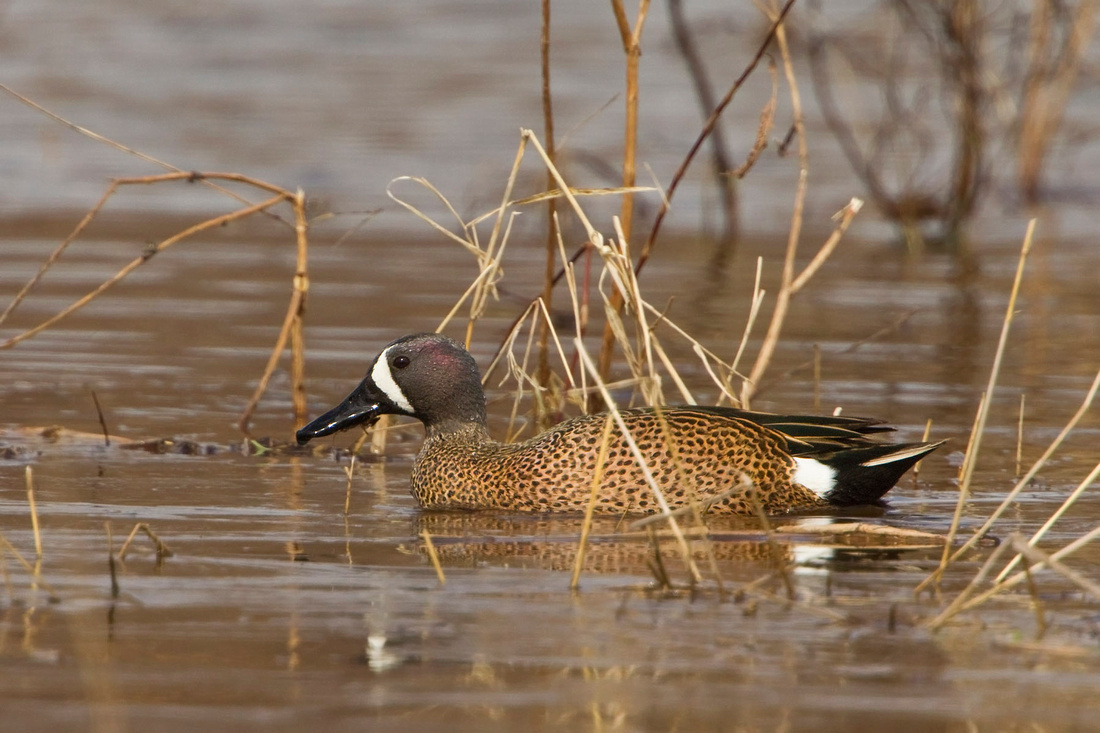 After a short while a couple other birders pulled up and watched from their cars as well, as all the ducks were easily spotted. Eventually one of the pintails moved to an open area and I got some distant photos of it as well (these are pretty heavy crops).
After a short while a couple other birders pulled up and watched from their cars as well, as all the ducks were easily spotted. Eventually one of the pintails moved to an open area and I got some distant photos of it as well (these are pretty heavy crops).
 After the other cars left, I debated if I should risk scaring the birds off by getting out of my car and trying to get a bit closer, but decided not to since many others were likely hoping to see the ducks. Then another car pulled up and a couple got out, set up their scope and started to walk past the gate. I readied my camera, feeling pretty sure the ducks would take flight. They lifted off and I fired a couple quick bursts, not expecting much, while the couple stopped as if startled. The ducks set down in the pond, farther back then when I arrived, so I decided to leave. I checked my shots in the camera monitor and was happy to see a couple shots with Mallards and the Blue-winged Teal pair nicely aligned, showing their namesake wing patches.
After the other cars left, I debated if I should risk scaring the birds off by getting out of my car and trying to get a bit closer, but decided not to since many others were likely hoping to see the ducks. Then another car pulled up and a couple got out, set up their scope and started to walk past the gate. I readied my camera, feeling pretty sure the ducks would take flight. They lifted off and I fired a couple quick bursts, not expecting much, while the couple stopped as if startled. The ducks set down in the pond, farther back then when I arrived, so I decided to leave. I checked my shots in the camera monitor and was happy to see a couple shots with Mallards and the Blue-winged Teal pair nicely aligned, showing their namesake wing patches.
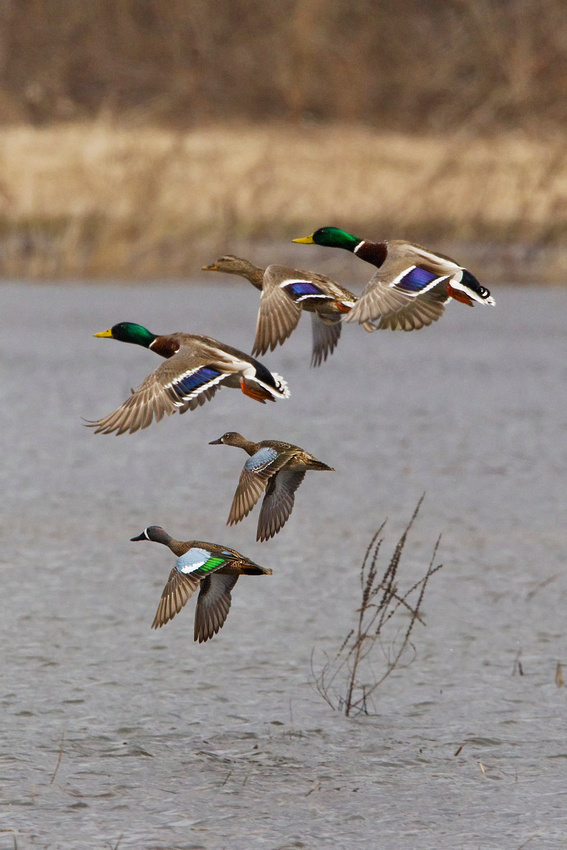
On Saturday I went to the COA (Connecticut Ornithological Association) Annual Meeting for the first time. I always had to work on Saturdays in March when I worked at newspapers. The programs were very entertaining and I had a great time. One of the speakers, Marshall Iliff's program was about eBird, an internet bird sighting database. I was impressed with the scope and benefits of the program and decided to join and enter my sightings. Sunday morning at Rocky Neck, I saw two Great Egrets (one below) and one Snowy Egret, the first snowy of the year.
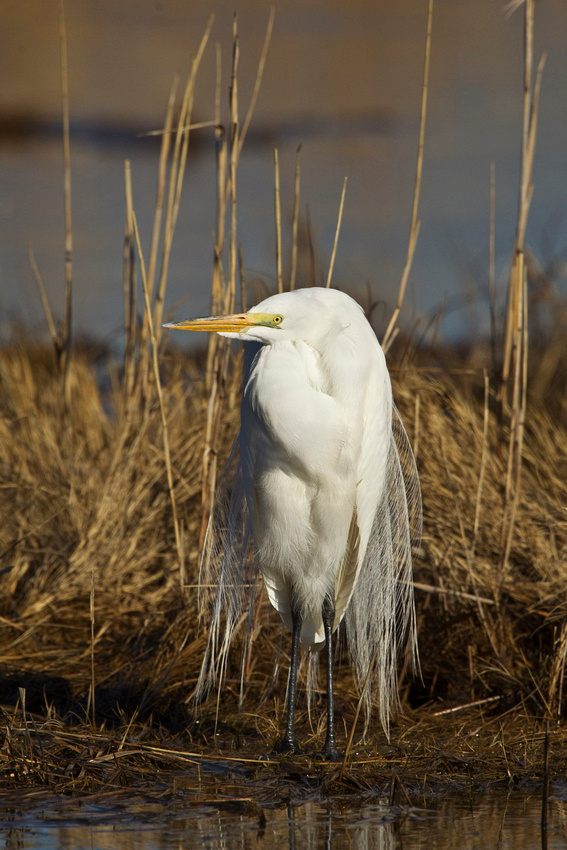
The Osprey are back on their nests, and some have a lot of housekeeping to do after Sandy last October and several winter storms damaged many of the platforms. This one in Old Lyme survived pretty much intact.
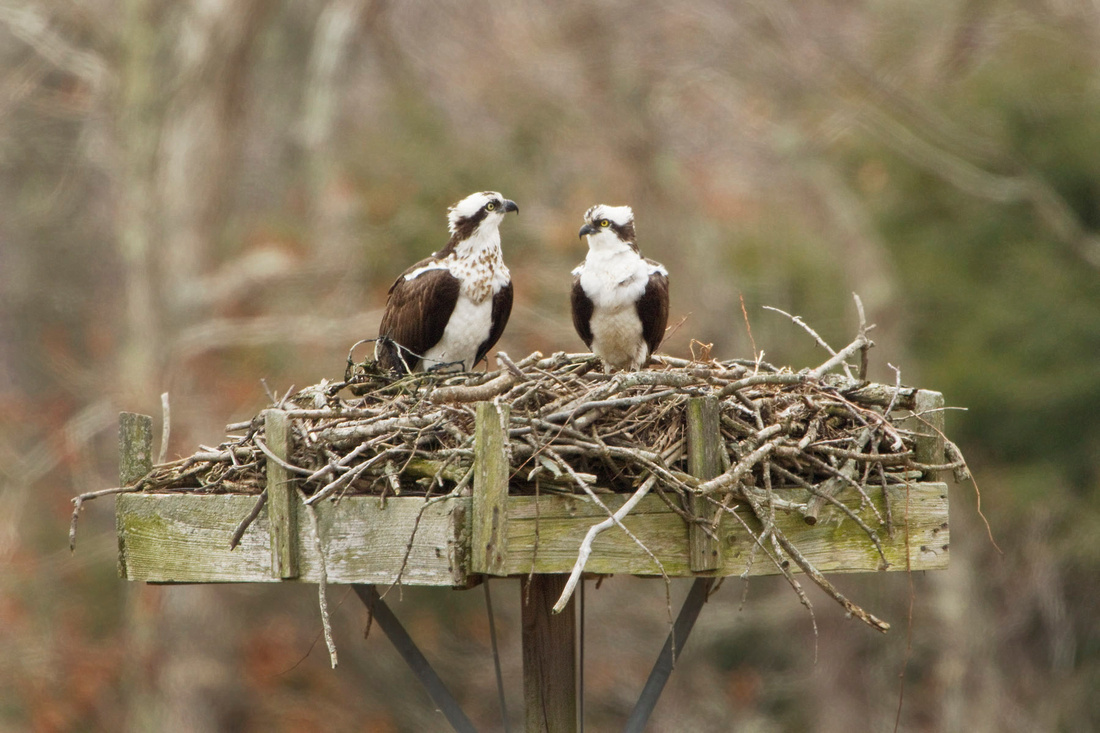 Sunday afternoon I was on my way to go grocery shopping and decided to check Hole In The Wall Beach to see if the Common Loon that was nearing full breeding plumage was around. There were lots of people, some with dogs, walking on the beach but no loons close to shore. I noticed an odd looking gull on the water and walked towards it. It turned out to be an adult Lesser Black-backed Gull, the first one I've ever seen there, that was very cooperative and associated with the common Ring-billed and Herring Gulls. The gull was in the same area the next couple afternoons as well.
Sunday afternoon I was on my way to go grocery shopping and decided to check Hole In The Wall Beach to see if the Common Loon that was nearing full breeding plumage was around. There were lots of people, some with dogs, walking on the beach but no loons close to shore. I noticed an odd looking gull on the water and walked towards it. It turned out to be an adult Lesser Black-backed Gull, the first one I've ever seen there, that was very cooperative and associated with the common Ring-billed and Herring Gulls. The gull was in the same area the next couple afternoons as well.

Early this week while driving home from my daughter's lacrosse game I saw five Black-crowned Night Herons at Bush Pond in Niantic, and the next evening while firing up the grill I saw another one fly down to the brook in my back yard.
To accommodate my Big Year list, I went back to Portland this week to see if I could add the rare Common Teal spotted at the fairgrounds. There were many more Green-winged Teal than last week and on the far edge of the flooded grass area, the Common Teal stood out from the similar Green-wings. I checked them pretty carefully last week so I'm pretty sure the Common Teal is a new arrival. The distant photograph below shows the distinguishing field marks, the bold white horizontal wing stripe, lack of vertical white bar on the breast and white outline on the green face patch.
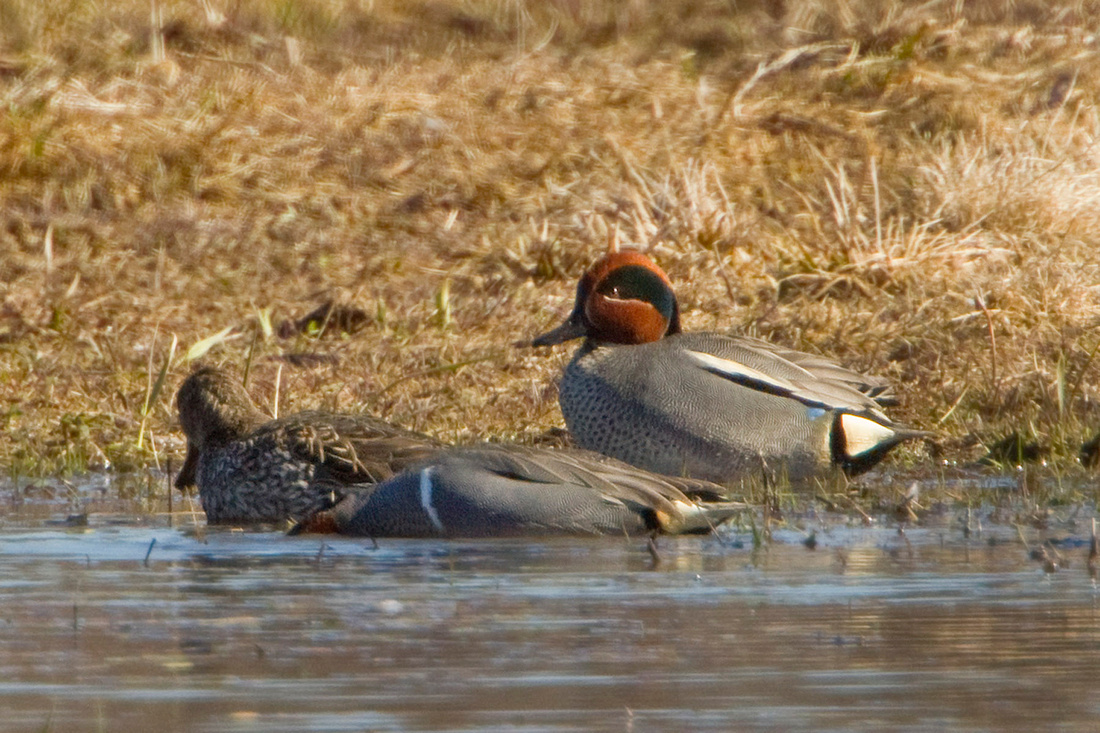
Along with the Common and Green-winged Teal, were six Blue-winged Teal, and eight Northern Pintails, as well as many Mallards. In the flooded swamp on the east side of the fair buildings were five American Wigeon, six Wood Ducks, a Beaver and a ratty looking Muskrat.
New sightings for the week: Winter Wren, Cedar Waxwing, Blue-winged Teal, Snowy Egret, Black-crowned Night Heron and Common Teal. Total 127 species - 123 in CT.
]]> On many ponds, including this one in Old Lyme, Painted Turtles could be seen sunning themselves on logs, rocks and clumps of reeds.
On many ponds, including this one in Old Lyme, Painted Turtles could be seen sunning themselves on logs, rocks and clumps of reeds.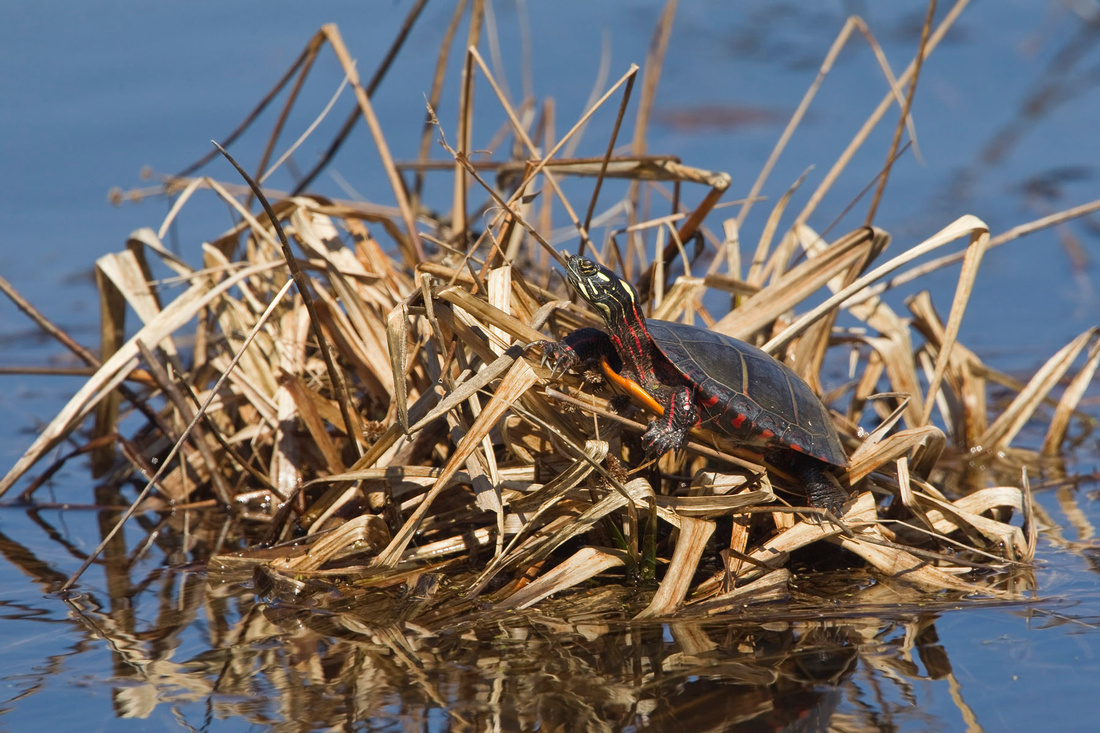
A small creek in Lyme was teaming with small fish, so many that when they darted back and forth the water looked like it was boiling.
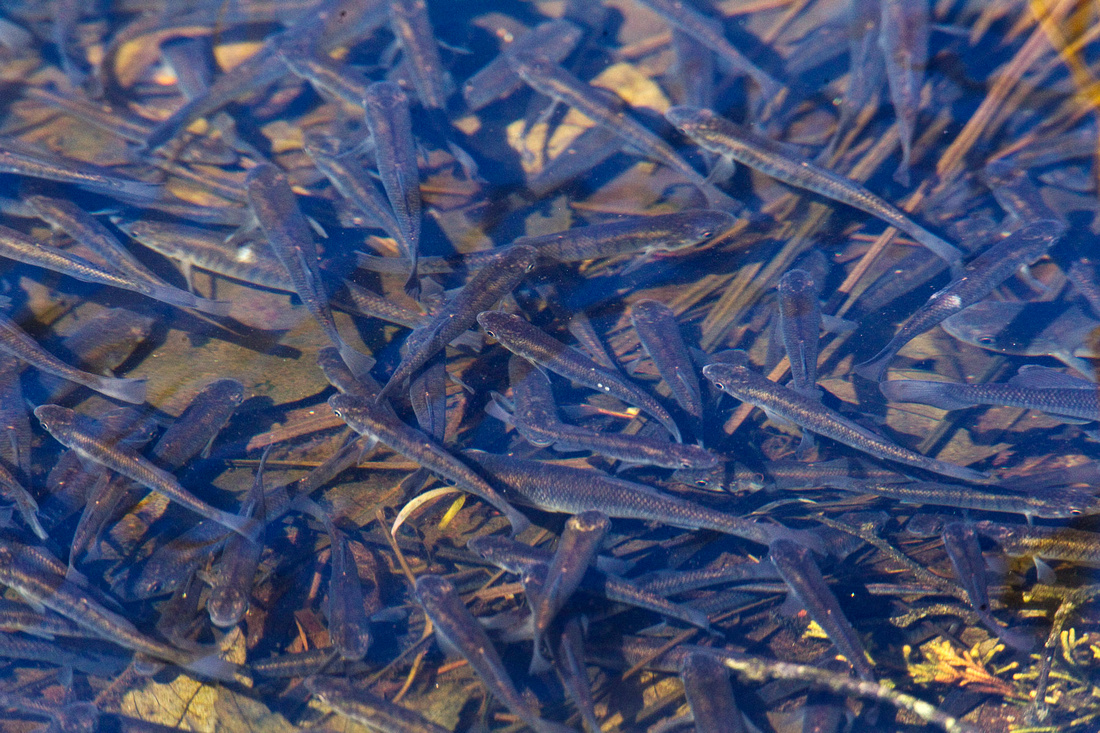 Bird life is in transition, too. Grackles and blackbirds have taken over at my bird feeders, emptying them at an alarming rate. Osprey sightings are increasing every day now, and I just saw one right over my house shaking the water from its feathers, with a fish in its talons that it apparently just plucked from the brook in the back yard. Other spring arrivals I've seen with more frequency in the past couple weeks are Tree Swallows and Savannah Sparrows. A few winter wanderers remain, though, and last week I stopped into Hammonasset Beach State Park and saw fellow photographer Mark Szantyr http://birddog55.zenfolio.com/ hard at work on the ground beneath the pines at the West Beach parking lot. I got out to see what the attraction was and saw an incredibly tame pair of White-winged Crossbills feeding on the cones, amid the tangled mass of fallen branches, just a few feet away from him. Several Red-breasted Nuthatches flitted fearlessly from tree to ground, also landing right next to him. I went back to get my camera and when I returned, the male crossbill had walked right up to Mark. Too close to be photographed, he looked down in amusement as the bird walked right past his knee. I asked Mark if he'd mind if I joined him (photographer etiquette) and was able to get in on the fun. I got some pictures of the male as it worked (and I mean worked) on a cone for several minutes. At one point it just stopped and sat there, as if it was exhausted and needed to take a breather.
Bird life is in transition, too. Grackles and blackbirds have taken over at my bird feeders, emptying them at an alarming rate. Osprey sightings are increasing every day now, and I just saw one right over my house shaking the water from its feathers, with a fish in its talons that it apparently just plucked from the brook in the back yard. Other spring arrivals I've seen with more frequency in the past couple weeks are Tree Swallows and Savannah Sparrows. A few winter wanderers remain, though, and last week I stopped into Hammonasset Beach State Park and saw fellow photographer Mark Szantyr http://birddog55.zenfolio.com/ hard at work on the ground beneath the pines at the West Beach parking lot. I got out to see what the attraction was and saw an incredibly tame pair of White-winged Crossbills feeding on the cones, amid the tangled mass of fallen branches, just a few feet away from him. Several Red-breasted Nuthatches flitted fearlessly from tree to ground, also landing right next to him. I went back to get my camera and when I returned, the male crossbill had walked right up to Mark. Too close to be photographed, he looked down in amusement as the bird walked right past his knee. I asked Mark if he'd mind if I joined him (photographer etiquette) and was able to get in on the fun. I got some pictures of the male as it worked (and I mean worked) on a cone for several minutes. At one point it just stopped and sat there, as if it was exhausted and needed to take a breather.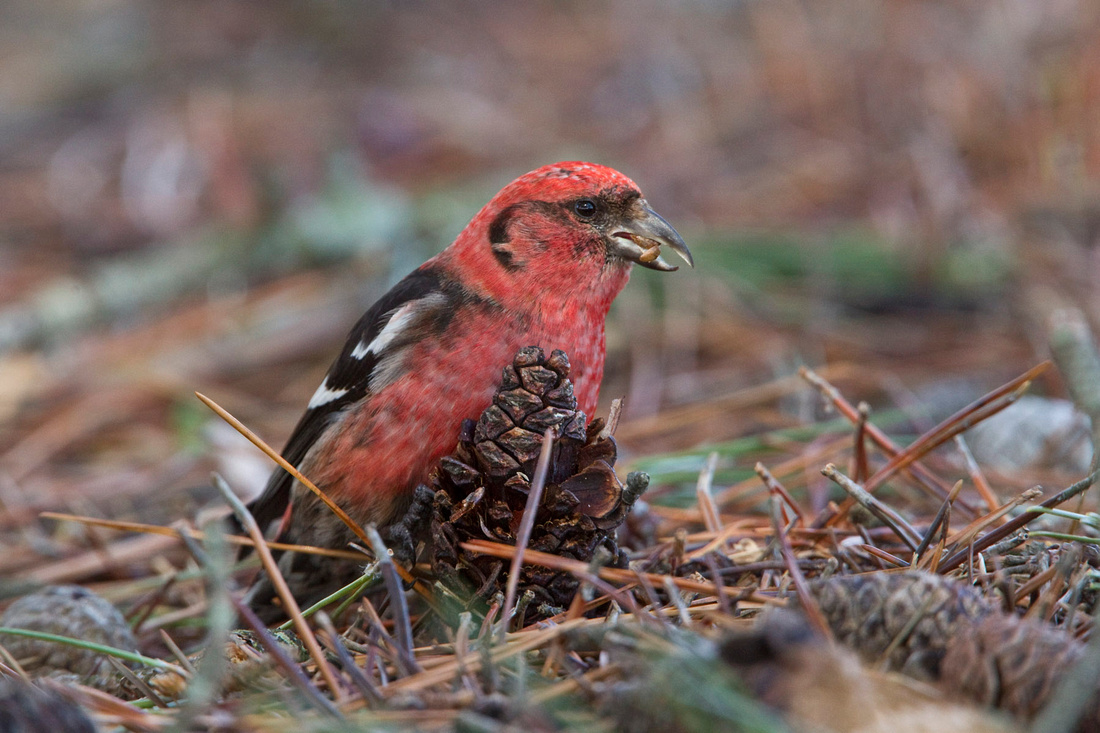 Early one morning I took a drive through Rocky Neck and saw a dark shape moving at the edge of the salt marsh. One of the benefits of getting out early is the chance to catch a glimpse of the animal life in Connecticut that is mostly nocturnal and secretive, like the American Mink. I watched as it walked to the edge of the water and disappeared beneath.
Early one morning I took a drive through Rocky Neck and saw a dark shape moving at the edge of the salt marsh. One of the benefits of getting out early is the chance to catch a glimpse of the animal life in Connecticut that is mostly nocturnal and secretive, like the American Mink. I watched as it walked to the edge of the water and disappeared beneath. A few seconds later it resurfaced with a fish in its jaws and walked back up into the grass ........
A few seconds later it resurfaced with a fish in its jaws and walked back up into the grass ........
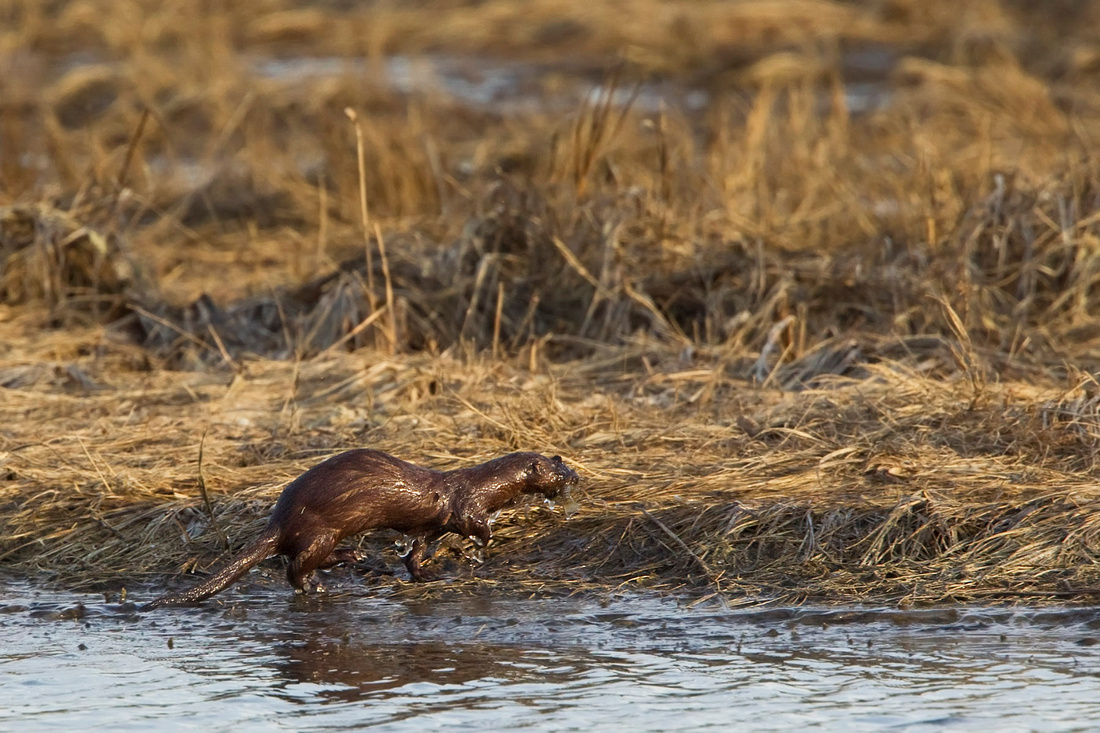 where it shook the water off and then dispatched the fish. Then back to the water, the mink acted just like an otter. Although too distant for good photos, I was thrilled to watch as it repeated the process five times before scurrying away.
where it shook the water off and then dispatched the fish. Then back to the water, the mink acted just like an otter. Although too distant for good photos, I was thrilled to watch as it repeated the process five times before scurrying away.
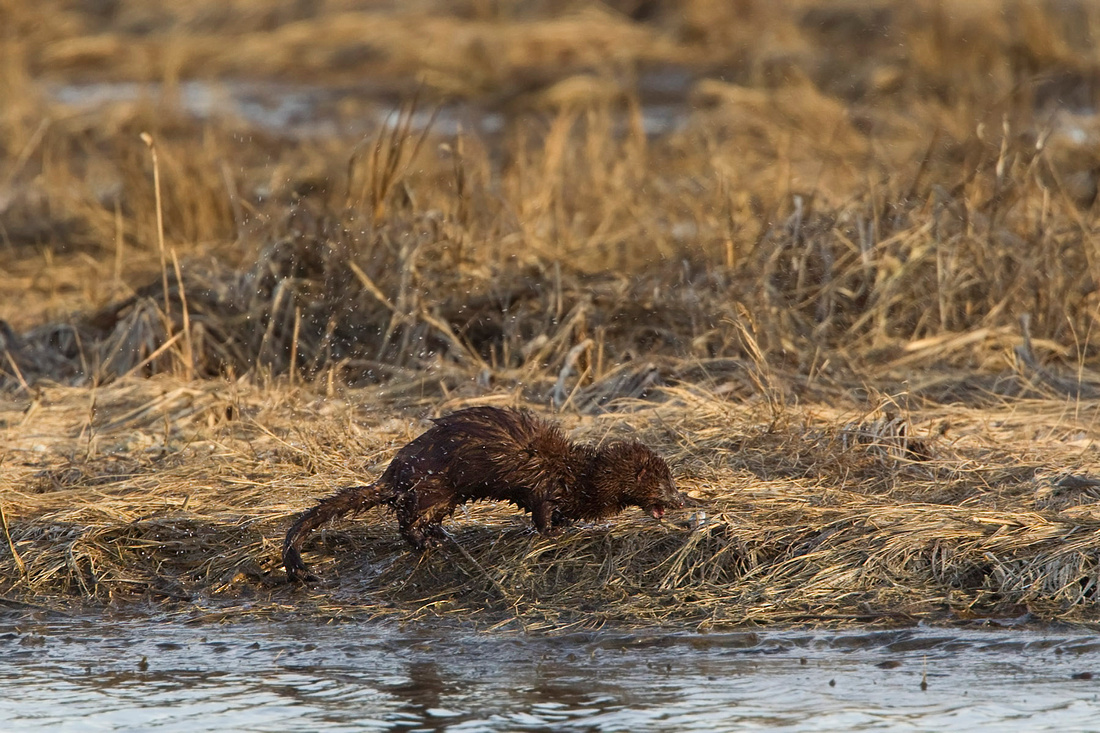 A few days later, I got another treat when an adult Bald Eagle flew into an Old Lyme salt marsh and landed on an unknown object in the water. Again, too distant for really good photos, I watched as the eagle began tearing into the object it landed on.
A few days later, I got another treat when an adult Bald Eagle flew into an Old Lyme salt marsh and landed on an unknown object in the water. Again, too distant for really good photos, I watched as the eagle began tearing into the object it landed on.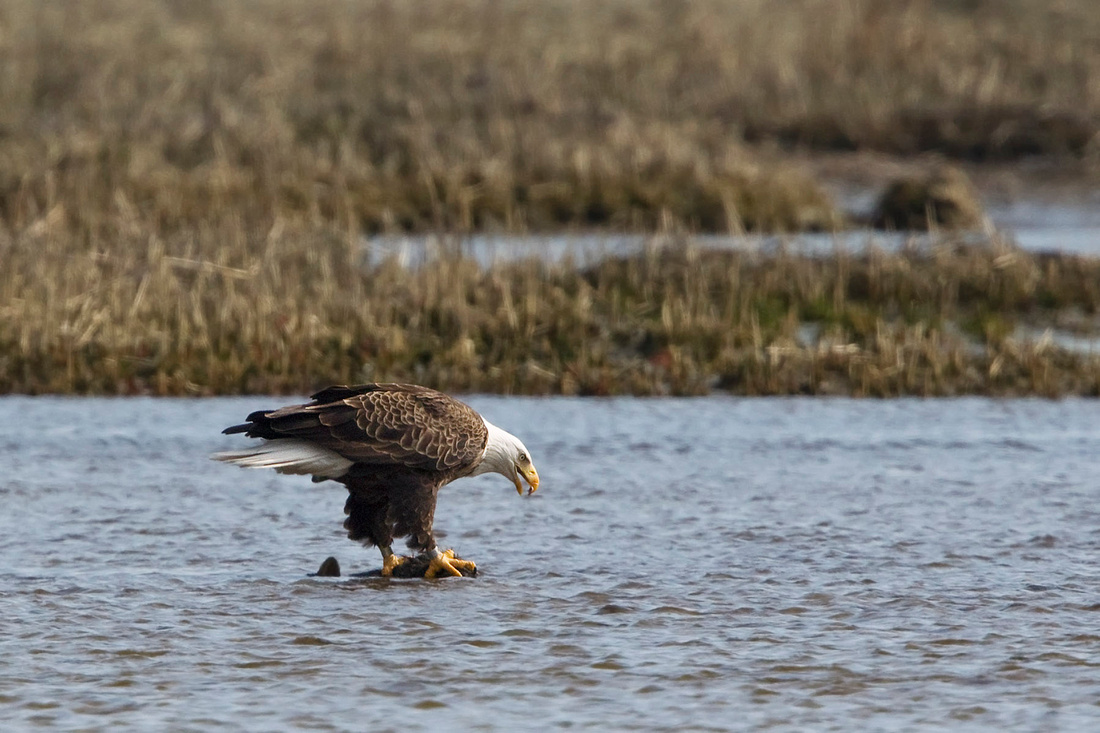 It continued to work on the object as the tide receded, exposing it as some small creature with big ears. The eagle kept on scavenging .....
It continued to work on the object as the tide receded, exposing it as some small creature with big ears. The eagle kept on scavenging .....
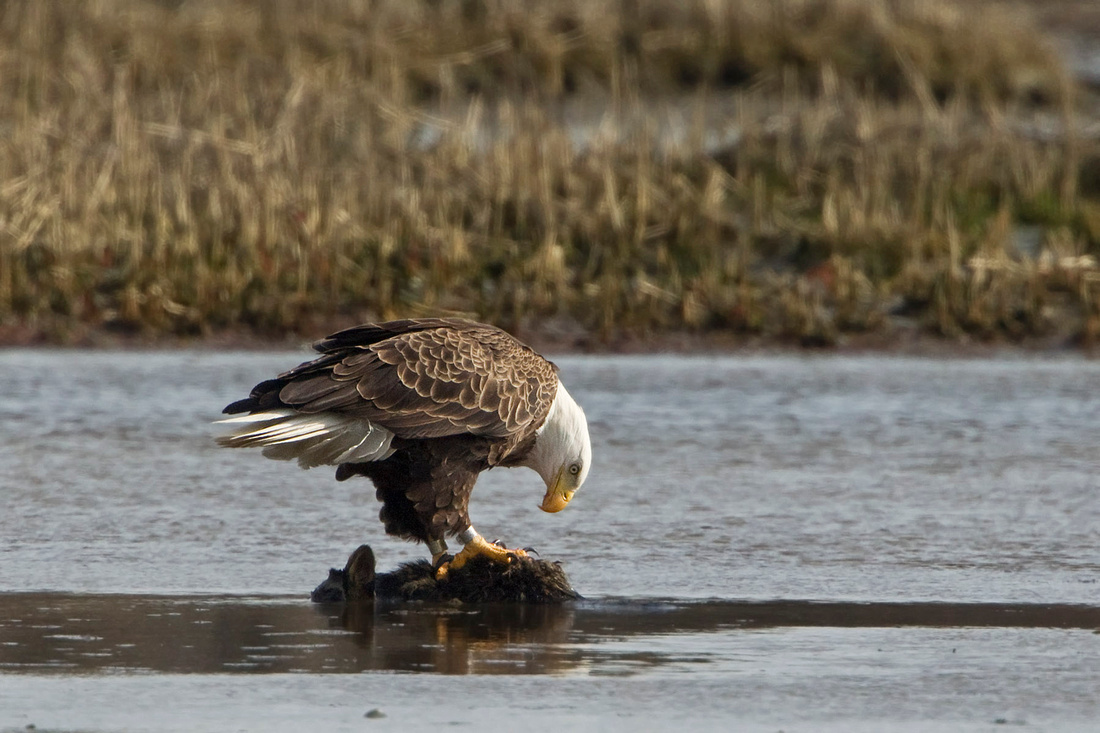 for more than half an hour until it had taken a big chunk out of the creature and the tide had completely receded, leaving the exposed mud flat that the creature must have been stuck in.
for more than half an hour until it had taken a big chunk out of the creature and the tide had completely receded, leaving the exposed mud flat that the creature must have been stuck in.
 Waterfowl are in transition and made up most of the bird activity I witnessed the past two weeks. In Niantic Bay I saw a Common Loon that had almost fully molted into breeding plumage and on a small pond a pair of Mute Swans' courtship dance led to mating. On Long Island Sound, sea ducks are also wrapped up in courtship activity. This Red-breasted Merganser in Waterford was looking a bit like Don King in its effort to look attractive to the females.
Waterfowl are in transition and made up most of the bird activity I witnessed the past two weeks. In Niantic Bay I saw a Common Loon that had almost fully molted into breeding plumage and on a small pond a pair of Mute Swans' courtship dance led to mating. On Long Island Sound, sea ducks are also wrapped up in courtship activity. This Red-breasted Merganser in Waterford was looking a bit like Don King in its effort to look attractive to the females.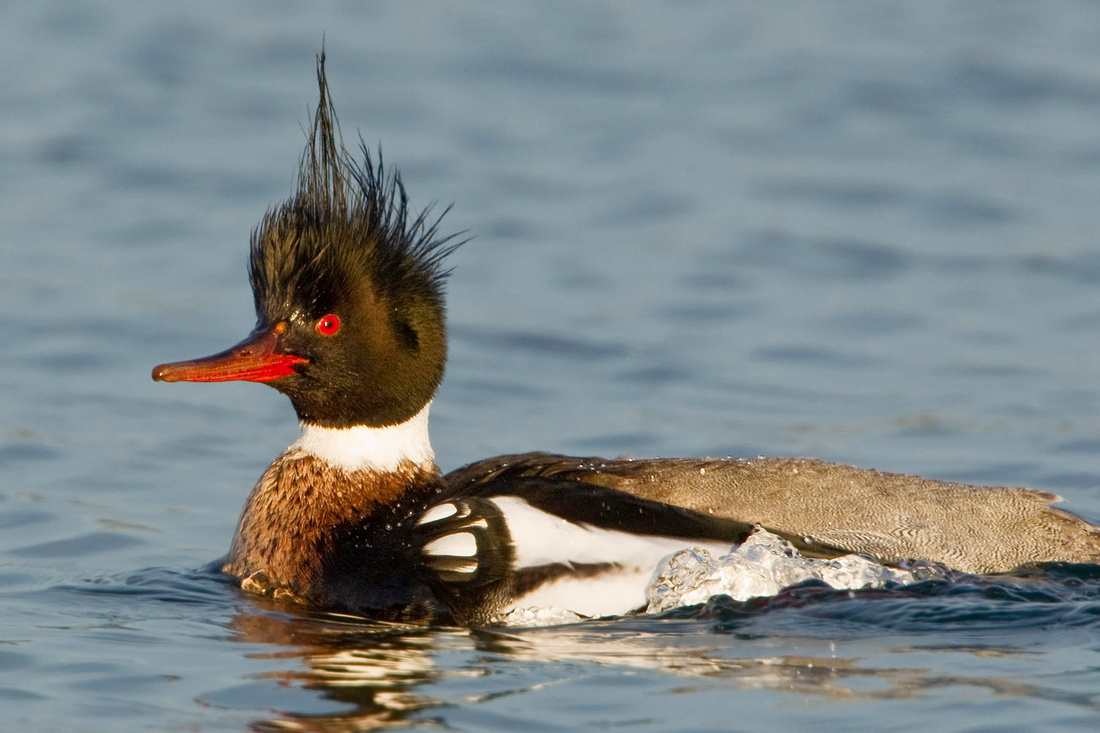 Great Cormorants on the Connecticut River are still around, although their numbers seem down this year, and are showing the striking white throat patch and feathering on the head and neck of breeding plumage. Along the coast, Double-crested Cormorant numbers are building, exhibiting a more subtle breeding plumage, with small crests of feathers barely visible behind their vivd green eyes.
Great Cormorants on the Connecticut River are still around, although their numbers seem down this year, and are showing the striking white throat patch and feathering on the head and neck of breeding plumage. Along the coast, Double-crested Cormorant numbers are building, exhibiting a more subtle breeding plumage, with small crests of feathers barely visible behind their vivd green eyes.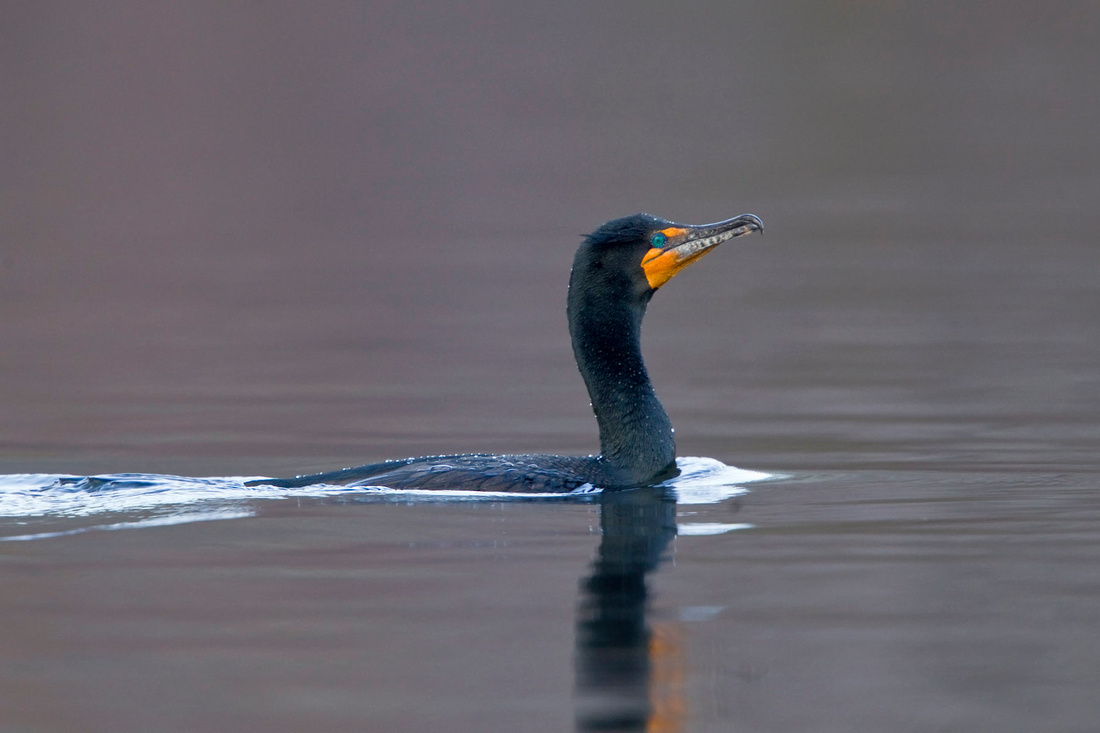 Pied-billed Grebes, like these in Niantic, have paired up and are also showing their breeding plumage ........
Pied-billed Grebes, like these in Niantic, have paired up and are also showing their breeding plumage ........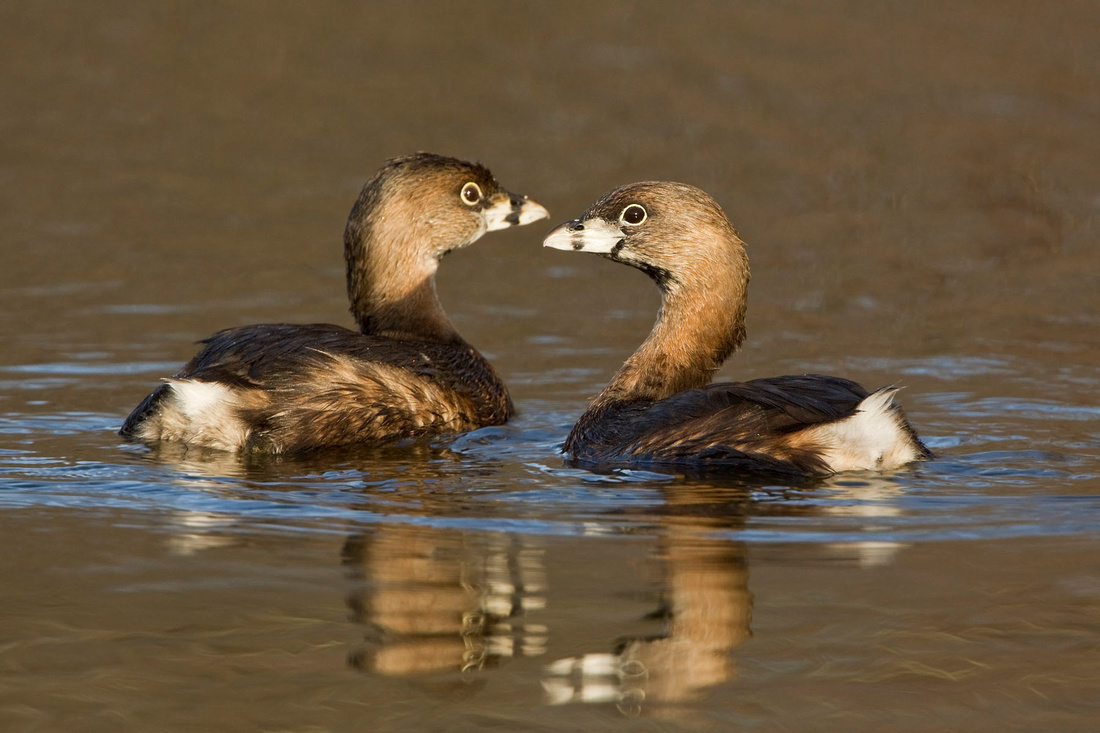 a white beak with a black band and a black throat patch.
a white beak with a black band and a black throat patch.
 Ducks are on the move, and can show up just about anywhere. I've seen small flocks of Green-winged Teal at Harkness, Rocky Neck, and Hammonasset State Parks and at Great Island in Old Lyme the past two weeks. At Harkness Park in Waterford, a drake Northern Shoveler was reported last week and continues as of March 20th.
Ducks are on the move, and can show up just about anywhere. I've seen small flocks of Green-winged Teal at Harkness, Rocky Neck, and Hammonasset State Parks and at Great Island in Old Lyme the past two weeks. At Harkness Park in Waterford, a drake Northern Shoveler was reported last week and continues as of March 20th.
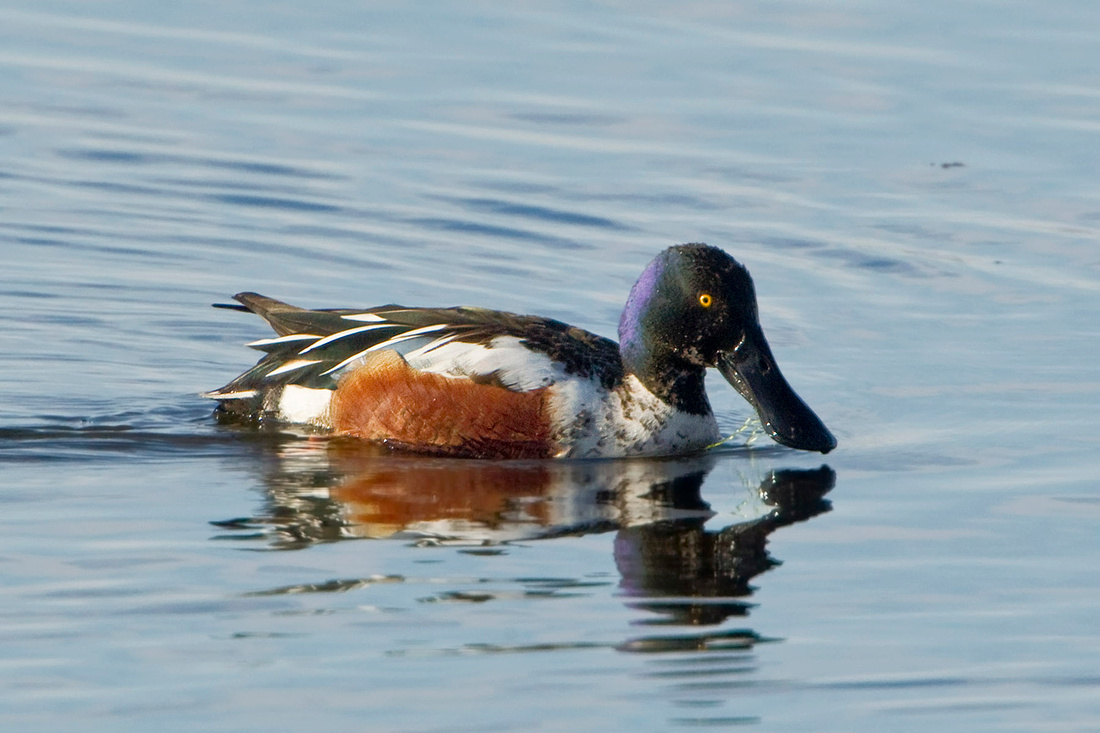 It's now paired up with a hen shoveler. The ducks are not easy to get close to but can be easily seen from the entrance road.
It's now paired up with a hen shoveler. The ducks are not easy to get close to but can be easily seen from the entrance road.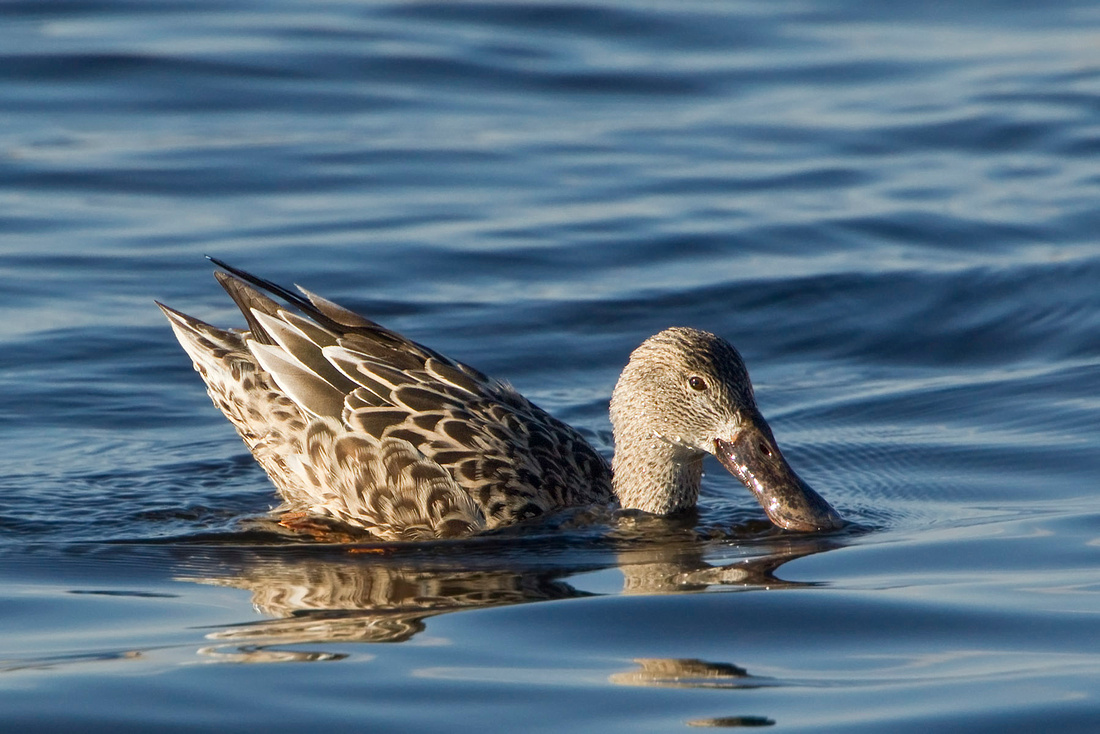
Also in the same pond at Harkness, are a small flock of American Wigeon and Gadwall (pictured below) along with the more common Mallards and American Black Ducks and Hooded and Red-breasted Mergansers.
Another unexpected and pleasant surprise was a flock of Lesser Scaup showing up on small pond in Niantic. At first they were out in the middle ...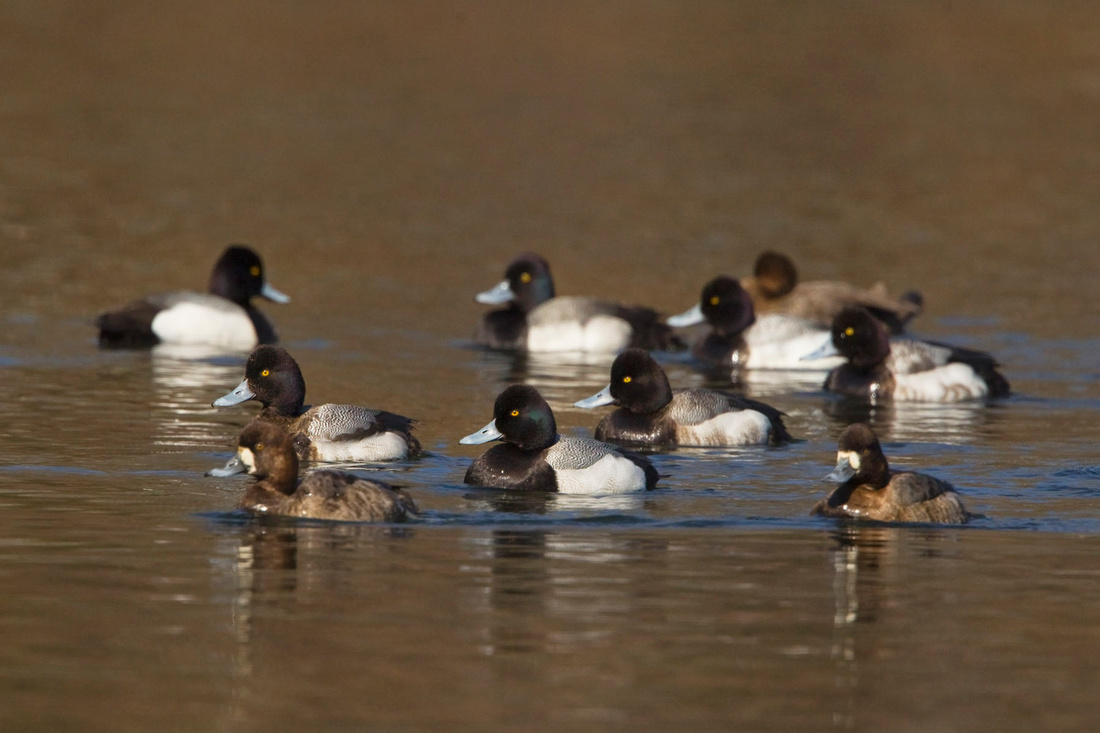 but as the wind picked up, a small group made its way slowly toward the shore in my direction.
but as the wind picked up, a small group made its way slowly toward the shore in my direction.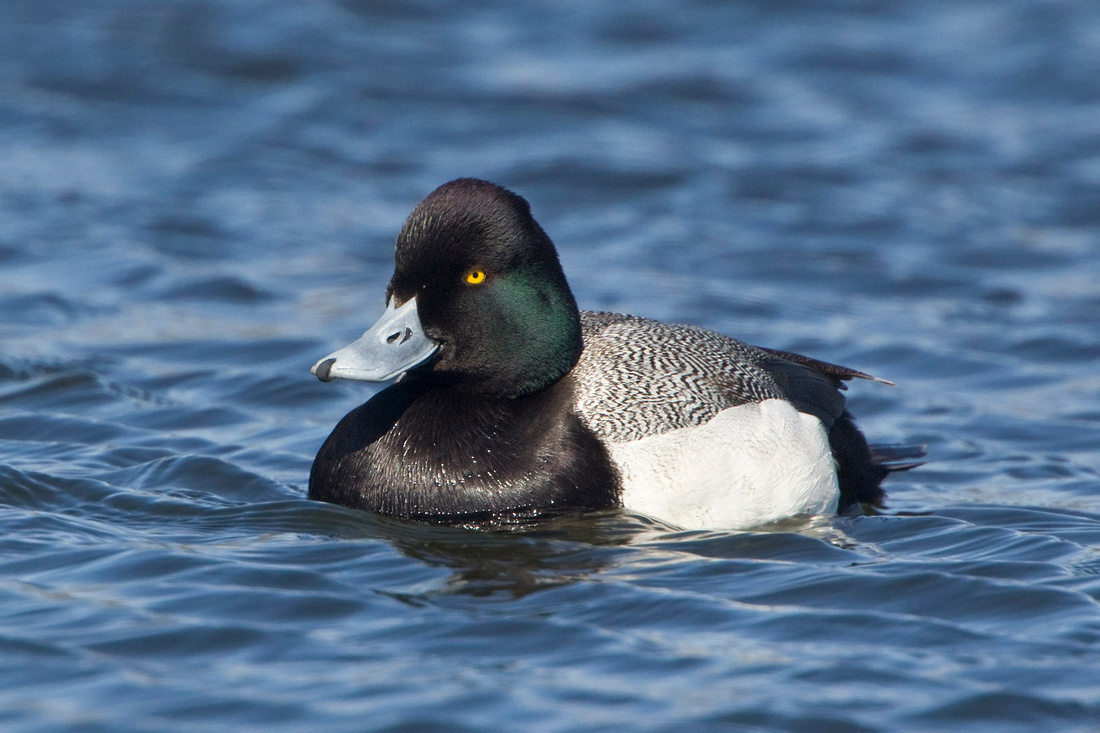
It's always great when they are close enough to easily see the field marks that distinguish them from Greater Scaup, including the heavier barring on the back, thinner nail on the bill and the point or corner on the back of the head.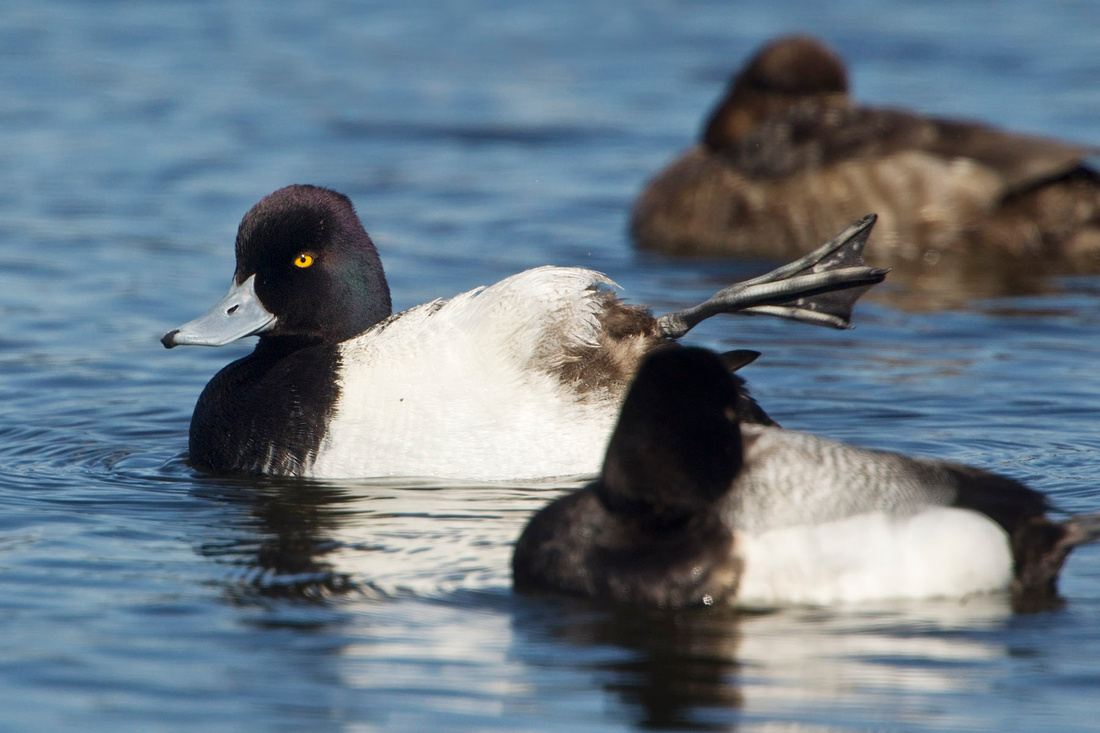
It's an even greater treat when they are relaxed and behaving calmly and naturally right in front of you .......
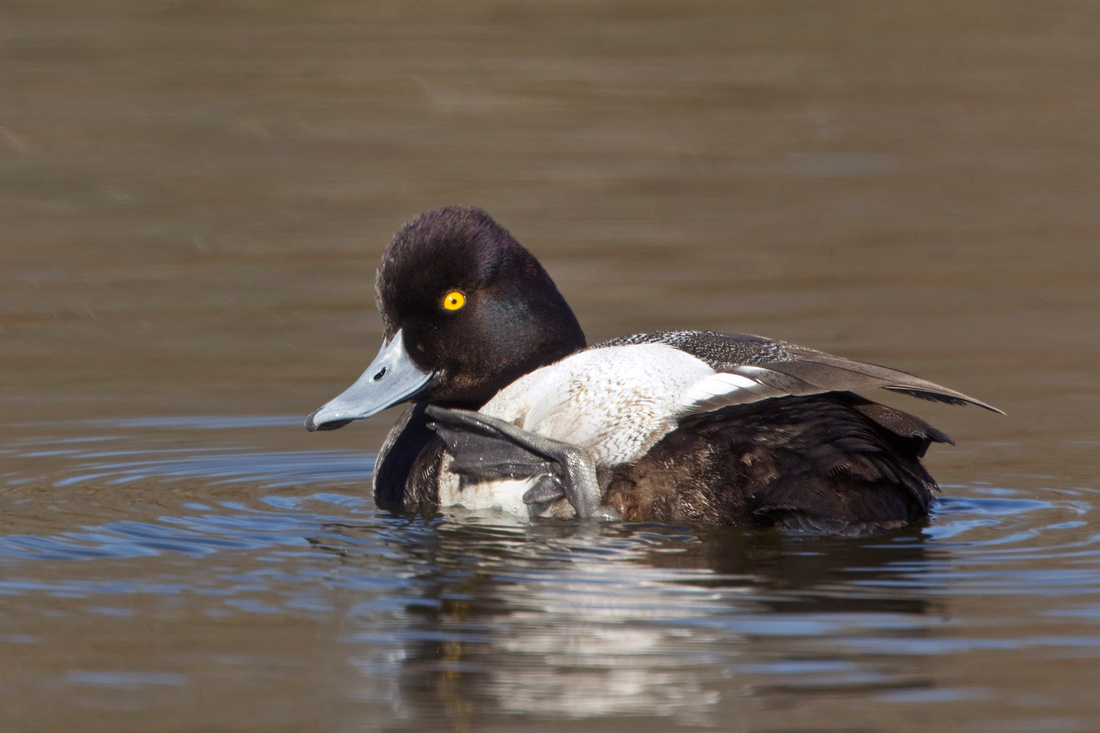
stretching, preening and even sleeping, even if it's with one eye open.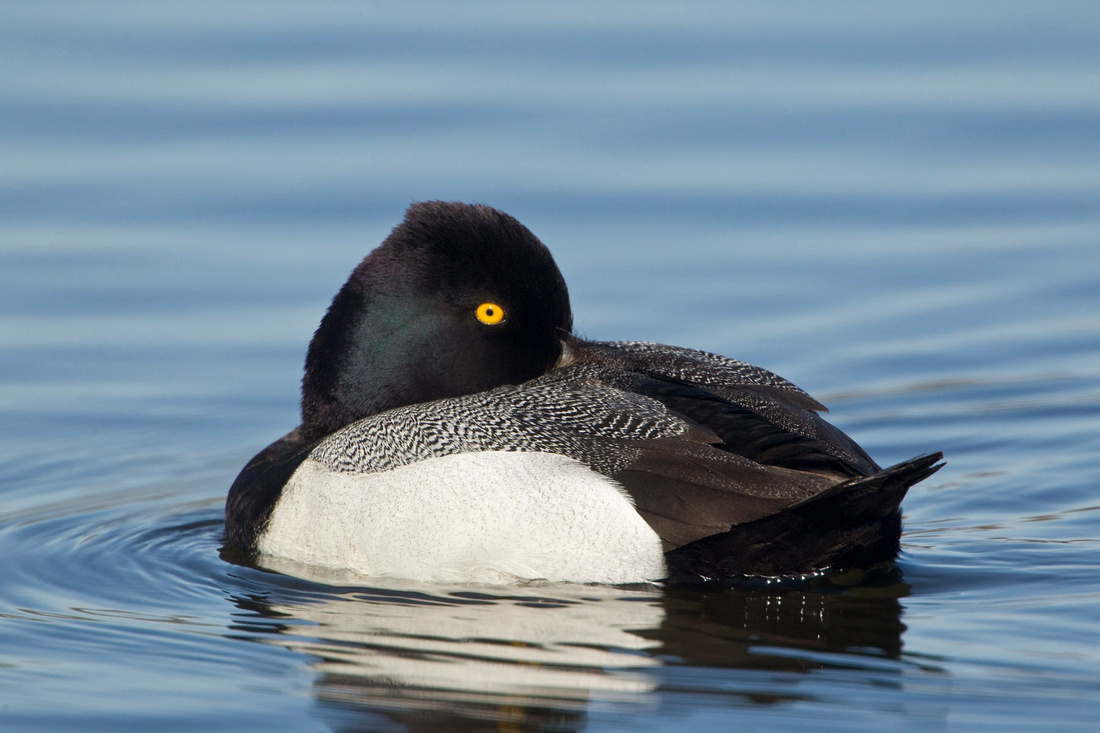

This time of year can try the patience of many birders, as well, who are weary of winter's drabness and are looking forward to spring migration and the wealth of new species it brings, and the return of their songs to the woods. I've always found March to be a frustrating time for my photography for similar reasons, but had the distraction, both for work and for entertainment, of college basketball's March Madness to fill the void. The present state of college basketball, and college sports in general, with the musical chairs of schools and leagues has spoiled a lot of the fun, especially for us in Connecticut. But that's another story altogether. So, without the basketball tournaments to look forward to, this promised to be a long month.
There are always birdy things to look forward to in March, like the growing flocks of Bonaparte's Gulls, the evening flight displays of the American Woodcock and the comical courtship antics of mergansers and goldeneyes. So with that in mind, I keep my ear to the grindstone (an obscure reference to one of my all-time favorite movie scenes - Google "Ya suspect"). Anyway, when the ice melts, I often check Dodge Pond in Niantic, where I've photographed Hooded Mergansers close to shore in the past. I checked the pond early this week and found no mergansers, but did see two Pied-billed Grebes and four American Coots. The grebes quickly moved farther out, but the coots stuck nervously to the shore in a corner of the pond. 
I was able to get very close to the coots, lying on my belly, photographing them from just a few yards away. It did not appear that I was the one making them act nervously.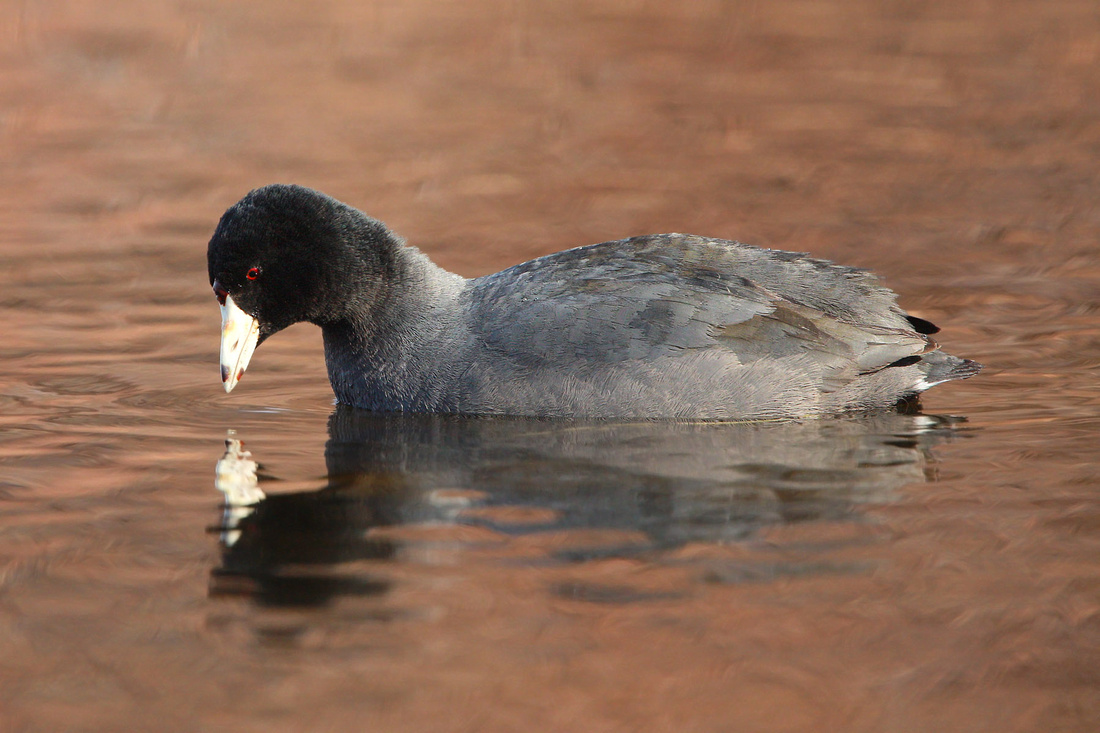
Occasionally, they would swim briefly out into the open water,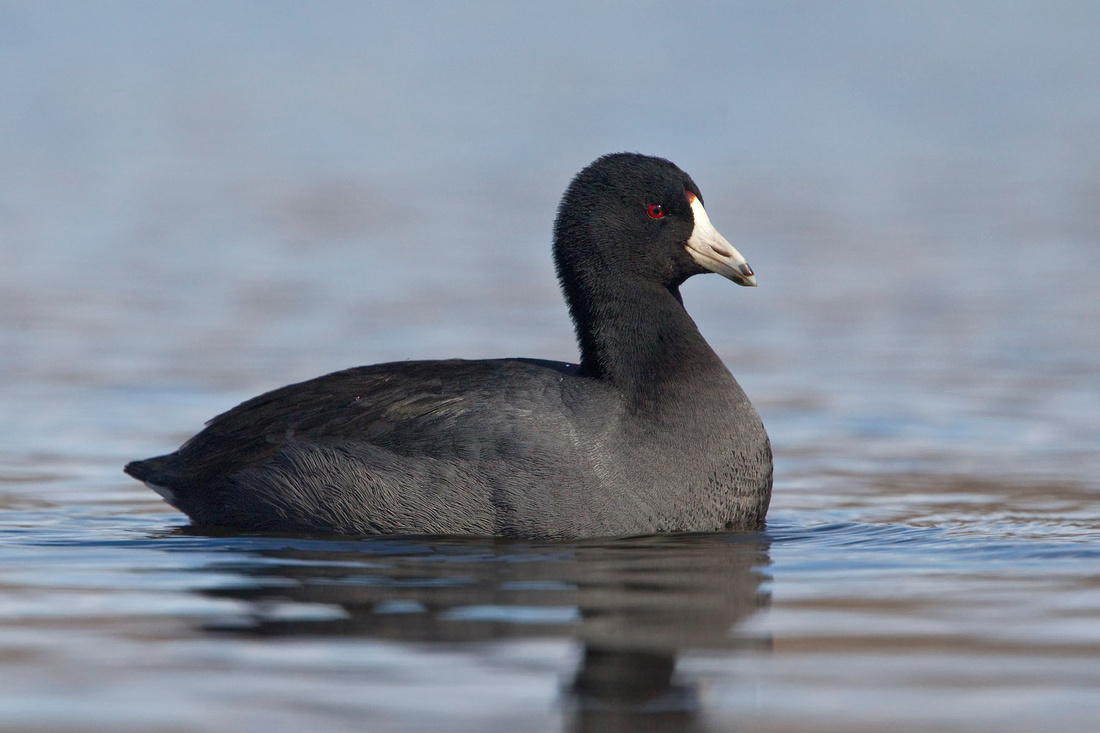 ...... dive beneath the surface .....
...... dive beneath the surface .....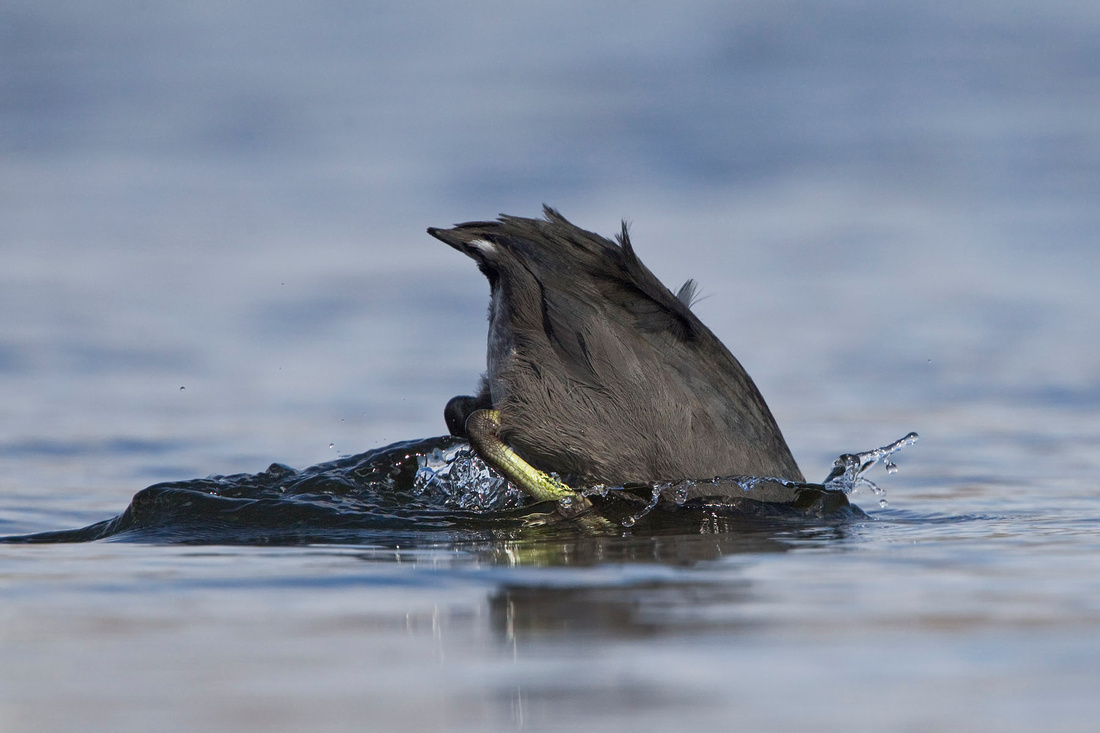 ....... then pop up with plant stalks, which they hurriedly tried to gobble down before the others tried to steal the prize away .......
....... then pop up with plant stalks, which they hurriedly tried to gobble down before the others tried to steal the prize away .......
...... then they quickly retreated back to shore, sometime with plants in tow.
I couldn't figure out why they kept swimming back to the shore with me there, but was happy enough photographing them at such close range. I noticed they often eyed the sky, and after about a half an hour I discovered why. A large bird flew out from the wooded shore, where it was hidden from my view, and flew across the pond letting out a sharp chirp. The coots hustled back into their secluded corner.
The large bird that had the coots acting so anxiously was an Osprey, the first of the season! It landed on a branch at the edge of the pond. Then after a few minutes flew out over the pond and circled a couple times, occasionally stopping to hover. As the Osprey circled, the coots stayed tucked under an overhanging branch (despite it's exclusive fish diet, Osprey must be similar enough to an eagle to cause the coots panic). On the other side of the pond, the Osprey dove and came up with a large fish (it looked like a trout) then flew back into the wooded shore, where it once again became invisible.
I have lived in Niantic for the past 25 years, longer than I have been interested in birds. For me, the return of the Osprey each March is the true sign that spring has arrived. It's usually when I'm out in the yard, doing spring clean-up, that I hear that high pitched chirk-chirk call and look up to see the familiar wing beats. Osprey often follow the Pattagansett Brook that winds behind my house, following the spring herring runs as the fish make their way up into the ponds to spawn. Seeing the Osprey hovering over my yard is an annual rite, probably since before my birding days, and it's difficult to describe how and why it instantly lifts my spirits. I associate the timing of the first Osprey sighting with the college basketball tournaments, linked mentally because they both usually come in mid-March. This year's first sighting was March fourth, certainly a week or two earlier than usual.
I grew up in Niantic and Old Lyme, and even at the Osprey's nadir in the 1970's, those were the last two strongholds for the birds in the state. When I moved back to Niantic in 1988, Osprey were still scarce in the state. There were only a handful of nests outside of those two towns, none west of the Connecticut River, but it seems I always remember seeing them. I started my career in photojournalism at a small weekly paper, and one of the first picture stories I did was about the efforts to help the Osprey recovery in the state. My first foray into nature photography was on grainy black and white Tri-X film.
That was in 1990, two years before I became interested in birds. Since then, Osprey have made a remarkable recovery and are commonly seen throughout the state. It's fair to say they're back. I've taken thousands of pictures of Osprey in the ensuing years, but I still never get tired of seeing and photographing them. If there is any one bird that I can call my favorite or feel some kind of psychological or spiritual connection with, it's the Osprey.
There is a disturbing recent development that could hurt the Osprey population, in Connecticut and beyond. In the last decade or more there's been a drastic decline in the numbers of anadromous herring returning from the ocean each spring to spawn in the streams, ponds and and lakes. These once bountiful runs of alewives and blueback herring (we called them buckeyes) are a major food source for Osprey, but they are dying out at an alarming rate in Connecticut. If the decline continues, I may no longer see Osprey following the brook that runs behind my house each spring.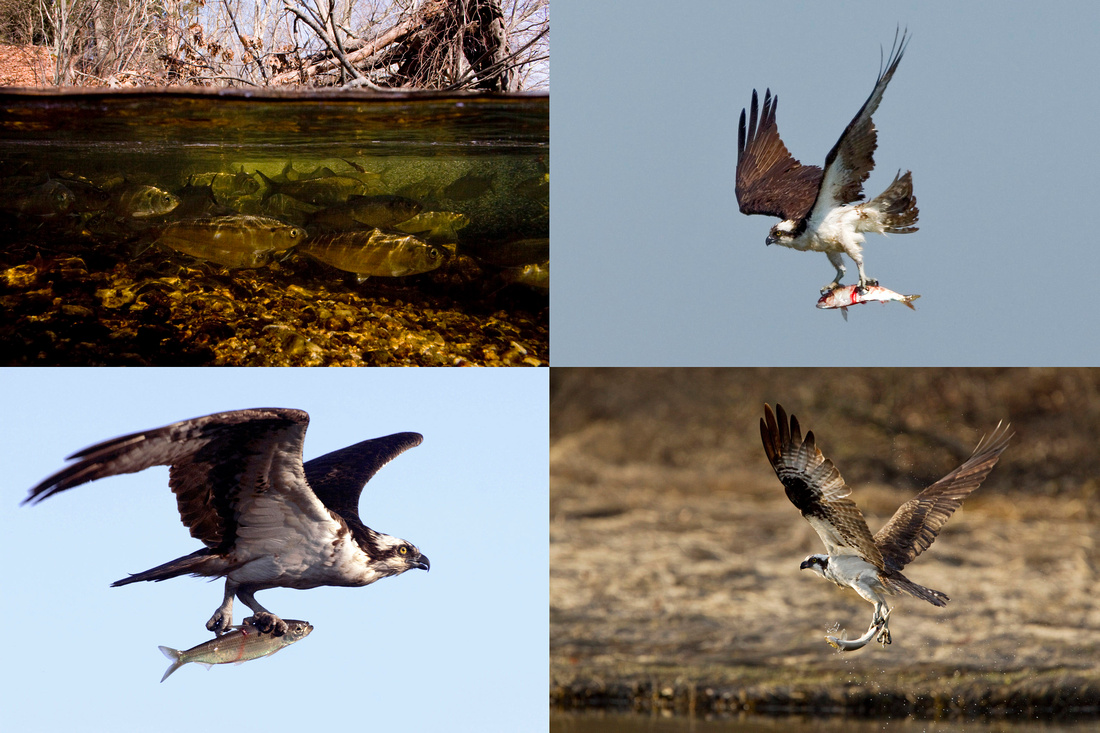
After the lift of seeing my first Osprey, I went out that evening to see if I could experience another rite of spring, the courtship display of the American Woodcock. I'd checked a few locations in Lyme and Salem recently without luck, but at dusk, right on queue, I heard a loud peeent, then another more distant one. I heard a total of four different birds, but only one took flight in an aerial display, barely visible against the deepening blue sky. Perhaps it's a bit early for the big show.
So March kicked off with two new birds for the year, Osprey and American Woodcock. Common birds, but still a joy to see. And, as I went down to my basement to find a copy of my old Osprey story I looked out at my bird feeders and saw a male cardinal, four bluebirds, a Red-breasted Nuthatch and a Carolina Wren all together. Not a bad week.
]]>
February was a quiet month for new sightings, as I only added two Connecticut species. As the month drew to a close there were plenty of signs of spring and I would expect the new sightings to pick up in the next week or two. Seeing a Dovkie (in Massachusetts) was a treat, especially at such close range and being able to get some good pictures provided a big psychological lift in what is a pretty dreary time of year. Even though I didn't see many new birds, I had quite a few opportunities to photograph some of the resident birds. Here's a recap.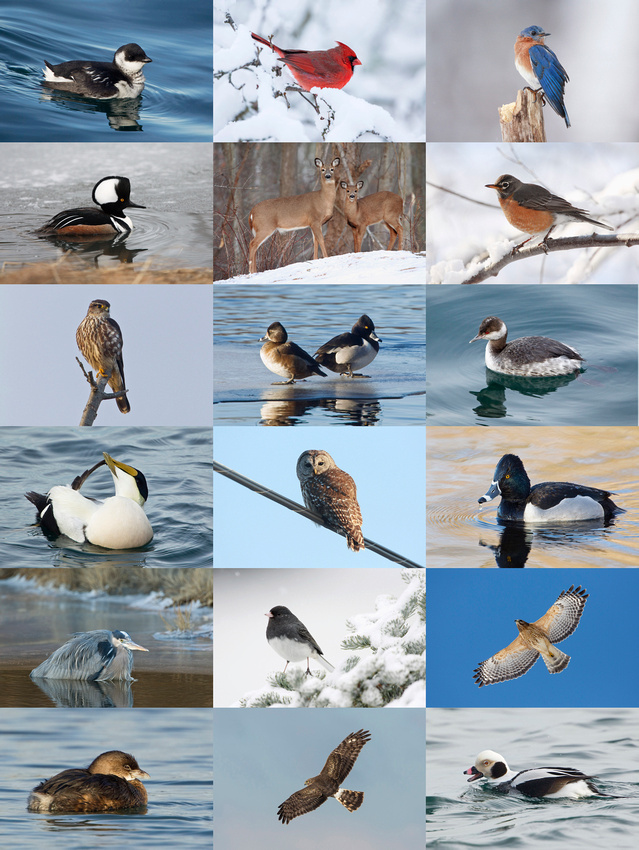

That would have been about it for the week until a last minute decision added a big (well, actually tiny) splash. I was traveling to Massachusetts Tuesday, and before I left I checked to see if there were any interesting bird sightings near where I was heading. There was nothing close by, but I saw some pictures posted of Dovekies in Provincetown Harbor, still a two hour drive from my destination. Dovekies are ocean birds, usually not seen near land except when nesting along the arctic coastline, and despite numerous sightings in the Northeast in the past few years, I'd never seen one. Even with the cloud cover, forecasted to thicken throughout the afternoon, I decided to make the trip at the last moment. I headed south, and by the time I reached Cape Cod the sky was clear blue and sunny. As I rounded the elbow, the clouds appeared again, making their way ominously (for photography) to the east. The race was on to reach the tip of the cape before the sun disappeared. I arrived at MacMillan Park just after 3 p.m. and with the clouds just about to cover the sun, I raced out onto the pier. Scanning the water as I went, I got to the last berth without seeing my target. Looking down over the edge I saw a small bird surface directly below me, but it turned out to be a Horned Grebe. I aimed my camera down toward the grebe and was about to start shooting when an even smaller bird surfaced a few feet away. A Dovekie, a life bird, and the last of the Atlantic alcids I had not seen. A few seconds later another one popped up a bit farther away, near the hull of a fishing boat. 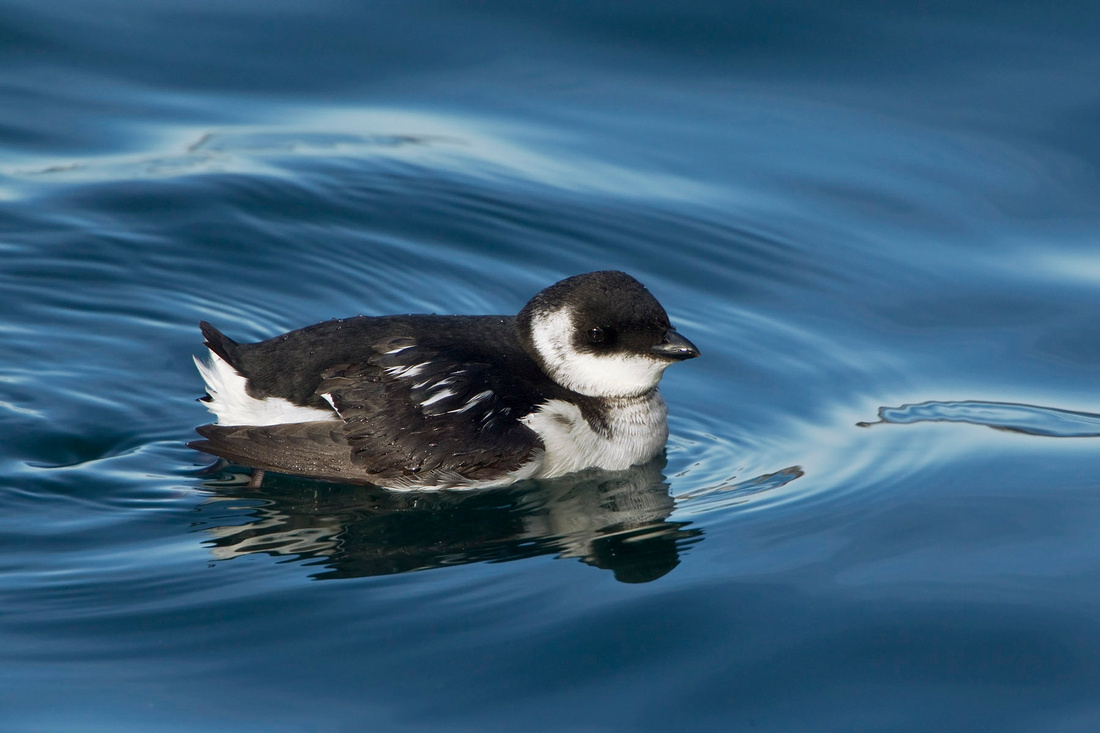
With the sun just beginning to fade behind the first thin clouds, the light was ideal to photograph the high contrast black and white birds. I snapped away as they bobbed on the water like little Nerf footballs, preening and diving. They were so close, and seemed oblivious to the all the activity on the fishing vessels surrounding them. In many instances, Dovekie sightings near land occur after big storms, when birds are "wrecked" and in bad shape. These birds were so lively and energetic, it was amusing to watch their bubbly activity. Looking down from the pier, it was possible to see them flying under water as alcids do. 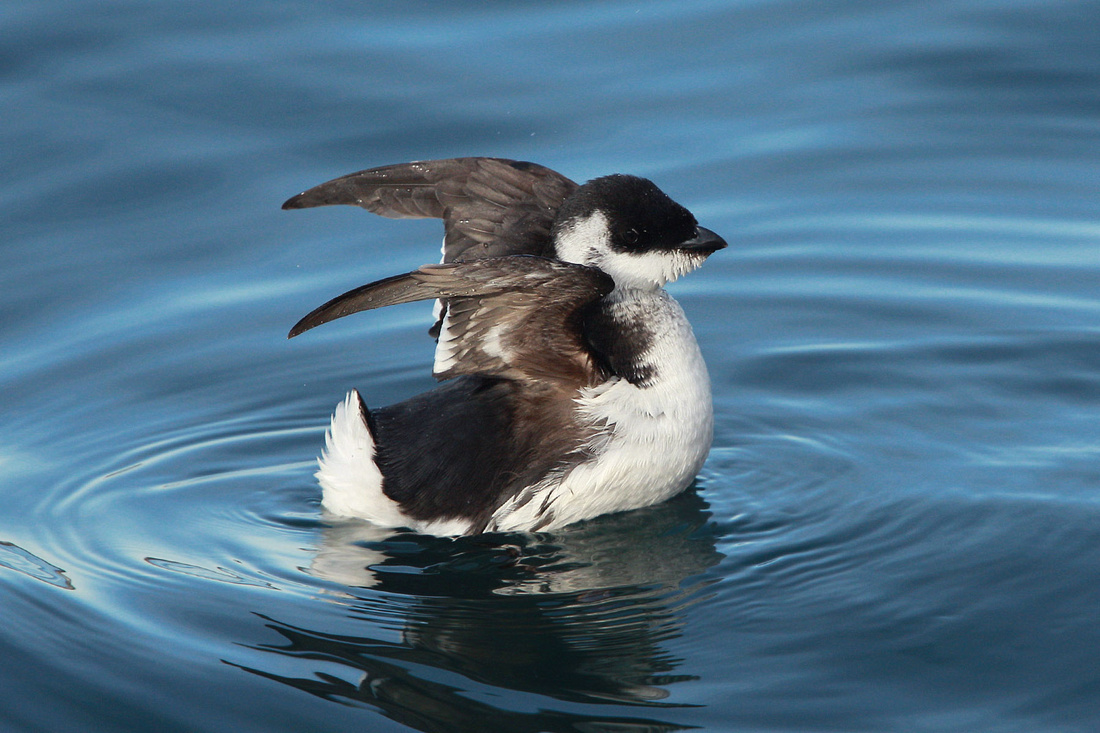
After about 20 minutes, the sun faded completely behind the clouds. Concentrating on the Dovekies at first, I then turned my camera towards some of the other regulars at the pier, including Common Eiders, Long-tailed Ducks and Horned Grebes. 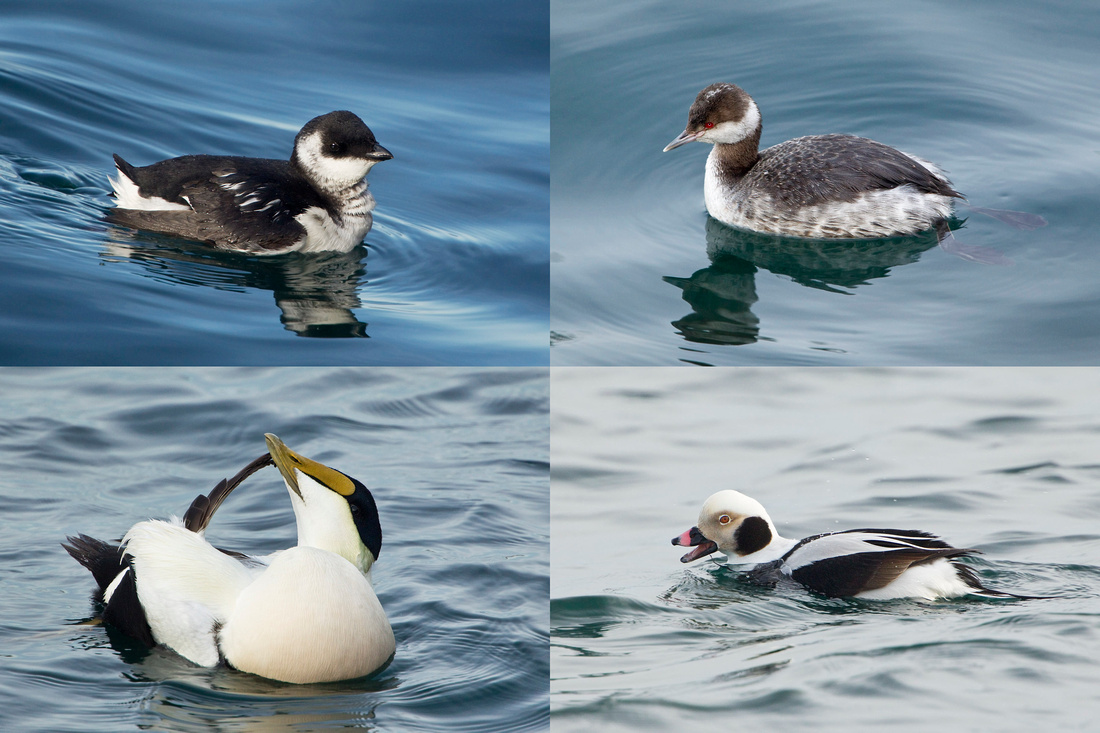 Also present were Red-breasted Mergansers and Common Goldeneye, but as the clouds thickened and the afternoon light grew dimmer I quickly ran out of time for photography. Another factor that made it tougher to shoot from the pier was the falling tide, causing steeper angles and greater distances to the birds. It looked to be about eight to ten feet difference to the high tide mark. If you were planning a trip there to take pictures, it might be wise to consider timing your visit at or near high tide.
Also present were Red-breasted Mergansers and Common Goldeneye, but as the clouds thickened and the afternoon light grew dimmer I quickly ran out of time for photography. Another factor that made it tougher to shoot from the pier was the falling tide, causing steeper angles and greater distances to the birds. It looked to be about eight to ten feet difference to the high tide mark. If you were planning a trip there to take pictures, it might be wise to consider timing your visit at or near high tide.
The light snow that fell overnight last Thursday stuck to the trees creating a picturesque setting. I spent the early morning looking for wintry scenes in my backyard, and got some pictures of cardinals, both male and female, on snow covered branches. The woods around the brook also made a nice picture as the morning sun broke through.
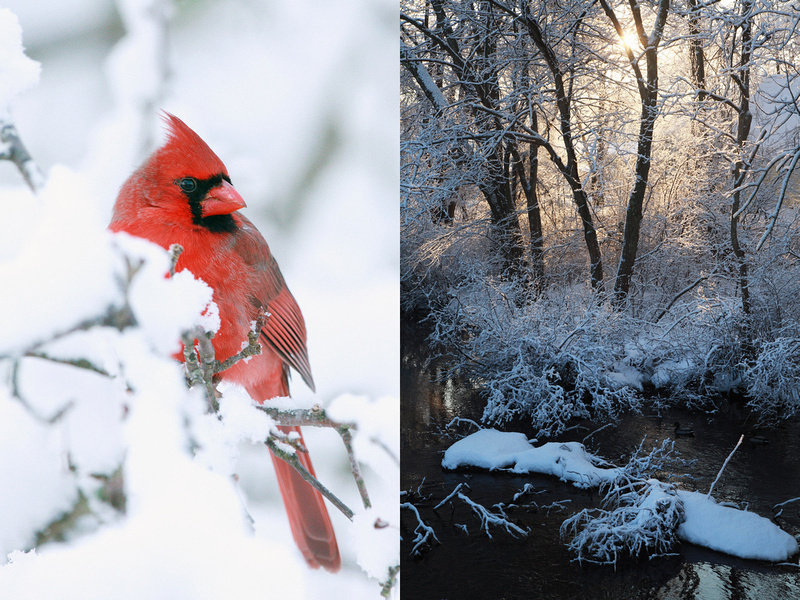
Before the snow melted off the trees, I wanted to find another spot, so I headed to nearby Rocky Neck State Park. I took a quick drive through the park and stopped to take a few photographs of the snow covered salt-marsh. Then I walked through the camp grounds and found a noisy group of American Robins feeding near a small pond. Many non-birders consider a robin sighting one of the first signs of spring, but they can usually be found in and around wetlands here throughout the winter. 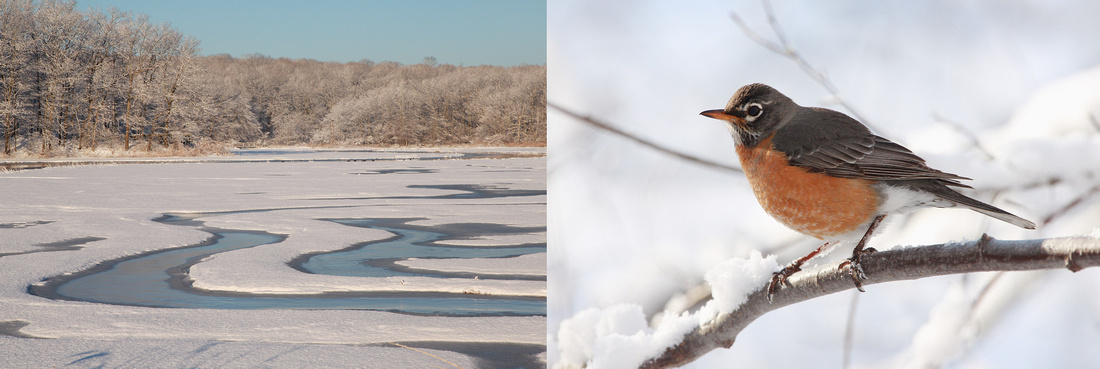
As it warmed up, the snow started to fall off the trees so I decided to head home. As I pulled into my driveway I saw a Red-shouldered Hawk perched in a tree in my neighbor's yard. For several years there's been a pair of Red-shoulders in our neighborhood, they must nest nearby. Often in the spring they fly territorial or courtship flights around the street and several times I've photographed them at close range as they flew low circles over my yard in a chorus of piercing screams. I grabbed my camera and waited by the garage door to see if the hawk would put on a similar display, but it seemed content to sit silently perched. Perhaps it was too early in the season for the courtship flight. After several minutes, the hawk took flight, heading away, but then banked back towards me and began it's shrieking kee-er, kee-er call. It circled directly over me twice, and sure enough was joined by a larger one, the female, that flew in from behind me and addied to the chorus. The second hawk circled once more and then the pair headed off down the street. I got lots of pictures of both hawks at close range. The sun, which was high in the sky and would normally cause backlighting, reflected up off the snow cover lighting the underside of the hawks beautifully.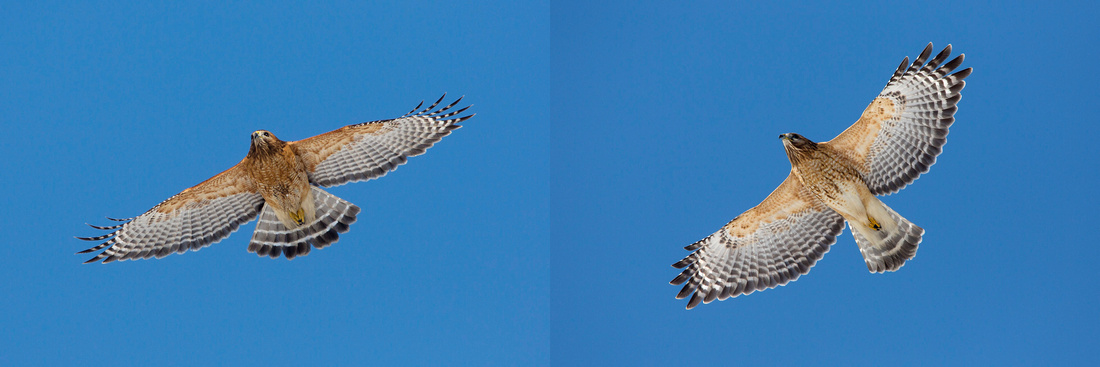 I did not see any new birds this week, except for a Killdeer in Old Lyme, which I saw in Rhode Island in January. I was happy to find a few old favorites to photograph over the long weekend, including a flock of Ring-necked Ducks feeding in a small patch of open water on a mostly frozen pond. I spent almost an hour photographing as they dove at the edge of the ice to feed, waddled out onto the ice to preen, then went back to feeding. In a few pictures (like the top right) I was able to capture the rarely visible iridescent ring on the male's neck that the bird is named for.
I did not see any new birds this week, except for a Killdeer in Old Lyme, which I saw in Rhode Island in January. I was happy to find a few old favorites to photograph over the long weekend, including a flock of Ring-necked Ducks feeding in a small patch of open water on a mostly frozen pond. I spent almost an hour photographing as they dove at the edge of the ice to feed, waddled out onto the ice to preen, then went back to feeding. In a few pictures (like the top right) I was able to capture the rarely visible iridescent ring on the male's neck that the bird is named for. Despite the uplifting signs of spring, there were plenty of reminders of the cumulative toll the winter can take on creatures. I saw a pair of Wild Turkeys in Old Lyme that seemed to be playing in traffic as they temped fate by picking for food on the side of a busy road at dusk. A Barred Owl, probably the same one that I saw a couple weeks earlier, hunted along the edge of the road from a utility line in broad daylight. I saw herds of deer struggling, one group browsing at the top of their reach on cedar trees, another gingerly making its way across a field of icy snow. These signs of hardship put a damper on the spring fever. The week ended on a somber note when I saw a Great Blue Heron sitting in water nearly half way up its body. I can't be sure why, but it almost seems like it was at the edge of the water at low tide, and as the tide came in it didn't have the energy to move. I hope I'm wrong, but the outcome didn't look good.
Despite the uplifting signs of spring, there were plenty of reminders of the cumulative toll the winter can take on creatures. I saw a pair of Wild Turkeys in Old Lyme that seemed to be playing in traffic as they temped fate by picking for food on the side of a busy road at dusk. A Barred Owl, probably the same one that I saw a couple weeks earlier, hunted along the edge of the road from a utility line in broad daylight. I saw herds of deer struggling, one group browsing at the top of their reach on cedar trees, another gingerly making its way across a field of icy snow. These signs of hardship put a damper on the spring fever. The week ended on a somber note when I saw a Great Blue Heron sitting in water nearly half way up its body. I can't be sure why, but it almost seems like it was at the edge of the water at low tide, and as the tide came in it didn't have the energy to move. I hope I'm wrong, but the outcome didn't look good. New Birds - Killdeer (for CT) Total 115 (112 in Connecticut).
New Birds - Killdeer (for CT) Total 115 (112 in Connecticut).
]]>
Earlier in the week I set up a couple new perches in anticipation of the storm, and filled the feeders Friday morning as the snow began. A steady stream of birds attacked the food, knowing what was coming. By mid morning the ground and perches were covered in snow and I set up to take some pictures. The usual cast of characters were all present. Unfortunately, a boorish bunch of starlings also found the feeders, and their noisy battles over the suet drove off the well behaved regulars. I got some pictures of sparrows and juncos on my new spruce bough perch before the wind and weight of the snow dispatched it.

The conditions deteriorated and I gave up on photography. As the winds increased and the snow turned to icy pellets, I knew the inevitable couldn't be far off. We lost power at 7:00 Friday evening and the whining began. Being without power for about a week after both Irene and Sandy, that familiar sinking feeling set in. After a long night of high wind, snow and even lightning, I woke up at 4 a.m. and it was still snowing. Shortly after six, birds began arriving at the feeders, which were completely encased in snow and ice. 
Unable to get at their food, I went out to clear off the feeders. As I chipped away at the ice the hungry flock waited close by. I went in and grabbed my camera before topping the feeders off and throwing some seed on the snow. The birds flew in instantly while I stood a few feet away. I shot the picture below zoomed out to the widest angle, with birds feeding right at my feet.
I decided to take a walk around my neighborhood since there was a rumor that a tree had fallen across the street, taking down the power lines. The snow was about two feet deep but it was hard to tell because of all the drifts, some of which were thigh high. The pristine snow looked beautiful, but after 20 years working in the news media, I was happy not to have to be out covering the storm. I still couldn't resist documenting the conditions, though. 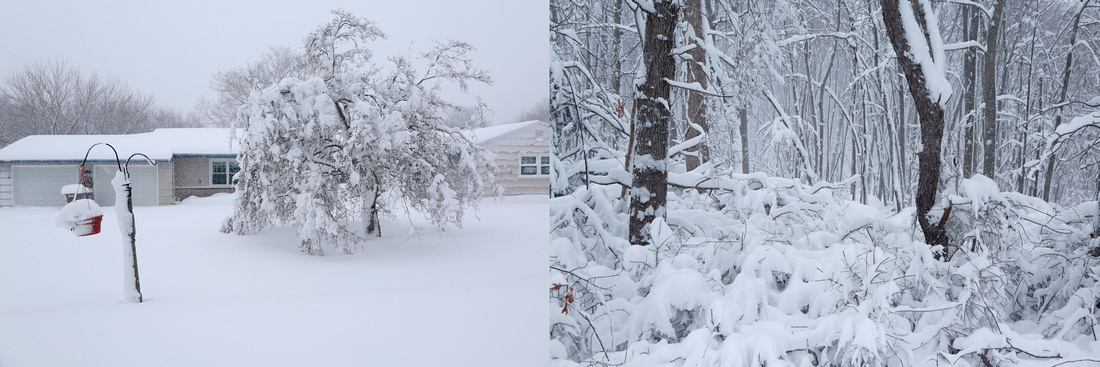
At the top of my street I found the culprit for the power outage, not a fallen tree, but several large pine branches hanging from the electrical wire. Route 156, a state road, was still snow covered and a man was digging to get his car out onto the deserted street.
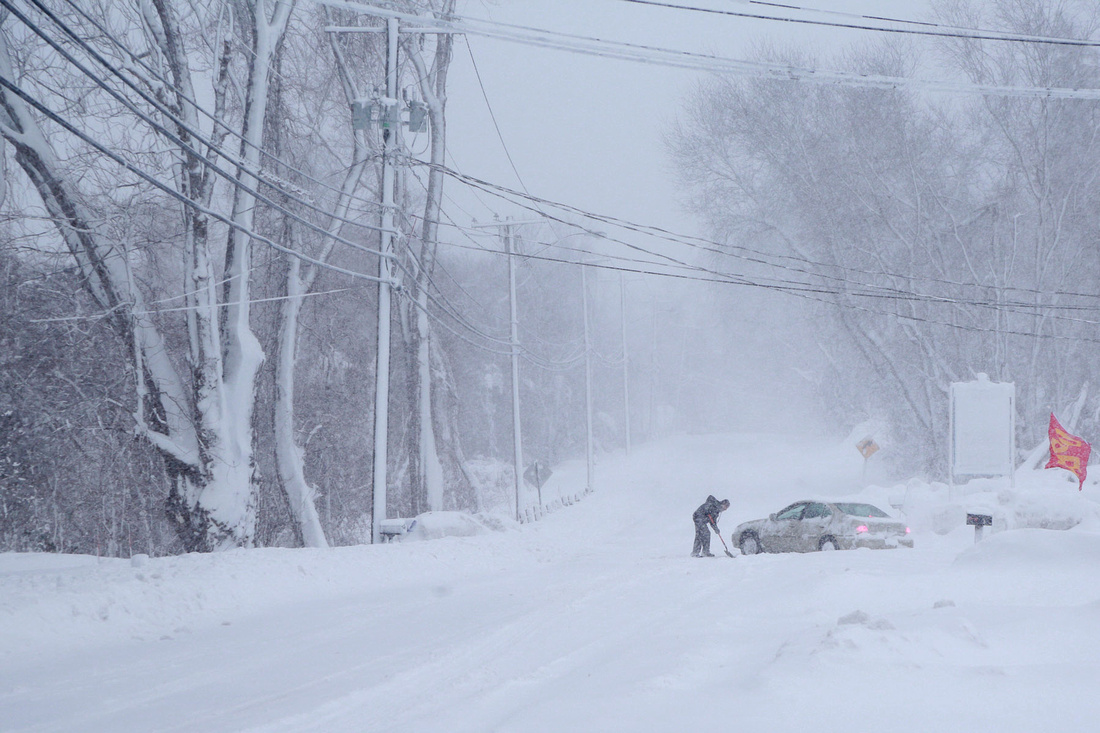
Returning home, my bird feeders were hopping with activity. Included in the fray were two Carolina Wrens, three Northern Flickers and a newcomer. A very dark Savannah Sparrow joined the usual flock of Song, White-throated and American Tree Sparrows and juncos feeding on the ground below. I also noticed three bluebirds visiting the feeders, two males and a female. The female seemed to be sampling the different seed and suet, while the males just served as chaperones. Of particular interest to her was a peanut butter mixture called Bark Butter that I put in holes on a driftwood post. This also attracts chickadees, titmice, woodpeckers, flickers, both nuthatches and even juncos. It also appeals to squirrels and starlings, unfortunately. Absent from my yard this year are Red-bellied Woodpeckers, usually another regular attracted to the Bark Butter.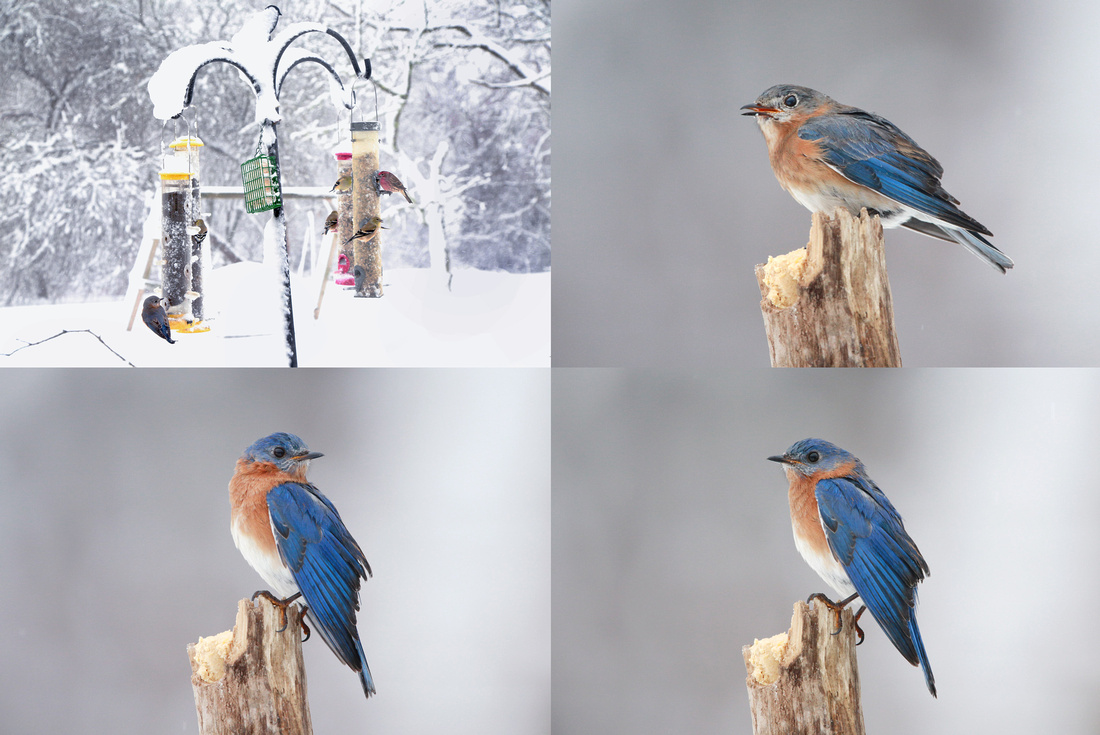
One food I'm not sure of is dried mealworms. I bought some the past two years for Carolina Wrens, that seem to love them. Later I was told that they have almost no nutritional value. If anyone has any experience or insight on this, please let me know. I assume bluebirds would eat them, too. Aside from putting out a variety of feeders, seeds and suet, other important factors in keeping a variety of birds around are having natural food sources like berries available and having cover, especially near the feeders. Although our yard is modest, we are fortunate to have a variety of different trees and bushes that produce berries or flowers that birds feed on at different times of the year. We have woods and a brush pile in back and dense hedges on both sides of our yard that birds take cover in. The Carolina Wrens seem to love dense bushes like arborvitae not only for shelter, but there are likely moths, cocoons and spider webs in them to feed on. We also have a small brook behind our house that remains unfrozen through the winter and provides a constant water supply. I hope to write more about landscaping a yard for birds in an upcoming post, when things are quiet. As the snow wound down Saturday, the dreaded shoveling began. It took four of us more than three hours to shovel our driveway out to the road. With an aching back and half the end of the driveway still blocked by an icy, waist-high plow bank, I asked a neighbor who graciously offered to plow us out hours earlier to finish the job. The rest of the day was spent shoveling walkways and charging cellphones and ipods in the car. With temperatures falling into single digits Saturday night and power still out, our house got down into the 40's. As my daughter got the milk out she quipped that the refrigerator was warmer than the kitchen. The next morning my son and I went out to breakfast with my uncle. Most roads, especially the state roads, remained snow covered and difficult to drive on. Several inches of packed ice and snow, filled with potholes, made for a jarring ride. With 85 percent of our town still without power, we went on a wild goose hunt to find coffee for my wife and daughter, without success. The 10 mile drive home took nearly an hour as bumper to bumper traffic crawled along at a snail's pace. With rain forecast for Monday, the rest of the day was spent clearing the ice from the gutters and shoveling the huge drifts of snow from the back deck and away from the downspouts to prevent basement flooding. Fortunately, the power was restored Sunday afternoon. Unfortunately, that meant we had to watch the Grammy Awards Sunday night.
As the snow wound down Saturday, the dreaded shoveling began. It took four of us more than three hours to shovel our driveway out to the road. With an aching back and half the end of the driveway still blocked by an icy, waist-high plow bank, I asked a neighbor who graciously offered to plow us out hours earlier to finish the job. The rest of the day was spent shoveling walkways and charging cellphones and ipods in the car. With temperatures falling into single digits Saturday night and power still out, our house got down into the 40's. As my daughter got the milk out she quipped that the refrigerator was warmer than the kitchen. The next morning my son and I went out to breakfast with my uncle. Most roads, especially the state roads, remained snow covered and difficult to drive on. Several inches of packed ice and snow, filled with potholes, made for a jarring ride. With 85 percent of our town still without power, we went on a wild goose hunt to find coffee for my wife and daughter, without success. The 10 mile drive home took nearly an hour as bumper to bumper traffic crawled along at a snail's pace. With rain forecast for Monday, the rest of the day was spent clearing the ice from the gutters and shoveling the huge drifts of snow from the back deck and away from the downspouts to prevent basement flooding. Fortunately, the power was restored Sunday afternoon. Unfortunately, that meant we had to watch the Grammy Awards Sunday night.
With school and work cancelled again on Monday, I had some more time to try and get some pictures of the only new sighting this week, a Savannah Sparrow, but it remained elusive. There were a few soggy subjects to be photographed, below.
They included a flock of Mallards who were attracted to the yard by all the activity, but didn't have the nerve to enter the fenced in feeder area. They paraded around the back yard for a while before heading back down to the brook.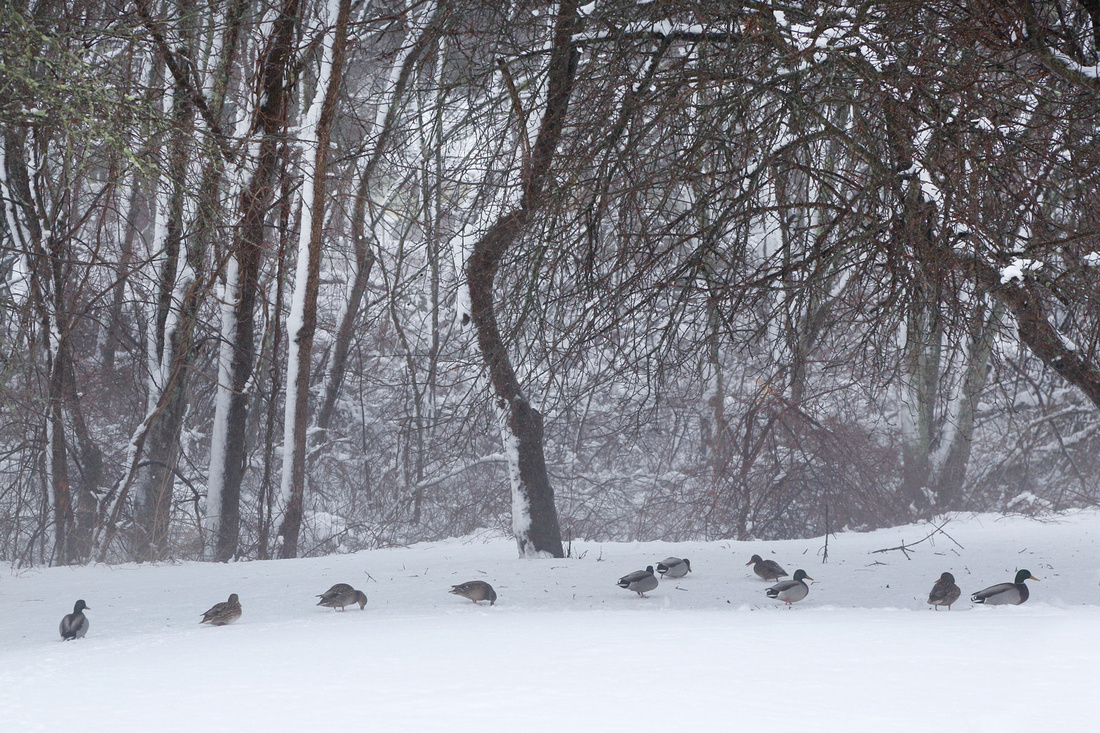
1 new sighting. Total 115 including 4 from Rhode Island.
]]>I thought I might be in luck with the dramatic storm and high winds forecasted last week. Maybe some good birds might be blown in just in time for the end of the month. The wind lived up to its hype, and with the power out I couldn't work on my computer, so I headed out to the coast to see if any seabirds had been deposited there. I made several stops from Niantic to Stonington, leaving the camera behind as the gale whipped up a steady stream of salt spray, Kryptonite for photo gear. With few birds close to shore, I found myself staring through my binoculars trying to pick out distant specks that appeared on the rolling waves and then disappeared just as quickly, never to be seen again. I don't own a scope (and I don't imagine one would be much use in such buffeting winds) so my viewing range was limited, and the waves made identifying birds on the water nearly impossible. After scanning the Sound from Harkness State Park in Waterford for more than a half hour I finally saw a few birds take flight from near the mouth of the Thames River that I could identify as alcids by their shape. Most flew straight out into the sound and remained unidentified, but one flew west around the point. Even at quite a distance, I was able to identify it as a Razorbill by its head and wing shape. These flight pictures I took a few years ago show the distinctive shape (although much closer than my actual view).
 Razorbills have been fairly abundant this year, and I had already seen several at close range. Later the same day, though, a birder reported 16 Common Murres, which I have never seen in the state, from the same spot at Harkness Park. Although Razorbill sightings in Connecticut seem to be on the rise in recent years, they were not always so common. One of my earliest birding memories from the early 1990's happened at Meig's Point in Hammonasset Beach State Park. While scanning Long Island Sound from the hilltop lookout after an autumn storm, I got a distant view of what I thought could be a Razorbill. It flew off to the west just before another man with binoculars joined me. He asked what I'd seen so I told him about my possible Razorbill, and he back down the hill, jumped in his car and sped off through the park to the west. We met up a while later in the park and he said he was able to relocate the bird and that it was a Razorbill. The man turned out to be Noble Proctor. After we reported the sighting to the bird hotline (back then there were no websites to report sightings) there was some controversy. As a novice, my recollection is that I faced an intimidating barrage of questions from experienced birders (maybe the rare records committee) about the head shape, color pattern and so on. I guess my answers were not satisfactory and I'm not sure the report was ever accepted. Twenty years later, experience has taught me to use all these different field marks, shape, patterns, behavior etc. to make an identification with much more certainty. The funny thing is there are still situations when I feel like a novice, not confident to make a positive ID. I'm pretty conservative about calling something I'm not sure of.
Razorbills have been fairly abundant this year, and I had already seen several at close range. Later the same day, though, a birder reported 16 Common Murres, which I have never seen in the state, from the same spot at Harkness Park. Although Razorbill sightings in Connecticut seem to be on the rise in recent years, they were not always so common. One of my earliest birding memories from the early 1990's happened at Meig's Point in Hammonasset Beach State Park. While scanning Long Island Sound from the hilltop lookout after an autumn storm, I got a distant view of what I thought could be a Razorbill. It flew off to the west just before another man with binoculars joined me. He asked what I'd seen so I told him about my possible Razorbill, and he back down the hill, jumped in his car and sped off through the park to the west. We met up a while later in the park and he said he was able to relocate the bird and that it was a Razorbill. The man turned out to be Noble Proctor. After we reported the sighting to the bird hotline (back then there were no websites to report sightings) there was some controversy. As a novice, my recollection is that I faced an intimidating barrage of questions from experienced birders (maybe the rare records committee) about the head shape, color pattern and so on. I guess my answers were not satisfactory and I'm not sure the report was ever accepted. Twenty years later, experience has taught me to use all these different field marks, shape, patterns, behavior etc. to make an identification with much more certainty. The funny thing is there are still situations when I feel like a novice, not confident to make a positive ID. I'm pretty conservative about calling something I'm not sure of.
Anyway, moving on to Stonington Point, the wind-whipped wave slammed into the sea wall creating a curtain of salt spray. I couldn't get out of my car without getting soaked, so I could only scan to the east through the car window (the west facing windows were covered with spray). Other than a few common birds, not much was seen. Returning home, power had been restored so it was back to the computer. My only late pickup was a Great Horned Owl at dusk, so I finished the month with a respectable 110 birds. The Big January rankings (I didn't send mine in) were compiled and the top birder reported 144 birds. Wow! My list would have finished in the top ten, although I'm sure there are many avid birders who don't keep a list or didn't report their sightings either.
After the storm, and the "Big January" commotion, February started quietly, with no new sightings, so far. I continue to have plenty of opportunities to photograph waterfowl, like loons, mergansers and even a tiny Pied-billed Grebe, below.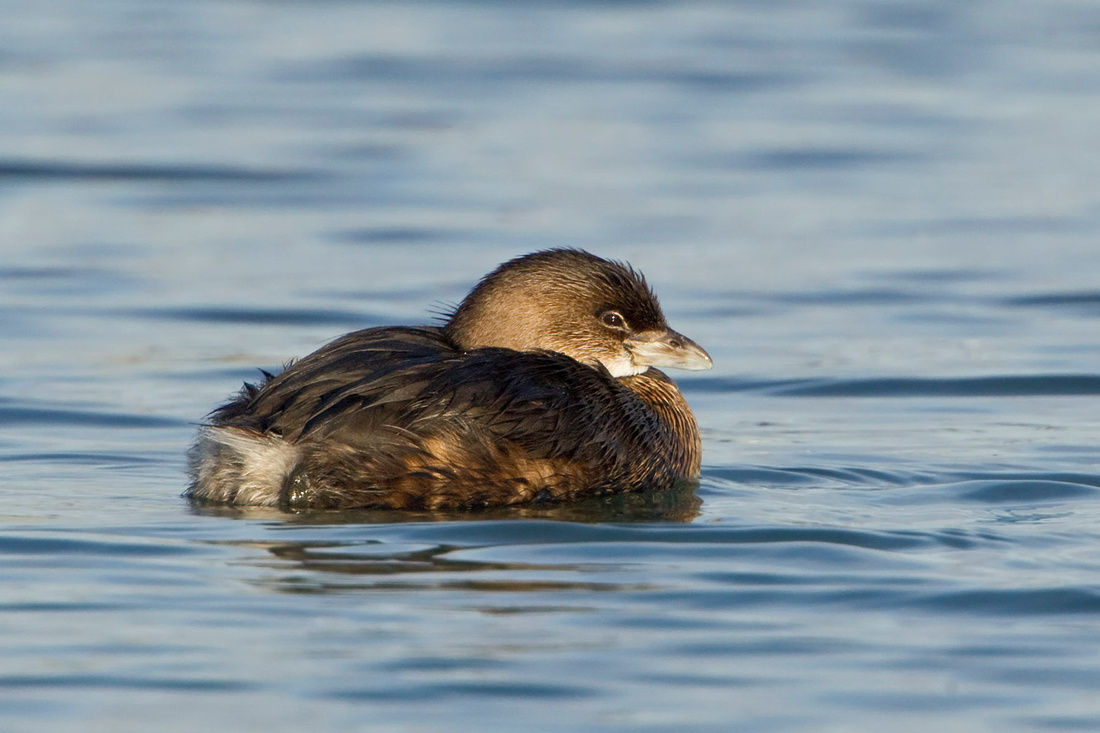 Though the waterfowl are plentiful, I'm getting antsy to photograph some more exciting subjects. Barred Owls continue to be easily spotted, although I have not really worked to get good pictures, not wanting to push them as they continue to appear stressed. Raptors seem a bit scarce along the shoreline this winter, but I did spot a Merlin perched on a snag near Great Island in Old Lyme over the weekend. The bird was silhouetted against the cloudy sky, but seeing some breaks in the clouds, I waited, hoping for the sun to break through. Luckily, the Merlin stayed put, and my patience was rewarded as a little weak sunlight broke through briefly and illuminated the bird. I also saw a female Northern Harrier hunting in the same area of salt marsh at Hammonasset and got several chances at it, although the direction of the wind in relation to my vantage point gave me mostly a tail view.
Though the waterfowl are plentiful, I'm getting antsy to photograph some more exciting subjects. Barred Owls continue to be easily spotted, although I have not really worked to get good pictures, not wanting to push them as they continue to appear stressed. Raptors seem a bit scarce along the shoreline this winter, but I did spot a Merlin perched on a snag near Great Island in Old Lyme over the weekend. The bird was silhouetted against the cloudy sky, but seeing some breaks in the clouds, I waited, hoping for the sun to break through. Luckily, the Merlin stayed put, and my patience was rewarded as a little weak sunlight broke through briefly and illuminated the bird. I also saw a female Northern Harrier hunting in the same area of salt marsh at Hammonasset and got several chances at it, although the direction of the wind in relation to my vantage point gave me mostly a tail view. 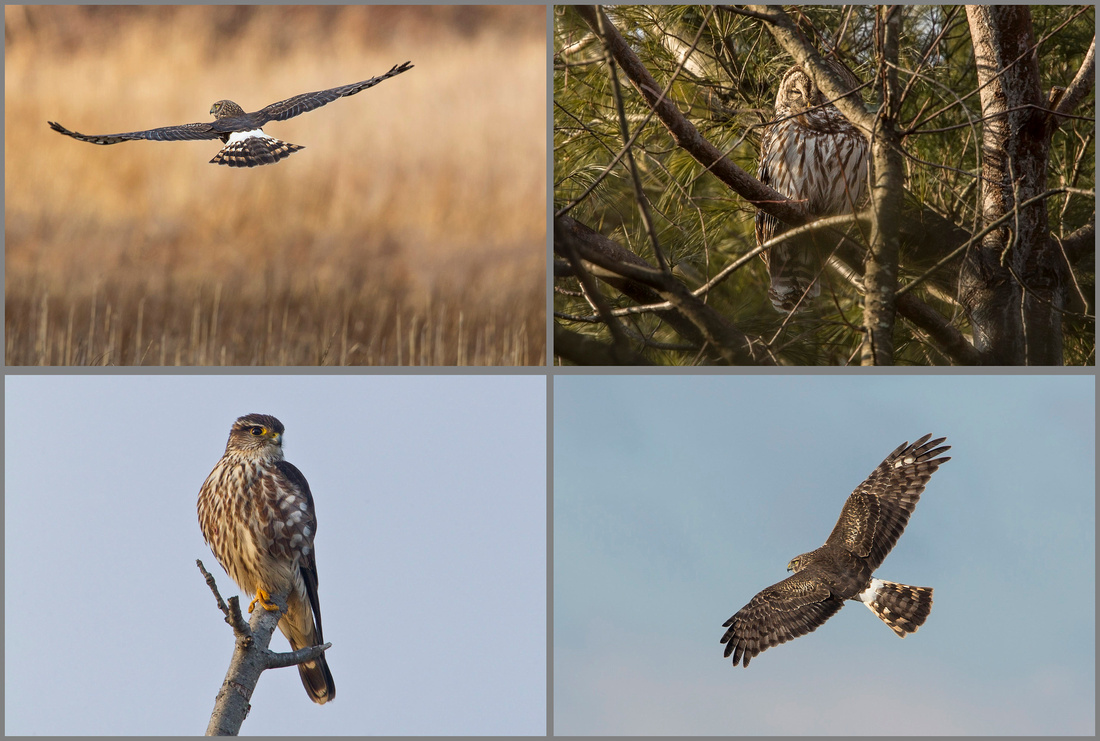
I've been seeing some spectacular shots of Great Grey Owls taken recently by photographers in Ottawa and Montreal, and was considering a trip north to join the fun. This week a Great Gray was found in New Hampshire and there was another possible report from Naugatuck, which so far has not panned out. As the sightings get closer, who knows, maybe seeing a Great Gray Owl in Connecticut won't be a once in a lifetime event as I predicted. It would certainly spice up the winter doldrums.
I continue to check Great Island frequently in the late afternoon to look for Short-eared Owls, which hunt at dawn and dusk, so far without luck. While there, I often see people gathered at the boat launch to watch the sunset from their cars. With the clouds breaking up at just the right time Sunday evening, I shot this tranquil view of the sun setting over the Connecticut River, South Cove and the empty Old Saybrook causeway. It's never seems to be empty when I'm driving on it and see something out on the cove that I want to stop and take a quick picture of from my car. Maybe everyone was at home, waiting for the Super Bowl to start.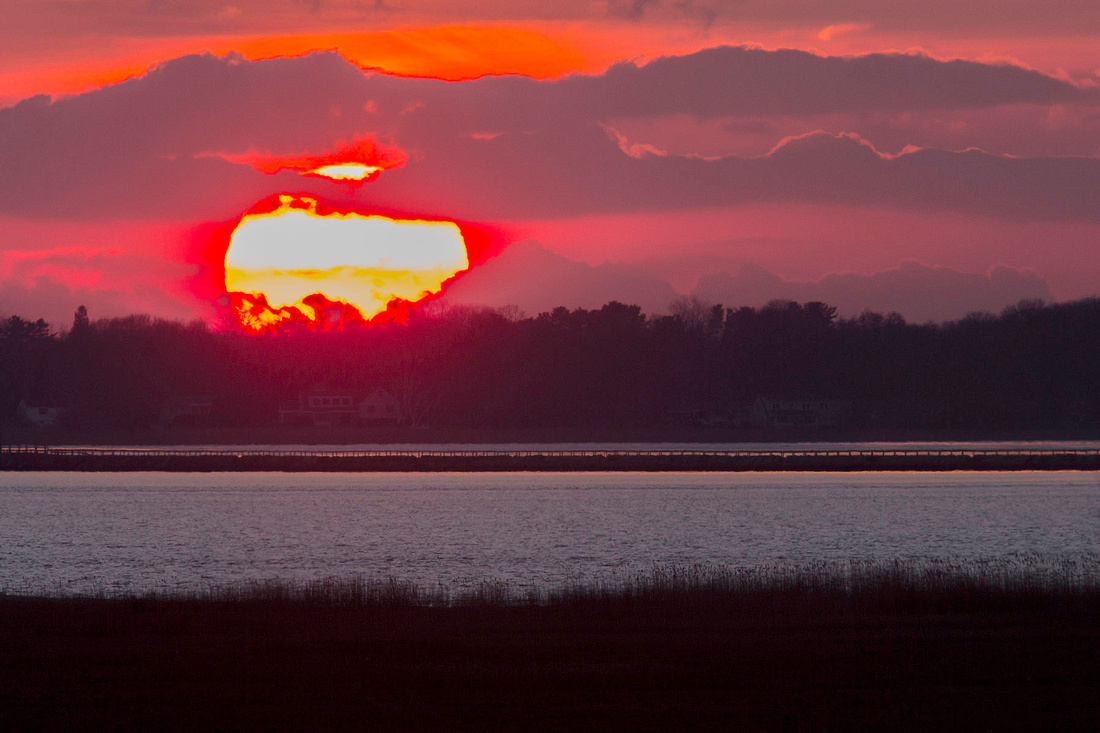
]]>
To be sure, there are birders who see more than 300 species in the state most years. It has become fairly routine, although I'm sure they would tell you it requires great effort, birding skills and experience. To do it, you have to see almost all the expected birds and many of the rare ones. As I mentioned in my earlier posts, I have not "chased" many of the rarities seen in the state in deference to my photographic pursuits. It's also true that I rarely find uncommon birds, especially considering the amount of time I'm out photographing. This, too, is based on my preference to look for the closer subjects, that I can study and try to photograph rather than looking for the field markings that distinguish a rarity.
To reach my goal, I know I'll have to keep a keener eye out for uncommon birds. I'm trying to study birds, even the seemingly common or very distant ones, to pick out a rarity. This year, I've been checking sparrows and gulls much more closely and straining to turn a distant speck on Long Island Sound into a Pacific Loon or an alcid, so far without success. I know I'll need to "chase" more birds, and I did make trips to see Pine Grosbeaks and White Ibis, but without success. So far I have elected not to make the long drive to see the Bullock's Oriole and Hoary Redpolls that are visiting bird feeders at private residences. A recently reported Northern Shrike, one of my nemesis birds, is one I should chase but old habits die hard, and after a couple disappointments, it's easy to fall back into the comfortable routine of checking my local patch.
To summarize the results this month, most of the sightings are fairly common birds that you would expect to see every year. Even the ones that are not common in January would likely be seen later in the year. I've had a few good finds, like a Long-eared Owl and Razorbill, that I don't see every year. Winter finches like crossbills and redpolls are not every year occurrences either and seeing Black-headed Gull and Lesser Black-backed Gull so close to home is a nice bonus. New sightings are likely to slow dramatically for the next couple months, until the spring migration brings a new wave of birds to the state. But missing out on the real rarities like Hoary Redpoll, Bullock's Oriole, Pine Grosbeak and White Ibis will likely hurt my chances of reaching 300.
Here is a photo recap from the past month or so.

JANUARY SIGHTINGS - In order of appearance and town where first seen.
| 1. American Goldfinch - Niantic | 61. Red-throated Loon - Niantic |
| 2. European Starling - Niantic | 62. Red-winged Blackbird - Lyme |
| 3. Herring Gull - Niantic | 63. Hairy Woodpecker - Lyme |
| 4. Ring-billed Gull - Niantic | 64. Double-crested Cormorant - Old Lyme |
| 5. Red-breasted Merganser - Niantic | 65. Iceland Gull - Madison |
| 6. Horned Grebe - Niantic | 66. Northern Mockingbird - Madison |
| 7. Common Goldeneye - Niantic | 67. Merlin - Madison |
| 8. Common Loon - Niantic | 68. Common Eider - Stonington |
| 9. Common Raven - Niantic | 69. Surf Scoter - Stonington |
| 10. Canada Goose - Niantic | 70. Long-tailed Duck - Stonington |
| 11. Hooded Merganser - Niantic | 71. Great Egret - Stonington |
| 12. Mute Swan - Niantic | 72. Long-eared Owl - Stonington |
| 13. Greater Black-backed Gull - Niantic | 73. Common Grackle - Waterford |
| 14. Bufflehead - Niantic | 74. Pied-billed Grebe - Waterford |
| 15. American Black Duck - Niantic | 75. Lesser Black-backed Gull - Waterford |
| 16. Mallard - Niantic | 76. Hermit Thrush - Lyme |
| 17. Great Blue Heron - Niantic | 77. Black-headed Gull - Stonington |
| 18. Blue Jay - Niantic | 78. Red-necked Grebe - Stonington |
| 19. American Crow - Niantic | 79. White-winged Crossbill - Stonington |
| 20. American Tree Sparrow - Old Lyme | 80. Eastern Screech Owl - Niantic |
| 21. House Sparrow - Old Lyme | 81. Green-winged Teal - Old Lyme |
| 22. Song Sparrow - Old Lyme | 82. Swamp Sparrow - Durham |
| 23. Northern Cardinal - Old Lyme | 83. American Coot - Wallingford |
| 24. Bald Eagle - Old Lyme | 84. Canvasback - Wallingford |
| 25. Sharp-shinned Hawk - Lyme | 85. Red Crossbill - Madison |
| 26. Northern Flicker - Lyme | 86. Wood Duck - Lyme |
| 27. White-throated Sparrow - Lyme | 87. Pileated Woodpecker - Old Saybrook |
| 28. Tufted Titmouse - Lyme | 88. Golden-crowned Kinglet - Old Saybrook |
| 29. Black-capped Chickadee - Lyme |
89. Rough-legged Hawk - Essex |
| 30. Great Cormorant - Lyme | 90. Barred Owl - Old Lyme |
| 31. Common Merganser - Lyme | 91. American Wigeon - Stratford |
| 32. Turkey Vulture - Lyme | 92. Gadwall - Stratford |
| 33. American Robin - Lyme | 93. Northern Gannet - Stratford |
| 34. Dark-eyed Junco - Lyme | 94. Greater Scaup - New Haven |
| 35. House Finch - Lyme | 95. Lesser Scaup - New Haven |
| 36. Downy Woodpecker - Lyme | 96. No. Rough-winged Swallow - New Haven |
| 37. Rusty Blackbird - Lyme | 97. Black Vulture - Branford |
| 38. Red-shouldered Hawk - Lyme | 98. Northern Pintail - Old Lyme |
| 39. Brown-headed Cowbird - Lyme | 99. Field Sparrow - Stonington |
| 40. Rock Dove - Old Lyme | 100. Fox Sparrow - Stonington |
| 41. Peregrine Falcon - Old Saybrook | 101. White-winged Scoter - Stonington |
| 42. Mourning Dove - Madison | 102. Bonapartes Gull - Stonington |
| 43. Snow Goose - Madison | 103. Brown Creeper - Niantic |
| 44. Red-breasted Nuthatch - Madison | 104. Wilson's Snipe - Lyme |
| 45. Sanderling - Madison | 105. Cooper's Hawk - Old Lyme |
| 46. Dunlin - Madison | 106. Yellow-bellied Sapsucker - Lyme |
| 47. Snow Bunting - Madison | 107. Wild Turkey - Old Lyme |
| 48. Horned Lark - Madison | 108. Eastern Towhee - Lyme |
| 49. Ring-necked Duck - Niantic | 109. Purple Sandpiper - Waterford |
| 50. Ruddy Duck - Niantic | 110. Great Horned Owl- Old Saybrook |
| 51. Carolina Wren - Niantic | |
| 52. White-breasted Nuthatch - Niantic | |
| 53. Northern Harrier - Old Lyme | |
| 54. Red-tailed Hawk - Lyme | |
| 55. Red-bellied Woodpecker - Lyme | |
| 56. Eastern Bluebird - Lyme | Rhode Island - additional |
| 57. Razorbill - Niantic | 111. Purple Finch - South Kingstown |
| 58. Brant - Niantic | 112. Pine Siskin - Charlestown |
| 59. Common Redpoll - Niantic | 113. Harlequin Duck - Jamestown |
| 60. Belted Kingfisher - Niantic | 114. Killdeer - Charlestown |
]]>
So after an extended warm spell, winter returned last week, with a vengeance. Although I enjoy the cold weather, spending a long time outside in the bitter winds makes you really appreciate just how hearty the creatures that survive winter here are. The frigid temperatures iced up many of the rivers, lakes and ponds concentrating many ducks into smaller areas of open water. At South Cove in Old Saybrook, Ruddy Ducks, Buffleheads and Common Mergansers dove in the small patches of open water near the bridges on the causeway.
 A tiny patch of water in a stream by a culvert in Lyme remained unfrozen through the cold spell, and a male Wood Duck clung to the spot, reminding me of Shingebiss, surviving the North Wind. At least one and maybe more Wilson's Snipe also huddled near the open water for several days as well a Great Blue Heron. In the nearby undergrowth a female Eastern Towhee skulked.
A tiny patch of water in a stream by a culvert in Lyme remained unfrozen through the cold spell, and a male Wood Duck clung to the spot, reminding me of Shingebiss, surviving the North Wind. At least one and maybe more Wilson's Snipe also huddled near the open water for several days as well a Great Blue Heron. In the nearby undergrowth a female Eastern Towhee skulked.
As the Ice built on the Connecticut River, the Bald Eagle activity picked up dramatically as well. In the Essex - Lyme area I saw 7 or 8 juveniles and 4 adults all at one time. There, too, the eagles were gathered near the flocks of Great Cormorants and Common Mergansers concentrated in the channels of open water. The eagles spent a lot of time hovering as the waterfowl dove for fish, dropping down as they surfaced with a catch, hoping to pick up a free meal. Most of that activity occurs out in the middle of the river, too far away for good pictures, especially in extreme cold. The relatively warm water clashes with the cold air, creating a heat shimmer which makes it tough to get sharp pictures. That shimmer is amplified when shooting at long distances.

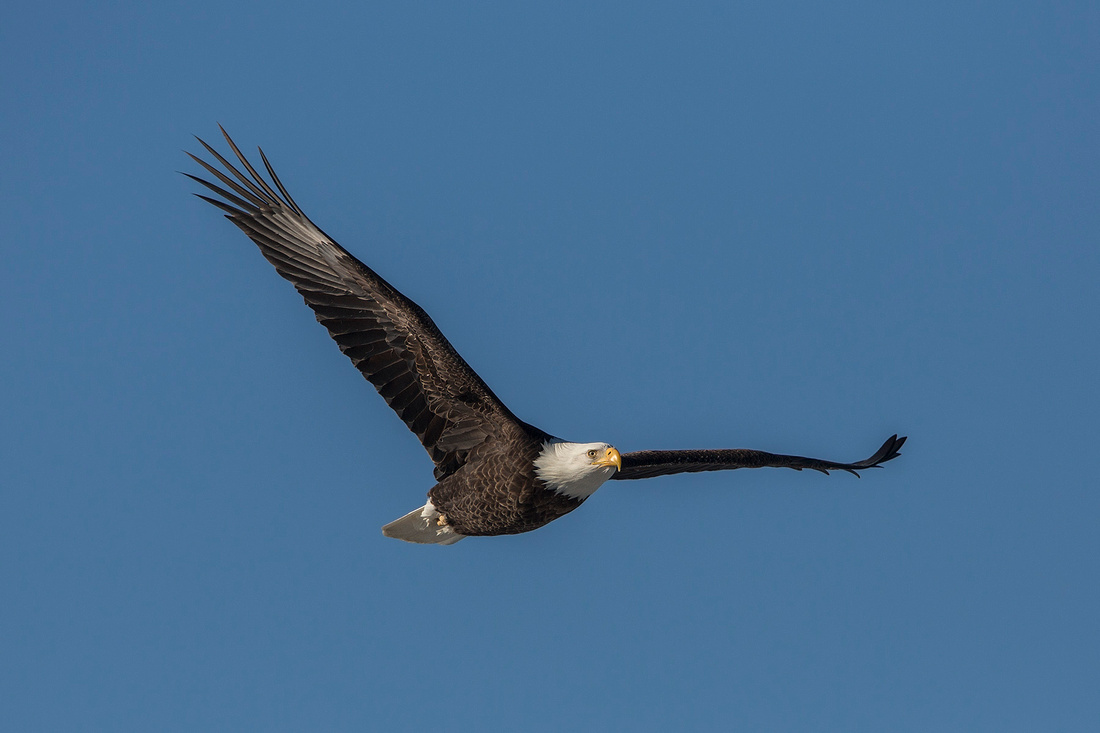
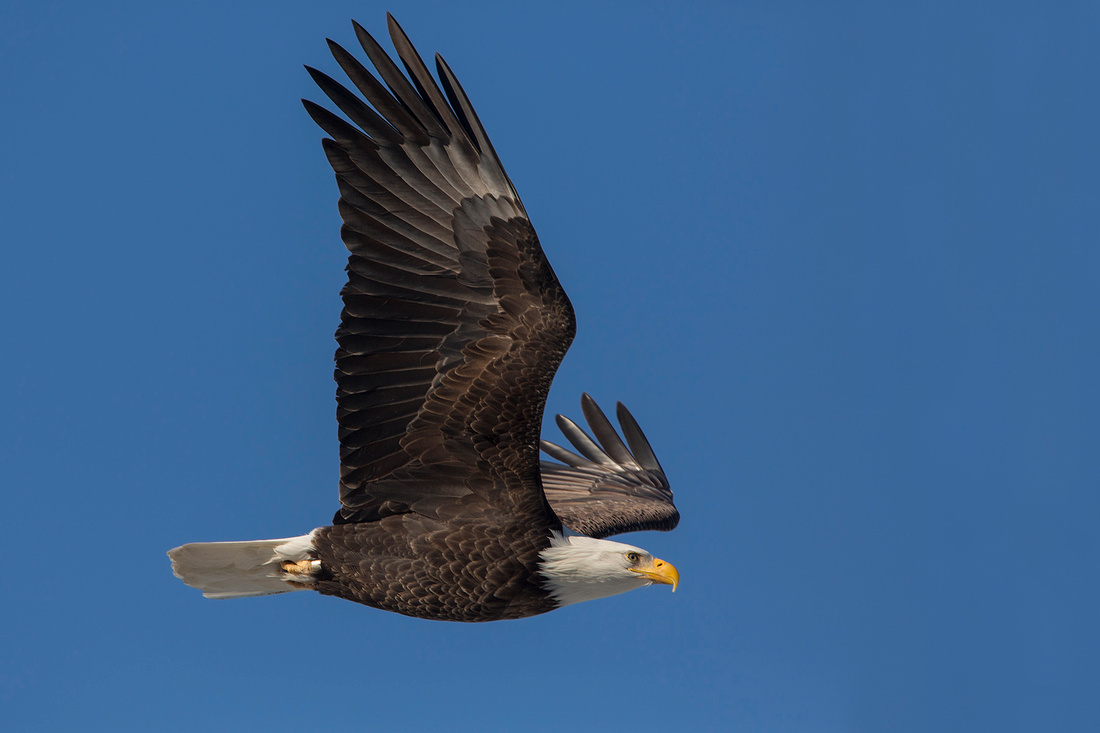 juvenile, (top) and adults.
juvenile, (top) and adults.
Along the Black Hall River in Old Lyme I saw a pair of eagles attempting to mate, so there may be a nest in the area. Also in that area I saw another Barred Owl out during the daylight, the third different owl in two weeks. I have also been checking Great Island occasionally around sunset, looking for Short-eared Owls but have not seen much of anything, only a single Northern Harrier. As I was leaving there this weekend, I was treated to the Full Wolf Moon rising as well as my first Wild Turkeys this year.
 Although sea ducks don't face he same problem finding open water, I've seen many loons and mergansers very close to shore lately in Niantic and Waterford.
Although sea ducks don't face he same problem finding open water, I've seen many loons and mergansers very close to shore lately in Niantic and Waterford.  Red-breasted Merganser
Red-breasted Merganser
 Hooded Merganser
Hooded Merganser
 Common Loon with crab.
Common Loon with crab.
I finally saw a Purple Sandpiper, actually three, on a distant rock at Harkness State Park in Waterford. These have proven much more diifficult to find this winter than usual. Also at Harkness were five female Common Eider, and many Brant.
 Finally, the return of the cold weather has brought the birds back to my feeders. After not having to fill them for days during the warm stretch, there are a lot more customers lately. I still don't have redpolls, other than the single Common Redpoll from three weeks ago, but many of the usual suspects, lots of goldfinch, a continuing (1 or 2) Carolina Wren and an occasional Red-breasted Nuthatch. Recently, a pair of noisy Northern Flickers have taken a liking to my suet feeder.
Finally, the return of the cold weather has brought the birds back to my feeders. After not having to fill them for days during the warm stretch, there are a lot more customers lately. I still don't have redpolls, other than the single Common Redpoll from three weeks ago, but many of the usual suspects, lots of goldfinch, a continuing (1 or 2) Carolina Wren and an occasional Red-breasted Nuthatch. Recently, a pair of noisy Northern Flickers have taken a liking to my suet feeder.
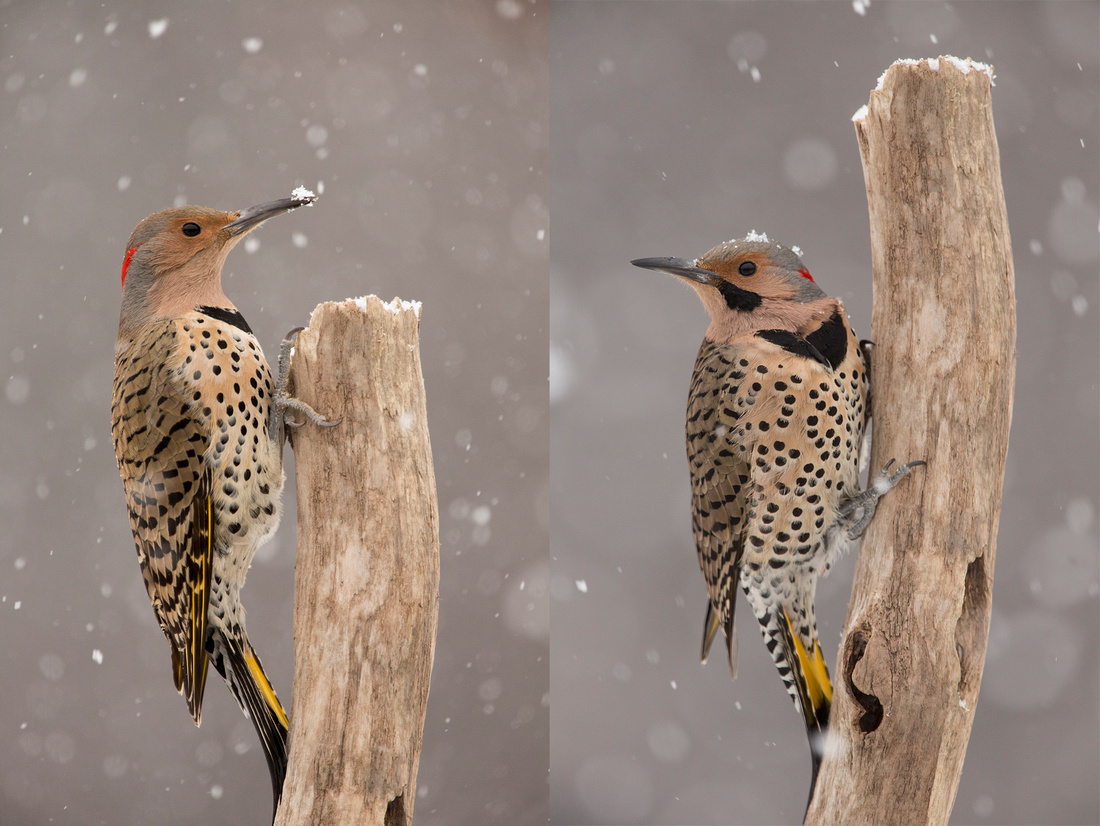
female (left) and male, with black check patch (malar)
New birds this week, Wilson's Snipe, Coopers Hawk, Yellow-bellied Sapsucker, Wild Turkey, Eastern Towhee, Purple Sandpiper and Killdeer (Rhode Island). Total 113 species including 4 from Rhode Island.
]]>
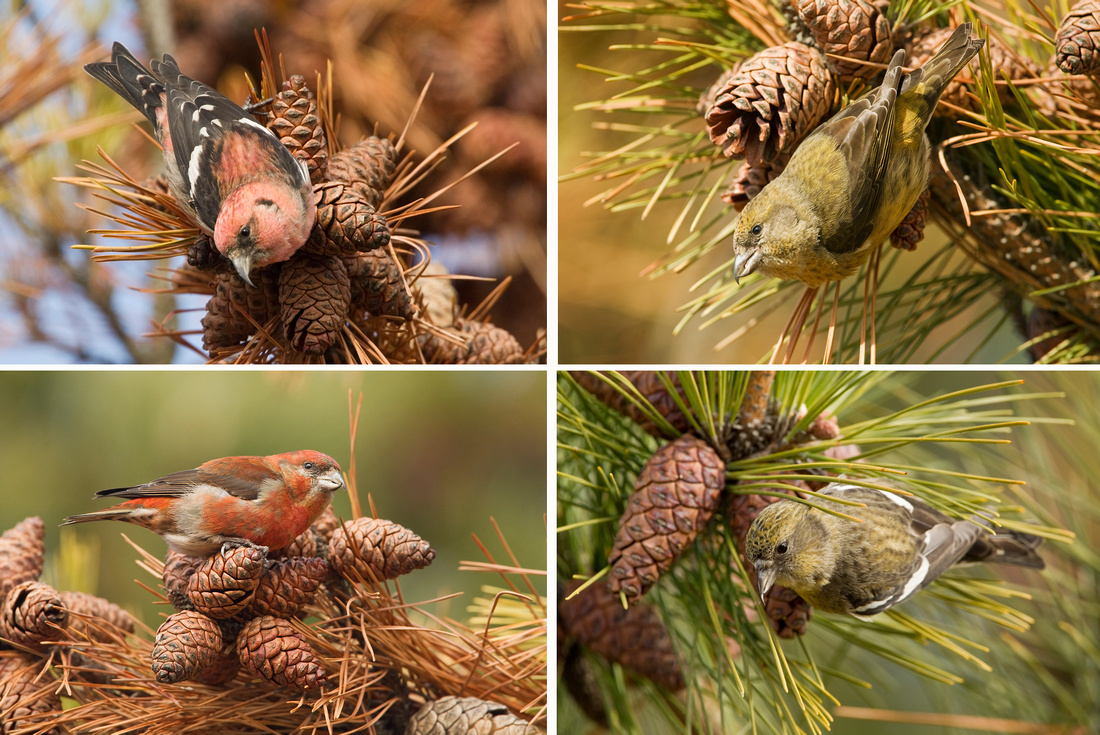
Clockwise from top left, male WW Crossbill, female Red Crossbill, female WW Crossbill and male Red Crossbill.
Also feeding in the pines was a noisy group of Black-capped Chickadees and Red-breasted Nuthatches.
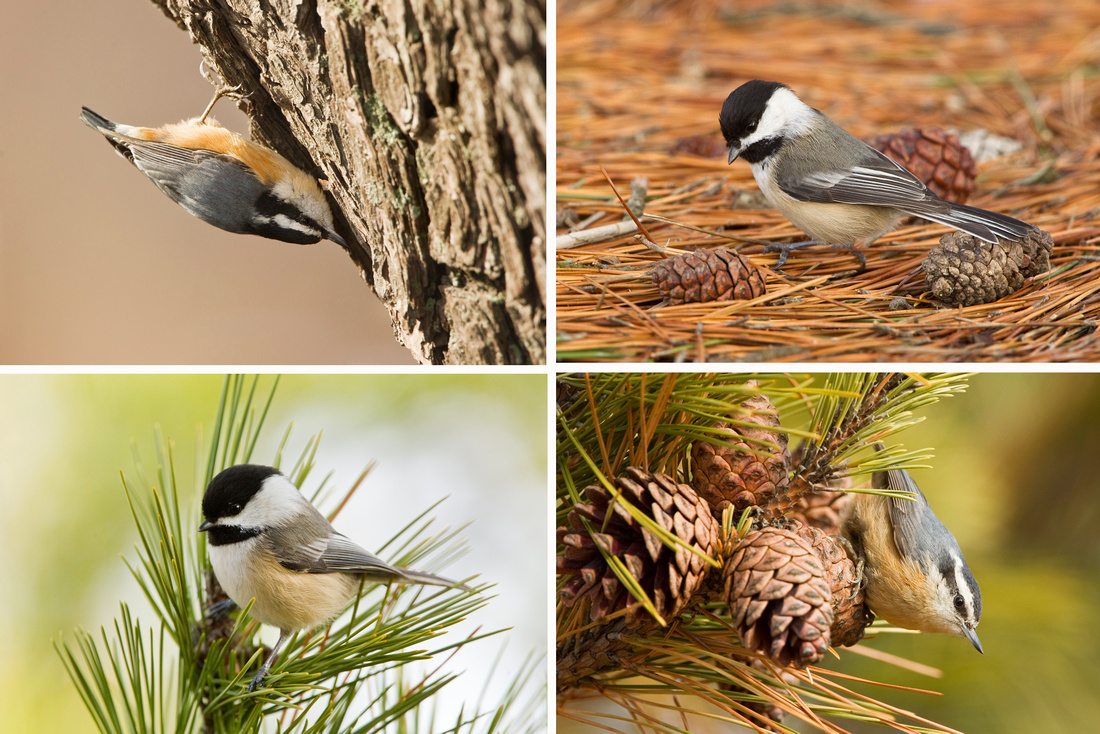 Crossbills are usually very approachable and will sometimes fly down to drink from a puddle right at the feet of the people watching them. Last fall I saw one land on the head of a photographer (John Schwarz) who was standing a few feet away from me. This time was no exception as the crossbills fed conspicuously on the outer cones. The nuthatches flitted chattily from cone to cone, prying out seeds then flying off to stash their prize in the rough tree bark. Chickadees, also very tame, were everywhere around me, landing a few feet away with no fear, loudly announcing their presence. For a photographer, that fly-on-the-wall feeling is a rare one. I wish it was always that easy to capture birds and animals (and people for that matter) behaving naturally as if I were not even there.
Crossbills are usually very approachable and will sometimes fly down to drink from a puddle right at the feet of the people watching them. Last fall I saw one land on the head of a photographer (John Schwarz) who was standing a few feet away from me. This time was no exception as the crossbills fed conspicuously on the outer cones. The nuthatches flitted chattily from cone to cone, prying out seeds then flying off to stash their prize in the rough tree bark. Chickadees, also very tame, were everywhere around me, landing a few feet away with no fear, loudly announcing their presence. For a photographer, that fly-on-the-wall feeling is a rare one. I wish it was always that easy to capture birds and animals (and people for that matter) behaving naturally as if I were not even there.
I went on another ill-fated wild "goose" chase this weekend, heading to Stratford to try for the White Ibis (very rare in Connecticut) that has been seen there for weeks. I checked all the spots it was reported from several times with no luck. Surely, the strong winds blowing off Long Island Sound kept the birds hunkered down, hindering my quest. I saw a few new ducks though, including American Wigeon and Gadwall and was able to get a few pictures of a Canvasbak and Ruddy Duck at Frash Pond. On the way home I stopped in New Haven at Long Wharf, for Lesser and Greater Scaup and East Shore Park for the Northern Rough-winged Swallows wintering at the adjacent sewage treatment plant.
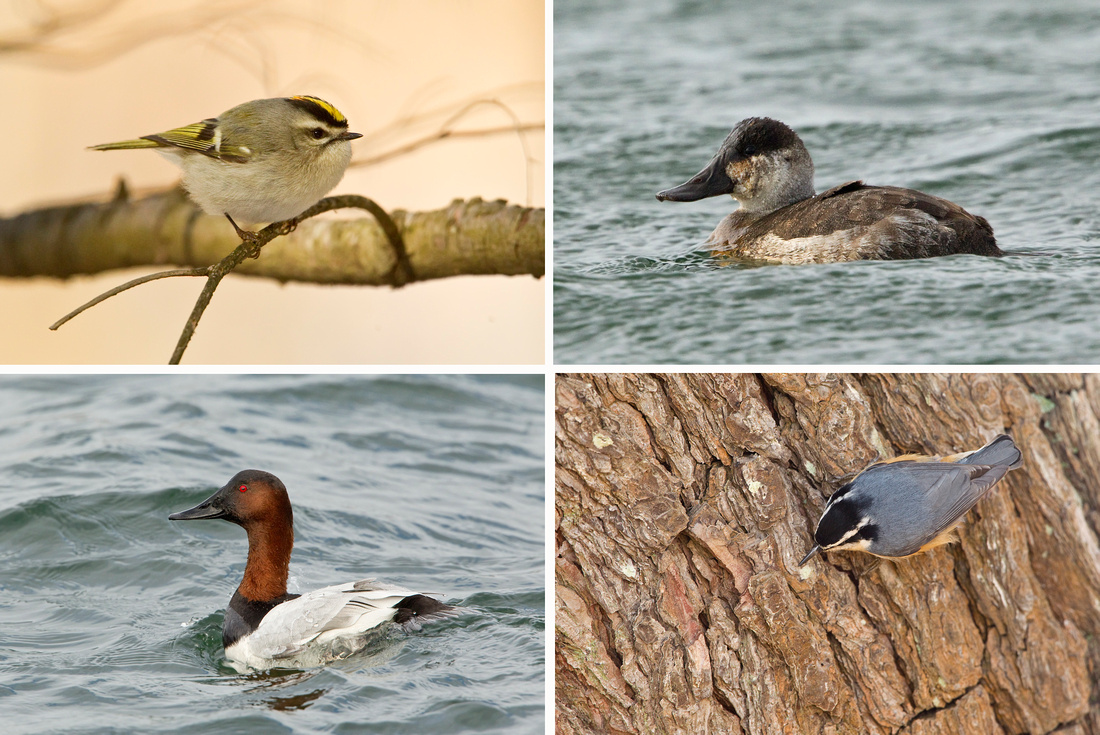 Clockwise from top left - Golden-crowned Kinglet (Old Saybrook), female Ruddy duck (Stratford), Red-breasted Nuthatch (Madison) and male Canvasback (Stratford).
Clockwise from top left - Golden-crowned Kinglet (Old Saybrook), female Ruddy duck (Stratford), Red-breasted Nuthatch (Madison) and male Canvasback (Stratford).
I checked on a skittish flock of Rusty Blackbirds I have been watching for a few weeks in a wooded marsh in Lyme. I spent about 10 minutes waiting for one to pop out into the open as it hopped along on the ice, feeding in the edge of the reeds when I was surprised by a male Wood Duck as it took flight about 20 yards away. No good pictures of the Rusty Blackbirds resulted, but a few distant shots showed that the males were already in breeding plumage while the females were still in their rusty non-breeding attire.
 There has been a lot of discussion this winter on New England birding websites about owls hunting during the day, because a crash in the rodent population has led to a food shortage. Many people have reported Barred Owls out in the open during the day, including in cities like Boston and New Haven, and there were a couple reports from different spots in Connecticut last week of them hunting during the day. While driving through Old Lyme in the afternoon, I saw some deer in a field and stopped to take a few pictures.
There has been a lot of discussion this winter on New England birding websites about owls hunting during the day, because a crash in the rodent population has led to a food shortage. Many people have reported Barred Owls out in the open during the day, including in cities like Boston and New Haven, and there were a couple reports from different spots in Connecticut last week of them hunting during the day. While driving through Old Lyme in the afternoon, I saw some deer in a field and stopped to take a few pictures.
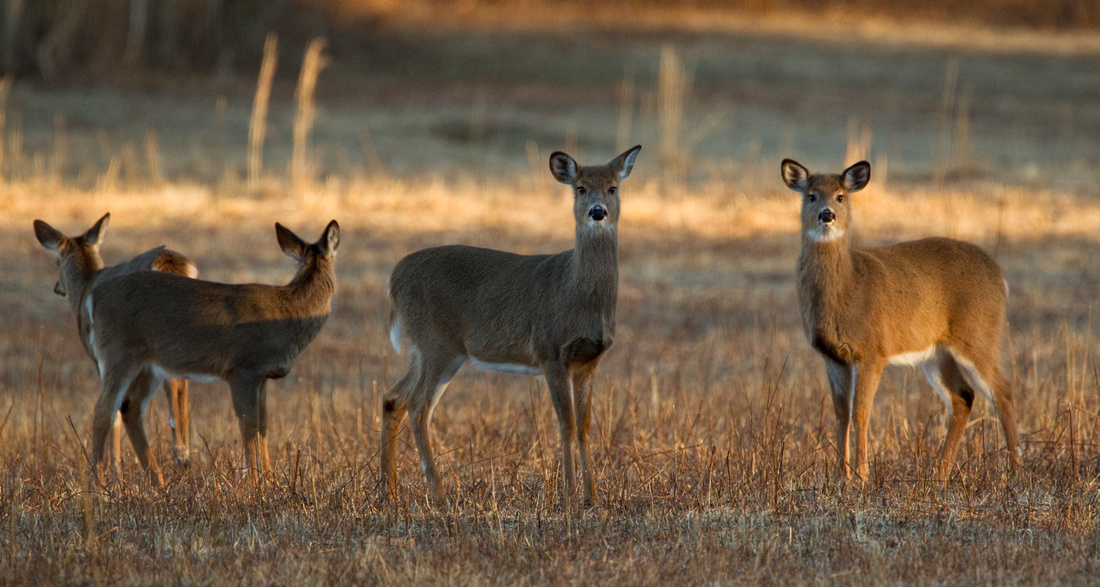 As the deer stared at me I noticed a large bird fly from the shaded edge of the field, directly over them. My first thought was a Red-tailed Hawk, but the wing beats were unmistakably owl like. The bird flew to a tree in the middle of the field, revealing its identity, a Barred Owl.
As the deer stared at me I noticed a large bird fly from the shaded edge of the field, directly over them. My first thought was a Red-tailed Hawk, but the wing beats were unmistakably owl like. The bird flew to a tree in the middle of the field, revealing its identity, a Barred Owl.
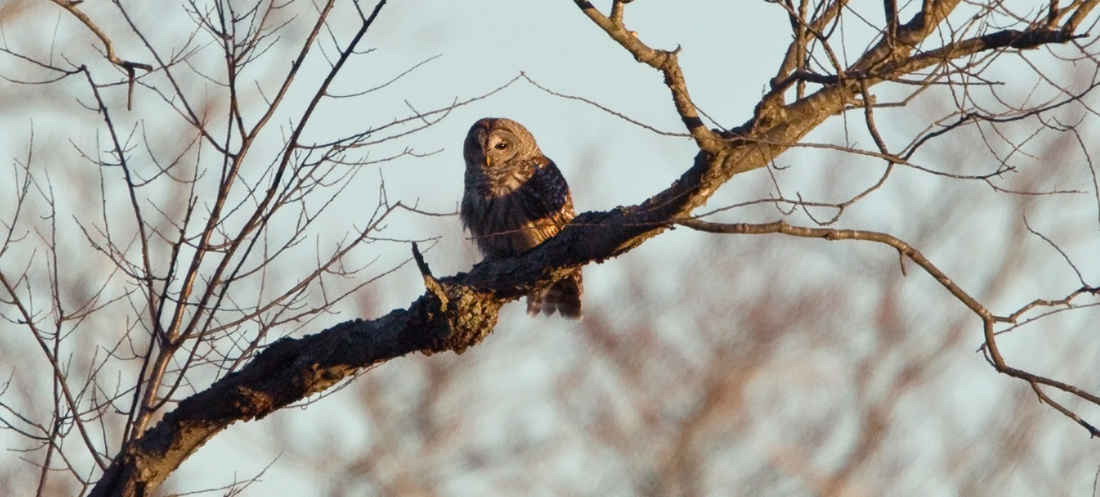 I watched as it scanned the field for several minutes from its lofty perch while the deer wandered off, then flew to a much lower perch on the opposite edge of the field. It peered intently at the ground below, before dropping into the grass. It remained out of sight for more than a minute, then flew up to another low branch about 50 yards away and repeated the process. I'm not sure if the hunts were successful, but it does seem to coincide with the many other reports. Then, over the weekend, a photographer friend and I saw another Barred Owl hunting in midday, this one in Old Saybrook. This seems to confirm that owls are severely stressed this winter.
I watched as it scanned the field for several minutes from its lofty perch while the deer wandered off, then flew to a much lower perch on the opposite edge of the field. It peered intently at the ground below, before dropping into the grass. It remained out of sight for more than a minute, then flew up to another low branch about 50 yards away and repeated the process. I'm not sure if the hunts were successful, but it does seem to coincide with the many other reports. Then, over the weekend, a photographer friend and I saw another Barred Owl hunting in midday, this one in Old Saybrook. This seems to confirm that owls are severely stressed this winter.
Other new sightings this week included Pileated Woodpecker and Golden-crowned Kinglet (Old Saybrook), Rough-legged Hawk (Nott Island - Essex), Northern Gannet, (Stratford), Northern Pintail (Old Lyme and Stonington), Fox Sparrow, Field Sparrow and White-winged Scoter (Stonington) and a first ever sighting of a Brown Creeper in my back yard. Current Total - 106 species including 3 from Rhode Island.
]]>
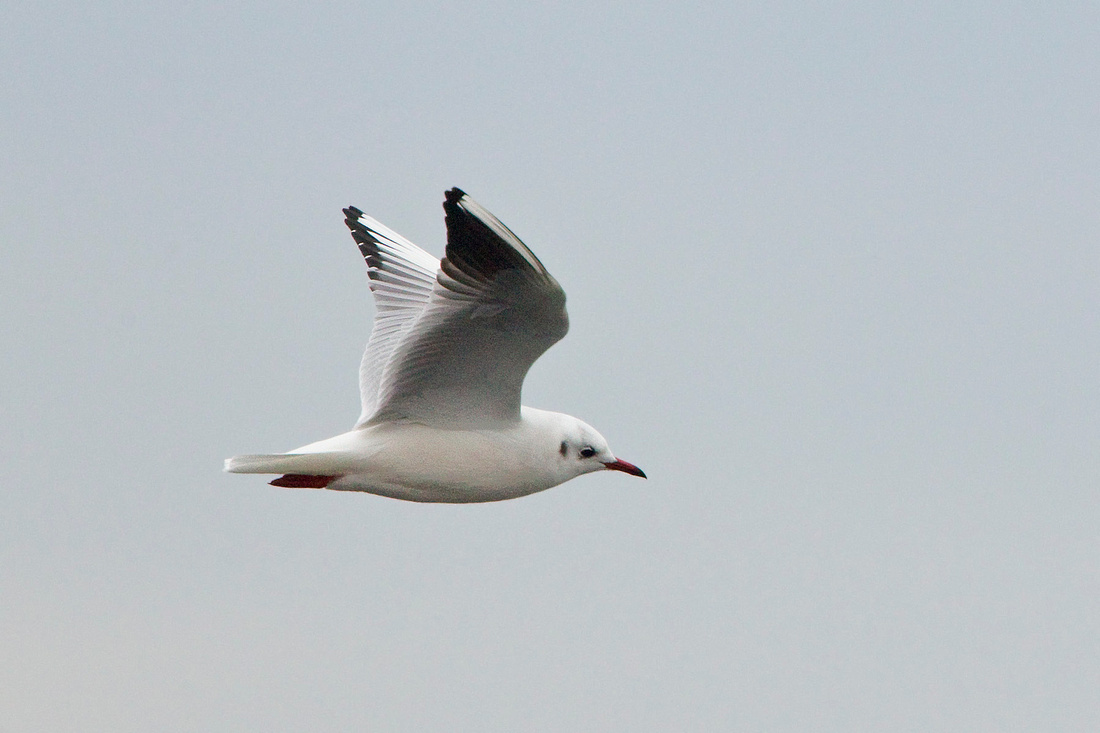 At first flying past ...
At first flying past ...
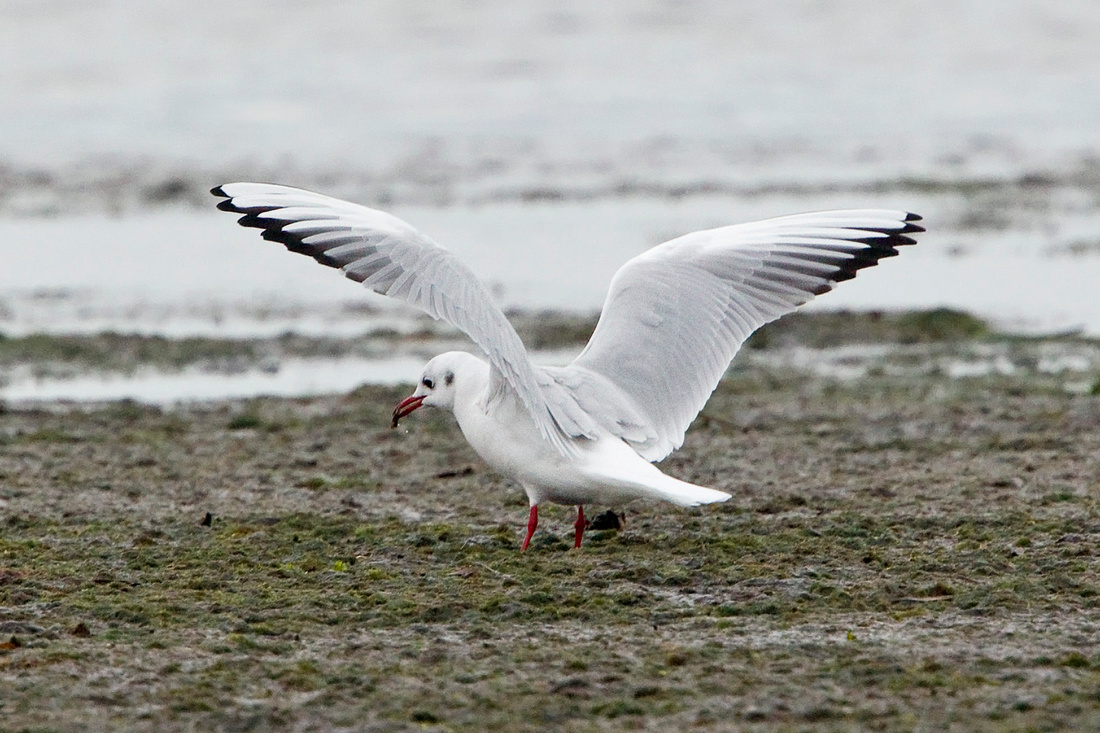 then feeding on the exposed mud flats at low tide ...
then feeding on the exposed mud flats at low tide ...
 then swimming in a shallow pool just a few yards away.
then swimming in a shallow pool just a few yards away.
I waited a long while as the gull moved closer and closer and eventually the usually skittish Red-breasted Mergansers grew less wary, even as I stood in plain sight at the edge of the boat launch. Several small flocks fed close by in the shallow channels as the tide receded, and despite the poor light, I was able to get some fairly nice, close shots including some showing a snorkeling feeding method I often see.

I also took a quick run to Rhode Island, for the first time this winter, and was saddened to see the devastation caused by Hurricane Sandy. Coastal Rhode Island has some of my favorite spots for winter bird photography. The beaches of Westerly and Charlestown were a mess, with many of the dunes washed away. Even more depressing was Trustom Pond, a coastal fresh water pond that attracted large flocks of wintering geese and ducks, including Ruddy Ducks, Scaup and Canvasbacks. The dunes at Moonstone Beach were breached and washed away by the storm and the pond is now a tidal, salt water pond. It was nearly devoid of ducks the day I visited. I did see a Fox Sparrow and female Purple Finch at the feeders near the entrance there. I also had a couple dozen Harlequin Ducks at Beavertail State Park in Jamestown, but not much else.
I finally had an "excuse" to chase the Pine Grosbeaks at the ice rink in Simsbury, more than a week after they were first reported. On Sunday, after taking my daughter to indoor lacrosse in East Windsor, we stopped there on the way home, but were not rewarded. Conditions were tough as thick fog made it hard to see anything more than a few yards away and the screaming hockey parents cheering their kids and berating the refs made it impossible to hear. I managed to weasel a promised quick stop into nearly 45 minutes, but finally had to give up. On the way home, a lunch stop at Scott's Jamaican Bakery in Hartford for coco bites (one of the few things I miss about working in Hartford) eased the disappointment a bit.
Here are a few other pictures from the last week.
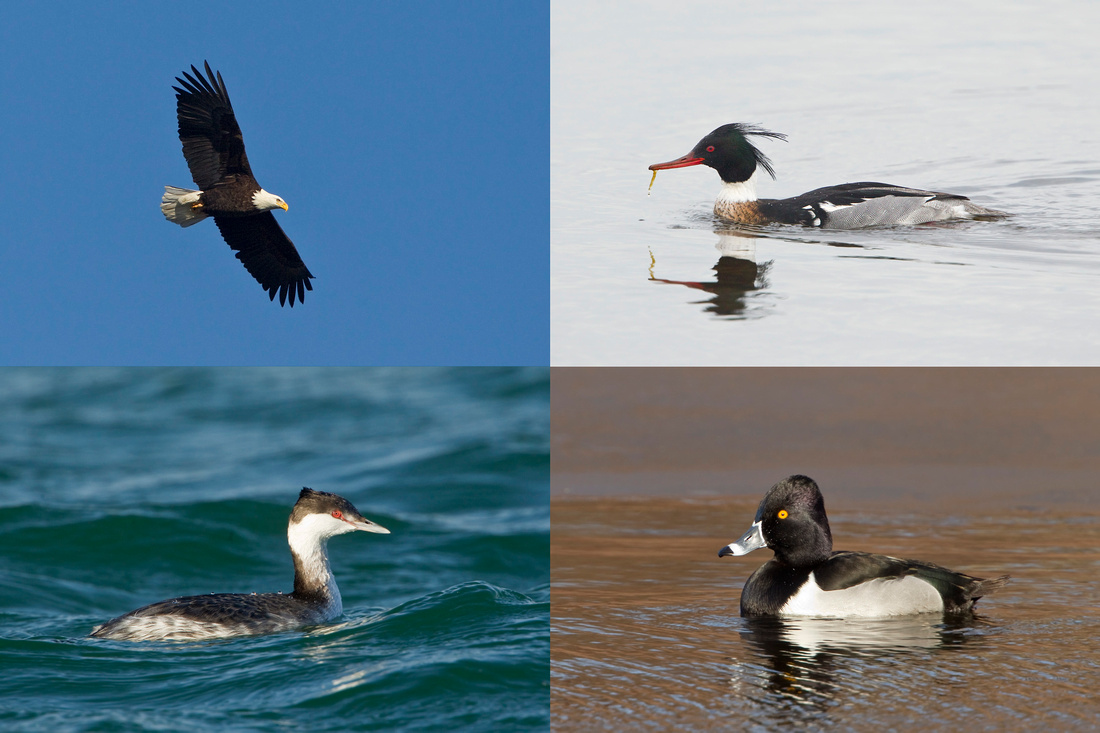 Current total - 88 species (including 4 from RI)
Current total - 88 species (including 4 from RI)
I stopped at Hole-in-the-Wall beach in Niantic on my way home one afternoon, and grabbed my binoculars for a quick check of the bay. As I scanned the flat water, a Razorbill surfaced a few feet from the breakwater, right in front of me. Of course, I left my camera in the car! It dove and resurfaced again close by, so the next dive I raced back to my car to grab my gear. Returning, I checked to see if anything was on the surface, sprinted toward the breakwater and froze, crouched behind the rocks. This technique has drawn some odd looks from beach walkers, but it's a good way to approach diving waterfowl. I try to time the length of the dive, run closer and freeze behind a rock or in a low position before they resurface. I waited for the Razorbill ... nothing. I turned around, to the west and saw that the bird had moved all the way down the beach and out toward McCook's Point. I sat there depressed, watching the Razorbill move farther away with each dive, knowing I had broken a cardinal rule. Always be prepared, if you are looking for something without a camera, without a card in the camera, or in any state of unreadiness, that's when you'll find it.
I turned back around and noticed a Common Loon working its way along the rocky shore towards me. After a few minutes, it surfaced right in front of me, right were the Razorbill had been, and posed calmly for a few pictures. A small consolation.

As the loon moved past, I turned back toward the Razorbill and saw that it was still by the point. Buoyed by the loon, I decided to walk out there and see if I could at least get a few record shots. I reached the bluff, overlooking the spot I last saw the bird, but it had moved out, away from the rocks. I took a few distant backlit shots and scanned the bay with my bins, spotting another Razorbill out by Wigwam Rock. I decided to walk down to McCook's Beach, to the west and see if the closer bird would swim by. After working my way to the rocks at the end of the beach, I saw it surface close to shore, through a notch in the rocks. Another dive and it appeared before me ....
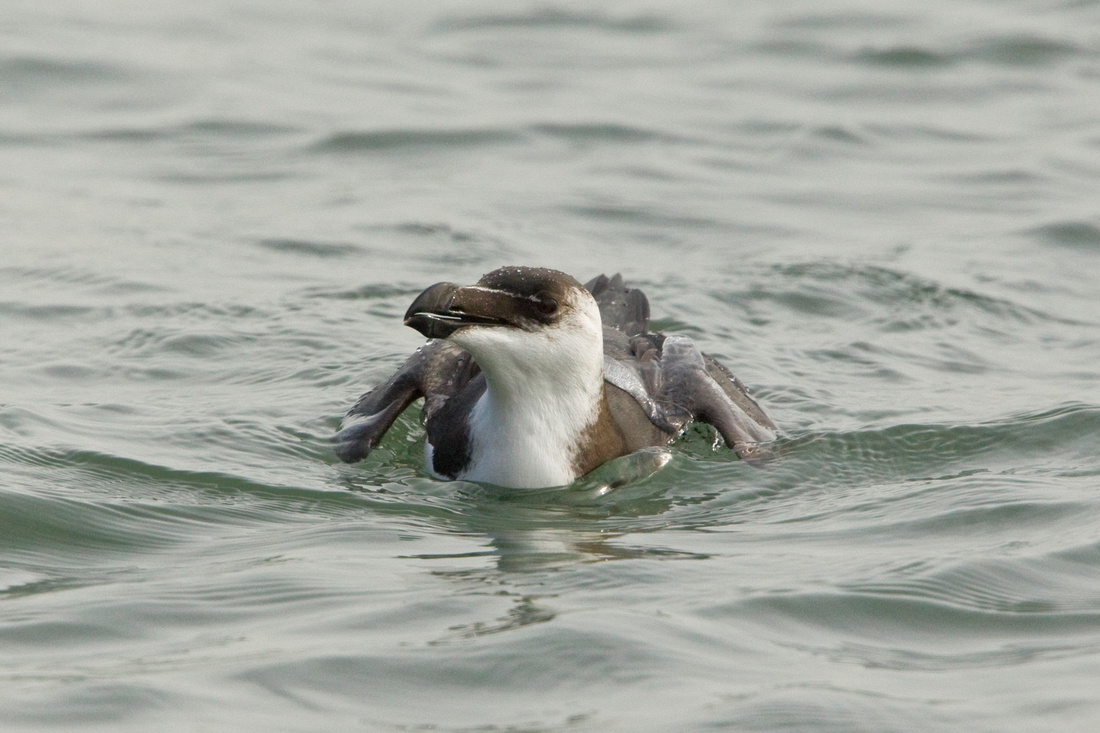 before raising it's wings and taking flight under the water, again,
before raising it's wings and taking flight under the water, again,
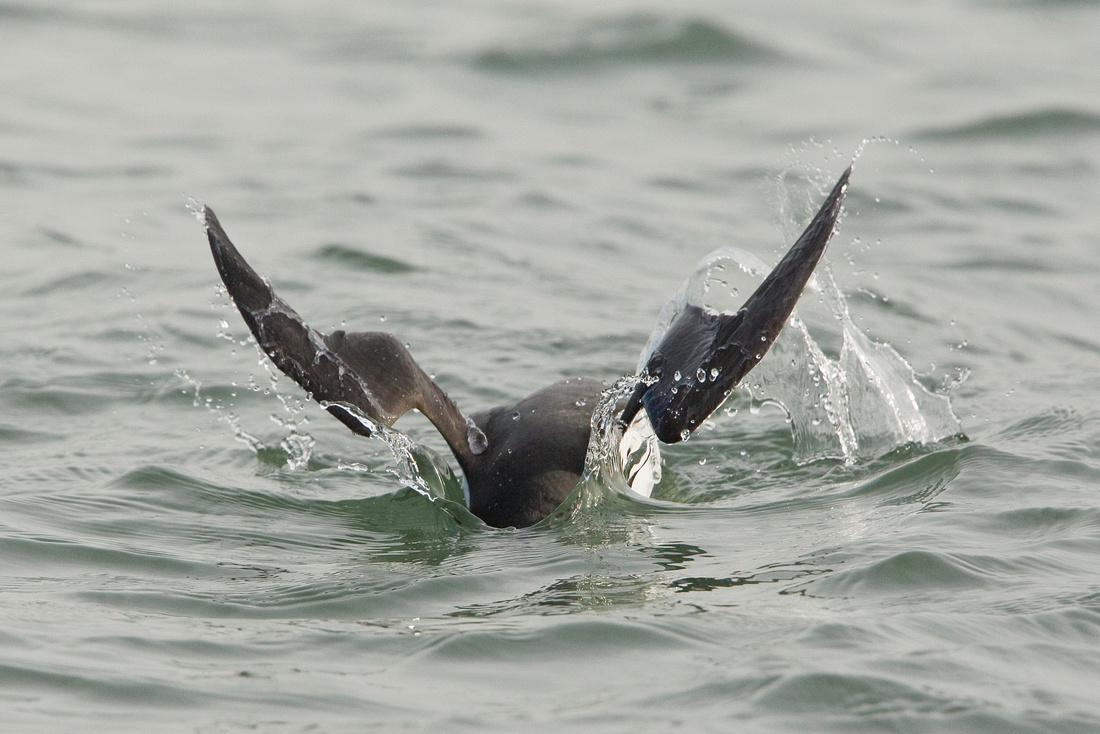
... then continued west toward Crescent Beach.
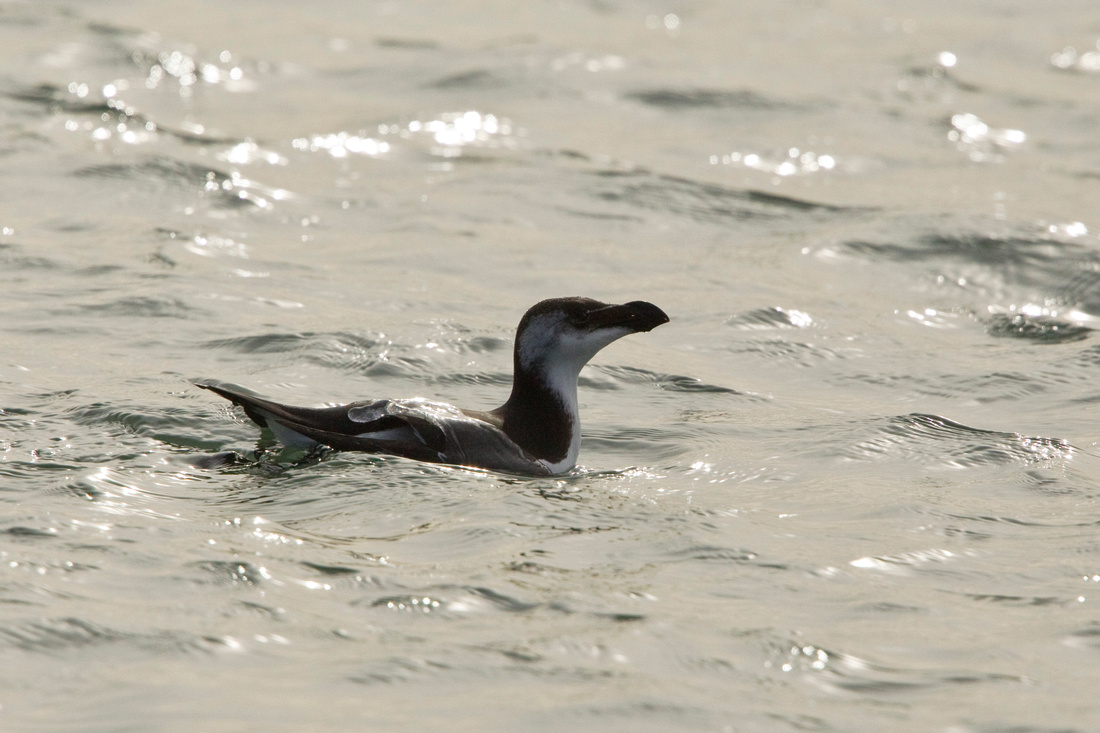
A few days later, more Razorbills, this time three at Stonington Point in the late afternoon. Also present there were four Common Eider, a male, two females and an immature. Farther out, near Sandy Point, was a flock of Surf Scoters and two Long-tailed Ducks that appeared to be in CT waters, but close to the RI line.
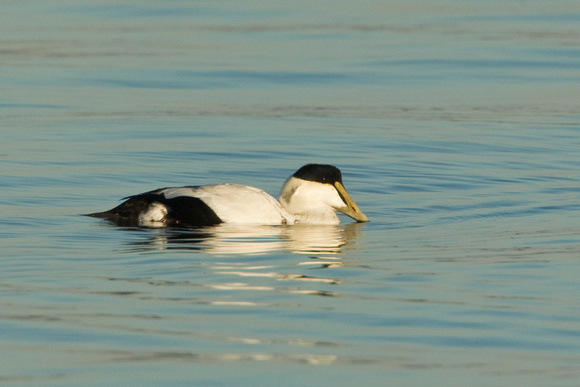
Then on to Barn Island as the sun went down, but time enough to see two Great Egrets along with several Great Blue Herons. As I drove home in the twilight, I saw a bird fly from the edge of a field into a tree and jerked my car off the road. It was Long-eared Owl, one of my favorite birds, awakened and preparing for the evening hunt. I took a few high ISO shots from my car and watched as it scanned the field before gliding off on a low flight. Even though the picture is not great, I felt lucky, not only to see one (it's been a few years since I have), but to see it active and on the prowl was a first for me
Current total - 80.
]]>I've had some memorable New Years Day sightings, like the frigid morning when a Saw Whet Owl sat out on the outer branches of a cedar tree basking in the bright sun, or finding a great new spot, where loons and mergansers dove for crabs right in front of me, at a marina just a few minutes from my home. I hoped this year held the something memorable. I checked my fully stocked feeders in the pale dawn light, just a couple goldfinch, and headed out. As I drove through town, I saw a silhouette atop a phone pole, the first test of my commitment. With no one out and about, I backed up and trained my binoculars on the bird shape, a starling! @#$%*.
As I pulled into Hole in the Wall Beach, the sun broke through the clouds. I scanned the waters of Niantic Bay and my list began in earnest, RB Merg, Horned Grebe, the three common gulls, Common Loon, Common Goldeneye ..... nothing uncommon. Then, a sharp raspy call broke the still morning air, as a Common Raven worked it's way along the closed off boardwalk. Well, that's uncommon.
As I drove on, my sights were set high, maybe I could get 70. But the clouds thickened, the winds increased and with each new stop that number slipped farther away. My three known screech owl holes, nothing, my Barred Owl haunt, nope. I found some Rusty Blackbirds near a roadside in Lyme, but as I was slowly driving past them, debating wether or not to try for pictures, a beautiful Red-shouldered Hawk flew from an eye-level perch on the opposite side of the road. Time to move on.
I stopped in Old Lyme, where I had seen a Bald Eagle pair the day before. Nothing doing. A nice gentleman from the house across the street came out and we exchanged New Years greetings and chatted about the birds on the river. I heard a kingfisher but couldn't see it so it didn't count. As we chatted, an adult eagle flew over the distant trees, then a juvenile flew right over our heads.
Moving westward, over the Baldwin Bridge, Peregrine Falcon, check, Okay, on a bit of a roll. I decided to look for a reported Iceland Gull on the Madison Guilford line. Nothing, still not even a Red-throated Loon. As I scanned the water with my binoculars a distant flock of white birds appeared to be flying in off the sound. I took my binoculars away and could not even see them. After relocating them in my bins, I realized they were Snow Geese. I tracked them for several minutes as they flew directly towards me, and finally got my camera out and blasted away for thirty seconds or so as they flew past. Those were the only pictures I took on the day.

Still no Iceland Gull, so I headed back to Hammonasset, my last shot at a respectable showing. Epic Fail. No crossbills, redpolls, nothing on the water, a disaster, only a few Sanderlings, RB Nuthatch and a distant flock of Dunlin that flew up when duck hunters let loose. I headed home by 1 p.m. in disappointment, no red-tails, red-throated loon, red-bellied woodpecker. I kept and eye on my feeders for the rest of the day, but missed the Carolina Wren and WB Nuthatches that visit daily. A dismal start, 50 birds. I did see that someone reported seeing a flock of 11 Snow Geese, with a single neck-banded bird, in Madison and the same group later in East Haven. Somehow I picked up an extra bird in the middle of the trip.
]]>For the past 20 years I have been photographing birds, and for most of that time I have pushed back at the notion that I'm a birder. I've always said I'm just a photographer interested in the natural world, and birds just happen to be the most varied and abundant subjects here in Connecticut. But the truth is, that's not entirely true.
A little background - I have been a photographer for 25 years. I spent most of my career working at newspapers, and now I am self-employed, and still working out the direction the rest of my work life will take. I'll turn 50 this year, married and have two teenage kids. As a young child, I mostly liked sports, but also liked animals and played in the woods, ponds and streams catching turtles and frogs. It seemed normal back then. I grew up less than a mile from Roger Tory Peterson's home and studio, but other than seeing his name on a book in our house, I knew almost nothing about him until about 20 years ago.
It was then, while desperately hunting for an "enterprise" picture (a random feature picture used to fill space in a newspaper) in the fading light of a winter afternoon that a fortunate encounter with a Short-eared Owl changed everything. The owl (I had no idea what kind it was at the time) flew up to a No Parking sign right in front of me. I rolled up and clicked a few shots from my car window, before the owl flew off. I got my picture, and bought a Peterson Field Guide to find out what the bird I photographed was, and I was hooked.
My birding experiences have always been complicated by photography. I was a photographer first, and it has always been my priority. I'd rather spend two hours photographing a Robin at close range in my yard than drive two hours to get distant scope views of a Tufted Duck or Northern Lapwing. Patience is a key to getting good photographs, and spending hours to get a really good shot of one bird is not conducive to racking up big numbers for a list. I never had the urge to drive across the state to a smelly landfill to see a rare gull, among thousands of common ones. Not a pretty picture. Still, I'd like to see more birds.
No one else in my family shares my interest in birds or nature, but for Christmas this year they got me the DVD of "The Big Year" (my wife insists I left hints). We all watched it together on Christmas day. Movies have always been a way of bonding for our family, from the time my daughter was a toddler, and we watched "The Lion King" together, several million times and could recite every word of it by heart. Despite the subject matter, everyone really enjoyed "The Big Year" and it felt like we all came a little closer watching the movie. I mostly I liked that the the guys in the movie seemed to figure things out in the end.
My kids, not really understanding what I do, said "Dad, you should do a big year". So, I decided to do my own Big Year in 2013, inspired by the film, but customized to my own goals. I'm only doing it in Connecticut, and maybe a few neighboring states, because my budget is zero (daughter starting college in the fall - just like the guy in the movie). I hope to push myself to see more birds than ever before, my target is 300 species although that might be a bit ambitious. I'm also not really trying to compete with anyone, I'm pretty certain I won't see the most birds and don't really care. I decided to blog about it as a motivational exercise, and maybe if my kids read it they might take more interest in the natural world around them, or at least get a better sense of why I do. Mostly, I'd like to take lots of good pictures, and hopefully figure out some things along the way.
]]>
After a quiet few weeks, 2012 drew to a close on a positive note. On December 28, an otherwise uneventful spin through Hammonasset on my way to exchange a Christmas gift, proved productive when I spotted a male Long-tailed Duck in the salt ponds near the Nature Center. After taking a few record shots, I sat down near the edge of the pond and waited to see if the duck would get any closer. The duck took flight when the gulls and Black Ducks it was among flew off, but returned to the same pool. It was actively diving and feeding in the shallow pond, and gradually worked its way from the center to the eastern edge of the pond where I was sitting. I ended up spending several hours there, as the bird worked its way back and forth, coming very close to me, and a few others who stopped to take pictures, several times. My favorite pictures came when it stopped feeding and started preening, lifting its namesake tail out of the water.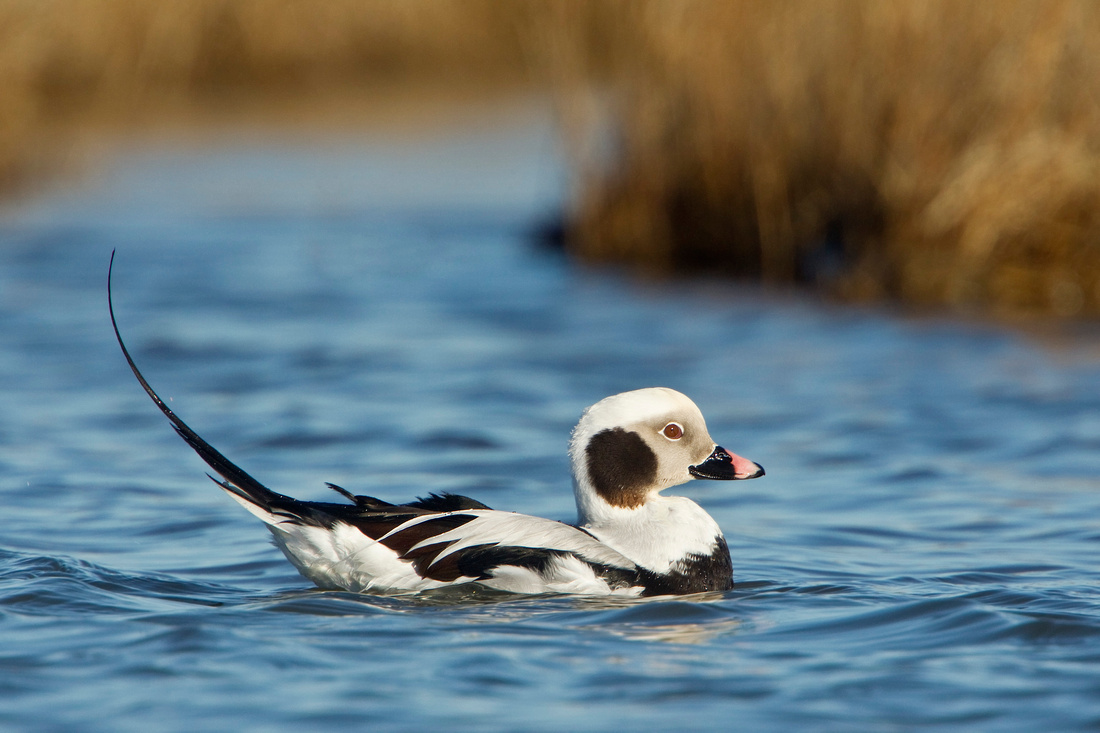
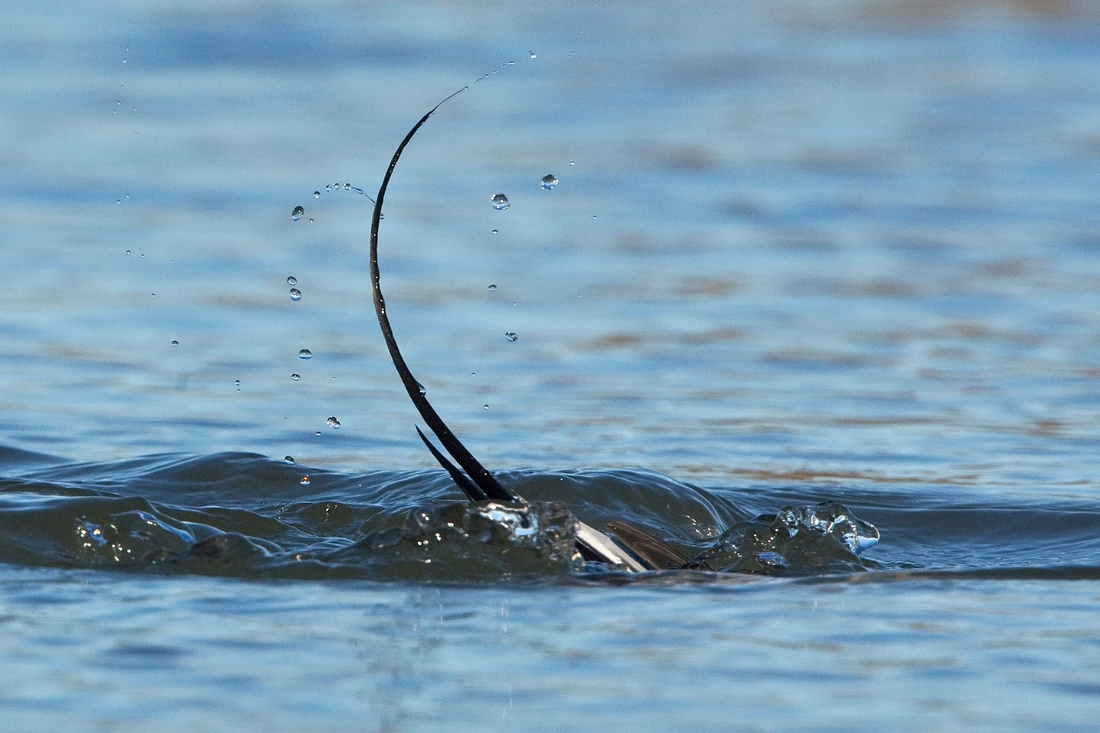
On the 30th, I walked several areas through the day old snow, looking for a wintry picture, but nothing really struck me. The last day of the year, I took my favorite early morning loop from Niantic through Lyme and Old Lyme. Pretty quiet, again, until I stopped along the Connecticut River in Old Lyme where a pair of Bald Eagles were sharing a fish at the edge of the ice. It looked like some kind of courtship ritual. A nice way to head into a Big Year.
